BOATS
• Ferretti Yachts 670
• Princess S65
• Master & Mercury
• BB Yachts 44’ Ischia
• Lagoon 43
• Catana Yot 41
• Sacs Strider 13
VETERAN BOAT
Rahmi M. Koç Museum

• Fulvio De Simoni
• Paolo Moretti







CARING for BEAUTY since 1873
EXPLORE


BOATS
• Ferretti Yachts 670
• Princess S65
• Master & Mercury
• BB Yachts 44’ Ischia
• Lagoon 43
• Catana Yot 41
• Sacs Strider 13
VETERAN BOAT
Rahmi M. Koç Museum

• Fulvio De Simoni
• Paolo Moretti







CARING for BEAUTY since 1873
EXPLORE

where are you?
SIAMO IN UNA FASE NELLA QUALE TUTTO CAMBIA ALLA VELOCITÀ DELLA LUCE. DEEPSEEK, INTELLIGENZA ARTIFICIALE A BASSO COSTO CREATA DA GIOVANI CINESI, HA RIMESSO IN DISCUSSIONE MOLTE CERTEZZE SU CUI SI BASAVANO LE ANALISI SUGLI SVILUPPI DEL NOSTRO FUTURO, COMPRESO QUELLO DELL’INDUSTRIA NAUTICA GLOBALE EVERYTHING IS CHANGING AT THE SPEED OF LIGHT. DEEPSEEK, A LOW-COST ARTIFICIAL INTELLIGENCE CREATED BY YOUNG CHINESE, HAS CHALLENGED MANY OF THE CERTAINTIES ON WHICH ANALYSES OF OUR FUTURE DEVELOPMENTS, INCLUDING THOSE OF THE GLOBAL MARINE INDUSTRY,
by Francesco Michienzi
Europa, dove sei? Perché siamo schiacciati dalla burocrazia asfissiante di Bruxelles senza reagire?
Dovremmo occuparci di politiche industriali sensate e non suicide come quella sul bando dei motori endotermici nel 2035. Tra meno di dieci anni come navigheranno le nostre barche?
Il vecchio continente è l’unico tra tutti che si è dotato di una normativa così stringente da offrire pochi margini di manovra. Lo shipping contribuisce all’inquinamento globale con meno del 3 per cento di tutte le emissioni. Lo yachting rappresenta lo 0,2 per cento dello shipping. In pratica la nautica da diporto contribuisce all’inquinamento globale con lo 0,00 per cento di tutte le emissioni. Praticamente nulla. Certo, non è una buona ragione per non attuare politiche di sostenibilità ambientale. Tuttavia, senza una revisione delle normative attuali non si potranno adottare scelte veramente efficaci che salvaguardino l’ambiente, ma anche l’industria nautica. Pensiamo al pasticcio sul sistema SCR per le imbarcazioni sopra i 24 metri, del quale i nostri politici non hanno capito proprio nulla. Hanno lasciato che il regolamento entrasse in vigore senza battere ciglio. Si tratta di una norma che non produce alcun beneficio ambientale, ma che è molto penalizzante per i cantieri

Una classe politica così distante dalla concretezza del nostro quotidiano non è di alcun aiuto. Non ci resta che cercare direttamente le soluzioni ai temi dello sviluppo e dell’evoluzione che ci riguardano. Non come singoli, ma come comunità che ama le barche e tutto quello che serve per costruirle. A political class so far removed from the concreteness of our daily lives is of no help. We have no choice but to look directly for solutions to the issues of development and evolution that concern us –not as individuals but as a community that loves boats and everything that goes into building them.
nautici costretti a rinunciare a spazi abitativi, oltre a dover ridisegnare le sale macchine per ospitare i serbatoi supplementari previsti dal sistema, aumentando il peso dell’imbarcazione con relativo aumento dei consumi. Anche le scelte politiche disastrose sulle auto dovrebbero insegnarci qualcosa. Come dovrebbe insegnarci qualcosa la notizia dell’arrivo di DeepSeek, concorrente cinese di ChatGpt che ha seminato il panico a Wall Street, dove il chipmaker americano Nvidia è crollato improvvisamente di quasi il 17% in una sola seduta. Le azioni del produttore Usa di semiconduttori sono state protagoniste di una crescita eccezionale proprio sull’onda dello sviluppo dell’intelligenza artificiale, le cui applicazioni, come ChatGpt, richiedono enorme potenza computazionale con chip di alta qualità. Il prodotto della startup cinese DeepSeek, il cui chatbot è diventato l’app gratuita più quotata sull’App Store statunitense di Apple, pare però sia stato sviluppato a una frazione di costo del chatbot di OpenAi e usando chip non di prima fascia, visto che l’esportazione di questi verso la Cina è stata bloccata dagli Stati Uniti. Nvidia ha bruciato circa 589 miliardi di dollari di valore di mercato, ma analisti, imprese e politici Usa cominciano a chiedersi se il primato tecnologico americano sull’Ai non sia messo seriamente a rischio da un prodotto Made in China molto più economico e che non avrebbe bisogno dei processori altamente performanti prodotti negli Stati Uniti d’America. Cosa ci dice tutto questo? Primo, l’Europa non sta giocando questa partita. Secondo, non esiste solo una strada per lo sviluppo tecnologico. Terzo, l’intelligenza naturale di giovani ricercatori ci dà la certezza di essere in grado di trovare le soluzioni giuste ai problemi di domani. Circa tre anni fa scrissi che per affrontare il problema di quale sistema propulsivo usare per la nautica, sarebbe stato utile un patto di collaborazione tra tutti gli attori in gioco. “Quando si parla di condivisione e di futuro, si dovrebbe mettere da parte la legittima competizione commerciale per riempire di contenuto parole che diversamente suonerebbero solo di retorica e propaganda. Io immagino che tutti i principali cantieri nautici italiani stringano degli accordi con le nostre migliori università, mettendo a disposizione tante borse di studio, per avviare delle ricerche utili a trovare le migliori soluzioni in tema di propulsione, sostenibilità e vera innovazione per le navi e barche da diporto. Si dovrebbe fare un accordo quadro con l’intenzione di ottenere risultati concreti. I nostri migliori cantieri nautici stanno già collaborando singolarmente con varie Università italiane, ma si tratta di casi isolati”. Il risultato sull’intelligenza artificiale dei ricercatori cinesi dimostra che con poche risorse si possono ottenere risultati inimmaginabili. Gli scienziati europei hanno già dimostrato grandi risultati, devono solo essere messi in condizione di lavorare liberamente senza il limite di una soluzione individuata da burocrati senza visione e senza conoscenze tecniche in grado di validare le loro decisioni.
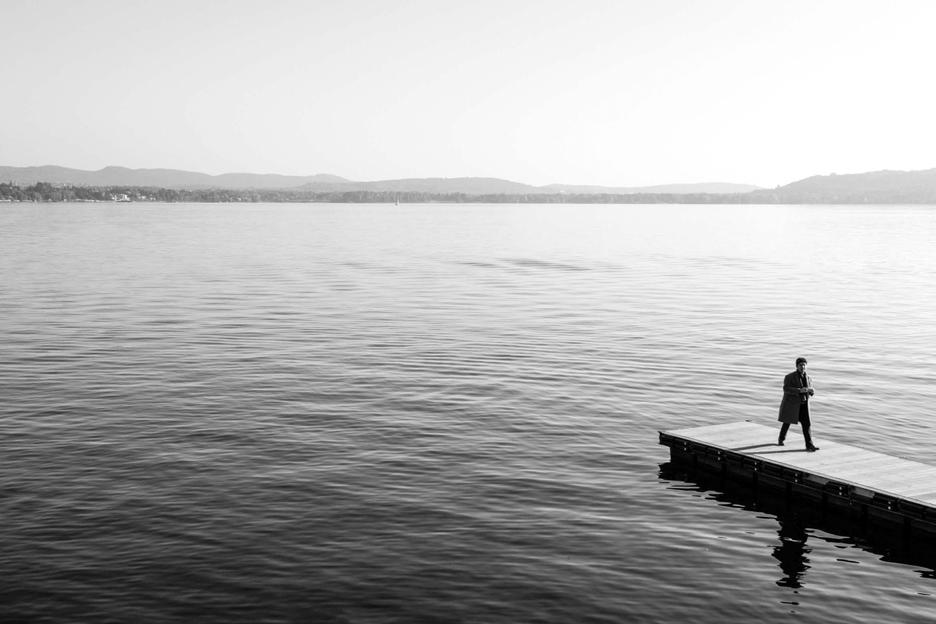
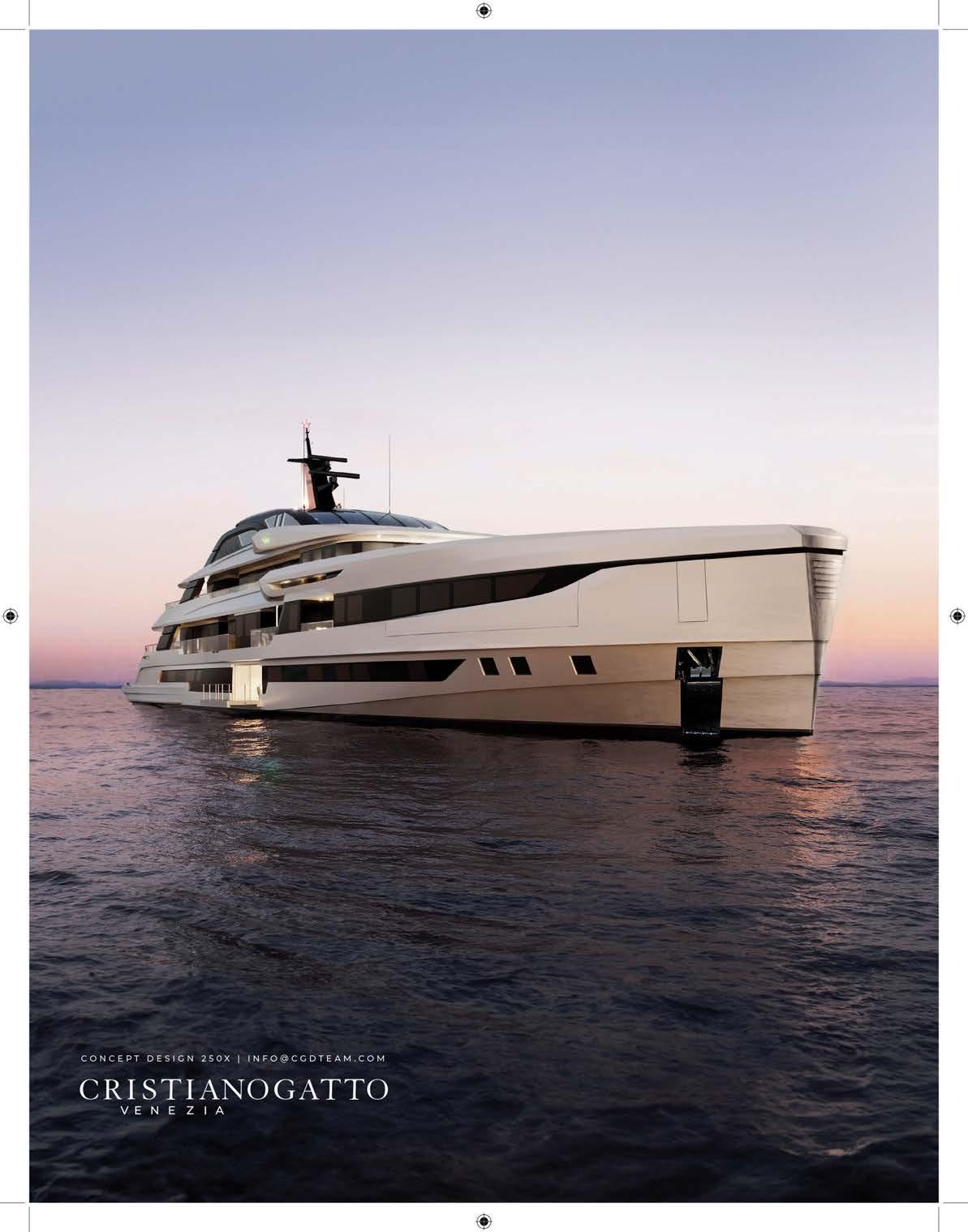
È fondamentale sostenere con più determinazione le ricerche utili a trovare le migliori soluzioni in tema di propulsione, sostenibilità e vera innovazione per le navi e barche da diporto. It is essential to support research with greater determination to find the best solutions in terms of propulsion, sustainability and real innovation for recreational craft and boats.
Europe, where are you? hy are we being crushed by the suffocating Brussels bureaucracy without reacting? e should look at sensible industrial policies, not suicidal ones like the one banning endothermic engines in 2035. How will our boats sail in less than ten years? The old continent is the only one with legislation so strict that it leaves little room for manoeuvre. Shipping contributes less than 3% of all emissions to global pollution. Pleasure yachting accounts for 0.2% of shipping. In practice, yachting contributes 0.00 % of all emissions to global pollution. Practically nothing. Indeed, it is not a good reason not to implement environmental sustainability policies. However, without a review of current regulations, truly effective decisions that protect the environment and the boating industry will not be possible. ust look at the mess over the SCR system for boats over 24 metres, which our politicians failed to understand. They let it come into force without batting an eyelid. It is a regulation that brings no environmental benefit but is very punitive for boatbuilders, who will be forced to sacrifice living space and redesign engine rooms to accommodate the additional tanks required by the system, increasing the weight of the boat and thus increasing fuel consumption. The disastrous policy decisions on cars should also teach us something. ust as the news of the arrival of DeepSeek, ChatGpt s Chinese rival should teach us something. It caused panic on all Street, where the US chipmaker Nvidia plunged almost 17% in a single session. The US semiconductor company s shares have been en oying exceptional growth thanks to the development of artificial intelligence, whose applications, such as ChatGpt, require enormous computing power and high-quality chips. However, the product of Chinese start-up DeepSeek, whose chatbot has become the top-rated free app in Apple s US App Store, appears to have been developed at a fraction of the cost of OpenAi s chatbot and using chips that are not top-of-the-line, as the US has blocked exports to China. Nvidia has burned through some 58 billion in market value. Still, US analysts, businesses and politicians are beginning to wonder whether American technological supremacy in AI is not seriously threatened by a product made in China that is much cheaper and does not need the high-performance processors produced in the US. hat does all this tell us? First, Europe is not playing this game. Second, there is more than one path to technological development. Third, the natural intelligence of young researchers gives us confidence that we can find the right solutions to tomorrow s problems. About three years ago, I wrote that to solve the problem of which propulsion system to use for boats, it would be helpful to have a cooperation pact between all the players involved. “When we talk about sharing and the future, we should put aside legitimate commercial competition to give substance to words that otherwise sound like rhetoric and propaganda. I can imagine all the major Italian shipyards enterin into a reements with our best universities, offerin many scholarships, to start researching the best solutions regarding propulsion, sustainability and real innovation for pleasure boats and ships.

A framework agreement should be drawn up to achieve concrete results. Our best shipyards are already working individually with various Italian universities, but these are isolated cases”.
The results of Chinese researchers in artificial intelligence show that it is possible to achieve unimaginable results with very few resources. European scientists have already demonstrated excellent results; they must be allowed to work freely without being limited by a solution defined by bureaucrats with no vision and technical knowledge to validate their decisions.

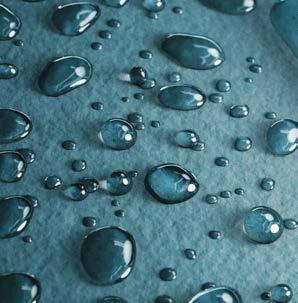






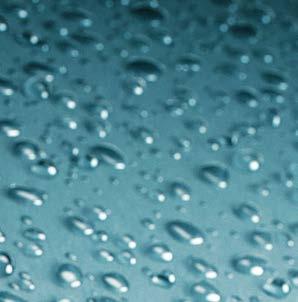
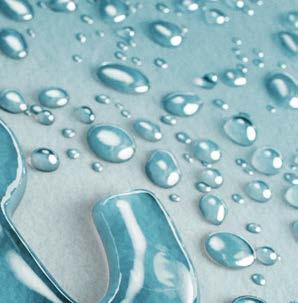









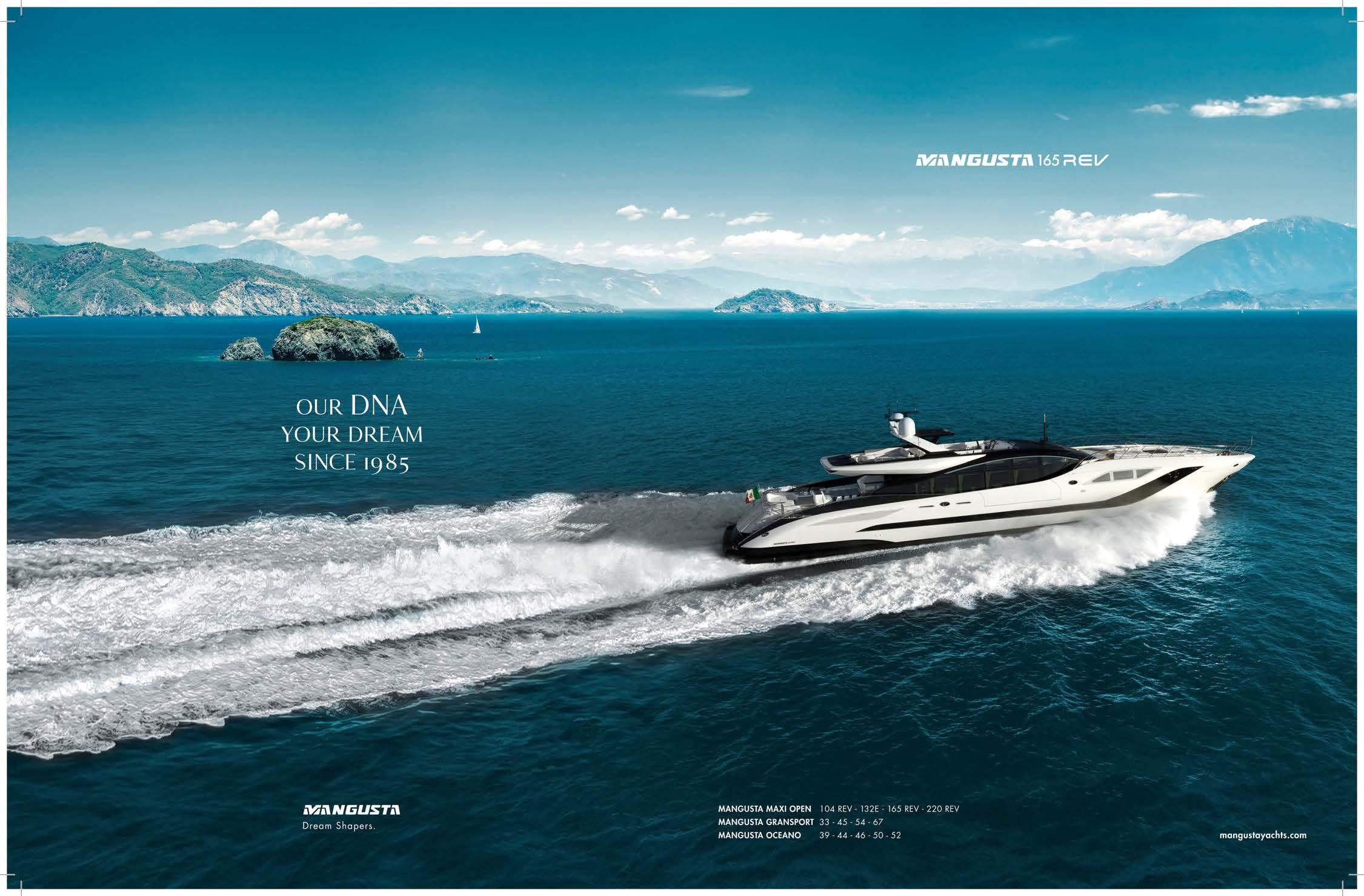



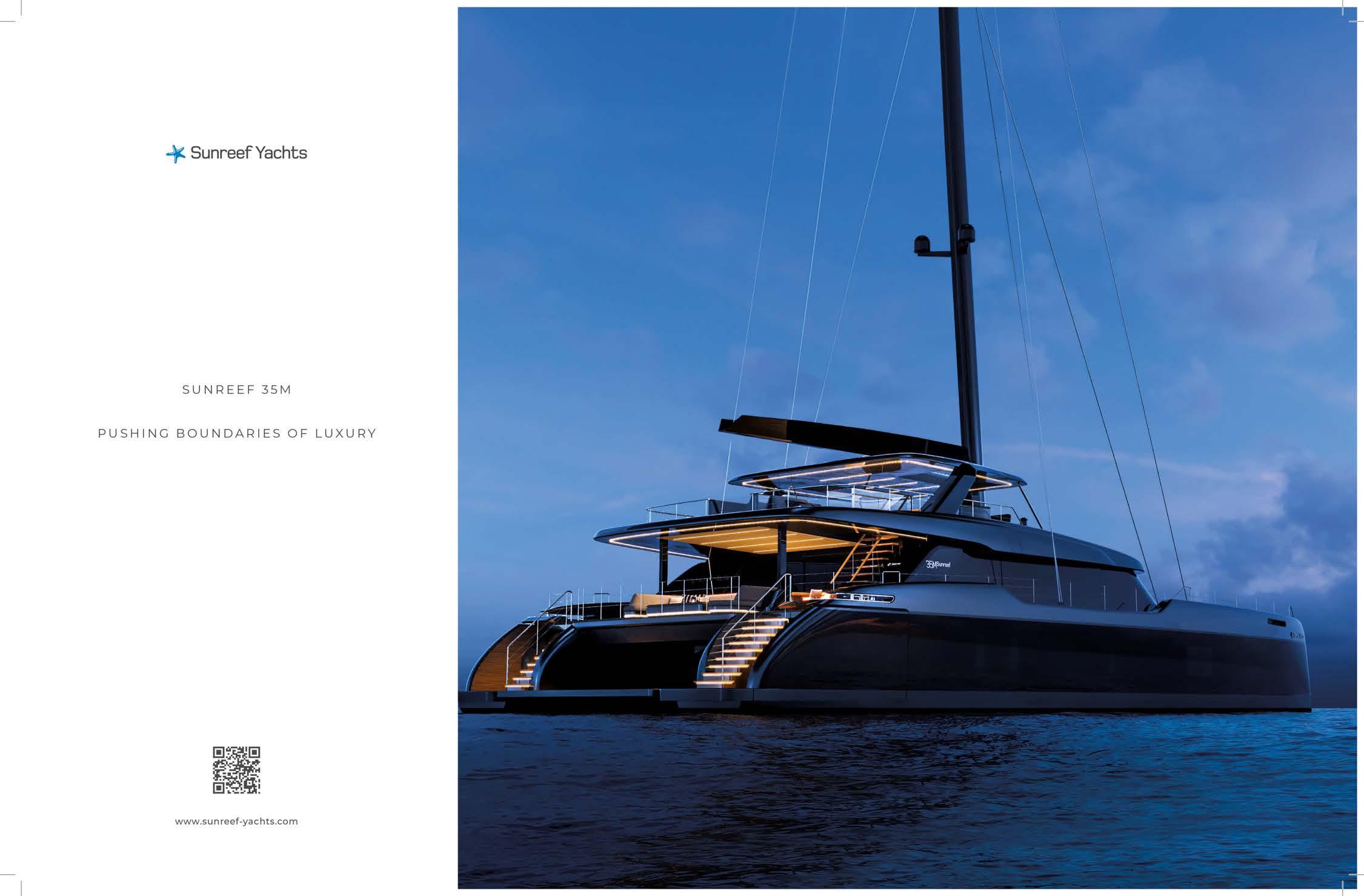

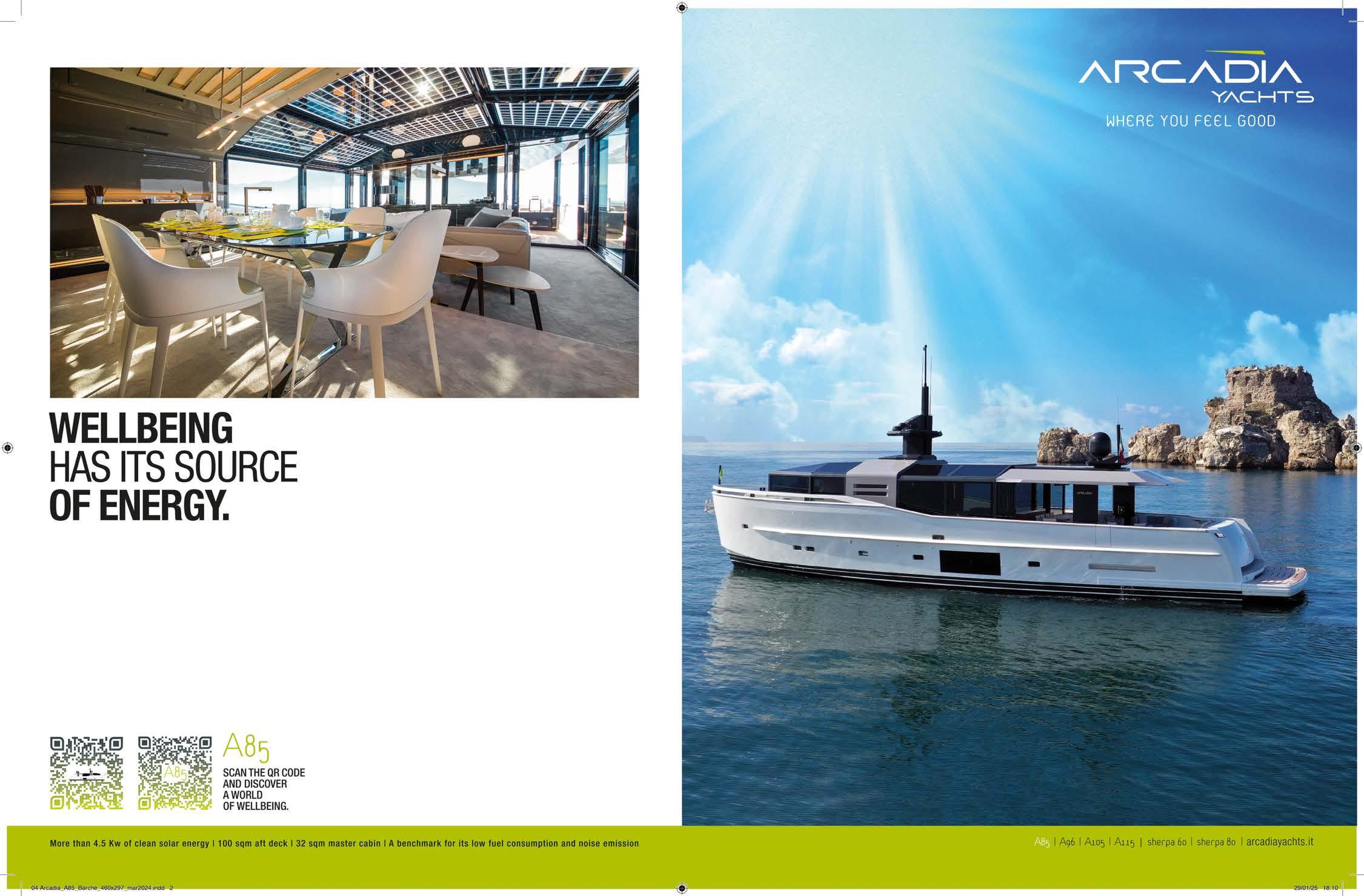



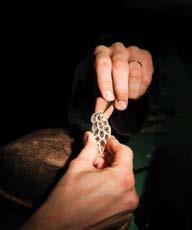


COLUMNS
38News
56Revenue on board – Fisco a bordo 72 Boutique – Buccellati 80 Boat Gourmet Juanlu Fernández 100 Harbour EVENTS
62Art Basel Miami

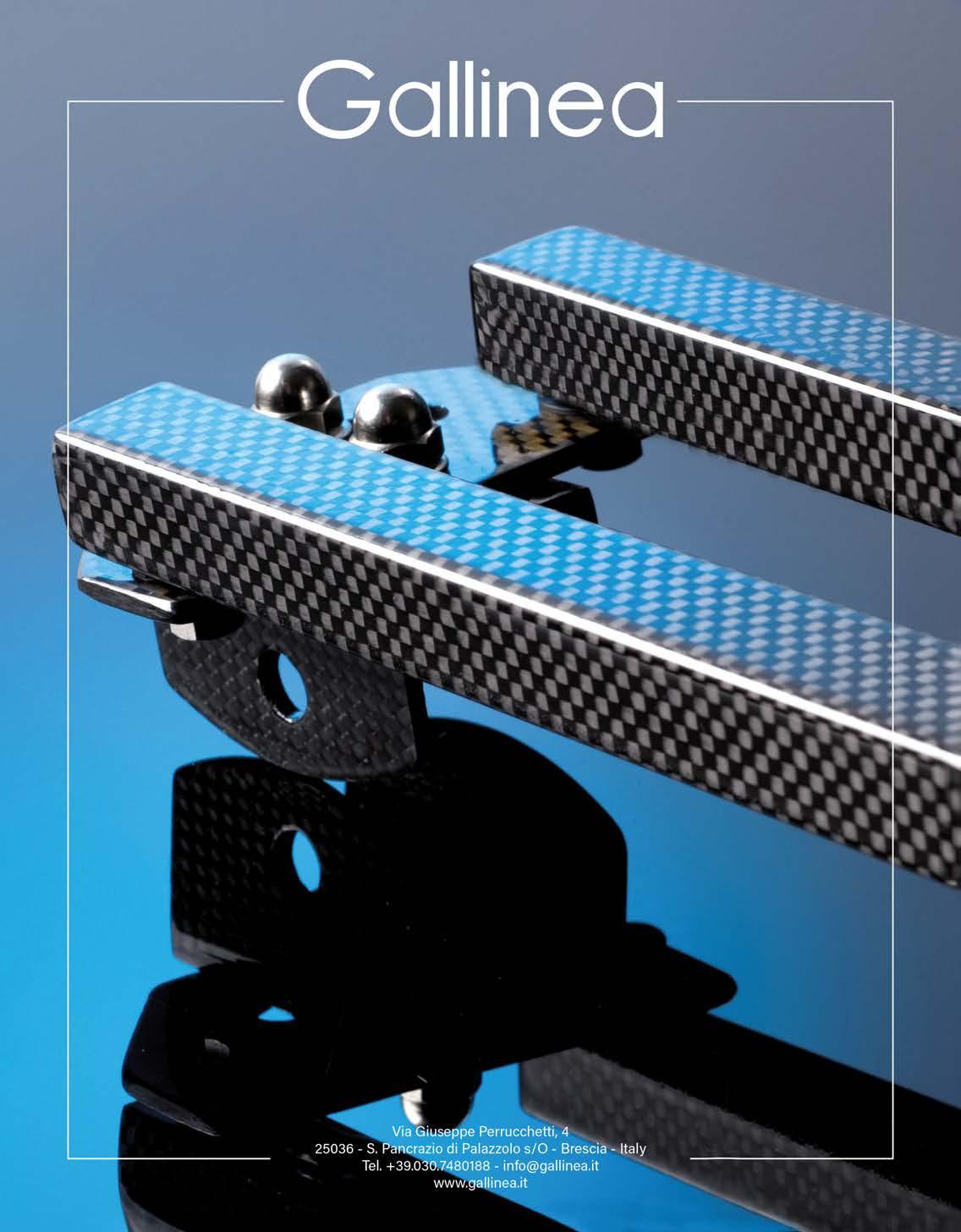

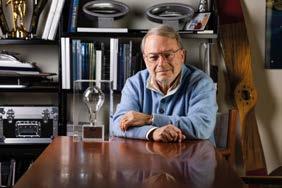
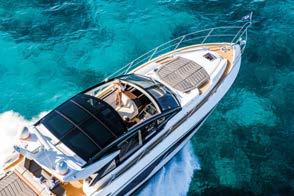


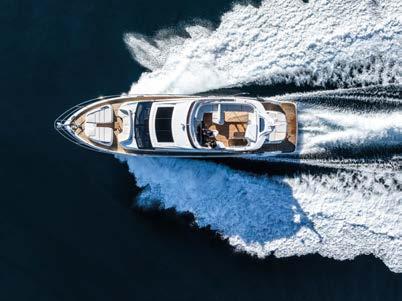
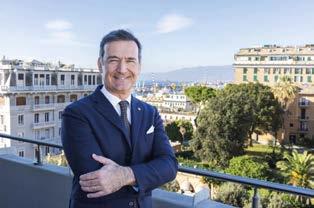
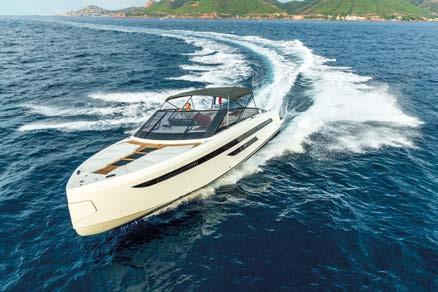

Fulvio De Simoni
Paolo Moretti
128 Columbus Yachts Atlantique 43
F5.7 BOATS
166Ferretti Yachts 670
176 Princess S65
198Lagoon 43
206 Catana Yot 41
212 BB Yachts 44’ Ischia
220Sacs Strider 13
226Master & Mercury
VETERAN
232 Rahmi M. Koç Museum



DIRETTORE RESPONSABILE//Editor in chief Francesco Michienzi f.michienzi@barcheisp.it
DIRETTORE EDITORIALE //Editorial director Barbara Borgonovo b.borgonovo@barcheisp.it
ART DIRECTOR Francesca Villirillo grafici@barcheisp.it
SEGRETERIA DI DIREZIONE //Chief assistant Anna Tonelli a.tonelli@barcheisp.it
FOTOGRAFO//Photographer Andrea Muscatello redazione@barcheisp.it
HANNO COLLABORATO A QUESTO NUMERO //Contributing editors/writers Priscilla Baldesi, Mariateresa Campolongo, Alberto Mario Capelli, Bruno Cianci, Olimpia De Casa, Giovanni Gasparini, Sacha Giannini, Berardo Lanci, Sophia Negri, Clelia Pirazzini, Niccolò Volpati
SEGRETERIA DI REDAZIONE //Editorial assistant redazione@barcheisp.it
EDITORE //Publisher
International Sea Press Srl, Viale Brianza, 17/A - 20821 Meda, T. + 39 0362 344140, F. + 39 0362 73790 redazione@barcheisp.it
STAMPA //Printing International Sea Press srl ON LINE
Barche www.barchemagazine.com




CONCESSIONARIA PUBBLICITÀ //Advertising
International Sea Press Srl, Viale Brianza, 17/A - 20821 Meda T. + 39 0362 344140 b.borgonovo@barcheisp.it, a.tonelli@barcheisp.it
Gian Marco Lari T. +39 0773 742260 M. +39 335 6268932 m.lari@barcheisp.it
Giovanni Berruti
M. +39 337 254344 g.berruti@barcheisp.it
Concessionaria per il Principato di Monaco e la Costa Azzurra //Advertising for Principality of Monaco and Côte d’Azur INVESTOR MEDIA MONACO Sarl Andrea Dini a.dini@barcheisp.it
DISTRIBUZIONE //Distribution Press-di Distribuzione Stampa e Multimedia S.r.l.Via Cassanese 224, 20090 Segrate (MI)
DISTRIBUZIONE ESTERO//Sole Agent for Distribution Abroad JOHNSONS INTERNATIONAL NEWS ITALIA srl Via Valparaiso, 4 - 20144 MILANO
UFFICIO ABBONAMENTI
Viale Brianza, 17/A - 20821 Meda, tel. +39 0362 344140 Abbonamento annuo € 75; abbonamento estero € 175 Europa; € 210 resto del mondo; un numero € 7,00; arretrati € 12. Pubblicazione mensile registrata al Tribunale di Milano in data 05/04/2004 al n. 233/2004. Tutti i diritti sono riservati. Vietata la riproduzione se non autorizzata per iscritto. Printed in Italy. Iscrizione ROC 34967 del 17/09/2020.
How to subscribe - Subscription: International Sea Press Srl, Viale Brianza, 17 - 20821 Meda, tel. +39 0362 344140. Subscription rates (one year): Italy € 75,00 - Europe € 175,00 - all over the world € 210,00. Published monthly. All rights reserved: reproduction in whole or in a part of any article without prior written permission from the publisher is strictly prohibited. Printed in Italy.
Questo numero è stato chiuso in Redazione il 3 febbraio 2025. This issue ended on 3rd February 2025.
anoscritti e fotografie, anche se non pubblicati, non si restituiscono. Gli articoli firmati sono la libera espressione degli utori e non rispecchiano necessariamente la linea editoriale del giornale. ven if not published, handwritten manuscripts and pictures cannot be returned. The signed articles are the free e pression of the writers and do not necessarily re ect the editorial policy of the maga ine.






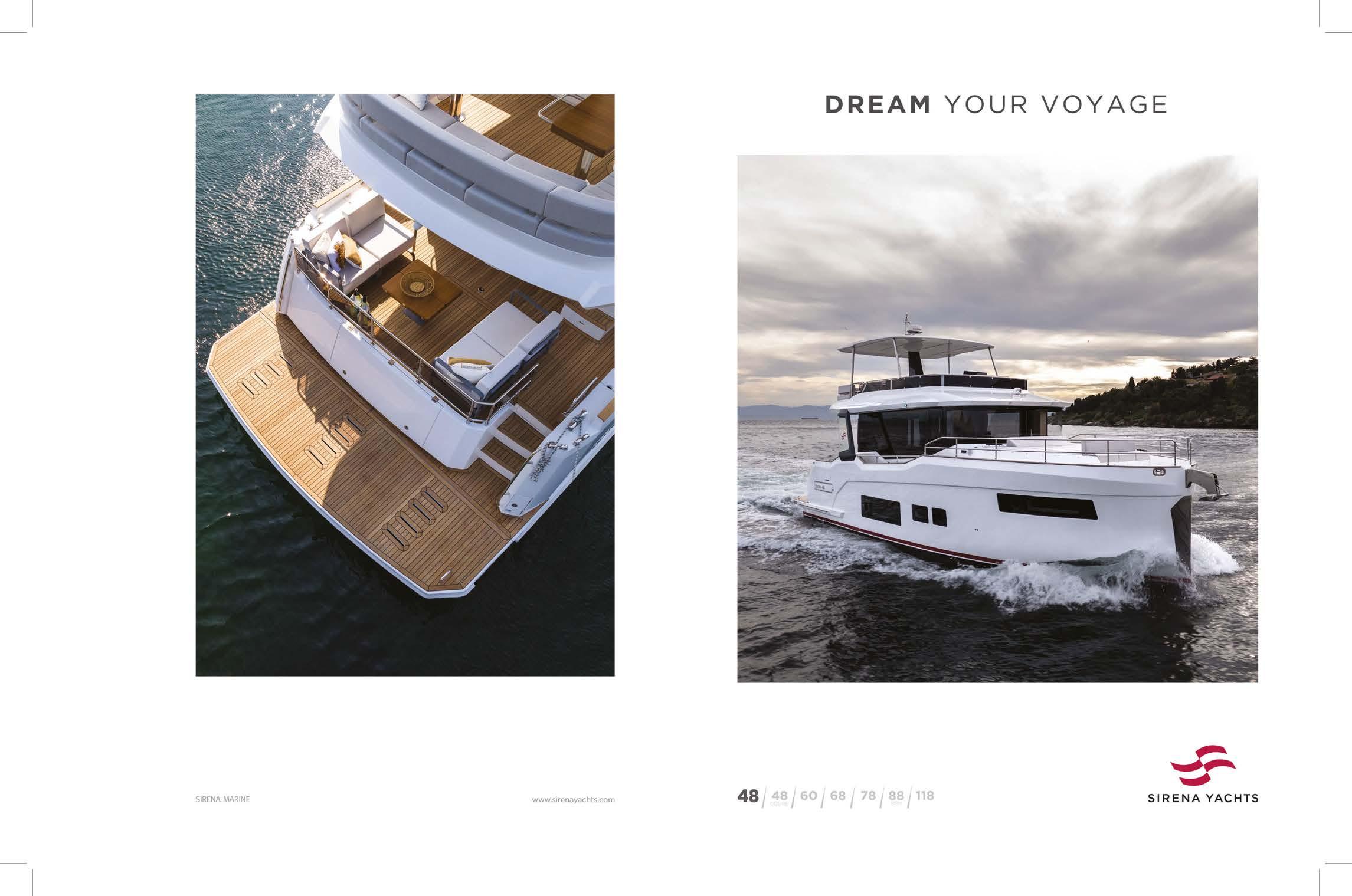

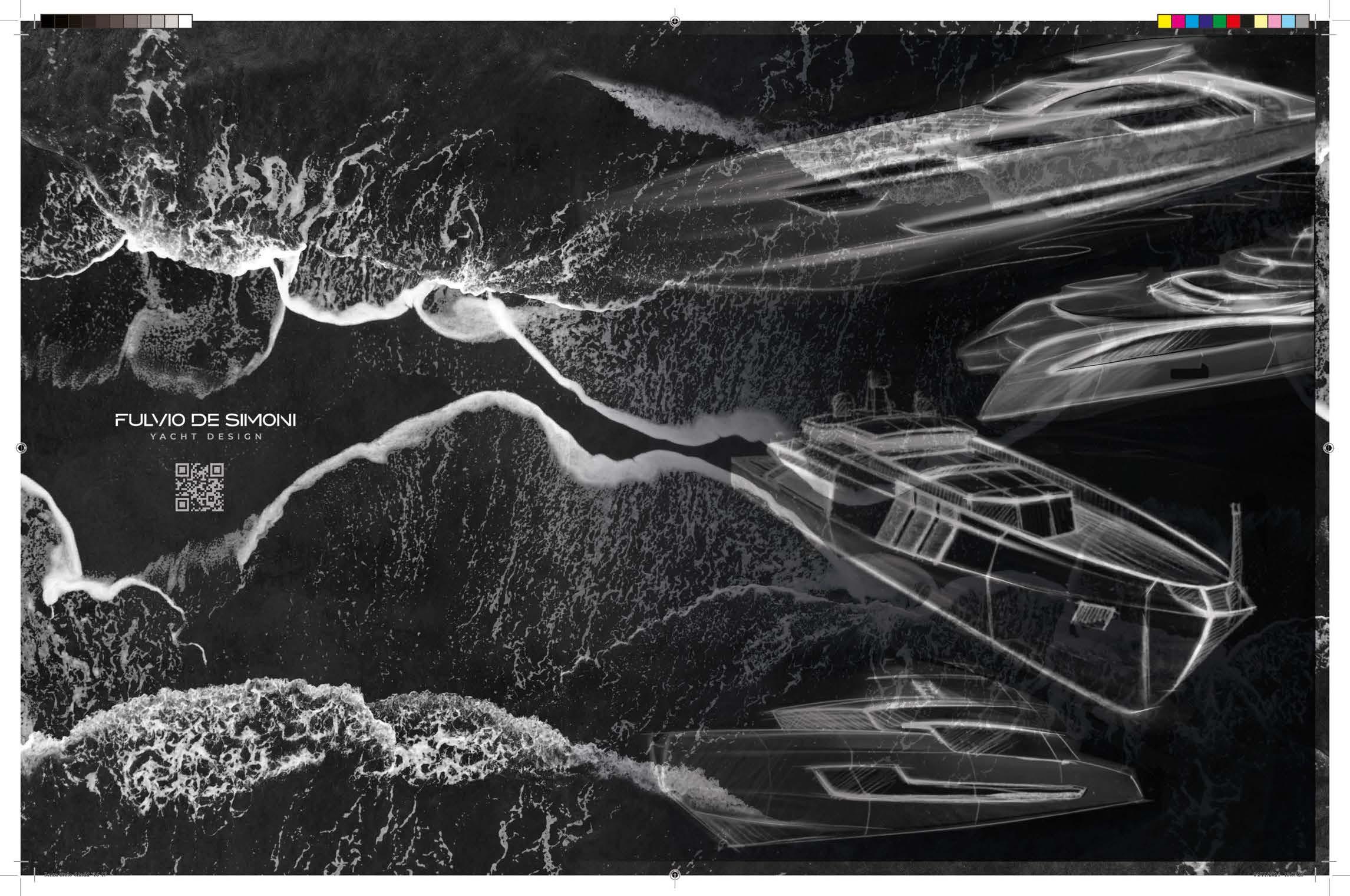



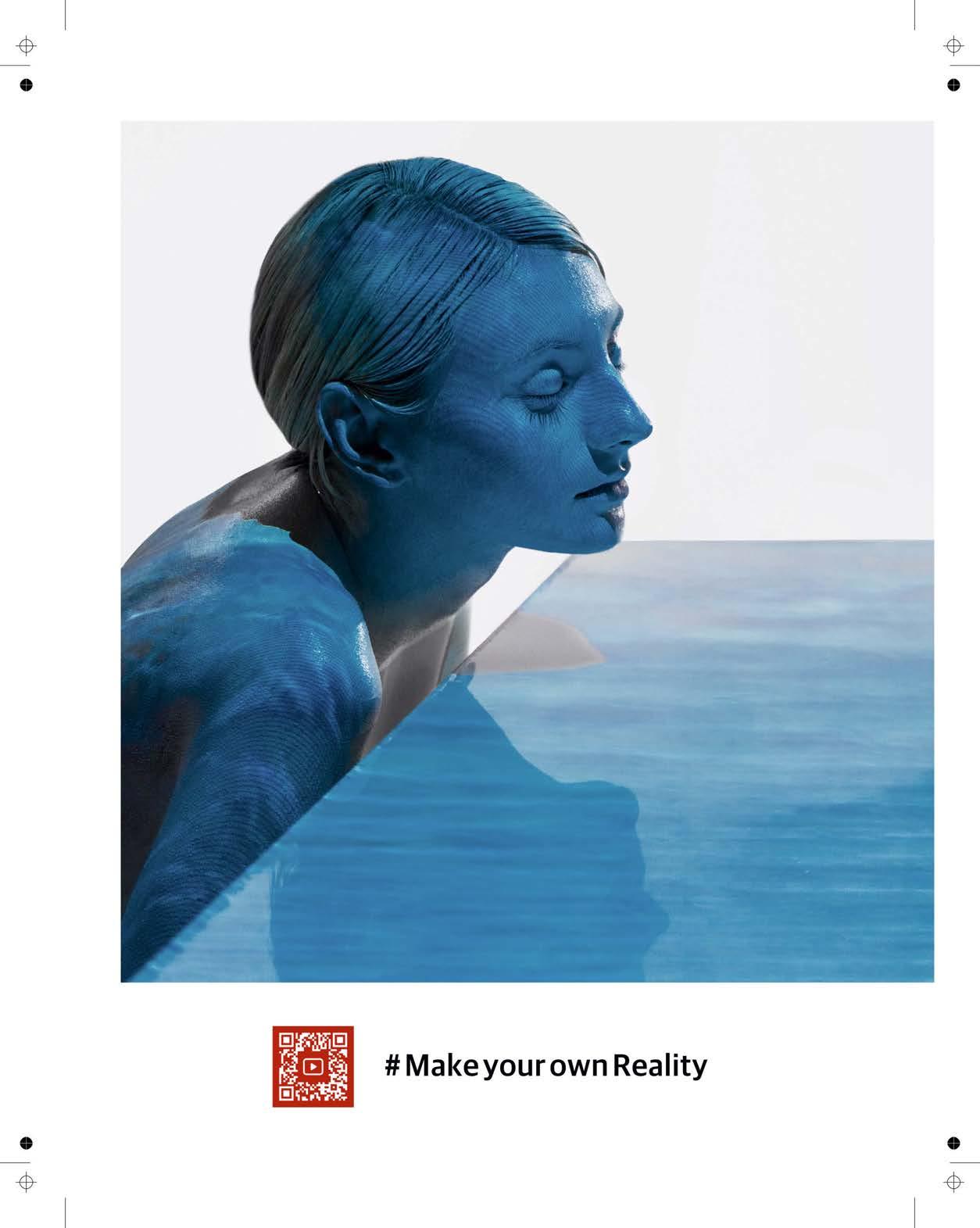
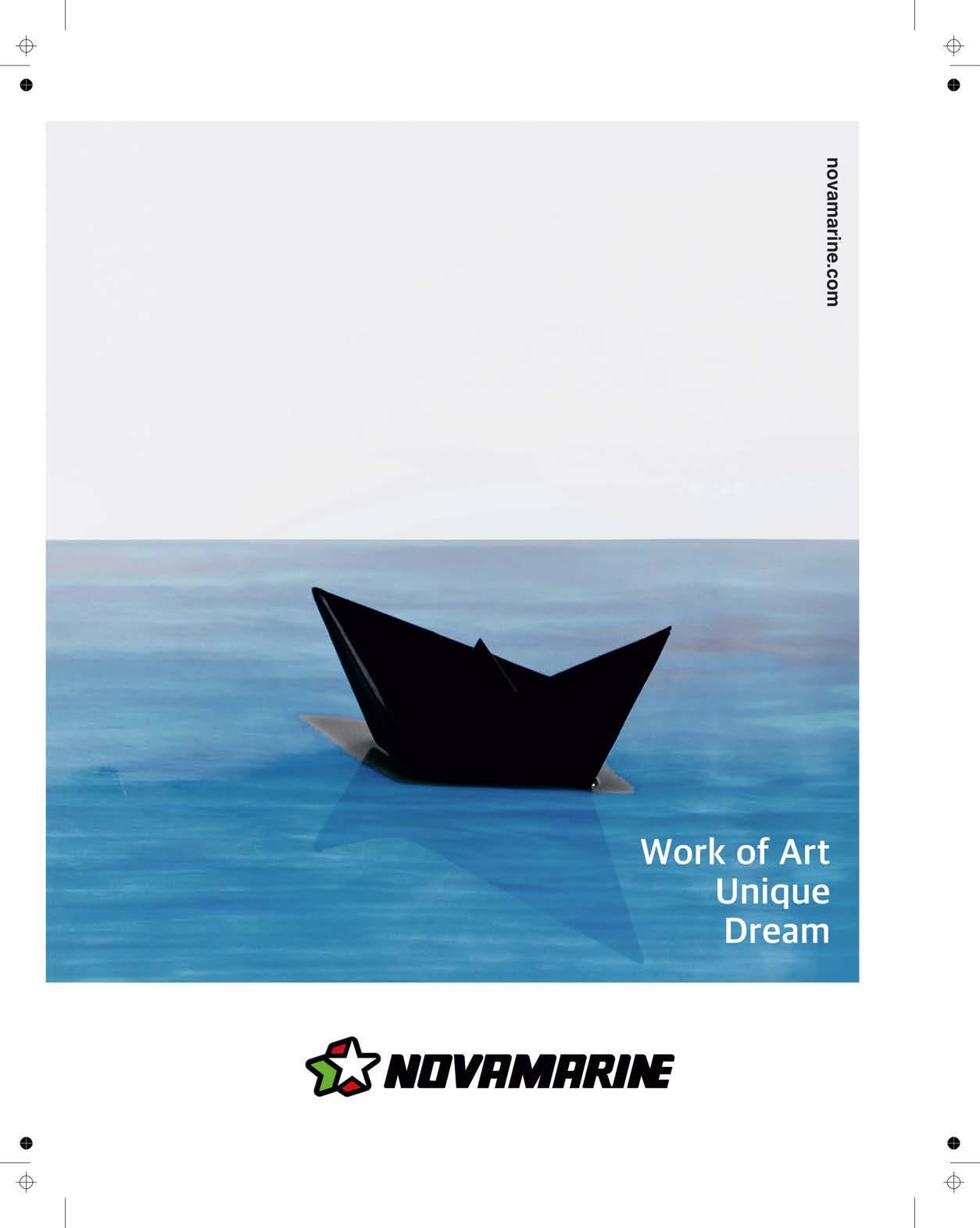


Per celebrare l’apertura esclusiva del Flagship Store a Maiorca, Molteni&C arreda una casa in collaborazione con Espacio Home Design, creando una fusione tra il design italiano e il paesaggio maiorchino. Ca’n Molteni Mallorca presenta alcuni pezzi della collezione Outdoor, tutti disegnati da Vincent Van Duysen, insieme, tra gli altri, al divano e al tavolino Sway di Yabu Pushelberg.
To celebrate the exclusive opening of its agship store in Mallorca, Molteni C has furnished a house in collaboration with Espacio Home Design, creating a fusion between Italian design and the Mallorcan landscape. Ca’n Molteni Mallorca presents pieces from the Outdoor collection, all designed by Vincent Van Duysen, along with the Sway sofa and coffee table by Yabu Pushelberg, among others.


Corum presenta la collezione Admiral 42 Ceramic. Con i modelli Ceramic & Gold, mostra l’armoniosa fusione di lusso classico e tecnologia all’avanguardia. La ceramica è più leggera rispetto alla lega di acciaio. Inoltre, è particolarmente resistente ai gra e all’ossidazione.
Corum presents the Admiral 42 Ceramic Collection. The Ceramic & Gold models represent a harmonious fusion of classic luxury and cutting-edge technology. Ceramic is lighter than steel and highly resistant to scratches and oxidation.
Invictus GT280 Carbon Look, disegnato da Christian Grande, è il primo modello in fibra di carbonio del brand realizzato con la tecnologia pre-preg che inaugura l’evoluzione tecnologica di Invictus in uenzando la costruzione dei prossimi modelli.
The Invictus GT280 Carbon Look designed by Christian Grande, is the brand s first carbon fibre model using prepreg technology. It launches Invictus’ technological evolution and in uences the design of future models.
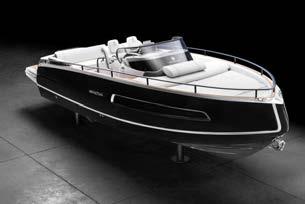
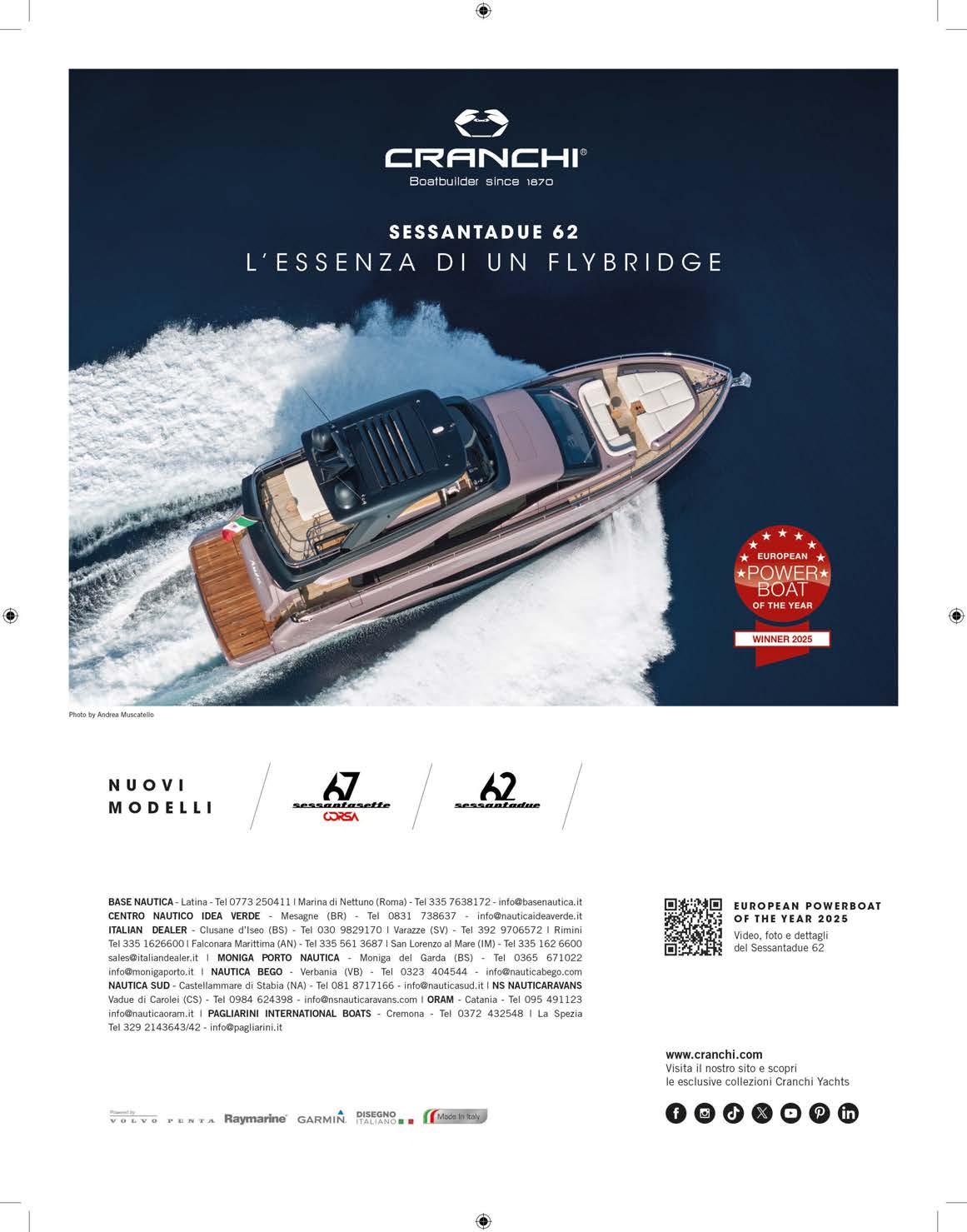

Tra le ambasciatrici di Boucheron c’è l’attrice coreana Han So-hee che indossa orecchini pendenti Quatre Classique, bracciale Quatre Classique, anelli Quatre Classique S e Quatre Classique, tutto in oro giallo, oro bianco, oro rosa, PVD marrone e diamanti.
Among the Boucheron ambassadors is Korean actress Han So-hee, who is wearing Quatre Classique pendant earrings, a Quatre Classique bracelet, a Quatre Classique S and Quatre Classique rings, all in yellow gold, white gold, rose gold, brown PVD, and diamonds.
L’Amministratore Delegato Gianluca Mazza ha commentato i buoni risultati del 2024: “Marina di Loano conferma il trend positivo degli ultimi due anni, aumentando i ricavi core, con full
CEO Gianluca Mazza has commented on the good results of 2024: “Marina di oano confirms the positive trend of the last two years, increasing core revenues, with full occupancy and consolidating both real
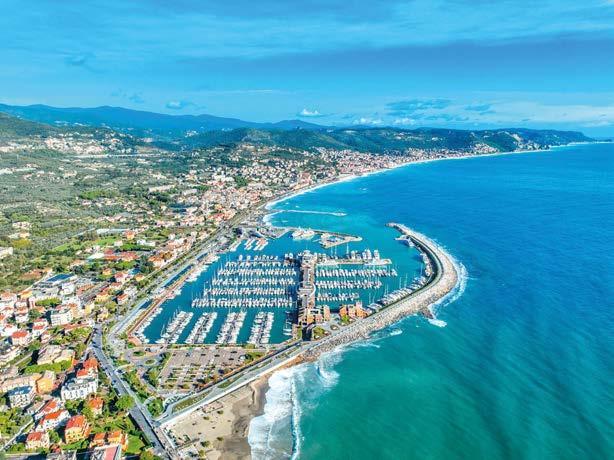
VARATO IL BENETTI BO116 DELLA FAMIGLIA DI OASIS 40M IL PROGETTO DEGLI ESTERNI È DI RWD E QUELLO DEGLI INTERNI DI BONETTI/KOZERSKI ARCHITECTURE.
GRAZIE A DUE MOTORI MAN DI 1.400 CAVALLI HA UNA VELOCITÀ MASSIMA DI 17 NODI.
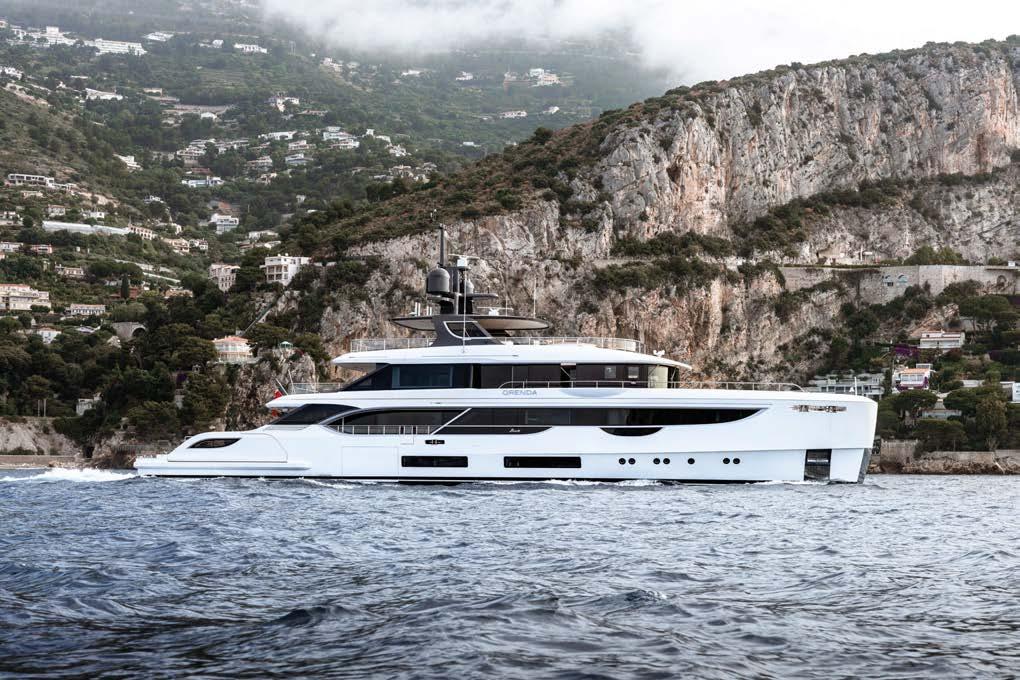
THE BENETTI BO116 OF THE OASIS 40M RANGE HAS BEEN LAUNCHED. RWD DESIGNED THE EXTERIOR, AND BONETTI/ KOZERSKI ARCHITECTURE DESIGNED THE INTERIORS.
THANKS TO TWO 1,400 HP MAN ENGINES, THE MAXIMUM SPEED IS 17 KNOTS.


Venduta la settima unità della serie Flexplorer di Cantiere delle Marche. “Ritengo che questo successo commerciale, che se ue una sta ione straordinaria di saloni nautici, sia una testimonianza della fiducia e della stima che il mercato ripone nel nostro cantiere , afferma Vasco Buonpensiere.
The seventh unit of the Cantiere delle Marche Flexplorer series has been sold. “I believe that this commercial success, which follows an exceptional boat show season, is proof of the mar et’s confidence and appreciation of our shipyard , says Vasco Buonpensiere.
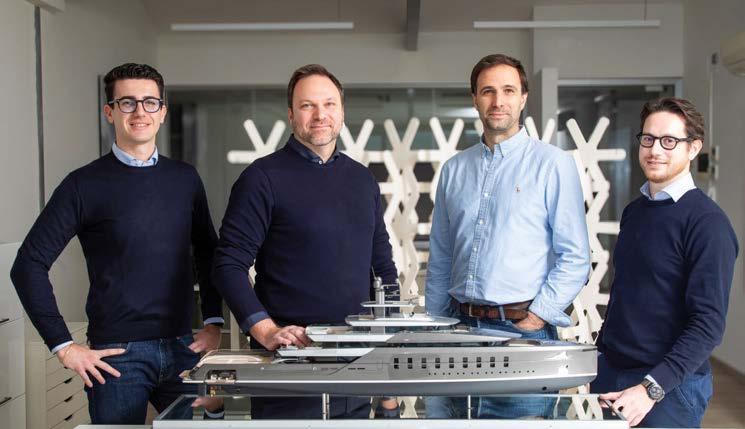
Vitruvius Yacht Design apre una sede a Viareggio. “Questa scelta rappresenta la nostra dedizione all’innovazione e all’eccellenza nello yacht design con risposte su misura per i bisogni specifici del mercato italiano”, ha dichiarato Philippe Briand, fondatore di Vitruvius Yachts. A capo del team c’è Michele Baccetti che ha una lunga esperienza nella progettazione di grandi yacht.
Vitruvius Yacht Design has opened an o ce in Viareggio. “This choice represents our commitment to innovation and excellence in yacht design, with answers tailored to the specific needs of the talian market”, said Philippe Briand, founder of Vitruvius Yachts. Michele Baccetti, who has extensive experience in the design of large yachts, will lead the team.
BOAT DAYS
Boat Days torna dal 28 al 30 marzo e dal 4 al 6 aprile al Marina di Santa Marinella con il Castello Odescalchi a fare da cornice. L’area espositiva si svilupperà sia a terra sia in acqua con imbarcazioni e gommoni per le prove per far apprezzare le prestazioni agli appassionati grazie a un’esperienza diretta.
rom the 8th to the 3 th of arch and from the th to the th of pril, the oat Days will be held again at the Santa arinella arina, with the descalchi Castle as the backdrop. The exhibition area will be set up on land and in the water, with boats and dinghies for testing, allowing enthusiasts to appreciate the performance through first hand e perience.

Always has been… always will be

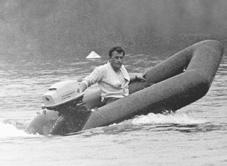


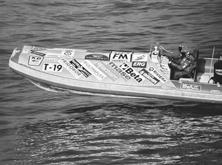

BWA, over sixty years of history, tradition, passion, love, and Italian creativity!
BWA, a timeless story and its value will endure through time!
"Originality, history, and experience, like strength and vigor, cannot be imitated!"
BWA, a legacy that sails beyond time

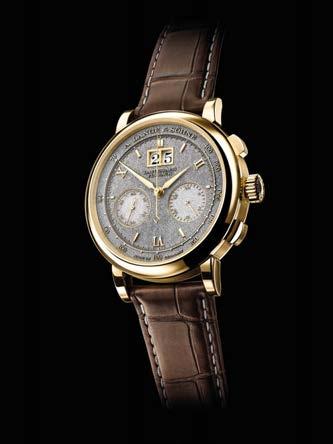
A. Lange & Söhne ha presentato il cronografo Datograph La combinazione unica di complessità tecnica e design espressivo è arricchita nell’ultimo modello da ulteriori elementi straordinari creati dai suoi maestri artigiani.
A. Lange & Söhne has presented the Datograph Chronograph. The unique combination of technical sophistication and expressive design is enhanced in the latest model by other exceptional elements created by its master craftsmen.
Udo A. Hafner, Amministratore Delegato di iYacht, nel presentare il Performance 90X ha commentato: “È un progetto entusiasmante: un marchio storico rinasce sotto una nuova proprietà tedesca. Questo modello esemplifica chiaramente ci che possiamo realizzare lavorando a fianco dei nostri clienti”.
Udo A. Hafner, Managing Director of iYacht, commented on the launch of the Performance 90X: “This is an exciting project: a historic brand is being reborn under new German ownership. his model clearly e emplifies what we can achieve when working with our customers”.
Roda presenta il sistema di divani Philia firmato da Rodolfo Dordoni, che, grazie alle generose forme e dimensioni, ricalca le origini della filosofia del marchio avvicinandosi armoniosamente ad un progetto di divani da interni, per ricreare molteplici occasioni di comfort e di grande convivialit , in un uso versatile dello spazio.
Roda presents the Philia sofa system, designed by Rodolfo Dordoni. Thanks to its generous shapes and dimensions, the system traces the origins of the brand’s philosophy: a harmonious approach to sofa design that creates multiple opportunities for comfort and great conviviality in a versatile use of space.

FRUTTO DI DECENNI DI RICERCA E INNOVAZIONE DI HONDA IN AMBITO NAUTICO, IL NUOVO BF300, DOTATO DI TECNOLOGIA VARIABLE VALVE TIMING E LIFT ELECTRONIC CONTROL, È UN MOTORE V8 A 60° E 5.000CC. AFTER DECADES OF HONDA RESEARCH AND INNOVATION IN THE MARINE INDUSTRY, THE NE BF300 IS A 60 , 5,000CC V8 ENGINE E UIPPED ITH VARIABLE VALVE TIMING AND ELECTRONIC LIFT CONTROL TECHNOLOGY.
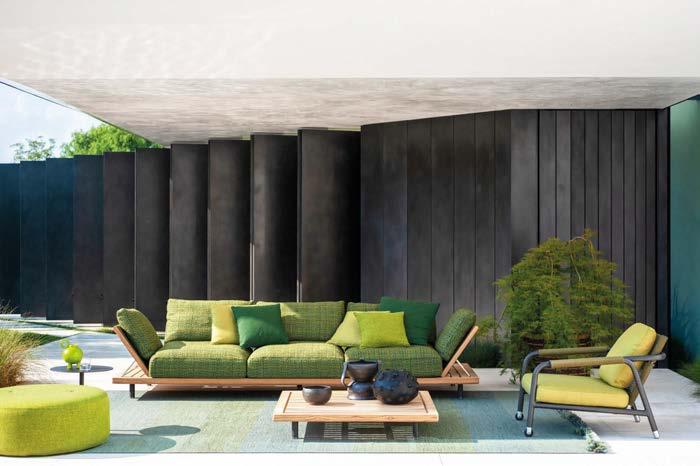



Assegnate a Marina d’Arechi le tre stelle del Rating di Legalità Agostino Gallozzi ha dichiarato: “Questo risultato premia il nostro impegno rivolto da sempre a costruire un nuovo modello di portualità turistica improntato alla qualità, alla trasparenza e alla legalità come valori fondanti della nostra attività”.
Marina d’Arechi has been awarded three stars in the Legality Rating. Agostino Gallozzi said: “This result rewards our commitment to building a new model of tourist port facilities based on quality, transparency and legality as the fundamental values of our activity”.
Rossinavi ha presentato il progetto Solsea, un superyacht catamarano ibrido-elettrico progettato in collaborazione con il designer Yves Béhar. Concepito per intraprendere
Rossinavi has presented the Solsea project, a hybrid-electric catamaran superyacht developed in collaboration with designer Yves Béhar. Designed to make long-distance crossings without

CRISTIANO GATTO HA DISEGNATO GLI INTERNI DEL PROGETTO ORION, SUPERYACHT DI 50 METRI DI LUNGHEZZA, COSTRUITO DA HEESEN, CREANDO UN INTERNO CHE MASSIMIZZA LA LUCE NATURALE GRAZIE A GRANDI SUPERFICI VETRATE. CRISTIANO GATTO HAS DESIGNED THE INTERIOR OF THE ORION PROJECT, A 50-METRE SUPERYACHT BUILT BY HEESEN, CREATING AN INTERIOR THAT MAXIMISES NATURAL LIGHT THROUGH LARGE EXPANSES OF GLASS.


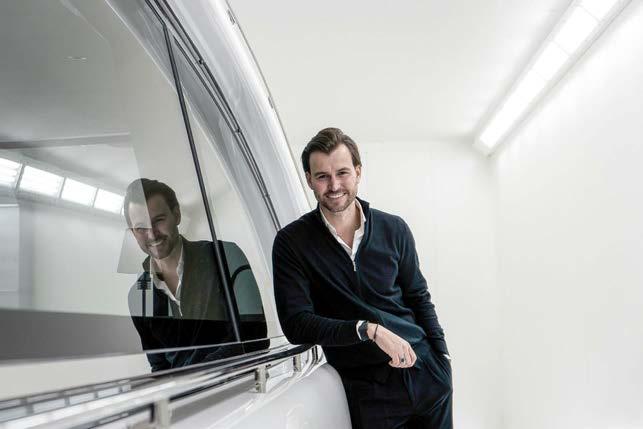
Zeelander Yachts ha nominato Floris Koopmans come nuovo responsabile dello sviluppo aziendale. Koopmans si concentrer sul ra orzamento delle attività commerciali a livello globale, supportando i proprietari di yacht e broker, garantendo che ogni interazione ri etta l’impegno del marchio per la qualità.
Zeelander Yachts has appointed Floris Koopmans as its new business development manager. Koopmans will strengthen commercial activities globally, support yacht owners and brokers, and ensure every interaction re ects the brand s commitment to quality.
Cantieri Capelli e Yamaha Motor Italia hanno presentato lo Stradivari 52, equipaggiato con quattro motori XTO da 450 cavalli ciascuno. Il team di progettazione e ingegneria si è avvalso
Cantieri Capelli and Yamaha Motor Italia have unveiled the Stradivari 52, powered by four 450hp XTO engines. Giuseppe Bagnardi’s BG Design Firm has assisted the design and engineering

B&G HA PRESENTATO IL DISPLAY B&G ZEUS S ULTRAWIDE DA 12 E 15 POLLICI CHE RENDE LA PLANCIA DI COMANDO PIÙ SEMPLICE, PULITA E RAFFINATA. I NUOVI DISPLAY INCLUDONO SPLIT SCHERMO OTTIMIZZATI E FLUSSI DI DATI ININTERROTTI PIÙ FACILI DA GESTIRE, PER AVERE ACCESSO A PIÙ INFORMAZIONI E MAGGIORI CONTROLLI.
B&G HAS INTRODUCED THE B&G ZEUS S ULTRA-WIDE 12-INCH AND 15-INCH DISPLAYS THAT MAKE THE DASHBOARD SIMPLER, CLEANER AND MORE REFINED. THE NEW DISPLAYS FEATURE OPTIMISED SPLIT SCREENS AND EASIER-TO-MANAGE SEAMLESS DATA STREAMS, GIVING YOU ACCESS TO MORE INFORMATION AND MORE CONTROLS.
Gianluca Caputi presenta il progetto Fastexplorer Yak, acronimo di Yacht Adventure Karma. La piattaforma navale si basa su quella già usata da Caputi per la serie Speedo Surfrunner 9 e a idrago 1 , e per i Cantieri Navali del Golfo per i Guardacoste della serie Corrubia
Gianluca Caputi has presented the Fastexplorer Yak project, an acronym for Yacht Adventure Karma. The marine platform is based on the one already used by Caputi for the Speedo Surfrunner 95’ and Maxidrago 105’ series and by Cantieri Navali del Golfo for the Corrubia Coastguards series.




CRN ha varato ad Ancona la nave da diporto full-custom Amor à Vida presso il Ferretti Group Superyacht Yard. La nave, costruita con scafo in acciaio e sovrastruttura in alluminio, è lunga 67 metri e larga 11,80, ha 6 ponti e può accogliere fino a 12 ospiti e 17 membri d’equipaggio.
CRN has launched the fully customised pleasure ship Amor à Vida at the Ferretti Group’s superyacht shipyard in Ancona. Built with a steel hull and aluminium superstructure, the vessel is 67 metres long and 11.80 metres wide, has six decks and can accommodate up to 12 guests and 17 crew members.
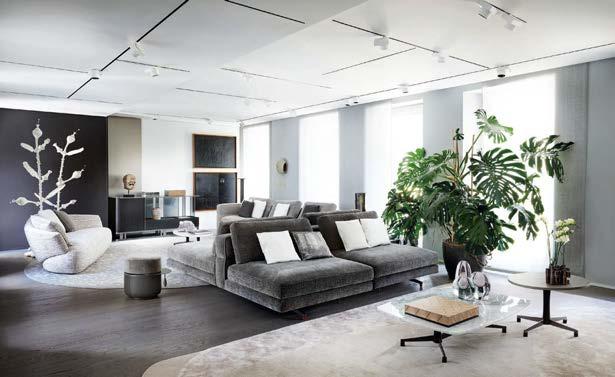
Il lifestyle Giorgetti si arricchisce con nuove soluzioni ideate per trasformare ogni spazio in un rifugio per l’abitare. La collezione Atmosphere si amplia con nuove proposte, complementi e ra nati oggetti per il d cor. Disegnate e sviluppate dall’azienda e dal suo direttore artistico Giancarlo Bosio, danno vita ad ambienti unici e originali, indagando le molte sfaccettature della quotidianità.
The Giorgetti lifestyle is enriched with new solutions designed to transform any space into a living haven. The Atmosphere collection expands with new proposals, complements and refined ob ects for decoration. Designed and developed by the company and its artistic director, Giancarlo Bosio, they create unique and original environments that explore the many facets of everyday life.
L’artista cinese He Wei ha portato negli spazi milanesi di Primo Marella Gallery la personale KometenMelodie La mostra ha accompagnato lo spettatore in un viaggio attraverso le diverse epoche storiche e artistiche tedesche dagli Anni Trenta agli Ottanta.
The Chinese artist He Wei has brought his solo exhibition KometenMelodie to the Milanese gallery Primo Marella. The exhibition took the viewer through various historical and artistic periods in Germany from the 1930s to the 1980s.

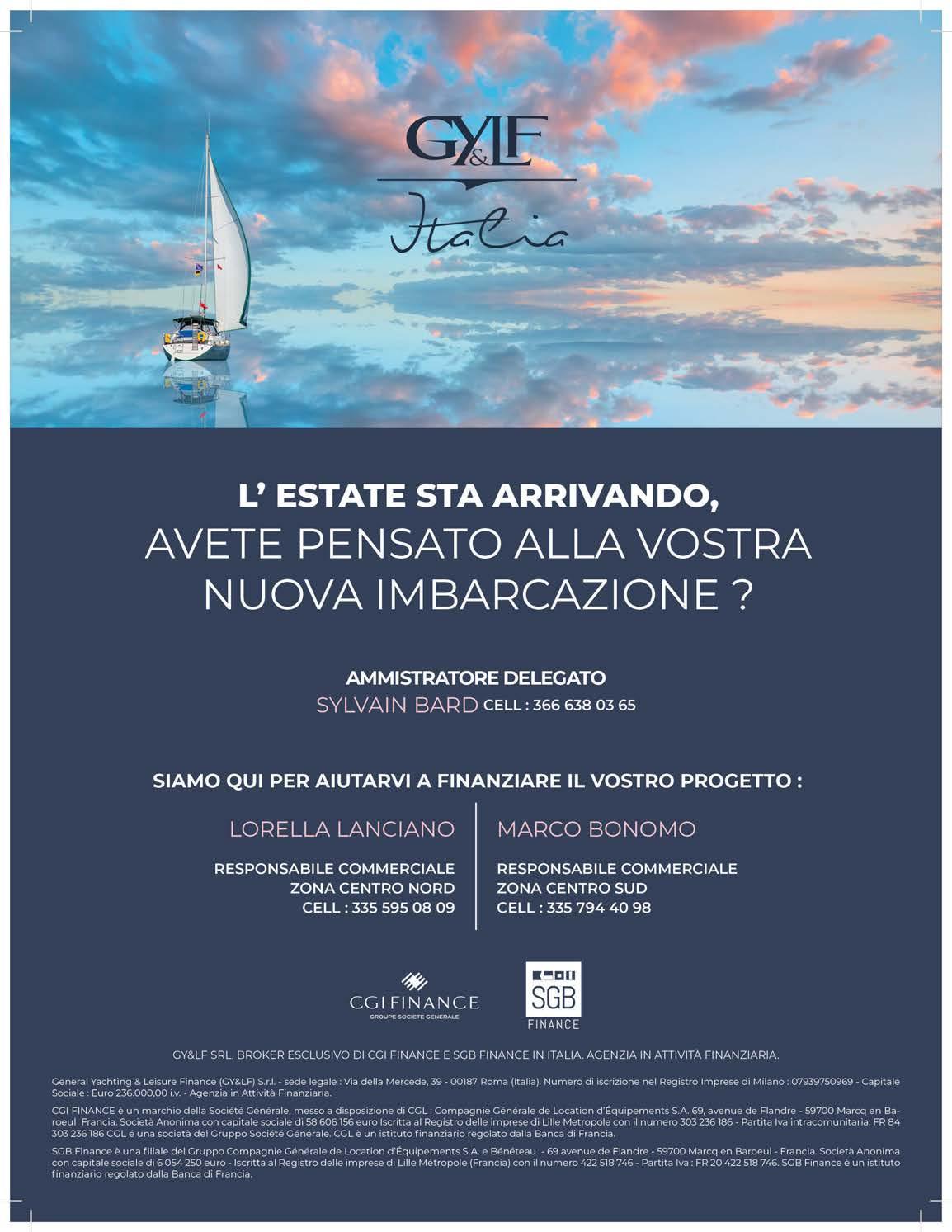
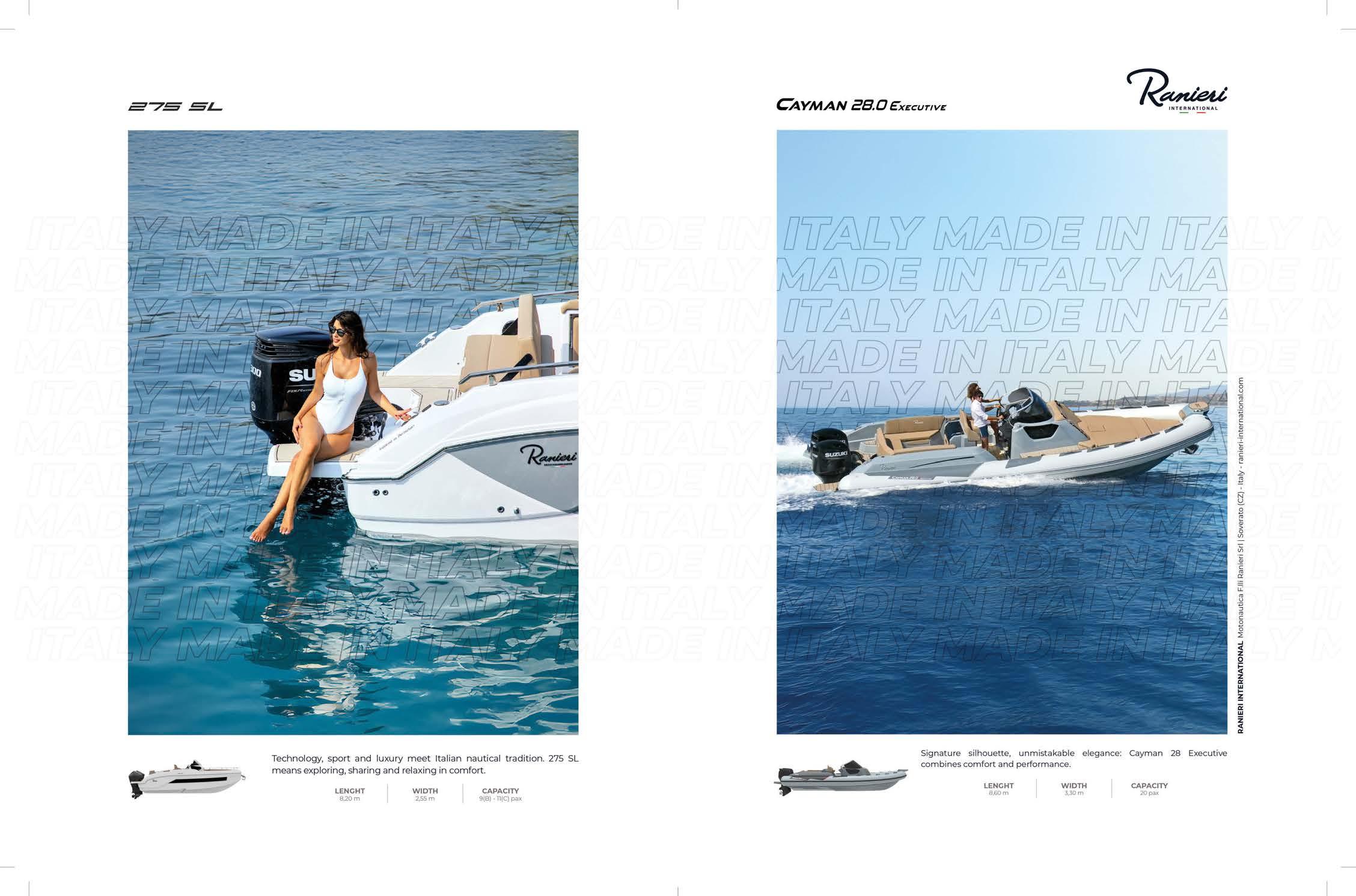



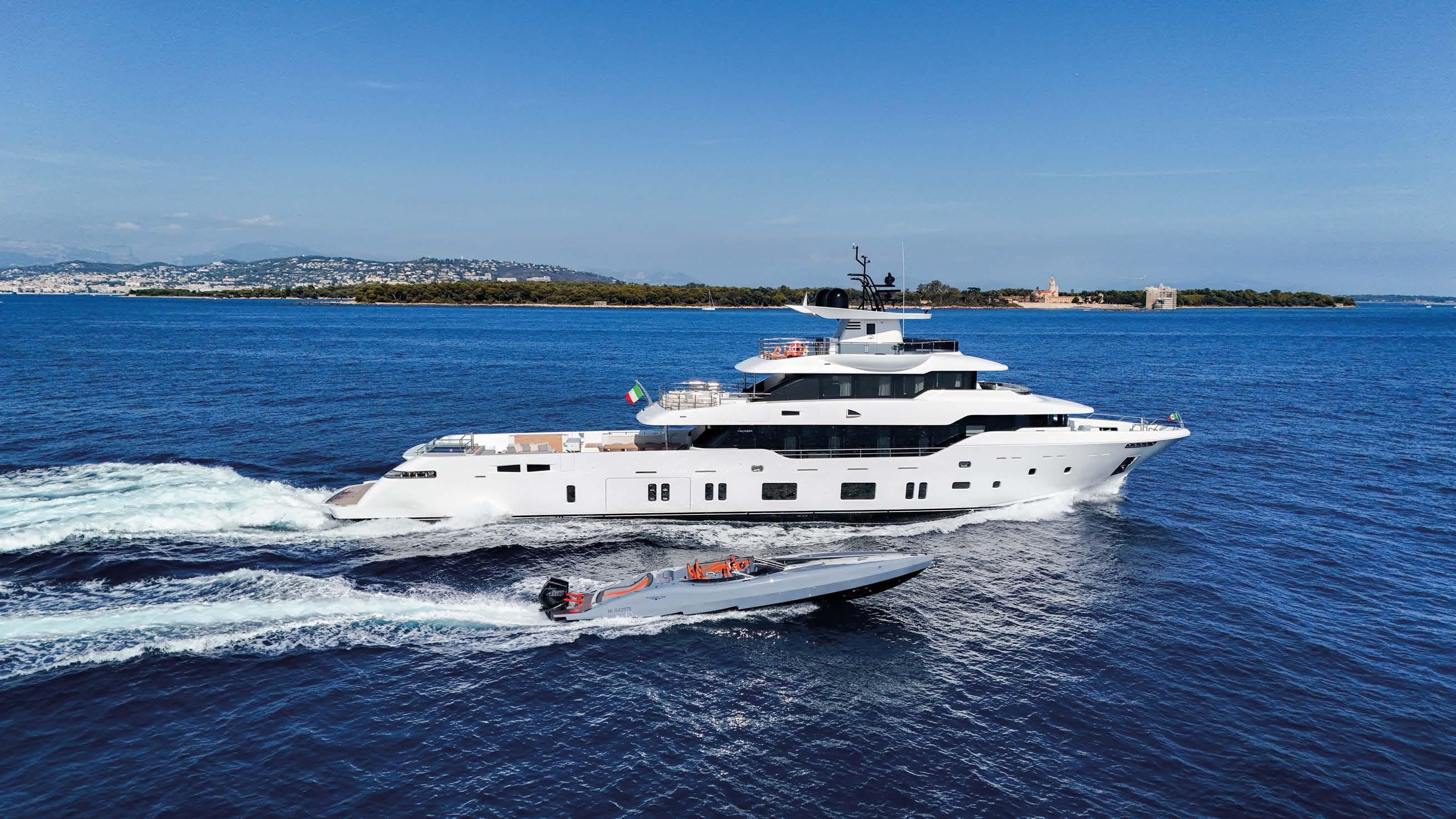
COSA ACCADE, DAL PUNTO DI VISTA FISCALE, QUANDO UNA NAVE, INIZIALMENTE UTILIZZATA PER USO PRIVATO, VIENE POI IMPIEGATA PER FINI COMMERCIALI DI NOLEGGIO? FROM A TAX POINT OF VIEW, WHAT HAPPENS IF A SHIP THAT WAS INITIALLY USED FOR PRIVATE PURPOSES IS THEN USED FOR COMMERCIAL CHARTERING PURPOSES?
by Berardo Lanci*

Conla Risposta all’interpello n. 1 del 2025, l’Agenzia delle Entrate chiarisce le condizioni per l’applicazione del regime di non imponibilità IVA di cui all’art. 8-bis del D.P.R. n. 633/1972 agli acquisti di beni e servizi destinati agli interventi straordinari di trasformazione strutturale, cosiddetti di ma or refit, attraverso i quali una nave inizialmente utilizzata per uso privato venga poi, dal nuovo armatore, impiegata per fini commerciali di noleggio.
Sul punto si ricorda in via preliminare che per il citato articolo 8bis, il riconoscimento del regime di non imponibilità ai fini IVA è subordinato alla duplice condizione di riguardare le sole navi adibite alla navigazione in alto mare nonché destinate all’esercizio di attività commerciali. In particolare, per quanto attiene alla prima condizione relativa alla navigazione in alto mare, l’armatore deve procedere alla presentazione della dichiarazione di cui al Provvedimento n. 151377 del 2021 mediante la quale attesta l’effettuazione di un numero di viaggi in alto mare superiore al 70% per cento nell’anno solare precedente a quello di effettuazione delle operazioni alle quali viene applicato il regime di non imponibilità IVA, ovvero, in caso di primo utilizzo, la presentazione della dichiarazione “provvisoria” con cui si manifesta l’intenzione di effettuare un numero di viaggi in alto mare superiore al 70 per cento al fine di avvalersi della menzionata facoltà di effettuare acquisti o importazioni senza applicazione dell’IVA. Pertanto, nella ipotesi in cui una nave non abbia effettuato alcun viaggio in alto mare, il regime di non imponibilità IVA può essere applicato in via anticipata per acquistare beni e/o servizi previo rilascio della dichiarazione dove l’armatore attesta l’effettiva intenzione di adibire il mezzo alla navigazione in alto mare, da verificarsi entro l’anno successivo a quello del varo della nave o comunque di esercizio della stessa.
i fini fiscali il ma or refit considerato alla streg a del periodo di costr ione di na nave.
For tax purposes, the major refit is considered to be the same as the construction period of a vessel.
Nel caso oggetto di interpello si intende chiarire cosa accada nelle ipotesi in cui la navigazione non possa avvenire nell’anno successivo all’acquisto dei beni e servizi per i quali si vuole beneficiare del regime di non imponibilità IVA sopra richiamato. Ebbene, in questo caso, sottolinea l’Agenzia delle Entrate – in linea con la ratio unionale – il ma or refit viene assimilato alle ipotesi delle navi in costruzione, che non hanno effettuato alcun viaggio nell’anno precedente. Per queste navi, infatti, la condizione dell’effettivo utilizzo in alto mare deve essere accertata non già a conclusione dell’anno solare di presentazione della dichiarazione “provvisoria”, bensì a conclusione di quello successivo al varo della nave ovvero, nelle ipotesi di ma or refit, successivo all’anno di
on la isposta all interpello n. del , l gen ia delle ntrate chiarisce le modalit di applica ione del regime di non imponi ilit , di c i all art. is del . . . n. , alle ipotesi di cosiddetto ma or refit.
primo utilizzo della nave. Peraltro, l’Agenzia delle Entrate conferma il riferimento a quanto avviene per le navi in costruzione, anche per quanto attiene alla destinazione a scopi commerciali della nave: in questo caso, la destinazione commerciale si assume solo a seguito dell’iscrizione della nave medesima nel registro delle navi commerciali. A tal riguardo, nel documento di prassi qui in commento si fa riferimento anche all’importanza degli enti certificatori che garantiscono che la natura degli interventi di major refit sia tale da permettere l’utilizzo della nave per fini commerciali di noleggio, sulla base dei requisiti previsti dalla normativa di riferimento, che sono ben diversi da quelli propri delle navi utilizzate per i propri fini personali dell’armatore.
The Ruling No. 1/2025 of the Revenue Agency clarifies the application of the VAT non-taxable regime, under Article 8-bis of Presidential Decree No. 633/1972, to the case of the so-called ma or refit.
With Ruling No. 1 of 2025, the Italian Revenue Agency clarifies the conditions for applying the VAT nontaxable regime provided for by Article 8-bis of Presidential Decree No. 633/1972 to the purchase of goods and services intended for extraordinary structural transformation works, so-called major refit, through which a vessel initially used for private use is then, by the new shipowner, used for commercial charter purposes.
On this point, it should be preliminarily recalled that under the aforesaid Article 8bis, recognition of the non-taxable regime for VAT purposes is subject to the double condition that it concerns only vessels used for navigation on the high seas and intended for the exercise of commercial activities. In particular, as regards the first condition relating to navigation on the high seas, the shipowner must proceed with the submission of the declaration under Regulation no. 151377 of 2021 through which he certifies the execution of some sailings on the high seas exceeding 70% in the calendar year preceding the year of execution of the activities to which the VAT non-taxable regime is applied, or, in the event of first use, the presentation of the ‘provisional’



Berardo Lanci VAM Tax & Corporate Firm
Mobile: +39 347 3441141 T. + 377 643919404
E-mail: berardo.lanci@vam-lawtax.com
L’Avvocato Berardo Lanci è partner dello Studio VAM Tax&Corporate Firm, che aderisce al network internazionale VAM – Valuable Assets Management. L’Avvocato Berardo Lanci – che all’interno dello Studio ricopre anche il ruolo di responsabile del dipartimento Yachting & Aviation – vanta tra le proprie aree di specializzazione un’esperienza ventennale nell’ambito della tassazione della nautica da diporto, maturata sia prestando assistenza consulenziale sia rappresentando e difendendo i propri clienti davanti agli organi dell’amministrazione finanziaria
Berardo Lanci is a partner of VAM Tax&Corporate Firm, which is a member of the international network VAM - Valuable Assets Management. Berardo Lanci - who is also the head of the Yachting & Aviation department within the firm - can boast years of e perience in the field of yachting taxation, which he gained both by providing consultancy assistance and by representing and defending his clients before the tax administration
declaration through which he declares his intention to carry out several sailings on the high seas exceeding 70% to avail himself of the option above to make purchases or imports without the application of VAT. Therefore, in the hypothesis that a vessel has not made any voyages on the high seas, the VAT non-taxable regime may be applied in advance for the purchase of goods and services subject to the issuance of the declaration in which the shipowner certifies the actual intention to use the vessel for navigation on the high seas, to be verified within the year following the year in which the ship is put to sea or in any case the year in which it is operated. In the case under discussion, the intention is to clarify what happens in the hypotheses in which navigation cannot take place in the year following the purchase of the goods and services for which one wishes to benefit from the VAT non-taxable regime referred to above.
In this case, the Revenue Agency - in line with the EU policy - underlines that the ma or refit is assimilated
In ipotesi di ma or refit la verifica delle condi ioni di naviga ione in alto mare previste per l applica ione del regime di non imponi ilit potr essere e ett ata al termine
to the hypothesis of a vessel under construction that has not made any voyage in the previous year. For these vessels, the condition of actual use on the high seas must be ascertained not at the end of the calendar year of presentation of the ‘provisional’ declaration but at the end of the year following the launch of the vessel or, in the case of a ma or refit, following the year of first use of the boat. Moreover, the Revenue Agency confirms what happens for vessels under construction and the vessel’s destination for commercial purposes. In this case, the commercial destination is assumed only following the registration of the same boat in the register of commercial ships. In this regard, the Ruling also refers to the importance of the certifying bodies that ensure that the nature of the significant refit work is such as to allow the vessel to be used for commercial chartering purposes based on the requirements provided by the reference regulations, which are quite different from those of ships used for the shipowner’s purposes.
In case of a ma or refit, checking the conditions of navigation on the high seas required for applying the VAT non-taxable regime may be carried out at the end of the calendar year of the vessel’s




ART BASEL MIAMI HA REGISTRATO CIRCA 75.000 VISITATORI, 286 ESPOSITORI, DI CUI 34 GALLERIE AL DEBUTTO, DA 38 PROVENIENZE DIVERSE. SONO STATI PRESENTI OLTRE 230 RAPPRESENTANTI DI MUSEI, FONDAZIONI E ISTITUZIONI
DELL’ARTE DI TUTTO IL MONDO
ART BASEL MIAMI RECORDED AROUND 75,000 VISITORS, 286 EXHIBITORS, AND 34 DEBUT GALLERIES FROM 38 COUNTRIES. MORE THAN 230 REPRESENTATIVES OF MUSEUMS, FOUNDATIONS AND ART INSTITUTIONS FROM ALL OVER THE WORLD WERE PRESENT
by Giovanni Gasparini

Art Basel Miami Beach, sotto la guida del suo nuovo direttore, Bridget Finn, ha registrato 286 gallerie provenienti da 38 paesi. a fiera mette in risalto la diversità delle voci che plasmano la scena artistica mondiale.
Ursula Casamonti della galleria fiorentina Tornabuoni Art, fa parte di un selezionato gruppo di gallerie italiane presenti in fiera. Ursula rappresenta, insieme al fratello Michele, la seconda generazione del business iniziato dal padre Roberto, grande mercante di opere d’arte oltre che collezionista e artista, a loro volta mentori della terza generazione destinata a continuare il successo che passa sempre più dalla partecipazione alle grandi fiere internazionali.
Ursula Casamonti of the Florentine gallery Tornabuoni Art, one of a select group of Italian galleries, was present at the fair. Together with her brother Michele, Ursula represents the second generation of the business founded by their father Roberto, a great art dealer, collector and artist who mentors the third generation, destined to continue the success increasingly achieved through participation in major international fairs.
Under the leadership of its new director, Bridget Finn, Art Basel Miami Beach registered 286 galleries from 38 countries. The fair highlights the diversity of voices shaping the global art scene.
L’ultimo appuntamento dell’anno con le fiere d’arte si tiene tradizionalmente a Miami la prima settimana di Dicembre. Lasciata la fredda Europa e la neve parigina caduta a Novembre sulla Biennale al Grand Palais, il brand fieristico Art Basel catalizza l’attenzione di ottantamila fra collezionisti e curiosi più o meno celebri a Miami Beach, portando con sé una dozzina di fiere ‘satellite’ fra cui le locali ArtMiami, con la sua storia pluridecennale, NADA organizzata dalle gallerie nordamericane, e le più piccole e ‘cool’ come PooL, che si tiene nel posto più frequentato in Florida un hotel centrato su una piscina. Ne parliamo con una osservatrice d’eccezione, dall’alto della sua esperienzea pluriennale e della presenza costante alla fiera Art Basel nelle sue quattro declinazioni Basilea, Parigi, Hong Kong, e Miami oramai da decenni Ursula Casamonti della galleria fiorentina Tornabuoni Art, parte di un selezionato gruppo di gallerie italiane presenti in fiera. L’arte italiana del Novecento e contemporanea è al centro dell’offerta della galleria, e Miami rappresenta l’occasione per relazionarsi con i compratori americani e latini. “ a vicinanza con le fiere di ondra e ari i a ttobre fa s che a iami il pubblico sia principalmente locale, con una forte presenza latinoamericana .
Non sono mancate le vendite “Abbiamo venduto oltre una dozzina di opere,
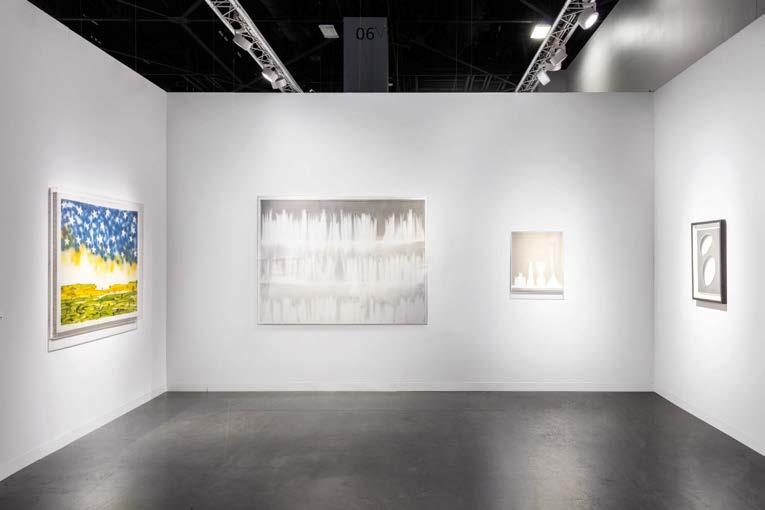



a sensa ione pi di sa è che il mercato dell’arte continui a ricalibrare il tiro, con una proposta, in generale, meno concentrata sulle opere più costose e più variegata e accessibile per range di prezzi, così da accogliere anche nuove generazioni di collezionisti.
The most widespread feeling is that the art market is continuing to recalibrate its focus, generally proposing less concentration on the most expensive works and a more varied and accessible price range to accommodate new generations of collectors.
probabilmente il numero pi elevato di sempre, fra cui diversi artisti contemporanei i noti in Italia come milio Is r e laudio armi iani .
Le ‘cancellazioni’ dell’artista siciliano sono sempre più note e apprezzate dal pubblico internazionale, pur non essendo certo in linea con lo spirito ‘Pop Art’ e favorevole ai colori accesi che domina le molte gallerie di arte contemporanea presenti in fiera, cui forse sarebbe più associabile l’opera di Dorazio con i suoi ‘reticoli’ stratificati, o i manifesti strappati di Rotella.
“ ell’ambito della scultura vende molto ablo Atchu arry, uru uaiano noto per le sue costruzioni astratte dalle eometrie intri anti. Abbiamo riscontrato rande attenzione anche per le artiste riscoperte come adamaino e arla Accardi, e al Surrealismo che va forte in America atina razie anche ad artisti come il cubano ilfredo am e il cileno atta .
E i nostri artisti del dopoguerra?
“Abbiamo intavolato trattative per le opere milionarie proposte di ucio ontana e Ali hiero oetti, ma i collezionisti sembrano predili ere li acquisti nella fascia di prezzo entro i duecentomila dollari , rivela Ursula. Nonostante l’attività lasci poco tempo per uscire dall’immenso padiglione della fiera, Ursula non si è fatta mancare un paio di eventi della moda fra i mille che animano la settimana dell’arte, ma anche una visita al Design District e ad alcuni dei molti


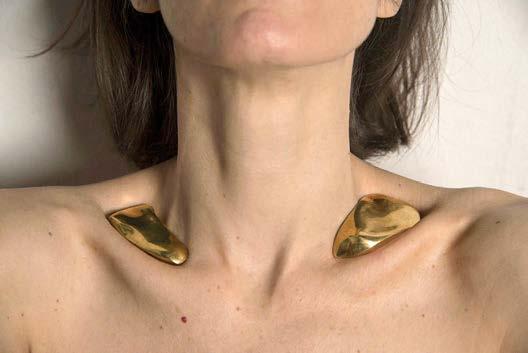
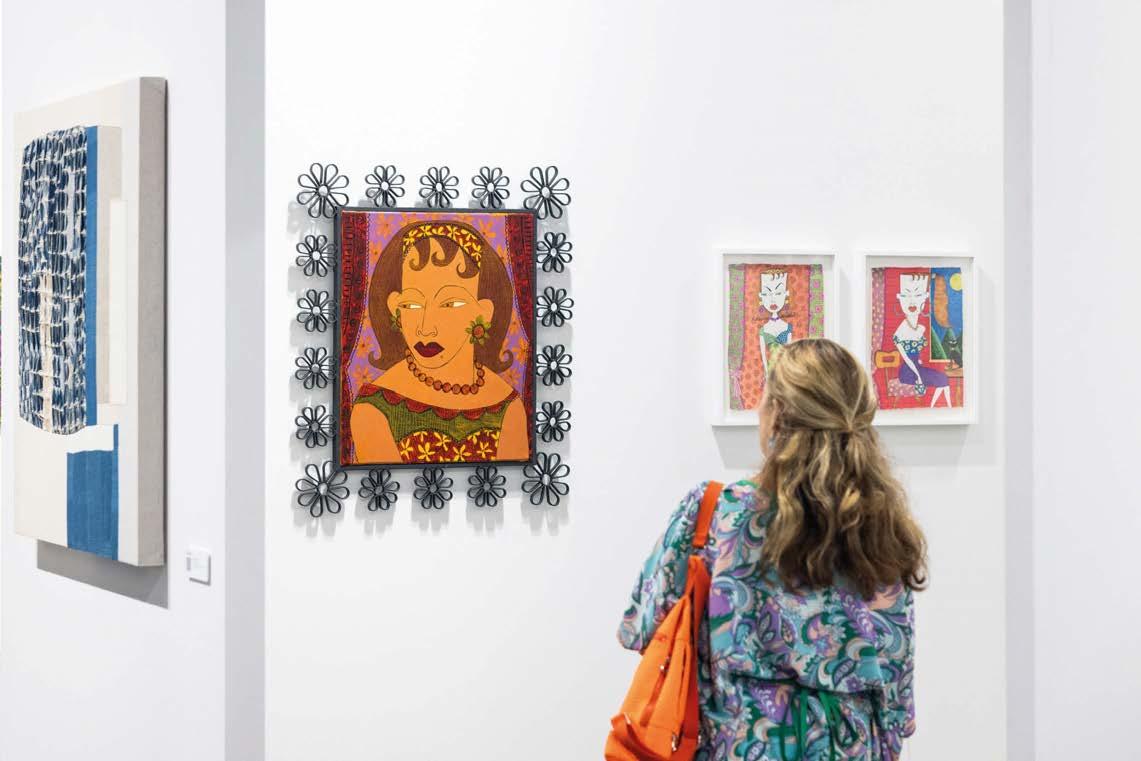







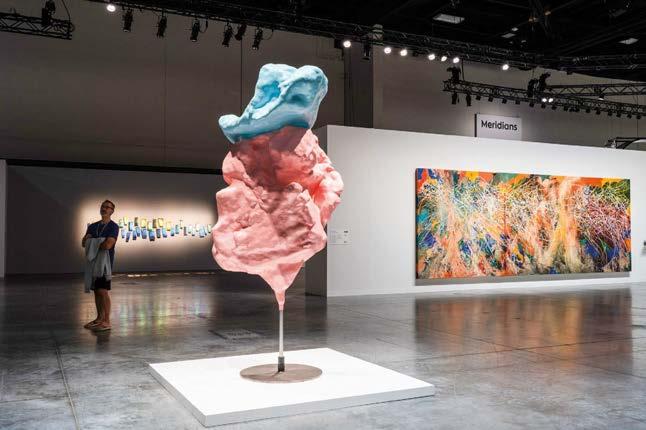

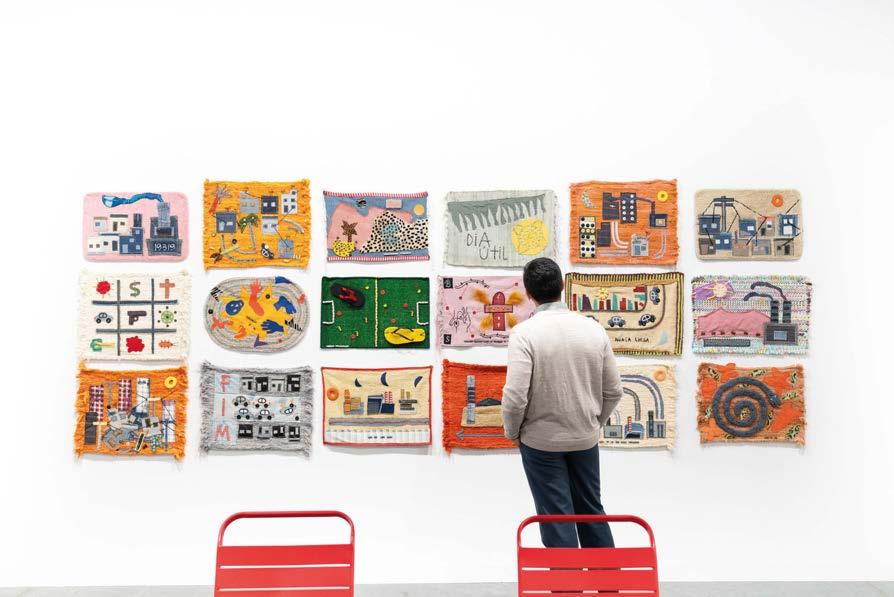
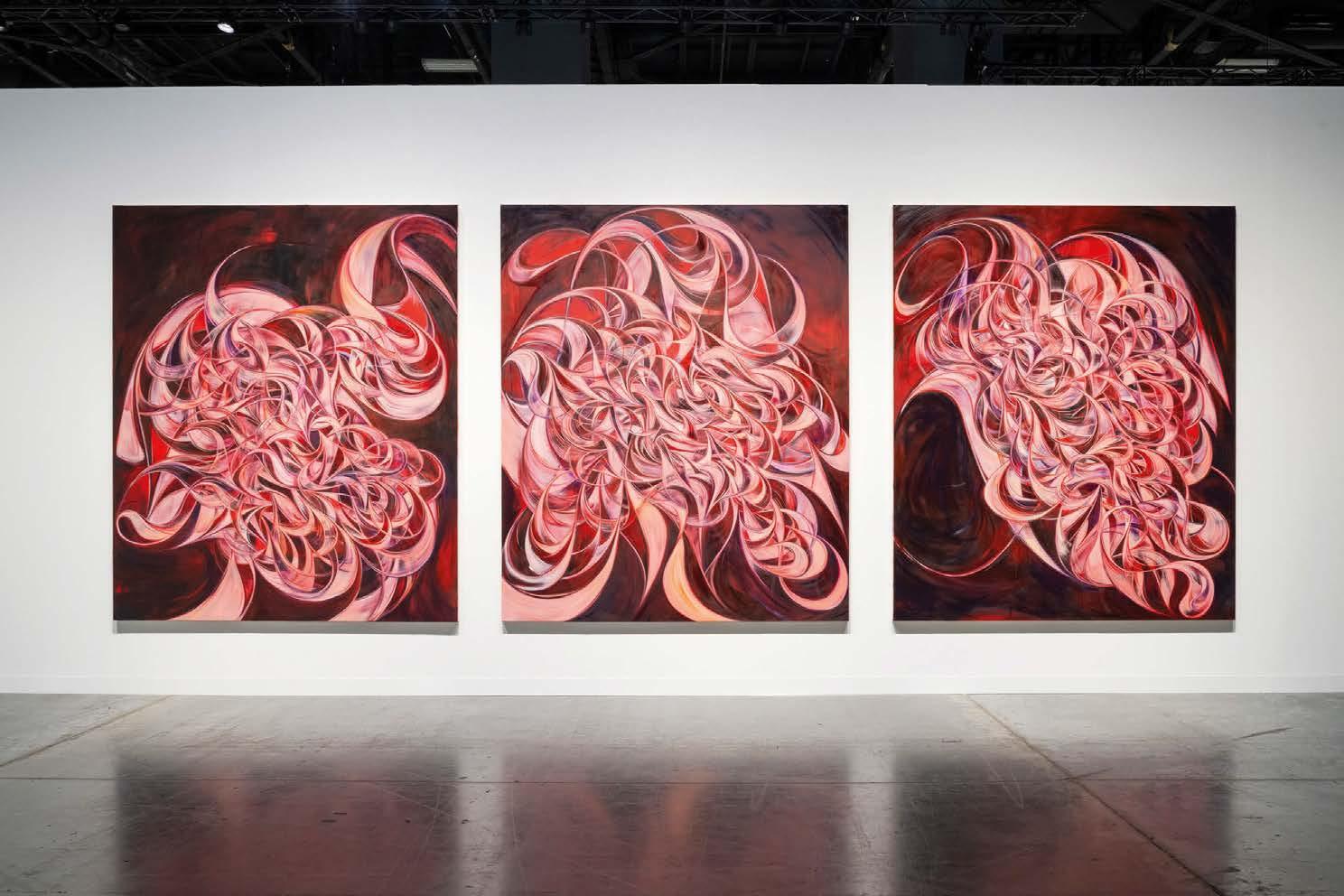
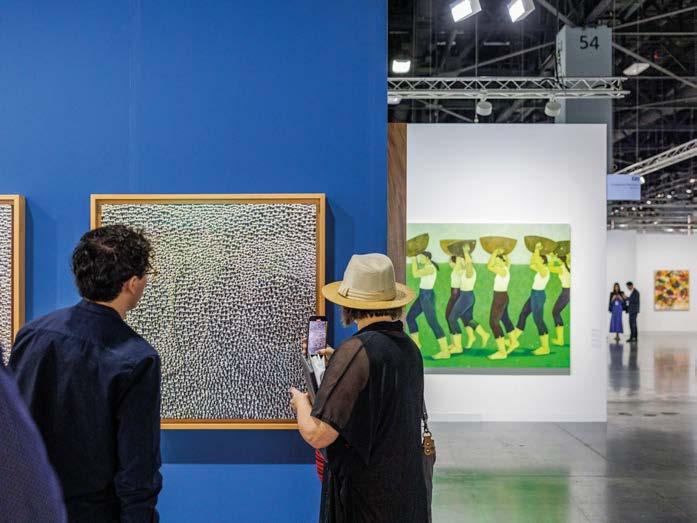
Nell’arco di quattro giorni, Art Basel Miami è diventato un punto di riferimento per gli appassionati d’arte per visualizzare e apprezzare le collezioni di opere di alcuni degli artisti più in enti al mondo.
Over four days, Art Basel Miami has become a focal point for art enthusiasts to view and appreciate collections of works by some of the world’s most in uential artists.
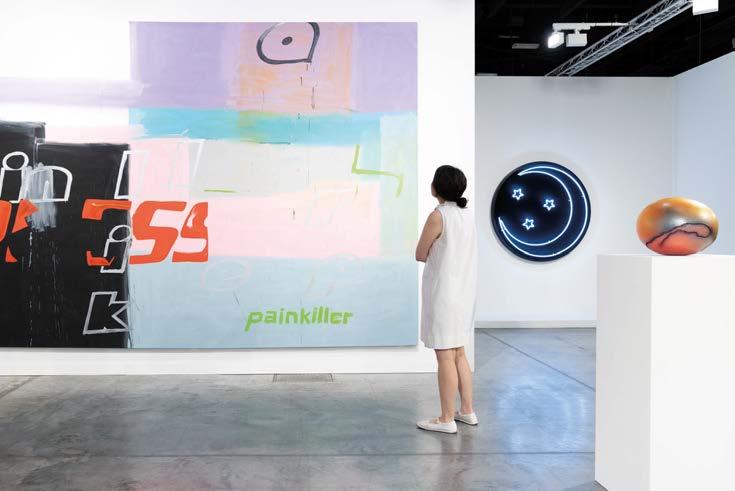
musei pubblici e collezioni private aperte in città “In particolare, vorrei tornare a vedere con calma il useo erez e la collezione ar uelis con le sue opere di Anselm iefer e immo aladino . Miami vuol dire anche mare e nautica, non poteva quindi mancare una domanda sul rapporto fra l’attività della galleria e l’arredo dei grandi yacht privati “Siamo molto fieri delle diverse occasioni in cui abbiamo venduto opere che ora vivono sul mare, razie anche a desi ner lun imiranti come uca ini, e ricordo con piacere l’installazione di un lavoro di Alberto iasi su un Sanlorenzo . Uno sforzo encomiabile per aiutare la nautica di lusso ad uscire dagli eccessi di gusto discutibile in cui talora ricade, grazie ad opere d’arte ben scelte.
The last art fair of the year traditionally takes place in Miami in the first week of December. Leaving behind the cold of Europe and the Parisian snow that fell on the Biennale at the Grand Palais in November, the Art Basel brand of fair catalyses the attention of eighty thousand collectors and more or less famous spectators in Miami Beach, bringing with it a dozen “satellite” fairs, including the local ArtMiami, with its decades-long history, NADA, organised by North American galleries, and the smaller and “cooler” ones, such as PooL, held in the most frequented place in Florida a hotel built around a swimming pool.
e talk about this with an exceptional observer, from the height of her many years of experience and constant presence at the Art Basel fair in its four declinations Basel, Paris, Hong Kong and Miami for decades now Ursula Casamonti of the Florentine gallery Tornabuoni Art, one of a select group of Italian galleries present at the fair. Twentieth-century and contemporary Italian art is at the heart of the gallery’s offering, and Miami is an opportunity to connect with American and Latin American buyers. The proximity to the London and Paris fairs in October means that the audience in Miami is mainly local, with a strong Latin American presence. There was no shortage of sales “ e sold over a dozen wor s, probably the hi hest number ever, includin several contemporary artists already nown in Italy, such as milio Is r and laudio armi iani . The Sicilian artist’s ‘erasures’ are increasingly known and appreciated by international audiences.
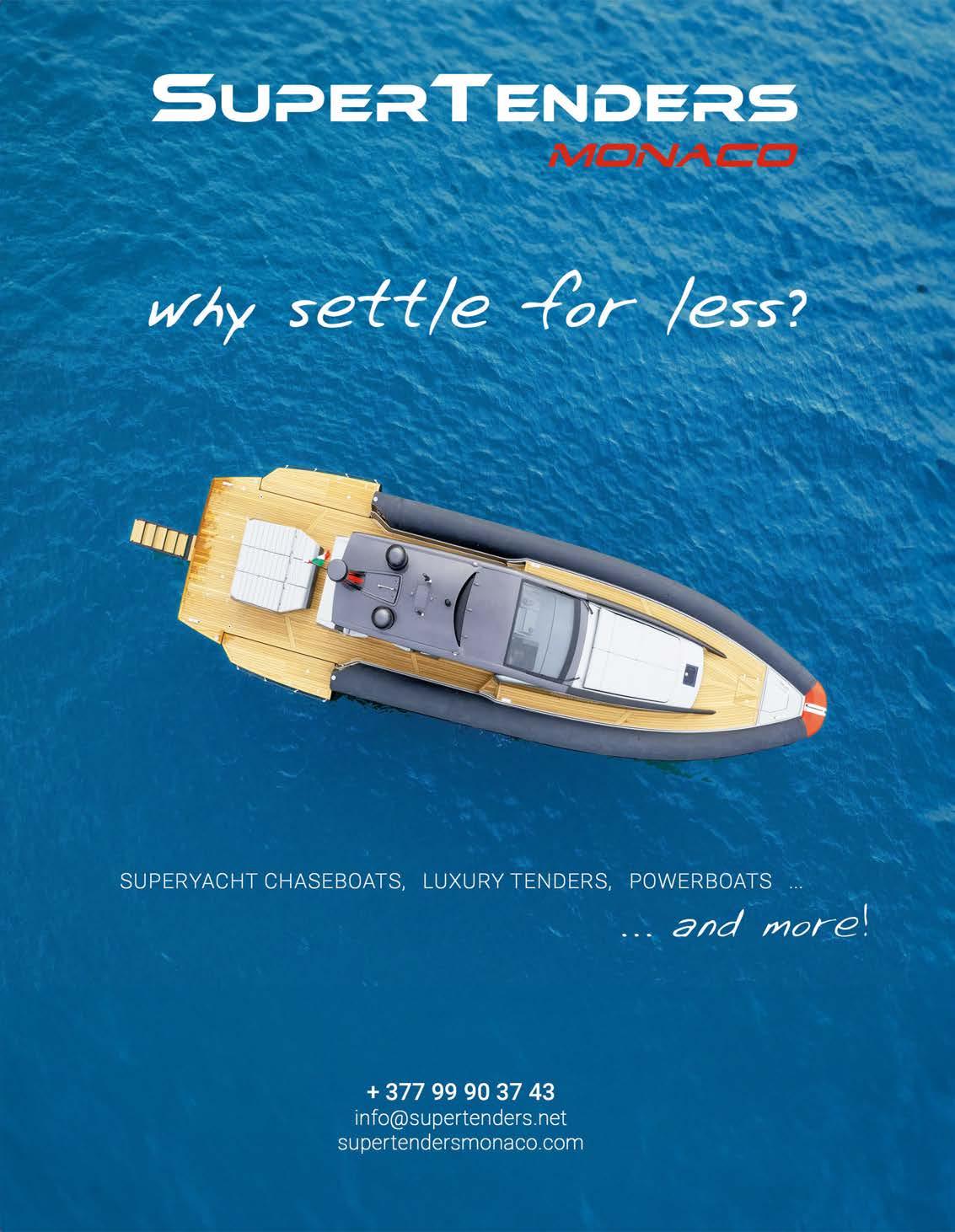

La Miami Art Week non riguarda solo l’arte. Riguarda anche le feste, la moda e gli avvistamenti di celebrità. Dalle cene esclusive alle conferenze d’arte private, alle inaugurazioni di gallerie fino alle feste s gli yacht, succede sempre qualcosa.
Miami Art Week is not only about art. It’s also about parties, fashion, and celebrity sightings. There is always something going on, from exclusive dinners to private art conferences and gallery openings to yacht parties.

However, they are certainly not in keeping with the ‘pop art’ spirit and preference for bright colours that dominate the many contemporary art galleries at the fair, with which one would perhaps associate Dorazio’s work with its layered ‘grids’ or Rotella’s torn posters. “Pablo Atchugarry, a Uruguayan known for his abstract constructions with intriguing geometries, is selling well in terms of sculpture. We have also seen a great interest in rediscovered artists such as Dadamaino and Carla Accardi and in Surrealism, which is very strong in Latin America thanks to artists such as the Cuban Wilfredo Lam and the Chilean Matta”. And our post-war artists? “We have negotiated the proposed million-dollar works of Lucio Fontana and Alighiero Boetti, but collectors seem to prefer purchases in the two hundred thousand dollar range”, Ursula reveals. Although all the activity at the fair leaves little time to get out of the vast pavilion, Ursula did not miss a few fashion events among the thousands that animate the art week, but also a visit to the Design District and some of the many public museums and private collections that are open in the city: “In particular, I would like to come back to see the Perez Museum and the Marguelis collection with its works by Anselm Kiefer and Mimmo Paladino”. Miami is also synonymous with the sea and boats, so the question of the relationship between the gallery’s activity and the furnishing of large private yachts could not be left
“We are very proud of the various occasions on which we have sold works that now live at sea, thanks also to far-sighted designers such as Luca Dini, and I fondly recall the installation of a work by Alberto Biasi on a Sanlorenzo”. It is a praiseworthy effort to help luxury yachting escape from the excesses of questionable taste into which it sometimes falls, thanks to well-chosen works of art.
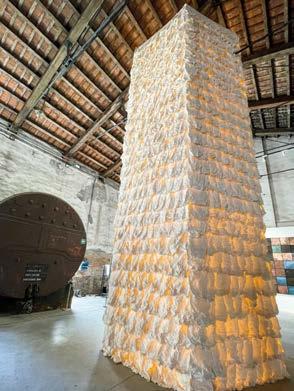
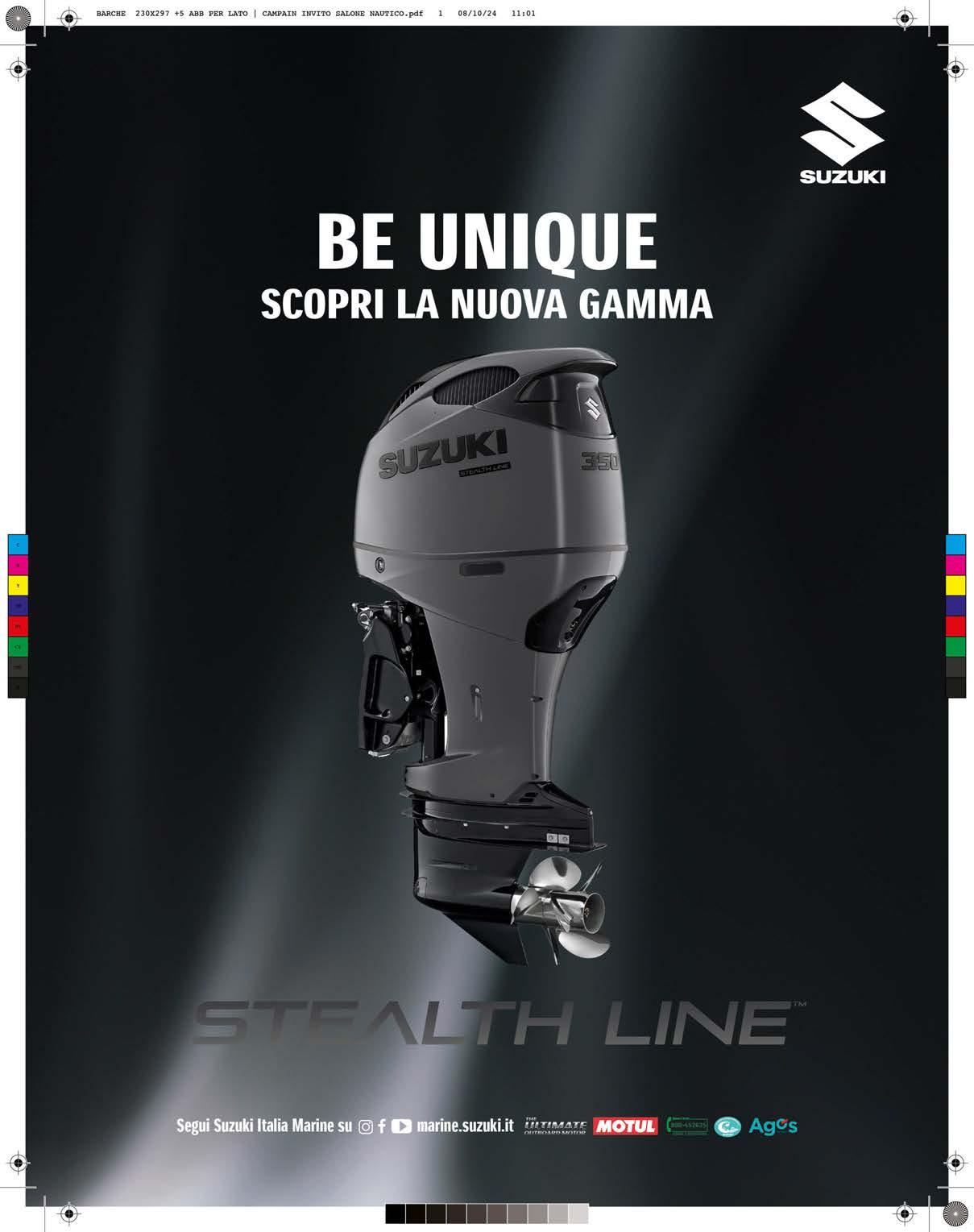
BUCCELLATI È IL BRAND DI GIOIELLERIA, OROLOGERIA
E ACCESSORI DI LUSSO FONDATO A MILANO NEL 1919
DA MARIO BUCCELLATI
BUCCELLATI IS A LUXURY JEWELLERY, WATCHES AND ACCESSORIES BRAND FOUNDED IN MILAN IN 1919
BY
MARIO BUCCELLATI
by Prisci a Baldesi

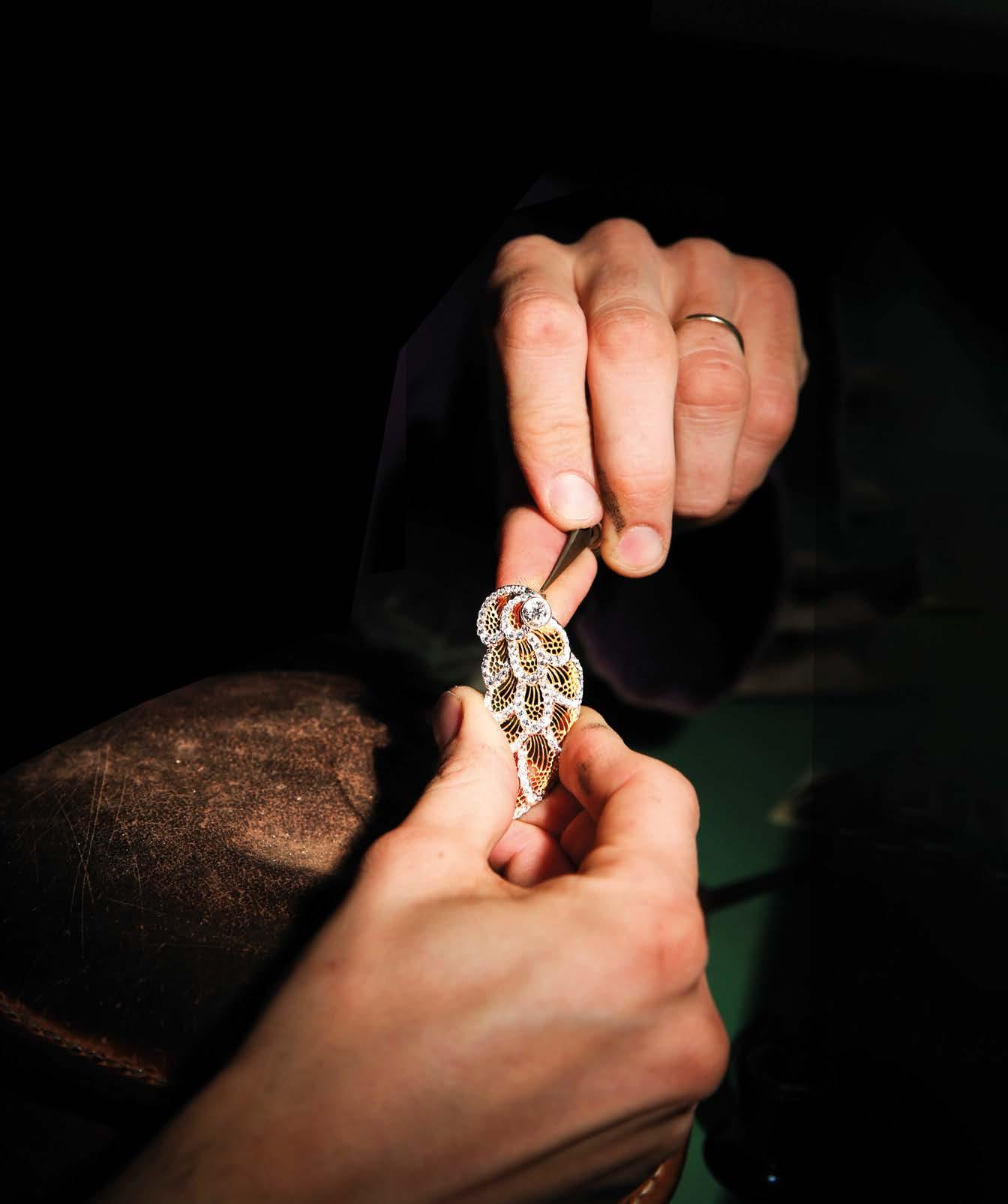



L’alta gioielleria Buccellati è frutto del sapiente e costante lavoro dei suoi artigiani per creare pezzi di alta gioielleria unici nel loro genere. L’incrollabile impegno verso l’eccellenza è una testimonianza di passione e dedizione, nonché sinonimo di bellezza e artigianalità.
Buccellati Fine Jewellery is the result of the skilful and constant work of its craftsmen, who create uni ue pieces of fine ewellery. The unwavering commitment to excellence is a testament to passion and dedication and is synonymous with beauty and craftsmanship.
MarioBuccellati, orafo esperto e visionario, fin dagli inizi della sua carriera si mostra capace di fondere tradizione e innovazione per creare gioielli di una eleganza tanto sofisticata quanto discreta, tale da interpretare gusti e desideri della clientela del tempo. La sua fama si diffonde rapidamente grazie a lavorazioni artigianali uniche basti pensare al pizzo d’oro, il tulle e il nido d’ape, ispirati alle antiche tecniche del sapere orafo italiano e capaci di conferire ai gioielli una straordinaria leggerezza e raffinatezza.
E così, in pochi anni Mario espande il suo atelier con boutique a Roma e Firenze, attirando l’attenzione di clienti illustri, tra cui Gabriele D’Annunzio, grande estimatore del brand e delle sue creazioni, come le celebri Coppe di Boscoreale ispirate all’arte romana e i preziosi oggetti della Collezione Hawaii. Con l’arrivo dei figli di Mario, Buccellati accresce ulteriormente la sua notorietà,


fino ad approdare negli Stati Uniti sono gli inizi degli Anni ’50 e l’apertura delle nuove boutique di New York e Palm Beach sancisce definitivamente la conquista dell’élite internazionale. Personaggi celebri come Gregory Peck scelgono le creazioni Buccellati non solo per i suoi capolavori di gioielleria, ormai considerati accessori imprescindibili, ma anche per la sua inimitabile e apprezzatissima Art de la Table L’espansione prosegue grazie a Gianmaria Buccellati, erede di Mario, che consolida la fama del brand in Giappone e, forte della collaborazione del suo secondogenito Andrea, si consacra il primo italiano a inaugurare una boutique a Parigi, nella celebre Place Vend me. Questo grande evento non lascia indifferente il pubblico che, tra i grandi illustri, registra la presenza di acques Chirac, Marcello Mastroianni e Anouk Aimée. Gianmaria arricchisce l’eredità creativa con collezioni come Macri dedicata, l’acronimo del nome lo rivela, alla grazia sofisticata di sua figlia Maria Cristina, Étoilée, il cui punto di forza è l’estro geometrico del giovane Andrea, e Animalier, la collezione con cui Gianmaria, ispirato dalle forme bizzarre di alcune pietre barocche, esalta la maestria artigianale e l’amore
Buccellati amplia e perfeziona l’esposizione di Via Montenapoleone 23, a Milano, con l’apertura del Piano Nobile al primo piano dello storico Palazzo Gavazzi, nel cuore della famosa via dello shopping di lusso. Uno spazio nuovo, vasto e prestigioso che segna un ulteriore passo avanti nell’evoluzione della Maison.
Buccellati expands and perfects its presence in Via Montenapoleone 23 in Milan with the opening of the Piano Nobile on the first oor of the historic Palazzo Gavazzi, in the heart of the famous luxury shopping street. This new, spacious, and prestigious space marks a further step forward in the Maison’s evolution.


di

Opera è la Collezione resa iconica dall’inconfondibile motivo tulle caratteristico di molte creazioni Buccellati. Questa linea di gioielleria si presta a continue interpretazioni, tutte estremamente fantastiche, dove l’elemento logo diventa il protagonista principale e il centro di una creatività accattivante.
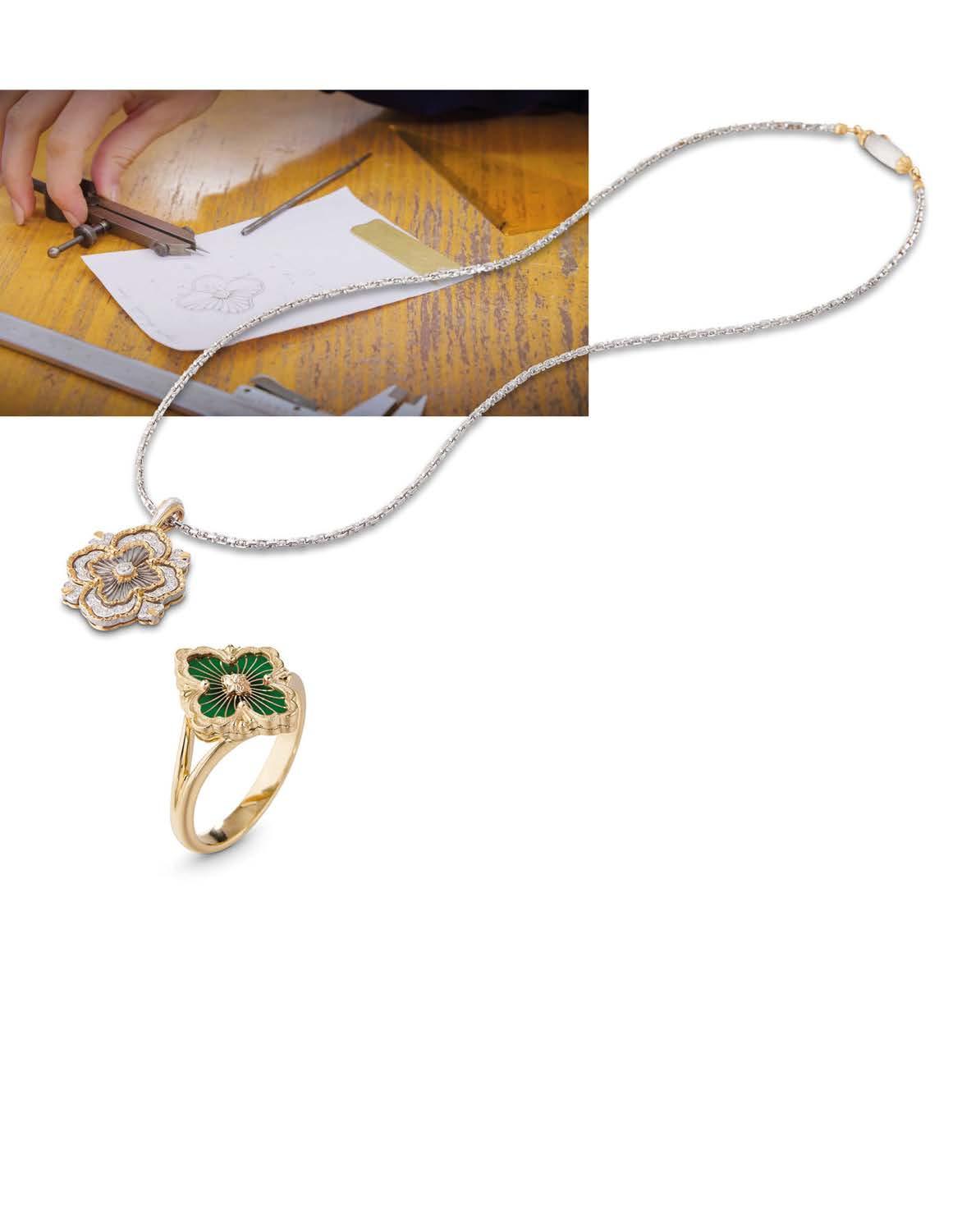
Opera is the collection made iconic by the unmistakable tulle motif that characterises many of uccellati s creations. This ewellery line lends itself to a series of fantastical interpretations, in which the logo element becomes the main protagonist and the centre of a captivating creativity.
per i preziosi. Le sue opere sono un omaggio al patrimonio artistico italiano e alla bellezza senza tempo. Forte di un robusto know-how e di una notorietà consolidata, lo scorso novembre Buccellati ha celebrato il suo successo espandendo la sua boutique milanese in Via Montenapoleone 23 con l’apertura del prestigioso Piano Nobile di Palazzo Gavazzi. Uno spazio esclusivo, situato al primo piano dello storico edificio neoclassico progettato da Luigi Chierichetti nel I secolo, che si aggiunge alle boutique di gioielleria e argenteria al piano terra, rendendo omaggio alla città dove la Maison fu fondata da Mario Buccellati nel 1 1 . Restaurato dal celebre Interior Designer Chahan Minassian in collaborazione con lo Studio Quadrilatero, il Piano Nobile combina il fascino storico del palazzo con un design raffinato e contemporaneo. Affreschi romantici, pavimenti in mosaico e arredi su misura creano un’atmosfera intima e sofisticata, arricchita da lampadari in vetro di Murano e una palette di colori ispirata a oro, argento e bronzo Il mobilio, realizzato in forme organiche e morfologiche, è invece impreziosito da raffinati tessuti italiani di Bevilacqua, Fortuny e Rubelli. L’attenzione ai dettagli, unita all’integrazione di elementi vintage e moderni, ri ette l’identità distintiva di Buccellati che, come Chahan Minassian stesso afferma “È sinonimo di lusso e storia”. Ragione per cui ha scelto di presentare questo
patrimonio in modo fresco e contemporaneo, facendo sì che la clientela e il pubblico si sentisse a casa.
In questo luogo gli appassionati potranno ammirare una selezione unica di gioielli e argenti, incluse collezioni vintage e pezzi d’archivio e assistere al lavoro degli artigiani della Maison, maestri nella tecnica dell’incisione. Sottolinea Gianluca Brozzetti, Executive Vice President “L’apertura rappresenta un tributo alla storia e al prestigio di Buccellati nella sua citt natale, riaffermando la Maison come simbolo di lusso senza tempo”.
From the beginning of his career, Mario Buccellati, an expert and visionary goldsmith, was able to combine tradition and innovation to create ewellery with an elegance that was both refined and discreet, able to interpret the tastes and desires of the clientele of the time. His fame quickly spread thanks to his unique craftsmanship think of the gold lace, tulle and honeycomb, inspired by the ancient techniques of Italian goldsmiths and able to give ewellery an extraordinary lightness and refinement. In ust a few years, Mario expanded his workshop to include boutiques in Rome and Florence, attracting the attention of illustrious clients, including Gabriele D’Annunzio, a great admirer of the brand and its creations, such as the famous Boscoreale cups inspired by Roman art and the precious ob ects of the Hawaii collection.
ith the arrival of Mario’s sons, Buccellati’s fame continued to grow until it landed in the United States the beginning of the fifties and the opening of the new boutiques in New York and Palm Beach definitively sanctioned the conquest of the international elite.
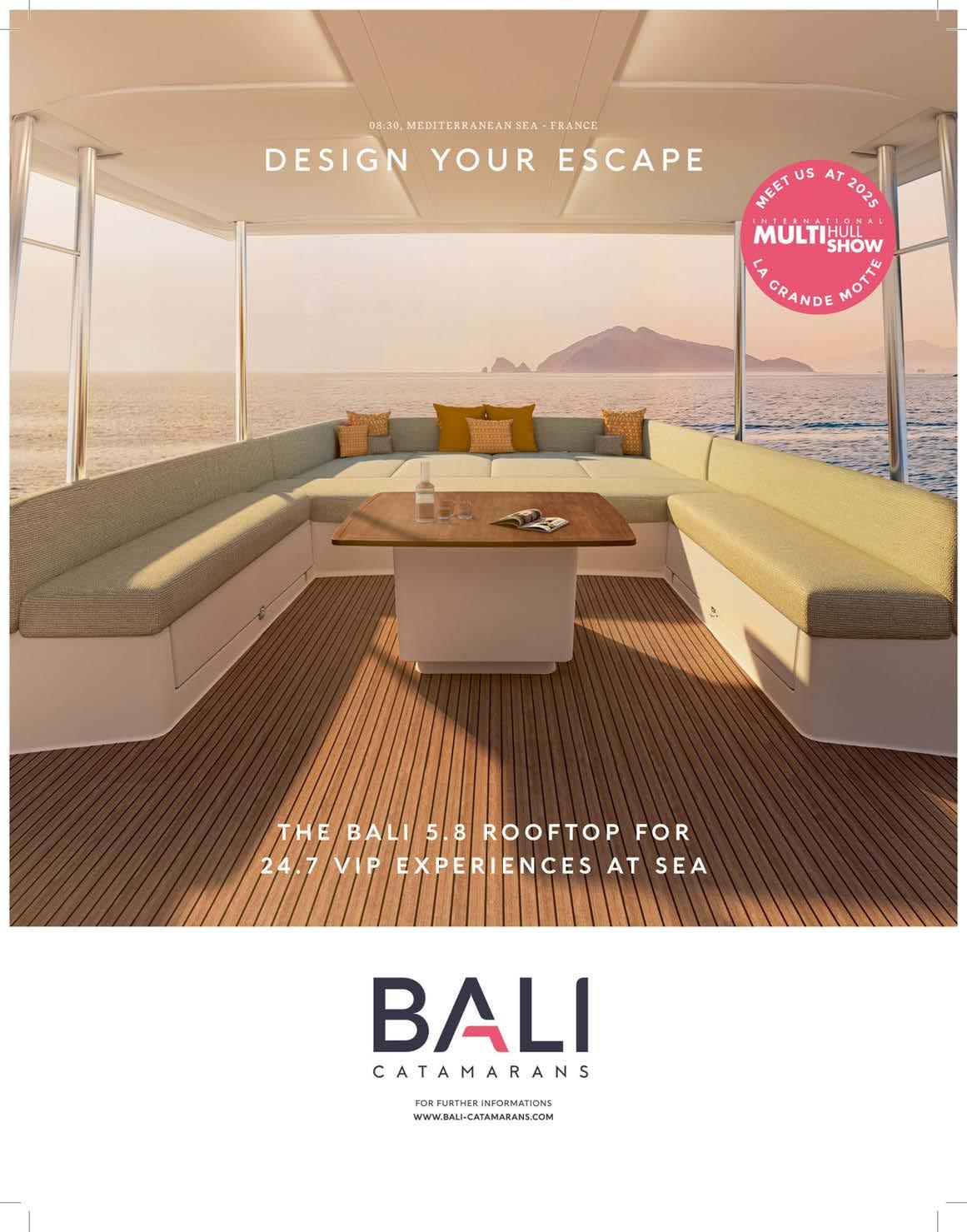

Nella Collezione Macri l’e etto rigato, ottenuto attraverso l’incisione a mano, raggiunge il suo virtuosismo. La lamina d’oro mossa e impreziosita dai brillanti incastonati in piccoli rosoni a stella. Piccole sfere luminose di oro splendente creano un geniale contrasto con l’opacit della texture e con le luci dei diamanti.
Celebrities such as Gregory Peck chose Buccellati creations for their jewellery masterpieces, now considered essential accessories, and their inimitable and highly regarded Art de la Table.
The expansion continued thanks to Gianmaria Buccellati, Mario’s heir, who consolidated the brand’s fame in Japan and, with the collaboration of his second son Andrea, became the first Italian to open a boutique in Paris on the famous Place Vendôme. This great event did not go unnoticed by the public, whose illustrious guests included Jacques
In the Macri Collection, the striped effect, achieved by hand engraving, reaches its virtuosity. The gold foil is moved and embellished with diamonds in small star-shaped rosettes. Small glowing spheres of shimmering gold contrast the te ture s opacity and the diamonds brilliance.

Chirac, Marcello Mastroianni and Anouk Aimée. Gianmaria enriched the creative heritage with collections such as Macri, dedicated to the refined grace of his daughter Maria Cristina, as the acronym of the name reveals, Étoilée, whose strength is the geometric air of young Andrea, and Animalier, the collection with which Gianmaria, inspired by the bizarre shapes of some Baroque stones, exalts craftsmanship and love for precious stones. Its pieces pay homage to Italy’s artistic heritage and timeless beauty. Building on its strong expertise and reputation, last November, Buccellati celebrated its success by expanding its Milan boutique at Via Montenapoleone 23 with the opening of the prestigious Piano Nobile of Palazzo Gavazzi. Located on the first oor of the historic neoclassical building designed by Luigi Chierichetti in the 19th century, this exclusive space joins the jewellery and silverware boutiques on the ground oor, paying homage to the city where the Maison was founded by Mario Buccellati in 1919. Restored by the renowned interior designer Chahan Minassian in collaboration with Studio Quadrilatero, the Piano Nobile combines the building’s historic charm with refined contemporary design. Romantic frescoes, mosaic oors, and bespoke furniture create an intimate and refined atmosphere, enhanced by Murano glass chandeliers and a colour palette inspired by gold, silver, and bronze. The furniture, in organic and morphological shapes, is upholstered with refined Italian fabrics by Bevilacqua, Fortuny, and Rubelli. The attention to detail, combined with the integration of vintage and modern elements, re ects Buccellati’s unmistakable identity, which, as Chahan Minassian says, “Stands for luxury and history.” This is why he has chosen to present this heritage fresh and contemporary, to make customers and the public feel at home.
Here, connoisseurs can admire a unique selection of jewellery and silverware, including vintage collections and archival pieces, and witness the work of the Maison’s craftsmen, masters of the engraving technique. Gianluca Brozzetti, Executive Vice President, points out: “The inauguration is a tribute to Buccellati’s history and prestige in its home city and reaffirms the aison as a symbol of timeless luxury”.


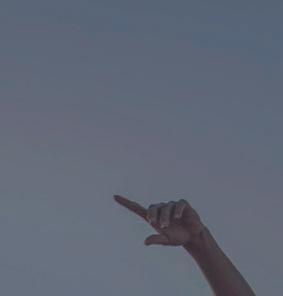





MC2 Quick Gyro X75 is super compact and the most powerful stabilizer of the range.
It is smaller than market standards, power being equal. It takes just 20 minutes to stabilize 90’ boats and it’s exceptionally water-cooled.
Multiple installations ensure the stabilization of boats up to 400 tons.
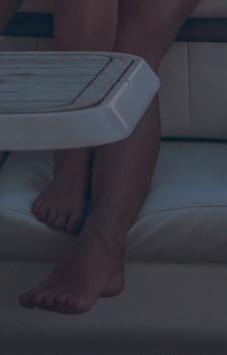

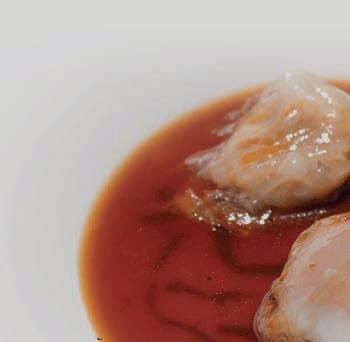
LO CHEF JUANLU FERNÁNDEZ HA RICEVUTO LA SECONDA STELLA MICHELIN PER IL SUO RISTORANTE LÚ CHEF JUANLU FERNÁNDEZ HAS BEEN AWARDED A SECOND MICHELIN STAR FOR HIS RESTAURANT LÚ
by Sophia Negri





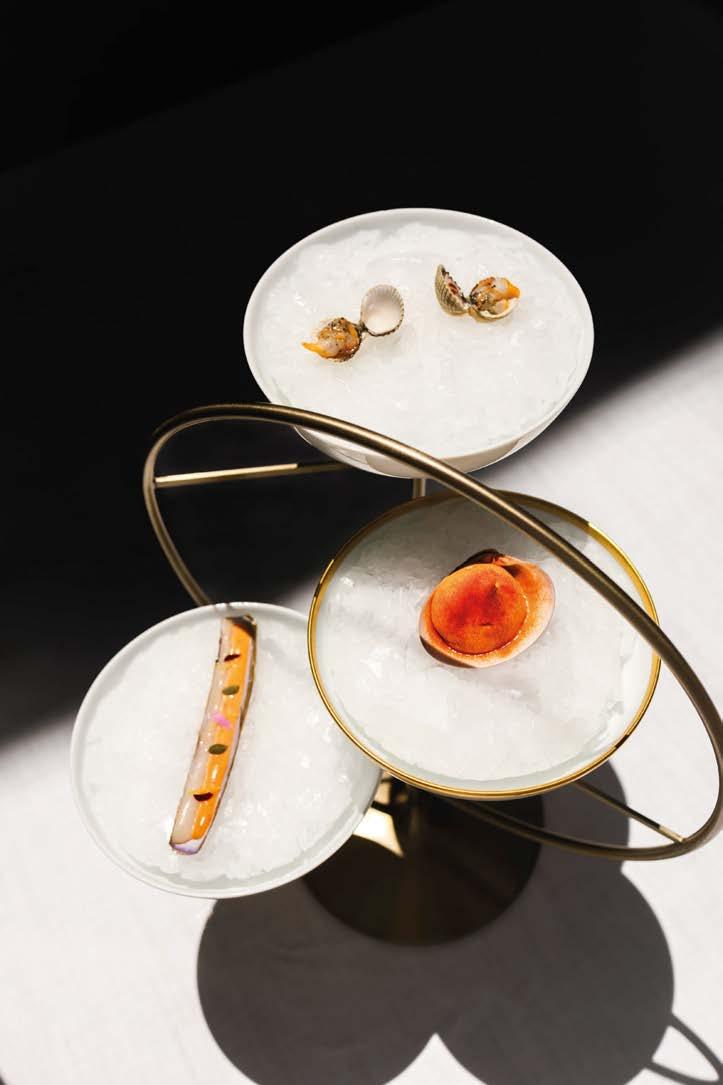

Ilristorante LÚ, in Calle Zaragoza al numero 2 di Jerez de la Frontera, in Spagna, ha ottenuto la sua seconda Stella Michelin. Si tratta di un meritato riconoscimento dell’eccellenza della cucina di Juanlu Fernández. Dopo una carriera di successo ottenuta lavorando in alcuni dei migliori ristoranti di alta cucina del mondo, Juanlu ha deciso nel 2017 di aprire il ristorante LÚ nella sua città natale. Con il sostegno incondizionato della sua compagna e moglie, Dolce Nilda Suárez, ha iniziato il loro progetto di vita, e anche più personale. Questo progetto è nato con l’obiettivo di riversare tutto ciò che ha vissuto, rivelare la sua personalità e il suo modo di intendere la gastronomia e, soprattutto, mostrare al mondo il meglio della cucina di Jerez e andalusa. LÚ è un luogo dove Juanlu si esprime senza restrizioni, dove l’amore per la filosofia della cucina francese lo ispira a creare una proposta con cui vuole interpretare la sua terra, le sue radici, la sua cultura, la sua gastronomia e la sua storia. È il luogo dove recupera le
Al LÚ Cocina y Alma cercano ogni giorno il prodotto migliore, indagando sulla sua origine per conoscerne ogni aspetto. Cercano il miglior latte di Francia per i burri; i volatili che planano sopra la bella terra di Bresse, le ostriche bretoni o i frutti di mare che riposano nelle rias galleghe.
At LÚ Cocina y Alma they search for the best product every day, researching its origins to understand every aspect of it. They look for the best French milk for their butter, the birds that y over the beautiful countryside of Bresse, the Breton oysters, or the seafood that rests in the Galician estuaries.
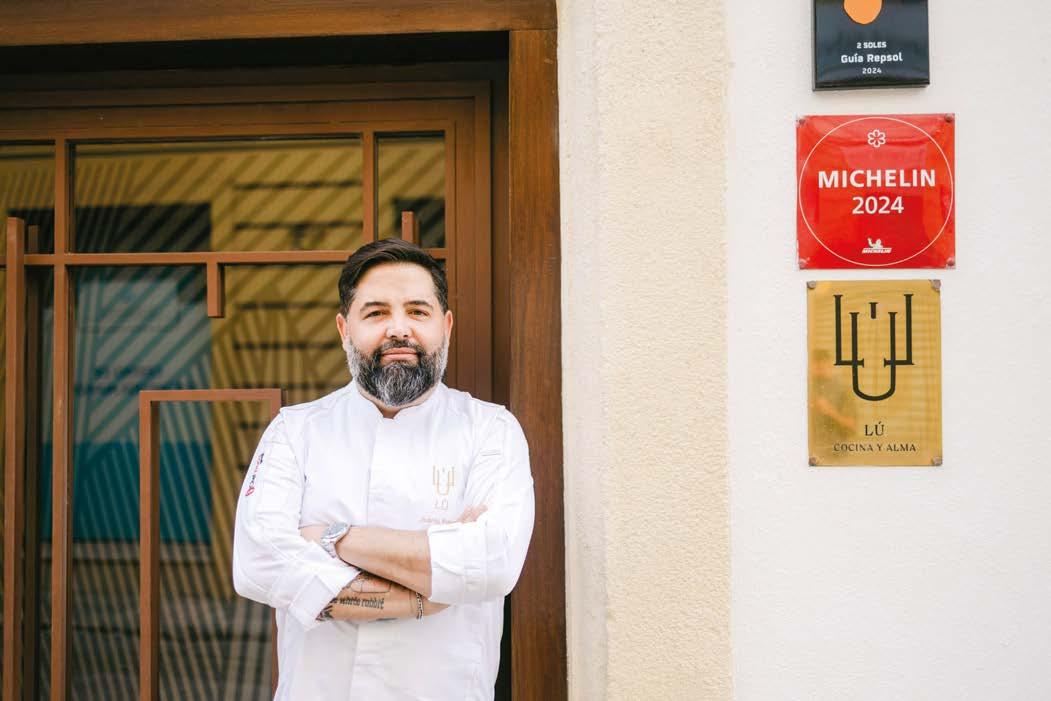

Per i piatti si cercano le verdure selvatiche dalla sierra di Cadice, da La Janda a Grazalema, e il pescato fresco del litorale gaditano da Rota a Tarifa. Al LÚ sono innamorati dell’alta cucina classica apportando un tocco andaluso alle ricette di Careme, e le salse di Esco er sono rifinite con il burro aromatizzato. Al LÚ si cucina a fuoco lento, senza fretta e con grande passione.
They look for wild vegetables from the Sierra de Cádiz, La Janda in Gra alema, and fresh fish from the Gaditano coast, Rota in Tarifa. At LÚ, they love classic haute cuisine, adding an Andalusian touch to areme s recipes and finishing sco er s sauces with avoured butter. At LÚ, cooking is slow, leisurely, and passionate.


ricette della tradizione, in parte andate perdute, e le cucina da una prospettiva diversa, senza dimenticare l’innovazione attuale, ma senza mai perdere l’essenza che le rende uniche. Il ristorante di Jerez dispone di una cucina situata nel cuore della sala da pranzo. Un concetto di Chef’s Table, dove tutto il team costruisce l’esperienza in modo rilassato, elegante e silenzioso davanti ai commensali. www.lucocinayalma.com
TheLÚ restaurant at number 2 Zaragoza Street in Jerez de la Frontera, Spain, has been awarded its second Michelin star. This is a welldeserved recognition of the excellence of Juanlu Fernández’s cuisine. After a successful career in some of the best haute cuisine restaurants in the world, Juanlu decided to open the restaurant LÚ in his hometown in 2017. With the unconditional support of his partner and wife, Dolce Nilda Suárez, he began the project of their lives, a very personal one. This project was born to pour out everything he had experienced, expressing his personality and his way of understanding gastronomy and, above all, showing the world the best of Jerez and Andalusian cuisine. LÚ is a place where Juanlu expresses himself without restrictions, where his love for the philosophy of French cuisine inspires him to create a proposal that interprets his land, roots, culture, gastronomy and history. It is where he recovers traditional recipes, some of which have been lost. It cooks them
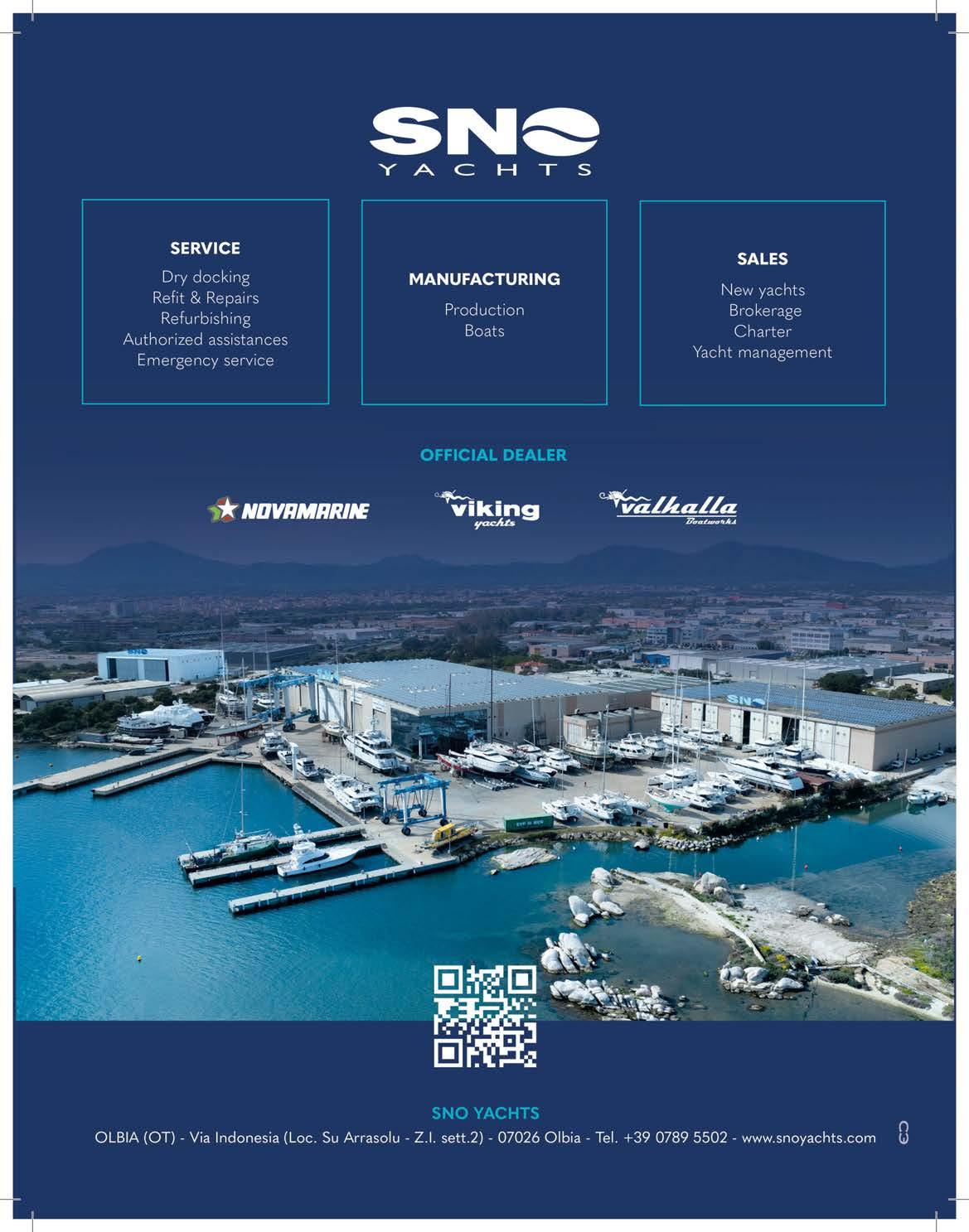

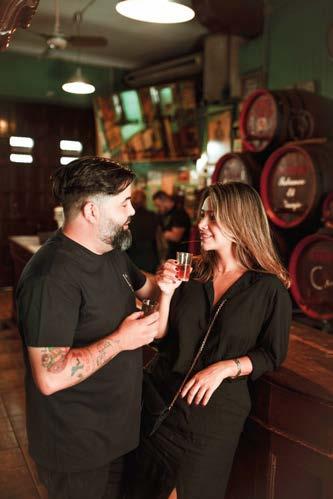
La cantina ha una delle più grandi e migliori collezioni di vini Sherry, di annate storiche e attuali, con cui abbinare molti dei piatti serviti. The wine cellar has one of the largest and finest collections of historic and contemporary Sherry wines. Many of the dishes served are paired with these wines.
from a different perspective, without forgetting the current innovations, but never losing the essence that makes them unique. The erez restaurant has a kitchen in the heart of the dining room. A chef’s table concept, where the whole team creates the experience in front of the guests in a relaxed, elegant and quiet way. www.lucocinayalma.com

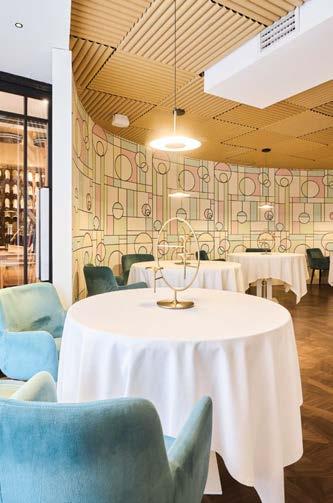

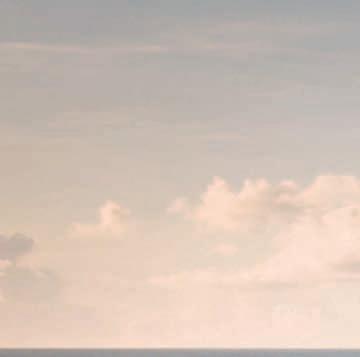
MOLTI LO CONSIDERANO COME IL PAESAGGIO PIÙ MAESTOSO E SOLENNE DELL’ISOLA. È IL GIANT’S CAUSEWAY, UN TRATTO DI COSTA NELLA CONTEA DI ANTRIM, 100 CHILOMETRI A NORD DI BELFAST
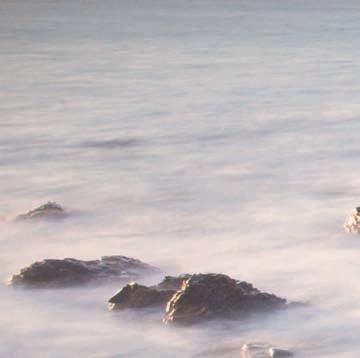
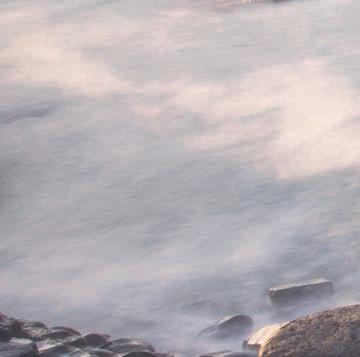
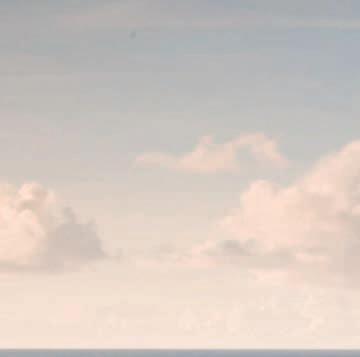
MANY CONSIDER IT THE MOST MAJESTIC AND SOLEMN LANDSCAPE ON THE ISLAND. IT’S THE GIANT’S CAUSEWAY, A STRETCH OF COAST IN THE COUNTY OF ANTRIM, 100 KILOMETRES NORTH OF BELFAST
by Clelia Pirazzini




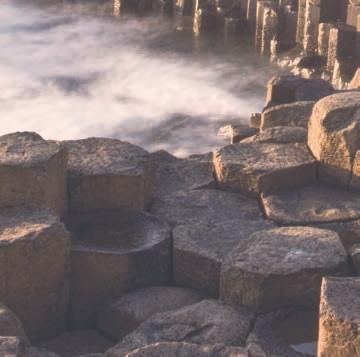

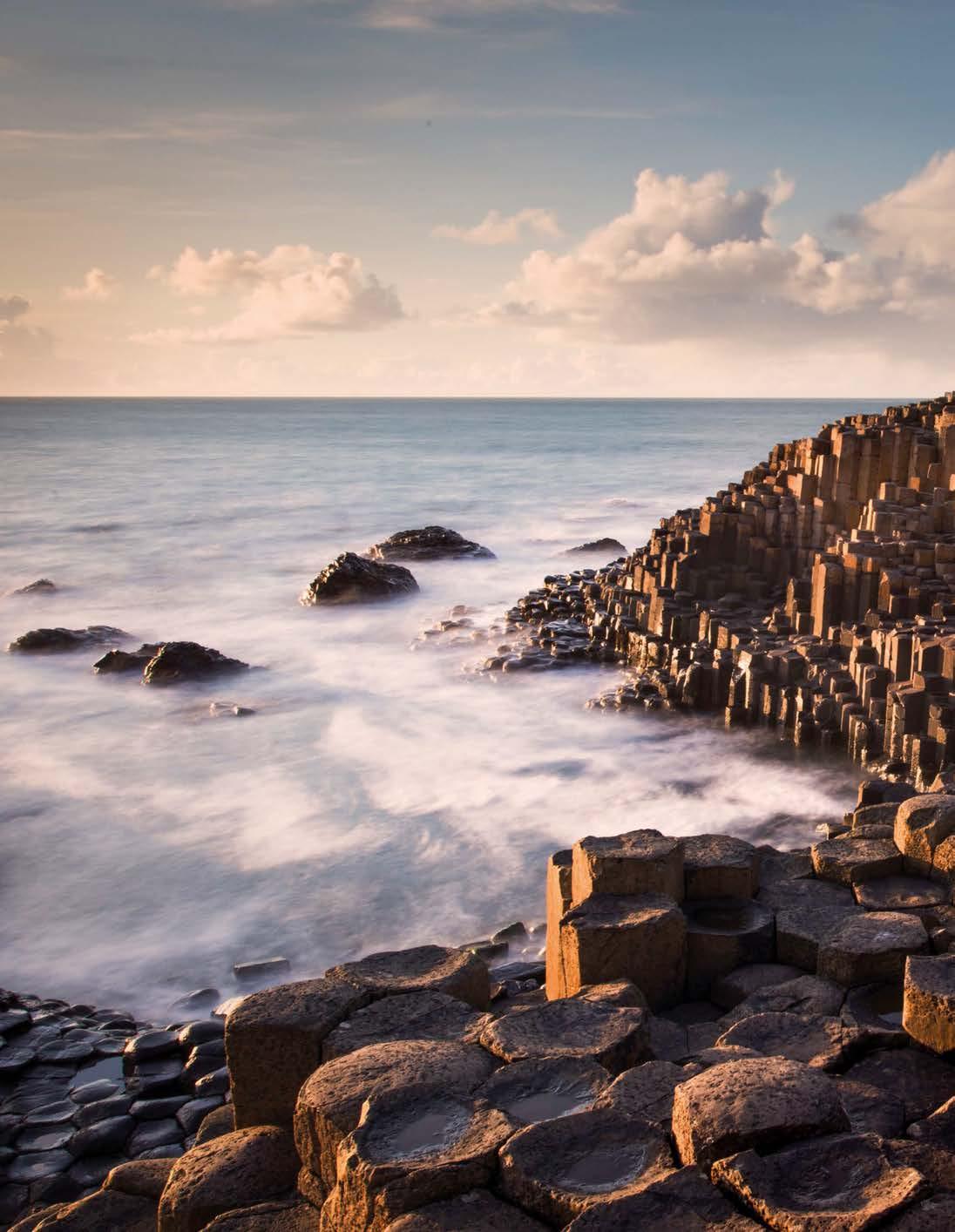

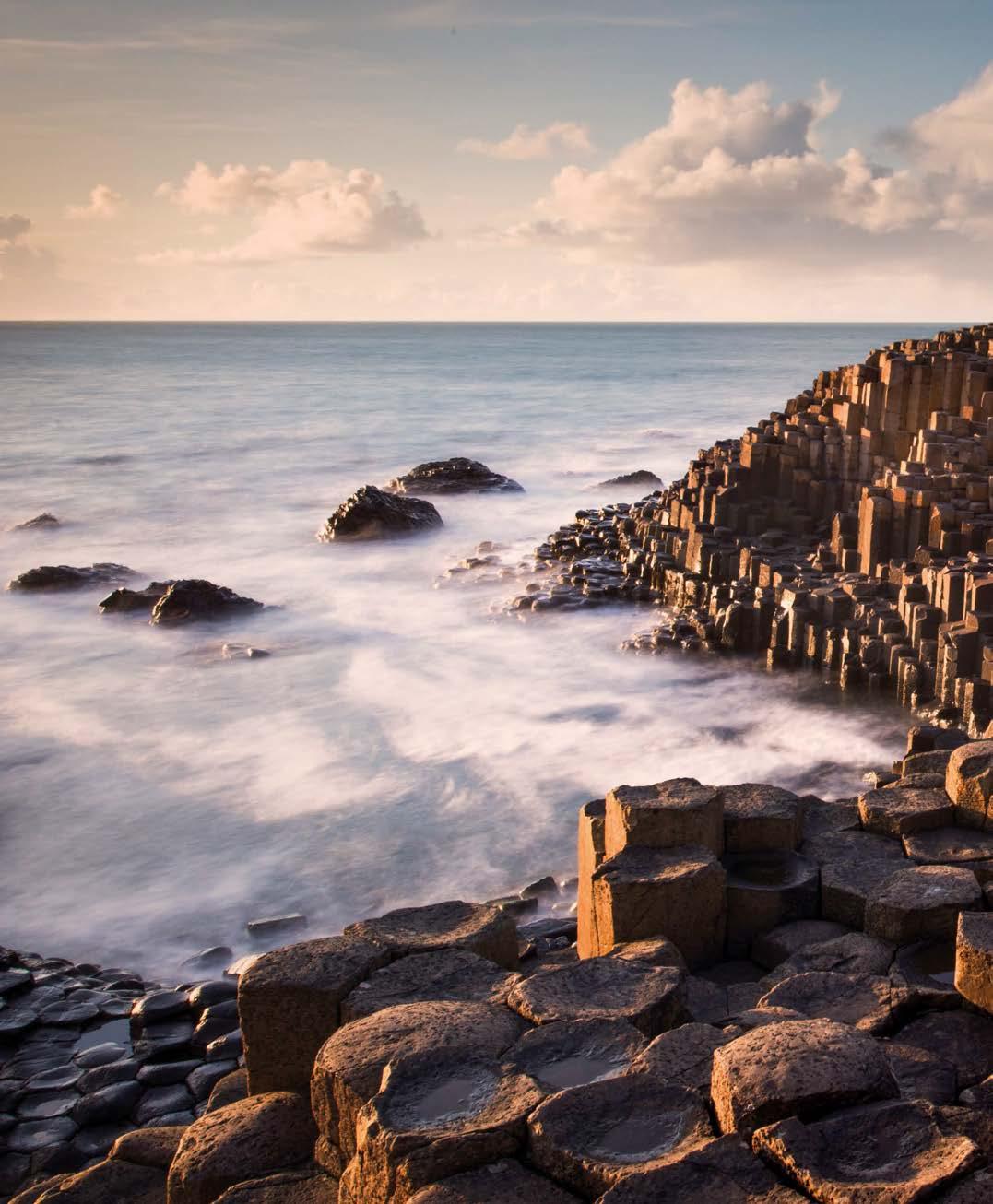
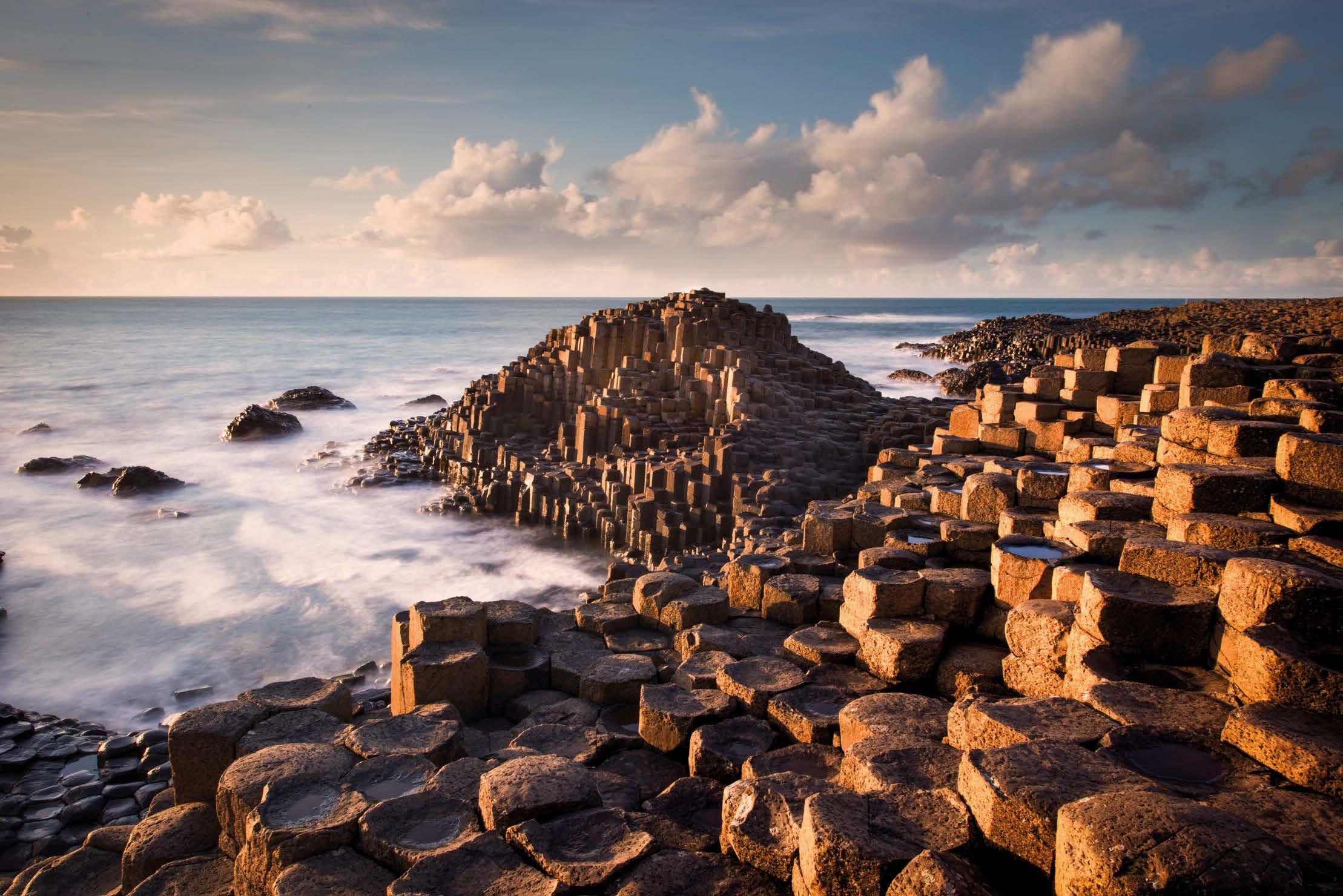
Per la geometria degli intrecci, talvolta un po’ confusi e impressionanti, si ergono dagli scogli del mare circa 40.000 colonne basaltiche con base esagonale e forma prismatica diversa, alte dai 6 ai 12 metri, talmente perfette e armoniose da pensare siano frutto dell’opera umana. Ed ecco la sorpresa: queste strane formazioni rocciose sono state create dall’attività vulcanica forse 60 milioni di anni fa. A seguito dell’eruzione, la lava finita nelle acque fredde del mare si era immediatamente solidificata, contraendosi e formando dei pilastri basaltici di varie dimensioni a seconda della velocità di solidificazione. Un risultato talmente raro e misterioso
Ma questo fenomeno così stupefacente e fantascientifico aveva anche alimentato strane leggende. La più seguita è quella del gigante Fionn Mac Cumhaill, dotato di una forza possente che un giorno venne invitato dal campione scozzese Benandonner ad una sfida. Fionn allora decise di costruire un sentiero sull’insenatura tra l’Irlanda e la Scozia per raggiungerlo, raccogliendo pezzi di scogliera e poggiandoli ordinatamente per creare un facile passaggio. Ma attraversandolo, e vista la mole possente del rivale, fece marcia indietro rifugiandosi a casa e travestendosi. Quando arrivò Benandonner per il duello, la moglie di Fionn gli disse che il marito era in giro e che quel personaggio presente nella camera non era altro che il figlioletto. Osservandolo così grande lo scozzese pensò che il padre sarebbe stato addirittura
Salendo in alto il panorama si amplia dando spazio ad una visuale completa della costa, in particolare al mattino quando timidi raggi di sole sembrano venire avanti a tentoni all’orizzonte e penetrare tra le colonne.
Climbing higher, the landscape opens up to reveal a complete panorama of the coast, especially in the morning when the first rays of sunlight seem to break through the high pillars on the horizon.
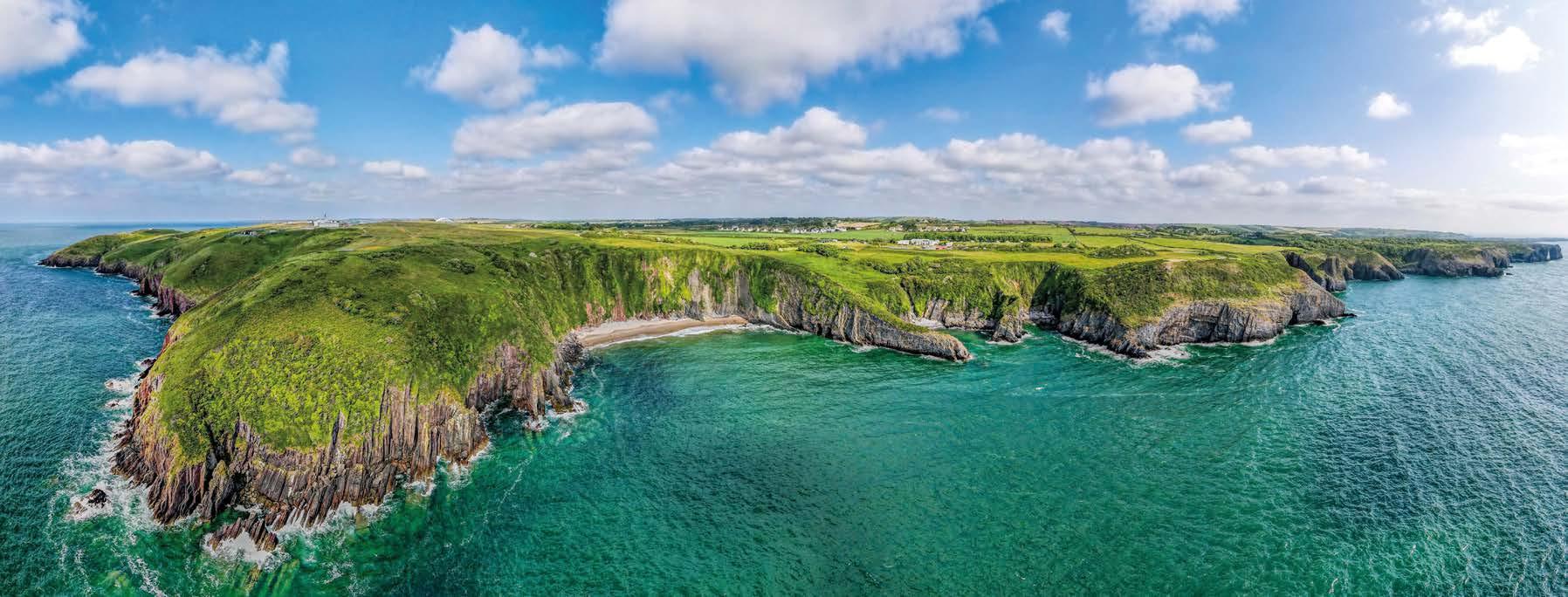




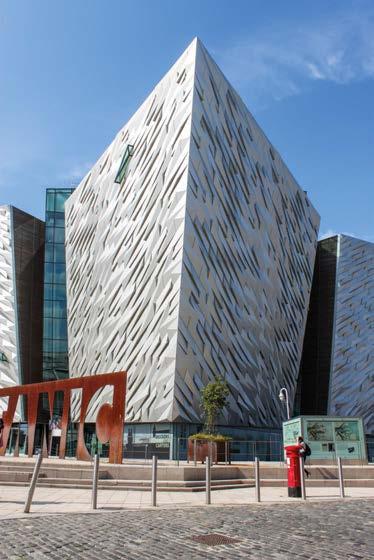
Belfast è una città dai mille volti come la City Hall in stile rinascimentale e il Titanic Belfast, il museo più conosciuto d’Irlanda.
gigantesco e pericoloso, motivo che lo indusse ad una ritirata e a distruggere la maggior parte dello straordinario Causeway.
Ma c’è un’altra storia più romantica, come quella di un gigante innamorato che aveva costruito il passaggio per raggiungere la Scozia dove viveva la sua amata. E poi molte altre.
A prescindere dalle varie leggende, ancor oggi il Sentiero del Gigante racconta la continuità e il legame spirituale con la natura, lasciando stupiti per quelle strane forme ravvivate dal respiro eterno e inafferrabile del mare, soprattutto se si scende sulla scogliera e si cammina sul selciato facendo magari un salto tra una pietra e l’altra e osservando attentamente per farsi un’idea della perfezione delle colonne generalmente a base esagonale, ma anche quadrangolare e pentagonale, larghe fino a 50 centimetri. Ed anche di forme diverse. Come quella oggi chiamata l’Organo del Gigante in quanto riproduce fedelmente questo strumento musicale. Ma ci sono anche
From the Renaissance-style City Hall to Titanic Belfast, Ireland’s most famous museum, Belfast is a city with many faces.
rocce che ricordano gli stivali o gli occhi degli omaccioni che conservano morbide e lucenti sfumature.
Talmente spettacolari che l’UNESCO ha dichiarato il sito Patrimonio dell’Umanità.
Ma quest’area costiera dell’Antrim offre altre attrazioni interessanti anche dal punto di vista storico. Come il promontorio dove si erge a picco sul mare l’antico castello medievale di Dunluce, oggi in rovina e abbandonato dal 1690 quando parte della cucina del castello collassò in mare. Sede politica dei conti di Antrim, fu teatro della faida sanguinosa tra i clan Mac Quillan e i Mac Donnel. Così cruenta da alimentare presenze spettrali tra le rovine, seguite da leggende. Come quella della figlia di Lord Mac Quillan, la dolce Maeve che rifiutando di sposare l’uomo prescelto dal padre perché innamorata di un altro ragazzo, venne rinchiusa nella torre del maniero. Il giovane cercò quindi di liberarla e dopo averla raggiunta la portò con sé scendendo sulle scogliere, ma a causa del mare sempre agitato annegarono insieme nella vicina Mermaid’s Cave.

E dopo avere preso coscienza delle bellezze di quest’area sospesa tra natura, storia e racconti fantasiosi, è d’obbligo la visita di Belfast, la capitale dell’Irlanda del Nord, una città dal grande patrimonio storico e urbanistico con quartieri tipici percorsi da strade acciottolate sulle quali a volte si affacciano case in mattoni rossi. E poi la magnifica City Hall in stile rinascimentale, ma anche il tipico quartiere dei Murales, molti dei quali ricordano il con itto tra repubblicani e lealisti. Ma il fiore all’occhiello è il Titanic Quarter che ospita, tra gli altri, il museo più conosciuto d’Irlanda: il Titanic Belfast, un luogo dell’anima e del ricordo. È in quest’area che si trovava il grande cantiere navale fondato nel 1861 da Sir Edward James Harland e Gustav illhem olff che ha operato continuamente negli anni con costruzioni di navi mercantili, ma soprattutto di transatlantici tra i quali il Titanic, che, come si sa, colò a picco il 15 aprile del 1 12, non per difetto di costruzione, ma a causa di un impatto spaventoso con un iceberg. Il cantiere continuò a lavorare ininterrottamente costruendo in seguito 6 portaerei, 2 incrociatori e altre unità militari, come pure carri armati e mezzi di vario genere. Ma dopo gli Anni ’50, essendo
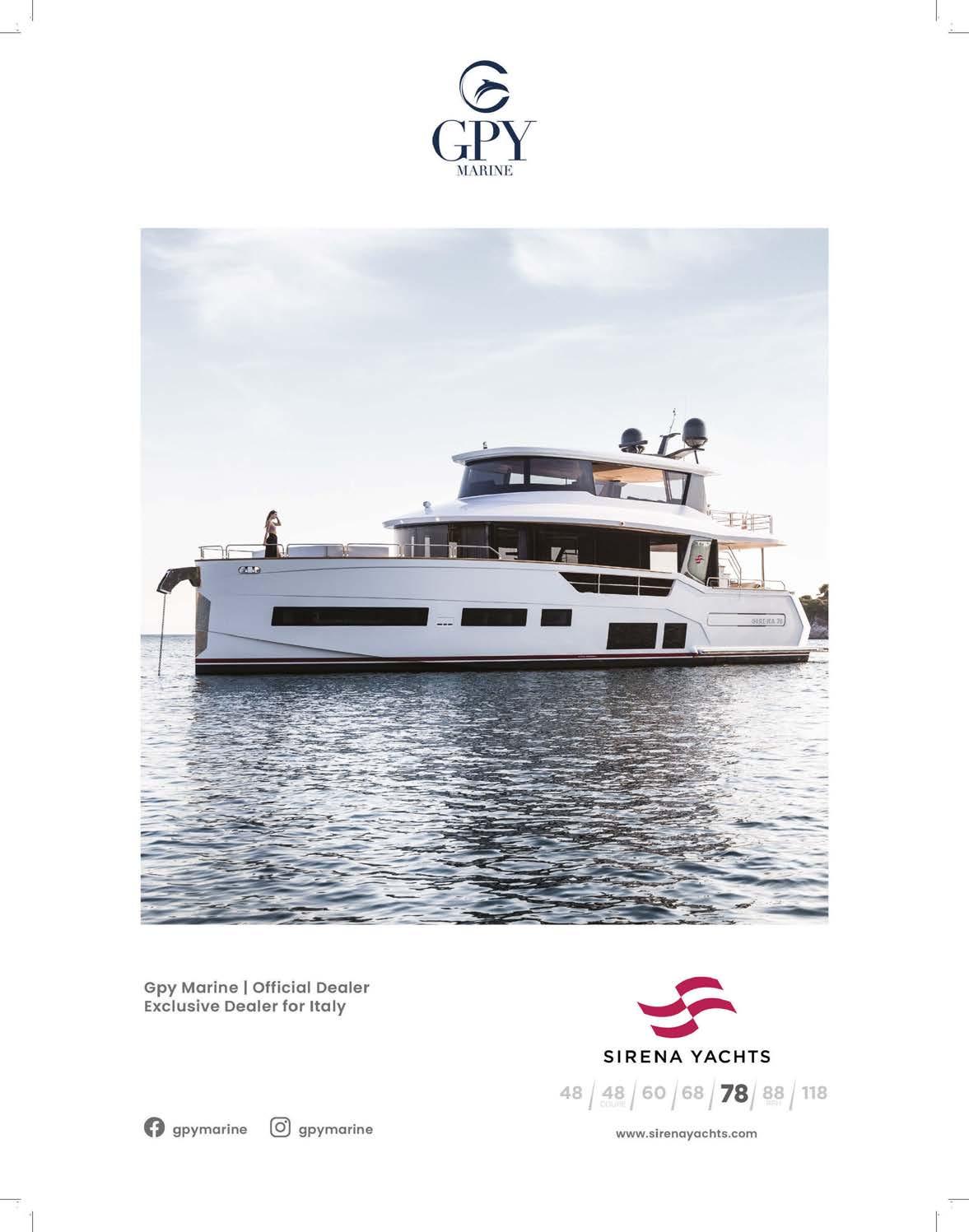
Maurizio Granai +39 335 6113832
gpymarine.it
diminuita la richiesta in particolare di navi passeggeri, il cantiere ha subito un declino tanto da cessare completamente l’attività nel 2019. Ora, a ricordare questa grande struttura restano soltanto le due altissime gru gemelle dal nome altisonante: Samson e Goliath. Ma soprattutto il Museo del Titanic, un edificio a forma di scafo rivestito in alluminio. Sebbene non siano presenti oggetti originali della nave, ma solo copie, descrizioni e dettagli che raccontano le vicissitudini del Titanic, apre un ash su una passata tragedia collettiva che porta a viaggiare nel tempo, nella pericolosità dei mari
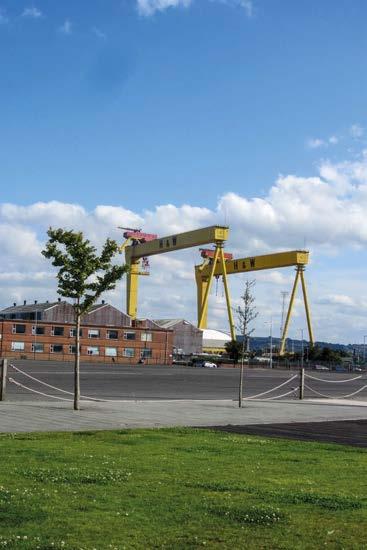
nordici, nel cuore degli uomini. In piena attività invece il Belfast harbour, fiore all’occhiello del commercio marittimo, che ospita oltre 500 aziende e dove fanno scalo navi mercantili e passeggeri. Per ciò che riguarda la nautica da diporto e le attività legate al settore, spicca invece il porto turistico di Bangor, nella penisola di Ards, a soli 19 chilometri da Belfast, in grado di accogliere nella sua Marina un numero elevato di barche. Da qui si parte per battute di pesca entusiasmanti. Le prede non mancano, in particolare quelle dei mari nordici, come i “cod” o merluzzi, che sono soliti spostarsi in
Il transatlantico più famoso del mondo colò a picco il 15 aprile del 1912.

grandi banchi, ma anche i “wrasse”, una sorta di grossi tordi di mare presenti in particolare su fondali rocciosi e poi le sogliole giganti. Ma qualcuno ama praticare anche la pesca allo squalo, in particolare ai “blue shark”, che dà grandi soddisfazioni ai pescatori per la sua forza combattiva. Se le prede non sono commestibili, una volta catturate vengono subito rigettate in mare. Non certamente i granchi giganti di Bangor Bay, che costituiscono un piatto tipico della cucina locale insieme alla coda di rospo in crosta di sesamo. Se poi durante la stagione estiva si sente il desiderio di fare una nuotata in sicurezza, questo è il luogo ideale. Lo aveva apprezzato anche lo scrittore Charles Dickens, che quando veniva in Irlanda per svolgere delle conferenze era solito recarsi alla Ballyholme beach di questa zona per un bagno ristoratore. Tanto per ricordare che nell’Irlanda del Nord il mare è sempre stato il grande protagonista.
Due to the geometry of the sometimes confusing and impressive entanglements, about 40,000 basalt columns with hexagonal bases and various prismatic shapes, 6 to 12 metres high, rise from the sea rocks, so perfect and harmonious that one could think they were man’s work. And here is the surprise: these strange rock formations were created by volcanic activity perhaps 60 million years ago. After the eruption, the lava owed into the cold waters of the sea and immediately solidified, contracting and


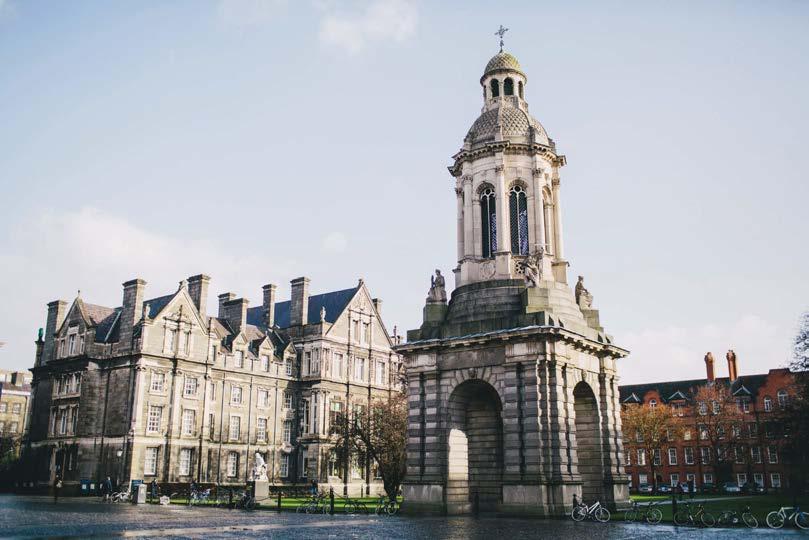
Belfast è la capitale, con una popolazione stimata dell’area metropolitana di 671.559 abitanti.
With an estimated population of 671,559, Belfast is the capital city.
forming basaltic columns of different sizes depending on the speed of solidification. The result was so unique and mysterious that Giant’s Causeway had already attracted the attention of scientists and curious minds in the past. 1693, it was mentioned in a document written by Sir Richard Bulkeley for the Royal Society. But this stunning and futuristic phenomenon has also given rise to many strange legends. The most popular one is undoubtedly the legend of the giant Fionn Mac Cumhaill, whose strength was so powerful that one day, the Scottish champion Benandonner challenged him to a duel. So Fionn built a trail on the inlet between Ireland and Scotland to reach him, collecting pieces of cliffs and carefully placing them on the ground to create an easy passage. But as he began to cross it and considered the imposing physical composition of his rival, he decided to turn back and seek refuge at home, where he disguised himself. When Benandonner came to his house for the duel, Fionn’s wife told him that her husband had gone out and that the person in the room was her son. Seeing that the son was so large, the Scottish champion figured that the father would be even more gigantic and threatening. Hence, he decided to retreat and destroy most of the extraordinary causeway. But there is another, more romantic, story about a giant who was in love and had built that causeway to reach
Scotland, where his beloved lived. And many more stories like these. Regardless of the many legends, even today, the Giant’s causeway expresses the continuity and spiritual bond with nature, which amazes us with its strange shapes continuously revived by the eternal and elusive breath of the sea. In particular, if you descend on the cliff and walk on the rocky pavement, maybe jumping from one stone to the next, you can observe them to understand the perfection of these columns truly. They generally have a perfectly hexagonal base but can also be squared or pentagonal and up to 50 centimetres wide. Each one seems to have a different and unique shape. Like the one called the Giant Organ due to its striking resemblance to the musical instrument, other rocks look like the boots or eyes of these giants, as they preserve soft and bright nuances. They are so spectacular that the UNESCO declared them a World Heritage Site. This coastal area of Antrim also has other attractions of historical interest, such as the promontory where the ancient medieval castle of Dunluce stands overlooking the sea, which has been in ruins and abandoned since 1690 when part of the castle kitchen collapsed into the sea. The political seat of the Earls of Antrim was the scene of the bloody feud between the Mac Quillan and Mac Donnel clans. It was so gruesome that it gave rise to ghostly
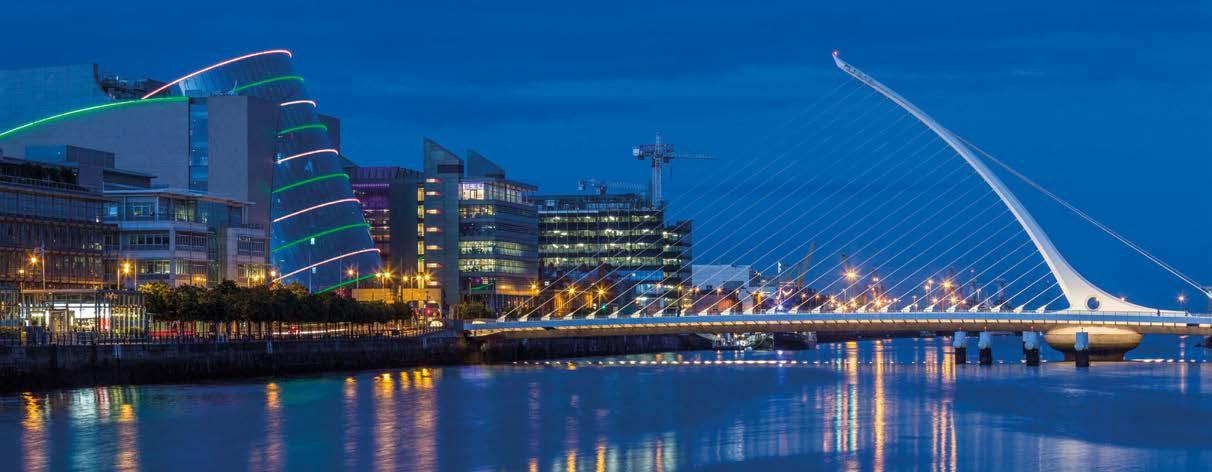

presences among the ruins, followed by many legends, like the legend about Lord Mac Quillan’s daughter, the sweet Maeve, who refused to marry the man her father had chosen for her because she was in love with another boy and was thus locked up in the manor’s tower. Her young lover came to free her and eloped with her over the cliffs, but the ever-rough sea caused them both to drown together in the nearby Mermaid’s Cave. After acknowledging the beauty of this region suspended between nature, history, and legendary stories, it is an absolute must to visit Belfast, the capital of Northern Ireland, a city with a rich historical and urbanistic heritage with typical districts crossed by cobbled streets occasionally overlooked by red-
brick buildings. Then, the magnificent City Hall was built in a Renaissance style. Still, it was also the typical district of the Murales, many of which reference the con ict between Republicans and Loyalists. But the jewel in the crown is undoubtedly the Titanic Quarter, which, among other things, hosts the most famous museum in Ireland: the Titanic Belfast, a place of the soul and memory. This is where you can find the large shipyard founded in 1861 by Sir Edward James Harland and Gustav Willhem olff, who worked tirelessly over many years building merchant ships, but above all, ocean liners, including the most tragically famous Titanic. As is well known, the latter sank on 15 April 1 12, not because of a construction aw

Sul promontorio si erge a picco sul
castello
di
oggi in rovina e abbandonato dal 1690.
The ancient medieval castle of Dunluce rises on the promontory. Now it is in ruins and abandoned since 1690.

but rather due to a horrible impact with an iceberg. The yard continued to work uninterruptedly, building six aircraft carriers, two cruisers, and other military units, also including tanks and vehicles of various kinds. But after the 1950s, as demand for passenger ships fell, the yard declined to the point where it will cease operations altogether in 2019. Today, the only reminder of this enormous enterprise are two extremely tall twin cranes with high-sounding names: Samson and Goliath. And, of course, the Titanic Museum, an aluminium-coated building shaped like a hull. Although no original items from the ship are present in the museum - which only exhibits replicas, descriptions and details about the events that took place on the Titanic - it is an actual ashback into this collective tragedy that takes you on a journey back in time, to face the dangers of the Nordic seas, and look into the heart of all human beings. On the other hand, the Belfast harbour is fully operational and is a source of pride for maritime trade. It hosts more than 500 companies and is a port of call for merchant and passenger ships. For yachting and all activities connected to this industry, the leading marina is Bangor, on the Ards peninsula, just 19 kilometres from Belfast. A truly complete facility capable of accommodating a high number of yachts. From here, you can set out on thrilling fishing trips. There is no shortage of prey, especially from the northern seas, such as cod, which move in large shoals, wrasse, a type of large thrush that lives on the rocky seabed, and giant sole. Some even like to practice fishing sharks, particularly the ‘blue shark’, which satisfies fishermen due to its impressive fighting strength. But if the prey is not edible, once it is caught, it is thrown back into the sea. Certainly not the famous giant crabs of Bangor Bay, which are a typical dish in the local cuisine, together with monkfish in sesame crust. And if, during summer, you feel like taking a nice swim in all safety, this is the ideal place. Even Charles Dickens had shown his appreciation for it. When he came to Ireland to hold a series of conferences, he used to go to Ballyholme Beach in this region for a restoring swim. This is another reminder that in Northern Ireland the sea has always been the show’s star.


QUAL È L’ATTUALE SITUAZIONE DEI PORTI IN ITALIA E QUALI SONO LE ESIGENZE. E SOPRATTUTTO, COSA SI DOVREBBE FARE PER SODDISFARLE? WHAT IS THE CURRENT SITUATION OF ITALIAN PORTS, AND WHAT ARE THE NEEDS? ABOVE ALL, WHAT SHOULD BE DONE TO MEET THEM?
by Niccolò Volp i
Siamo soliti pensare che ci sia carenza di posti barca, o che sia disomogenea la loro distribuzione, oppure che non siano della giusta “taglia”. Tutto vero, ma il posto c’è, ma non si vede. Lungo le nostre coste sono molti i porti commerciali che potrebbero ospitare banchine, o parti di banchine, per gli yacht di grandi dimensioni e ci sono anche strutture solo parzialmente utilizzate. Insomma, senza consumare suolo, senza aggiungere un solo centimetro di cemento, ma semplicemente riqualificando l’esistente, si potrebbero ottenere numerosi posti barca per tutte
le esigenze e le dimensioni. Partiamo da alcuni numeri per capire esattamente di cosa stiamo parlando. Ci sono 780 porti e approdi lungo gli 8.000 km di coste, ma di questi solo 85 offrono i servizi che permettono di identificarli come veri e propri porti turistici. Tradotto in numero di posti, gli ormeggi in tutto sono 160.000 di cui solo 44.000 attrezzati. Se poi ci si avventura sulle misure dei posti barca per yacht sopra i 40 metri di lunghezza, la mappatura è decisamente impietosa. In generale, in Italia, ci sono 2,37 posti barca ogni mille abitanti. In Spagna la disponibilità è maggiore: 2,80.

In Francia si arriva a 3,87 posti barca ogni mille abitanti e in Croazia addirittura a 4,48, quasi il doppio rispetto a noi. È un discorso vecchio, ma è bene ricordare che ogni posto barca, soprattutto quelli per maxi yacht, genera un indotto importante. Il calcolo è presto fatto: uno yacht di 50 metri di lunghezza riversa sul territorio circa 11.000 Euro al giorno tra servizi di ristorazione, accoglienza, turismo, sport, noleggio e refitting. I marina, quelli esistenti, non sono più quelli di una volta, o almeno, non dovrebbero esserlo. Cambiano gli armatori, cambiano le dimensioni delle barche, e cambia anche il modo di utilizzarle. Sarebbe logico che anche i porti si adeguassero a questa realtà e a queste nuove esigenze. Un porto turistico è sempre più un luogo dove si erogano servizi rispetto a un “parcheggio” per barche più o meno grandi. I maxi yacht sono sempre più spesso proprietà di società di charter più che di un singolo armatore privato e la stessa tendenza si osserva anche per le barche di dimensioni minori.
Porti e approdi lungo gli 8.000 km di coste sono 780, ma di esti solo o rono i servizi che permettono di identificarli come veri e propri porti turistici. Tradotto in numero di posti, gli ormeggi in tutto sono 160.000 di cui, solo 44.000 attrezzati.
Il noleggio giornaliero è un’attività in crescita che forse ha bisogno di spazio, ed è facile che nei prossimi anni si assisterà a un incremento del charter anche per i natanti. Inoltre, è innegabile che si siano diffusi a macchia d’olio i multiscafi, sia a vela, sia a motore e che, soprattutto per quelli a motore, è facile immaginare che l’espansione non sia finita. Tendenzialmente i marina, i più vecchi dei quali sono stati progettati ormai 50 anni fa, è probabile che abbondino di posti di piccole o medie dimensioni proprio perché negli Anni ’70, quando si parlava di maxi yacht, ci si riferiva a scafi tra i 12 e i 15 metri di lunghezza. In ogni caso, è ovvio che un porto abbia bisogno di riorganizzarsi, sia per non sprecare banchine poco o per nulla utilizzate, sia per trovare posto per i mega yacht, i catamarani o per i natanti a noleggio. Il problema, neanche a dirlo è la burocrazia, un male che a igge le nuove costruzioni, ma anche le riorganizzazioni interne dei marina già esistenti. I governi che si sono succeduti negli ultimi vent’anni
There are 780 ports and harbours along the 8,000 km coastline, but only 85 o er services that allow them to be identified as genuine marinas. Regarding the number of sites, there are 160,000 berths, of which only 44,000 are equipped.
non hanno combinato molto e sono anche affetti da un virus assai insidioso che si chiama decentramento dei poteri. Sulla carta niente di male, l’attenzione ad esigenze particolari del territorio è buona cosa, ma in Italia si traduce in contraddizione e paradossi. A Napoli, per esempio, ci sono tre richieste per tre diverse concessioni in contemporanea e la politica demaniale cambia a distanza di pochi chilometri perché magari si è oltrepassato il confine regionale. Non c’è coordinamento tra Regioni, non ci sono regole e tempi uguali per tutti, e non ci sono nemmeno all’interno della Regione stessa. Noi abbiamo porti regionali, porti che dipendono dalle Autorità Marittime, porti Comunali e porti di privati che hanno una concessione. Si fa fatica ad avere una visione complessiva, che si interessi dello sviluppo del turismo nautico senza rischiare di cadere in una guerra di uno contro l’altro. In Spagna, per esempio, non funziona così. L’autorità che gestisce tutti i porti è una sola. Svolge una funzione di governo e ha autorevolezza perché riceve la delega direttamente dal Ministero. Insomma, rappresenta il bene comune, evitando la concorrenza tra una struttura e un’altra. Il paradosso del nostro Paese è che si realizzano grandi opere in emergenza schivando la burocrazia, ma lo stesso principio non vale quando le opere sono tante e diffuse. Gli esempi si sprecano dai treni ad alta velocità ai ponti sugli stretti o a quelli che sono crollati e che vanno ricostruiti. La nuova diga foranea di Genova, per esempio, rappresenta


La legge sull’Autonomia di erenziata approvata dal Governo una legge esclusivamente procedurale, nel senso che stabilisce la procedura in base alla uale le Regioni possono chiedere di ac uisire, in base all’articolo 116 della Costituzione, alcune competenze che fino a oggi erano riservate allo Stato. Sono ben 23 le deleghe che le Regioni possono richiedere allo Stato con la nuova legge e tra ueste c’ anche la gestione dei porti. Per non cos immediato, dato che le Regioni devono prima stabilire uali siano i LEP, Livelli Essenziali di Prestazioni, da erogare ed abbiano 24 mesi di tempo per farlo. Inoltre, non detto che le Regioni vogliano chiedere maggiore autonomia allo Stato in tema di portualit e trasporti. Il problema, come sempre pi spesso succede, che si fanno leggi e decreti legge per soddisfare una componente del Governo, ma non si a rontano i temi nel loro complesso. In Italia c’ molta confusione sulle procedure e sulle competenze. Esistono porti Regionali, Statali o privati in concessione. Ci sarebbe bisogno di fare chiarezza e non di aggiungere leggi che rischiano di aumentare il con itto tra autorit competenti. Come possibile, per esempio, che il demanio sia gestito in modo diverso da regione a regione
The law on differentiated autonomy approved by the Government is purely procedural in that it establishes the procedure by which the egions can apply to ac uire, based on rticle 11 of the onstitution, some competencies previously reserved for the State. There are no less than 3 delegations that the egions can re uest from the State under the new law, including the management of ports. owever, this is not so immediate since the regions must first identify the Ps ivelli ssen iali di Presta ioni - ssential evels of Services to be provided, and they have months to do so. oreover, it is not sure that the regions want to as the state for more autonomy in port and transport matters. The problem, as is increasingly the case, is that laws and decrees are made to satisfy one part of the government but do not address the issues as a whole. n taly, there is much confusion about procedures and responsibilities. There are regional, state or private ports under concession. There is a need for clarity, not more laws that ris increasing con ict between the competent authorities. ow is it possible, for e ample, that state property is managed differently from one region to another

uno dei finanziamenti più consistenti che la città abbia mai ricevuto e l’assegnazione dei lavori è potuta avvenire senza gara d’appalto. Ma se si tratta di modificare una banchina di un porto esistente, magari per ospitare degli yacht lì dove prima non c’erano, si fa fatica a capire dalla conferenza di servizi entro quando deve dare una risposta e rilasciare un’eventuale autorizzazione. Ma, da inguaribili ottimisti, Barche, in collaborazione con IP Architetti, pubblicherà nei prossimi numeri una serie di articoli sulla situazione dei posti barca Regione per Regione. L’intento, se qualcuno vorrà raccogliere il suggerimento, è dimostrare che senza consumare altro suolo, ma recuperando l’esistente, si possono ottenere numerosi posti barca per scafi grandi e meno grandi, e si potrebbero ammodernare le strutture esistenti in modo da venire incontro alle esigenze della nautica e favorire lo sviluppo del turismo. Una grande opera, semplice da realizzare, ma che regala poca visibilità.
e usually think that there is a lack of moorings, or that they are unevenly distributed, or that they are not the right ‘size’. It’s all true, but the space is not seen. Along our coasts, many commercial ports could accommodate docks or parts of docks for large yachts, and some facilities are only partially used. In short, without taking up any land, without laying a single centimetre of concrete, but by redeveloping what already exists, it would be possible to create numerous berths for all needs and sizes. Let us start with some figures to understand exactly what we are talking about. There are 780 harbours and moorings along the 8,000 km coastline, but only 85 of these offer the services that allow them to be identified as real marinas. Regarding the number of sites, there are 1 0,000 moorings, of which only 44,000 are equipped. If we then venture into the dimensions of the berths for yachts over 40 metres in length, the mapping is decidedly ruthless. In general, Italy has 2.37 moorings per thousand inhabitants. In Spain, availability is higher 2.80. In France, there are 3.87 moorings per thousand inhabitants and in Croatia, 4.48, almost twice as many as in Italy. It’s an old argument, but remembering that every berth, especially those for maxi yachts, generates an important related industry is worth remembering.
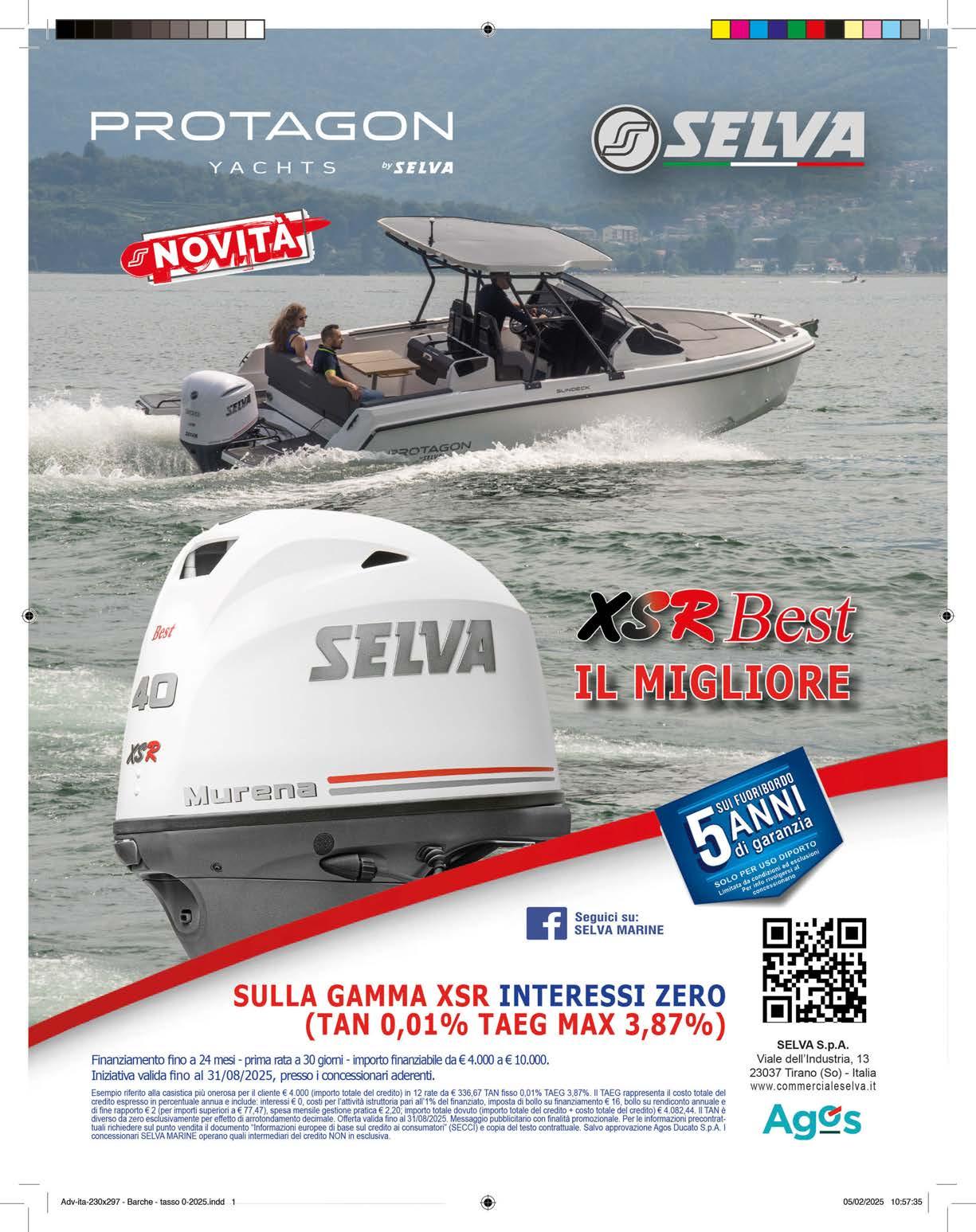
The calculation is simple: a 50-metre yacht generates around 11,000 euros daily in catering, hospitality, tourism, sports, chartering and refitting. The existing marinas are not what they used to be, or at least not what they should be. Owners change, the size of boats changes and the way they are used changes. It would be logical for marinas to adapt to this reality and these new demands. More and more, a marina is a place where yachts are stored rather than a ‘car park’ for larger or smaller boats. Maxi yachts are increasingly owned by charter companies rather than a single private owner, and the same trend can be seen for smaller yachts. Day chartering is a growing business that may need space, and the chartering of yachts will likely increase in the next few years. It is undeniable
that multihulls, both sailing and motor, have spread like wildfire, and it is easy to imagine that the expansion is not over, especially for motor boats. Marinas, the oldest of which were designed 50 years ago, are probably full of small and medium-sized berths precisely because in the 1970s, when people talked about maxi yachts, they meant hulls between 12 and 15 metres. In any case, a port needs to reorganise itself to avoid wasting quays that are not used or used at all and find space for mega-yachts, catamarans or charter boats. The problem, of course, is bureaucracy, a scourge that plagues both new construction and the internal reorganisation of existing marinas. Successive governments over the last twenty years have not done much and have also been infected by a very insidious virus called decentralisation
Il noleggio giornaliero è un’attività in crescita che forse ha bisogno di spazio e si presume che nei prossimi anni si assisterà a un incremento del charter anche per i natanti. noltre, innega ile che si siano di si a macchia d olio i m ltiscafi, sia a vela, sia a motore e che, sopratt tto per elli a motore, l espansione non finita.
Day charter is a growing business, perhaps in need of space, and it is expected that the next few years will also see an increase in yacht charters. It is also undeniable that both sail and motor multihulls have spread like wildfire and that the expansion, especially of motor boats, is not over.
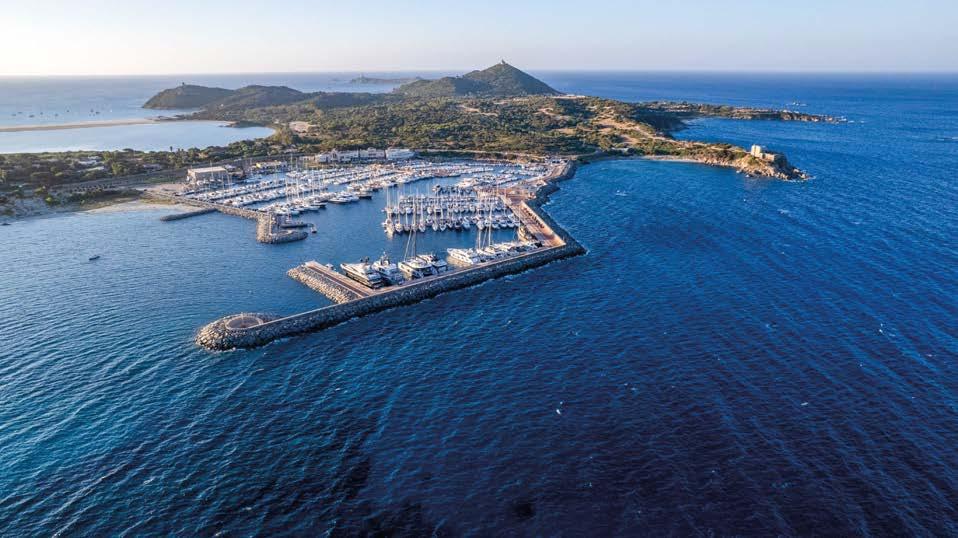
of powers. On paper, there is nothing wrong with this; attention to the territory’s specific needs is a good thing, but in Italy, it leads to contradictions and paradoxes. In Naples, for example, there are three applications for three different concessions simultaneously, and state policy changes a few kilometres away because one of them may have crossed a regional border. There is no coordination between the regions; no rules and deadlines are the same for everyone, not even within the region itself. e have regional ports, ports that depend on the maritime authorities, municipal ports, and ports that belong to private individuals with concessions. It is difficult to have an overall vision for the development of nautical tourism without risking a war of one against the other. This is not the case in Spain, for example. The authority that manages all the ports is a single authority. It performs a governmental function and has authority because the Ministry directly delegates it. In short, it represents the public interest and avoids competition between structures. The paradox of our country is that ma or works are carried out in emergencies, bypassing the bureaucracy. Still, the same principle does not apply when the works are numerous and widespread. There are many examples, from highspeed trains to bridges over the Straits or bridges that have collapsed and need to be rebuilt. For example, the new breakwater in Genoa represents one of the largest financial packages the city has ever received, and the work was awarded without a tender. But when it comes to modifying a quay in an existing port, perhaps to accommodate yachts where there weren’t any before, it’s hard to tell from the Services Conference when it will have to give an answer and a possible approval. However, being incurable optimists, Barche, in con unction with IP Architects, will publish articles on the next few issues related to the berthing situation region by region. The intention, if anyone is interested, is to show that, without using any more land, but rather by recovering existing land, it is possible to create numerous berths for large and smaller hulls and to modernise existing structures to meet the needs of the boating industry and encourage the development of tourism. It is great work and easy to carry out but with little


FULVIO DE SIMONI HA SEMPRE FATTO DEL RIGORE LA CIFRA PRINCIPALE DELLA SUA AZIONE. ETICA, EQUILIBRIO E BELLEZZA NON SONO FRUTTO DI CASUALITÀ, MA ELEMENTI
IMPRESCINDIBILI DEL BAGAGLIO DI OGNI DESIGNER
FULVIO DE SIMONI HAS ALWAYS MADE RIGOUR THE HALLMARK OF HIS WORK. ETHICS, BALANCE AND BEAUTY ARE NOT THE RESULT OF COINCIDENCE BUT INDISPENSABLE ELEMENTS OF EVERY DESIGNER’S BAGGAGE
by Olimpia De Casa -photo by Giovanni Malgarini


con il progetto del 45 piedi, con Pershing, il cantiere per il quale De Simoni e il suo team hanno progettato tutte le barche, ad eccezione del GTX80, per un totale di oltre 2.000 unità varate. Nell’anno 2000 l’88 fu la barca apparsa sulla copertina delle principali riviste del mondo con oltre 50 pubblicazioni.
collaboration with Pershing, the shipyard for which he and his team have designed all the boats except the GTX80. Starting in 1985 with the design of the 45-footer, over 2,000 units have been launched. In 2000, the 88 was featured on the cover of the world’s leading magazines, with over 50 publications.
ome per ogni appuntamento importante, la vigilia porta con sé un inevitabile carico di aspettative, curiosità, timori. Quella della mia prima intervista a Fulvio De Simoni ha confermato la regola insita nell’attesa, più di molte altre. Sarà che il progettista ha fama di essere persona dal carattere non facile, sarà per via della profondità della sua cultura nautica, sarà pure per la predisposizione a esternare il suo pensiero senza troppi giri di parole, fatto è che una certa apprensione l’incontro programmato me l’ha provocata. La compattezza dell’enorme cancello che delimita lo spazio privato che mi avrebbe accolta non fa che alimentare il sentimento di esitazione mista a soggezione, divenuto nel frattempo presenza ingombrante. Decido allora di sbarazzarmene in fretta. Appena varcata la soglia procedo a piedi lungo il vialetto di ghiaia e resto inebriata dai profumi del bosco e dagli scenari che via via si schiudono. A fare gli onori di casa Fulvio De Simoni, sua moglie Isabella, i suoi collaboratori e un mare di immagini e oggetti che raccontano il gusto per il Bello (la maiuscola non è ridondante) che ha accompagnato una carriera costellata di risultati e successi. Carriera intrapresa nel lontano 1972, che non si è limitata a dare soddisfazione e notorietà al suo artefice, ma ha avuto anche la capacità di porre tanti punti fermi nelle cronache e nella grammatica della progettazione navale, così come nel racconto e nel dibattito che ruotano attorno a un’attività professionale iniziata in un’epoca in cui il mestiere dello yacht designer era

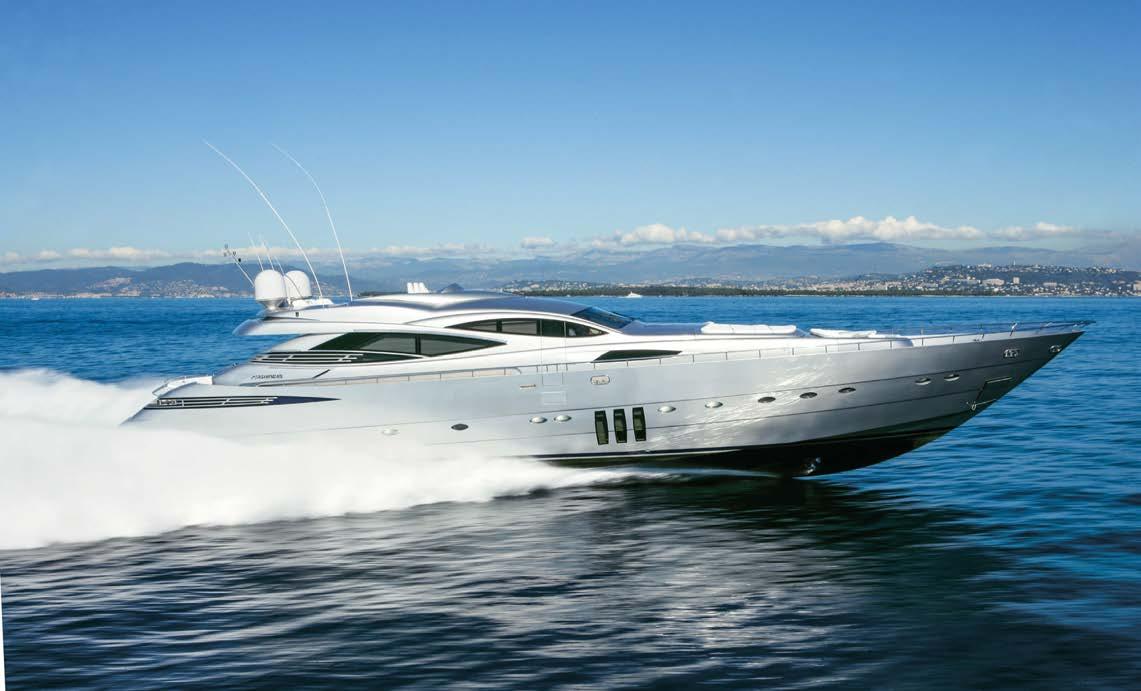
in gran parte ancora tutto da scrivere. “Tutto ha inizio alle Cinque Terre, dove sono cresciuto, quando un amico, sapendo della mia passione per le barche, mi esorta ad andare a Milano a fare due chiacchiere con suo cugino, progettista con uno studio avviato. Conosco, così, Alberto Mercati, che mi propone di restare a lavorare con lui. Per me un sogno a occhi aperti: sto ancora studiando e ho la possibilità di collaborare con una delle poche realtà già all’avanguardia. Poi, nel 1977, insieme a Massimo Gregori, altro collaboratore dello studio, fondiamo la Yankee Delta. Collaboriamo sino al 1983, anno in cui divento titolare unico di Italprojects, società specializzata nello sviluppo di progetti ad elevato contenuto tecnologico nel settore navale industriale, tuttora attiva. Quindi, nel 2015, per coinvolgere i miei più stretti collaboratori, fondiamo la Fulvio De Simoni Yacht Design, in cui Enrico (Lotti), Cristiano (Tonarelli), Giuditta (Napoli), Francesco (Ferrari) e mia moglie sono partner”. Grazie alle capacità individuali, il team permette allo studio di potersi esprimere in ogni ambito del progetto con una naturale e crescente specializzazione nel design di esterni e interni, ma con le competenze tecniche che, maturate nei molti anni di attività alle spalle, permettono di affrontare ogni nuovo lavoro in modo autonomo e creativo. “Per almeno trent’anni mi sono occupato di ogni aspetto del progetto”, spiega Fulvio De Simoni. “Questo perché per uno studio professionale era necessario saper fornire un servizio completo, che contemplasse, ad esempio, anche il disegno delle carene e degli impianti. Poi, con il prosieguo dell’attività e la specializzazione

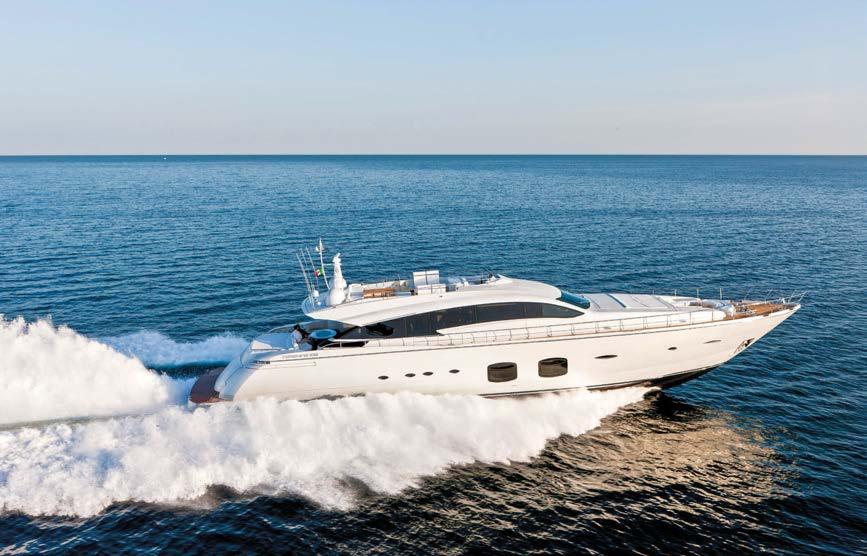

sempre maggiore che occorre nel lavoro, ci siamo dedicati soprattutto all’ideazione della barca, al taglio degli interni, al disegno delle sovrastrutture, all’architettura generale, preferendo lasciare ai tecnici e agli ingegneri l’approfondimento dei temi di loro pertinenza. Questo anche perché i cantieri con cui collaboriamo, che un tempo risultavano ‘a nostro carico’ quanto a progettazione, sono diventati pure loro sempre più grandi e strutturati, dotati di studi tecnici interni decisamente importanti. Basti pensare che solo ad Ancona nel Superyacht Yard di Ferretti Group, che realizza il Pershing 140, si contano una cinquantina di professionisti iper specializzati. Ricordo che a un certo punto siamo arrivati a confrontarci con un tecnico che si dedicava esclusivamente allo studio delle interferenze (EMI, ndr), e quindi della corretta installazione a bordo delle varie antenne. Questo per dire che i tempi erano maturi per fare un passo indietro e lasciare
intelligentemente a ogni professionalità lo spazio per dare il suo contributo importante. Ogni nuova imbarcazione diventa così un mezzo partecipato di diversi apporti complementari, che si traduce in un miglioramento generale della qualità progettuale e realizzativa”. Viviamo e lavoriamo, in sostanza, in un mondo completamente differente da quello in cui ha iniziato a dare il suo contributo alla progettazione?
Indubbiamente. Sono del resto lontanissimi i tempi in cui Norberto e Alessandro Ferretti vennero a Milano – nel primo studio in cui iniziò la mia carriera accanto ad Alberto, che aveva già lavorato in Riva e maturato quindi un’esperienza importante sul campo –, dicendoci: “Abbiamo pensato di venire a trovarvi perché siamo commercianti d’auto di Bologna, ma vorremmo costruire barche…”. Sono poi radicalmente cambiati anche i rapporti con i costruttori: quando la nautica mi piaceva, esisteva un confronto

diretto, continuo e, quindi, proficuo con chi le barche le realizzava. Oggi i grandi cantieri pensano, invece, di fare tutto questo, delegando a tutta una serie di personaggi che, all’interno di un’organizzazione verticistica, sembra sempre che abbiano la necessità di scavalcare qualcun altro. Il risultato? Non sai mai se l’obiezione che ti rivolgono è pro domo propria o pro domo in generale. Non avere più un dialogo diretto con la persona interessata fa sì che il rapporto di collaborazione diventi più freddo, basato solo sui numeri, e questo a me non piace. Così come non amo confrontarmi con soggetti che ti portano come esempio da seguire quello di chi è riuscito a realizzare una barca con due metri quadrati in più di ybrid e. A mio avviso non importa pi chi fa le barche bene, ma chi raggiunge un certo fatturato.
Quali caratteristiche salienti dovrebbe avere la barca “perfetta” o, quantomeno, “giusta”? Partiamo dalla base: la maggior parte delle barche che si varano oggi potrebbero intitolarsi il nome di “scavafango”. Col fatto, cioè, che devono essere riempite di ogni cosa, avere un volume sempre più grande, con spazi all’interno, fuori e sotto sempre più importanti, hanno prue che, invece di scivolare, con l’acqua vanno a litigare, facendo cose di ogni genere.
Il Pershing 170 disegnato da Fulvio De Simoni è un superyacht di 51,8 metri di lunghezza e sarà costruito in alluminio presso il sito produttivo del Gruppo Ferretti ad Ancona. Sarà il più grande di questa linea di superyacht.
Designed by Fulvio De Simoni, the Pershing 170 is a 51.8-metre superyacht. It will be the largest in this series and built in aluminium at the Ferretti Group’s Ancona shipyard.






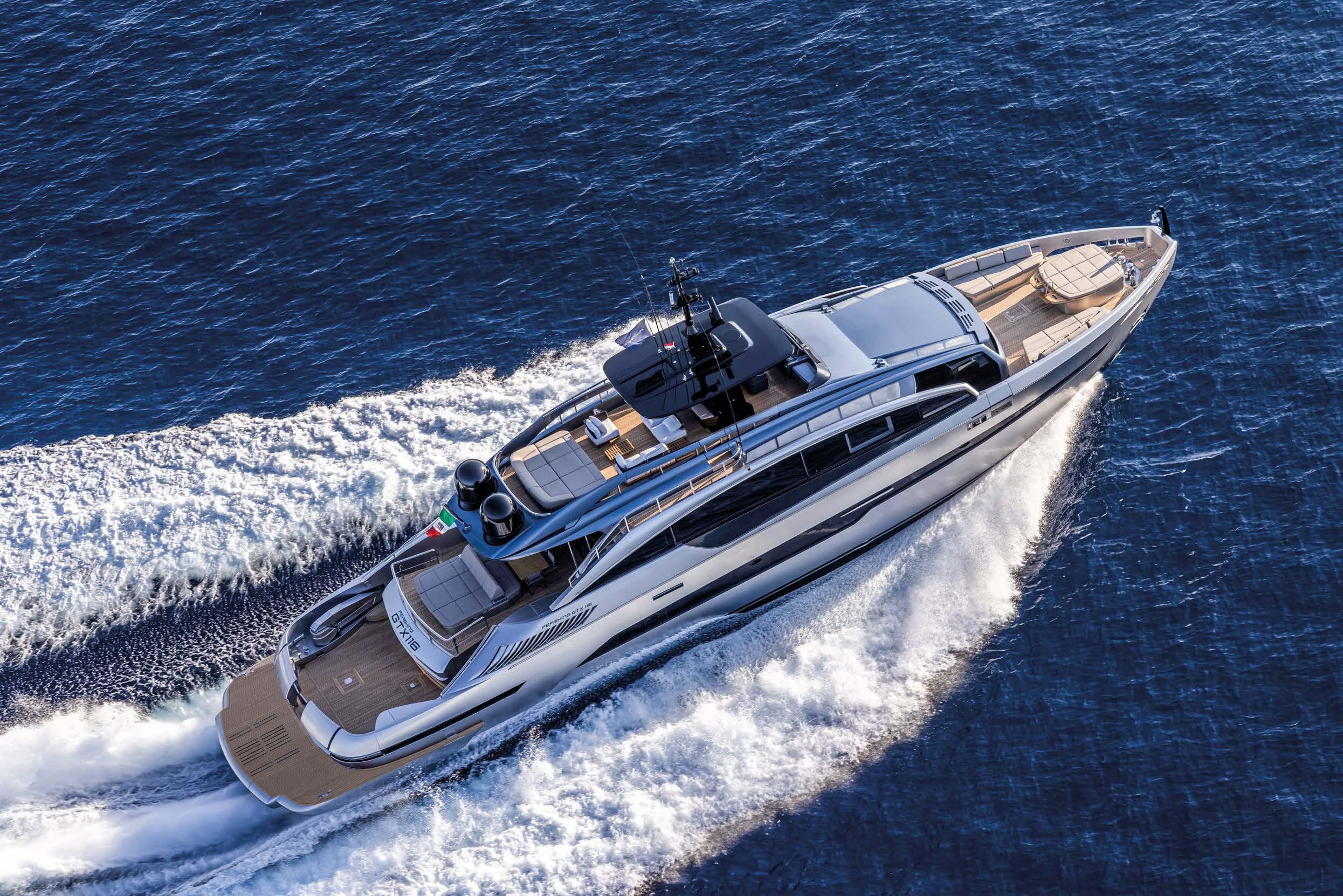
Pershing GTX116 è uno yacht sportivo in cui vengono ottimizzati tutti i pesi a bordo per raggiungere alte performance. Raggiunge una velocità massima di 34 nodi e una velocità di crociera di 29 nodi ed è equipaggiato con una tripla propulsione waterjet abbinata a tre Man V12 2000 dalla potenza di 2.000 mhp.
The Pershing GTX116 is a sports yacht where every weight on board is optimised for high performance. She has a top speed of 34 knots and a cruising speed of 29 knots and is equipped with a triple water-jet propulsion system combined with three MAN V12 2000 engines producing 2,000 hp.

Ecco, per prima cosa, la barca non deve essere uno “scavafango”. Deve essere diversa da quelle che si fanno adesso. Questo vale anche per alcune di quelle
si allar a, si onfia, si alza. Il prodotto si traduce in barche diventate oggetti non identificati, privi di forma. vvero dei cubi progettati da gente che non sa disegnare,
che hanno al galleggiamento. Quindi, per rispondere alla domanda, per fare una barca “giusta” bisogna che sia lontana da tutte queste, con proporzioni completamente

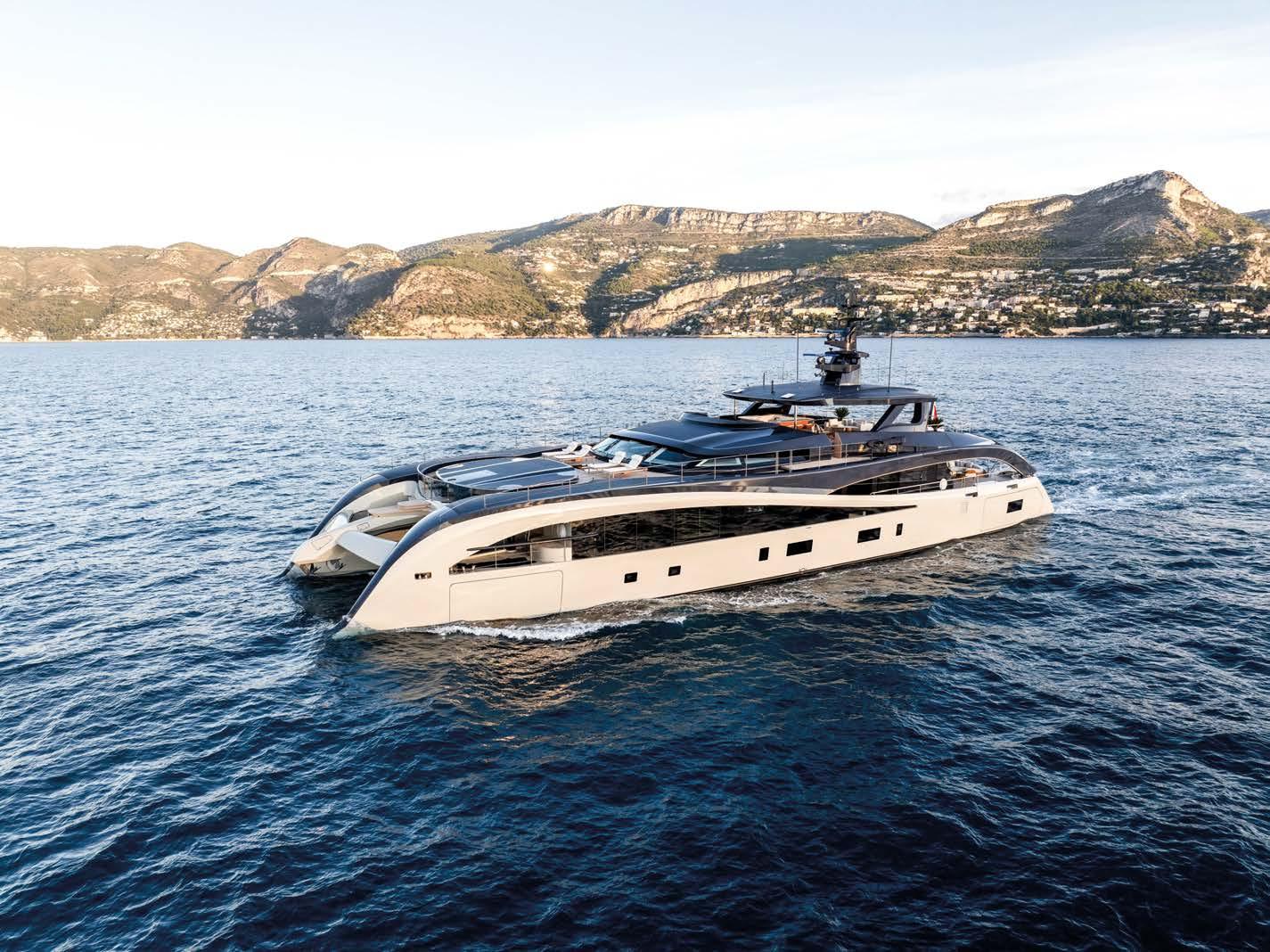


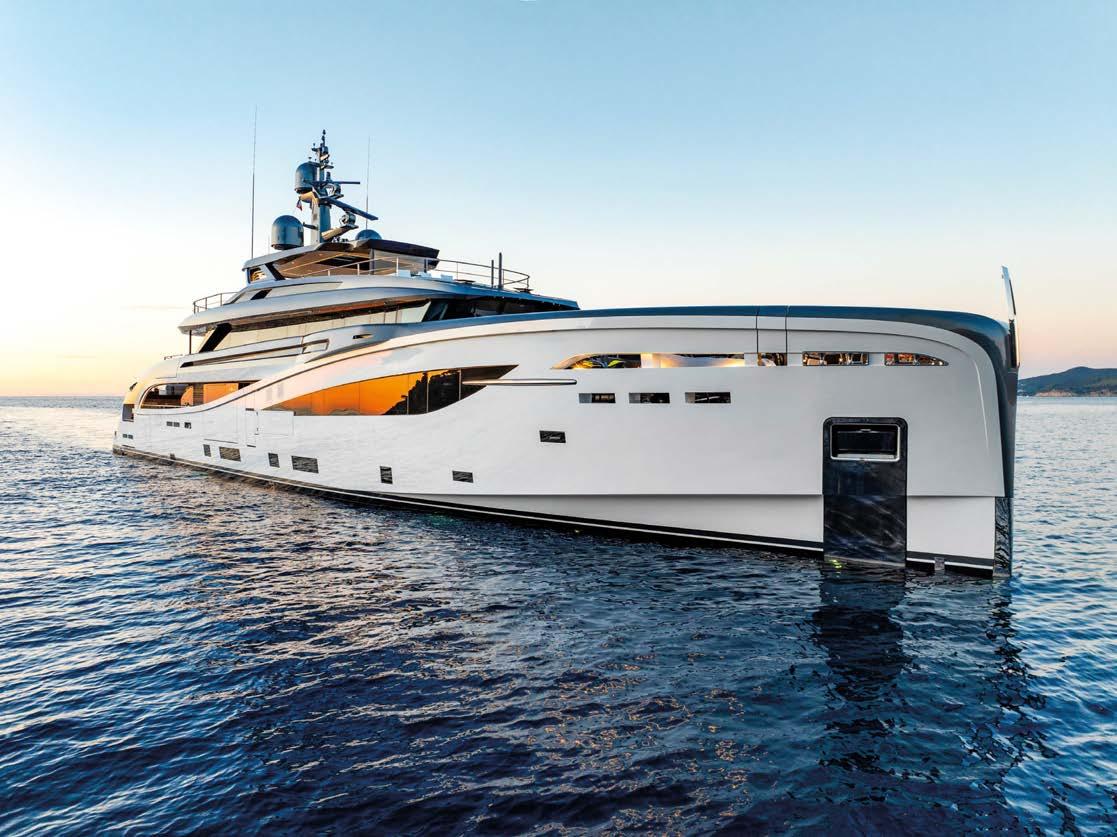




di baglio massimo, caratterizzato da propulsione idrida e ampi spazi aperti, tra cui un salone & zona pranzo di 100 metri quadrati, 5 cabine ospiti e 4 cabine equipaggio.
length of 42.75 meters and a maximum beam of 13.75 meters, characterised by hybrid propulsion and ample outdoor space, among which a 100 m2 saloon and lunching area, five guest cabins

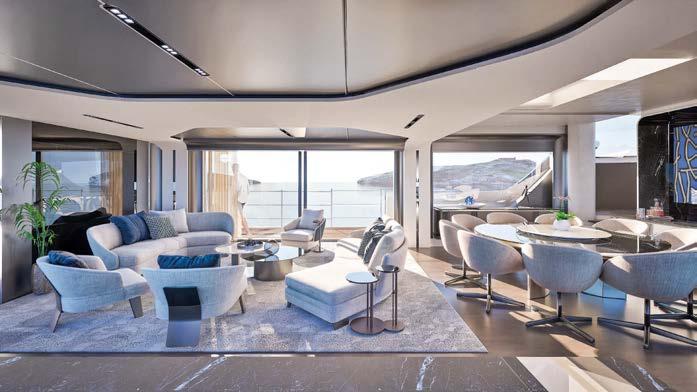
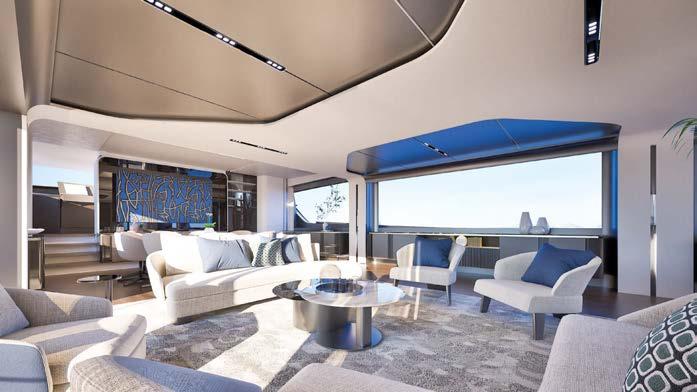
con la pretesa di venire a spiegare il futuro progressivo a noi “poveretti” che disegniamo barche.
Sin qui tutto quello che, a suo avviso, una barca non dovrebbe essere. Quali sono, invece, sempre dal suo punto di vista, le voci corrette da spuntare? Carene che quando camminano non muovano troppa acqua, che scivolino bene, che siano veloci perché non pesantissime, che non contengano diecimila metri di cavi perché non ci sono centomila diavolerie che si aprono e si chiudono. Bisognerebbe, sempre a mio avviso, fare un passo indietro ed evitare di abusare della possibilità di questi scafi di re ere delle “cose sopra, per cui le si fa sempre meno sicure perché il centro di carena e tutte le misure che si
Per Isa Yachts, Palumbo Superyachts, ha disegnato i nuovi modelli Viper 100 e 130 Viper 130 ha scafo e sovrastruttura in composito con rinforzi in carbonio. Imbarcazione planante, monta 3 motori Man da 2.200 cavalli ognuno e può raggiungere la velocità massima di 33 nodi.
Architect De Simoni has designed the new Viper 100 and 130 models for Isa Yacht by Palumbo Superyacht. The Viper 130 has a composite hull and superstructure with carbon reinforcements. It is a planning boat powered by three MAN engines of 2,200 hp each with a top speed of 33 knots.
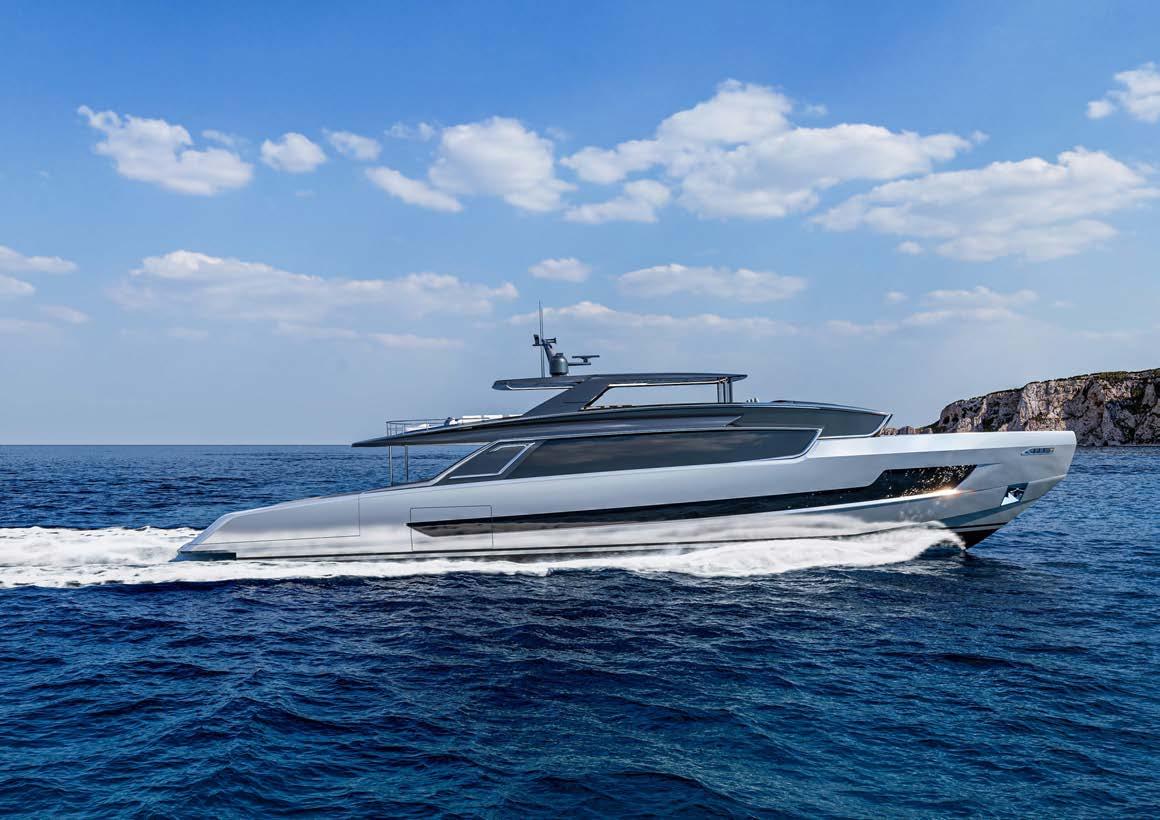
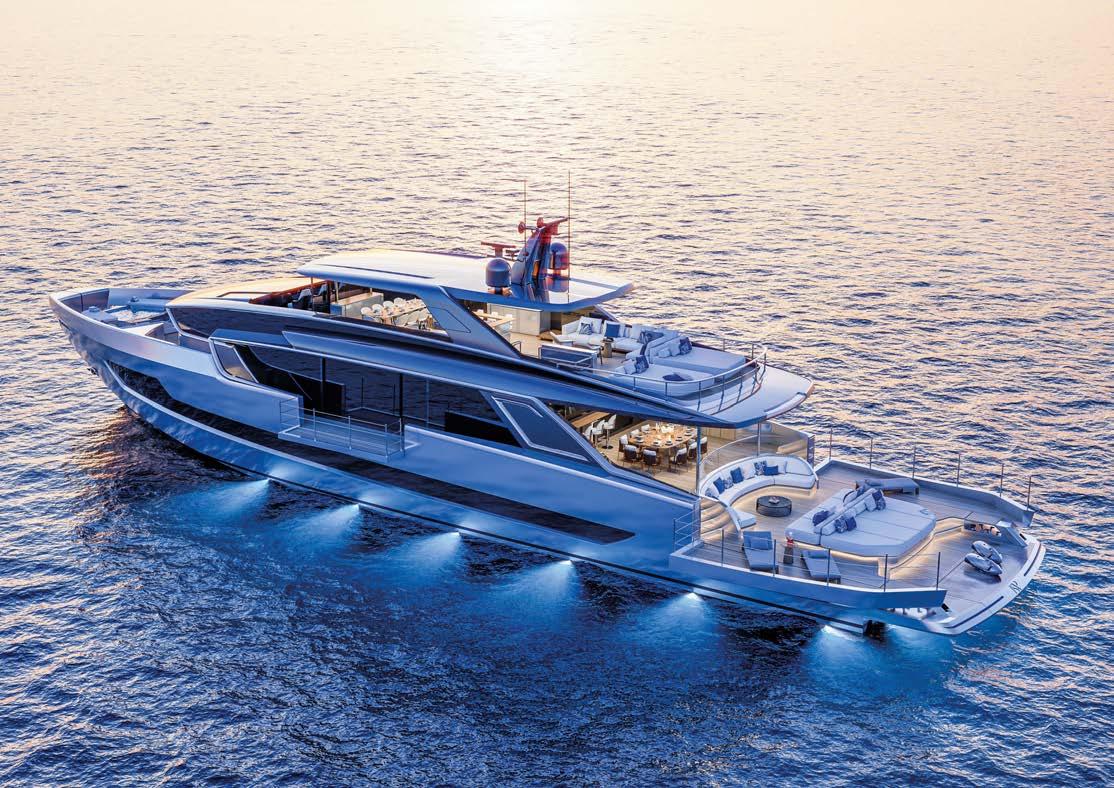


opportunamente già provveduto a fare. Ciò nonostante, lui l’allarga ancora. E questo perché sopra c’è talmente tanto peso, talmente tanti volumi, che si finisce per ridurre le zone stagne e, in poche parole, la sicurezza.
Insomma, mi pare di capire che il suo lavoro le piaccia meno di un tempo. È così. Tutto scorre velocissimo, tutti hanno sullo smartphone l’immagine di ogni cosa che gli appare intorno, tutti copiano tutto. on i computer, poi, si è finito per pare iare e appiattire parecchio. È anche vero che non si può darsi come scopo quello di inventare ogni giorno qualcosa: non è facile e non sempre serve. Un conto è poter assecondare il desiderio di fare una cosa nuova e realizzarla. Altro è investire del denaro in una novità che in quanto tale non è detto possa avere successo. In questo secondo caso, potrebbe essere più sensato fare un passo indietro o per lo meno muoversi con cautela. Diciamo che il primo che decide di investire parecchio in una cosa nuova, diversa, dovrebbe forse poter e saper aspettare. L’esempio più clamoroso vissuto nella mia carriera riguarda la realizzazione, in contemporanea, del Pershing 115 e di uno yacht delle stesse dimensioni di un altro brand. A distanza di tempo possiamo affermare senza errore che questo yacht, decisamente innovativo dal punto di vista del desi n, ha in uenzato moltissimo tutto ci che la nautica avrebbe prodotto negli anni a venire. Quanto a sviluppo successivo, la mia barca non ha mosso tutto questo. Ne sono state consegnate, però, una dozzina,
soddisfazione nell’aver disegnato una grande novità, creando, però, qualche problema ad altri.
Cosa significa per Fulvio De Simoni innovare? Trovarsi davanti a un foglio bianco con il proposito di realizzare un’idea senza voler sapere se qualcuno ci ha già pensato prima di te. Solo in questo modo puoi ritenerti esente da condizionamenti, pulito e libero di procedere. È il motivo per cui, per principio, non salgo mai a bordo delle barche disegnate dai colleghi. Il mondo è così vasto e prodigo di spunti e punti di osservazione, che non hai bisogno di entrare a vedere come è stato svolto il tema da altri. Correresti, tra l’altro, il rischio, non remoto, di ricevere un imprinting che potrebbe condizionarti anche involontariamente a realizzare una cosa simile. Nel design riesci a innovare quando, senza bisogno di andare a guardare cosa c’è fuori da te, sei capace di offrire allo s uardo di chi osserva qualcosa di non visto e, quindi, compiutamente autentico, senza avere come obiettivo la meravi lia fine a s stessa. o stupore è épater le bourgeois, non serve. L’incanto, invece, fa bene al cuore. Ed è così che, dopo aver trascorso diverse ore in compagnia di Fulvio De Simoni, lo saluterò persuasa che non sia vero che abbia un carattere difficile, quanto piuttosto la capacità di distinguere a distanza ciò che è bello e “buono” da ciò che il suo occhio non percepisce come tale, di esprimere il proprio pensiero con determinata onestà e franchezza,
scorci che non mancano di regalarci un fermo immagine inaspettato, quello di un capriolo che fa capolino tra i filari, aggiungendo un ultimo ricordo di genuina bellezza a una splendida giornata, stravissuta, senza tregua.
As with any important appointment, the eve of the event inevitably brings with it a load of expectations, curiosity and anxiety. My first interview with Fulvio De Simoni, more than many others, confirmed the rule of expectation. Perhaps it is because the designer has a reputation for not being an easy person to get along with, maybe it is because of the depth of his nautical culture, or perhaps it is because of his predisposition to express his thoughts without mincing words; the fact is that the planned meeting caused me a certain apprehension. The compactness of the enormous gate that delimited the private space that would have welcomed me only added to the feeling of hesitation and awe that had become a cumbersome presence. I decide to get rid of it quickly. As soon as I crossed the threshold, I set off on foot along the gravel path, inebriated by the scents of the forest and the landscape that gradually unfolded before me. Fulvio De Simoni, his wife Isabella, his collaborators, and a sea of images and objects that testify to the taste for Beauty (the capital letter is not super uous have accompanied a career

full of achievements and successes. A job that began in 1972 and has not only brought satisfaction and fame to its creator but has also been able to set many milestones in the chronicle and grammar of yacht design, as well as in the narrative and debate surrounding a professional activity that began at a time when the profession of yacht designer was still largely unwritten. “It all started in the Cinque Terre, where I grew up, when a friend, knowing of my passion for boats, urged me to go to Milan to chat with his cousin, a designer with a studio that had started up. That’s how I met Alberto Mercati, who suggested I stay and work with him. It was a daydream: I was still studying and had the chance to work with one of the few realities already in the vanguard. Then, in 1977, I founded Yankee Delta with Massimo Gregori, another studio collaborator. We worked together until 1983,




Per Antonini Navi ha sviluppato diversi progetti da 35 a 70 metri. Il brand nasce da un’idea di Aldo Manna, che per primo ha saputo individuare il potenziale inespresso del sito di Marina di Pertusola e la forza imprenditoriale del Gruppo Antonini. Fulvio De Simoni has developed several projects for Antonini Navi, ranging from 35 to 70 metres. The brand is the brainchild of Aldo Manna, who was the first to recognise the untapped potential of the Marina di Pertusola site and the entrepreneurial strength of the Antonini Group.
«La barca che mi ha cambiato la vita? Il Pershing 45, quella con cui il cantiere diede inizio alla produzione. A distanza di 40 anni, risulta tuttora bella e la numero uno è stata recentemente venduta a un mio amico dal primo proprietario».
«The boat that changed my life? The Pershing 45, the boat that started the shipyard’s production. Forty years later, she is still beautiful, and number one was recently sold by the first owner to a friend of mine». Fulvio De Simoni, founder and CEO of Fulvio De Simoni Yacht Design

«Collaboro con Fulvio da ormai 25 anni e, a parte una formazione accademica di base, ritengo di aver appreso da lui e sul campo che la professione è fatta di grande passione e creatività, ma anche di serietà, etica professionale e rispetto per i clienti c e ci danno fiducia ed investono sul nostro lavoro».
«I’ve been working with Fulvio for 25 years now, and I think that, apart from the basic academic training, ve learnt from him and in the field that the profession is made up of great passion and creativity, but also of seriousness, professional ethics and respect for the clients who trust us and invest in our work».
Enrico Lotti, designer and partner
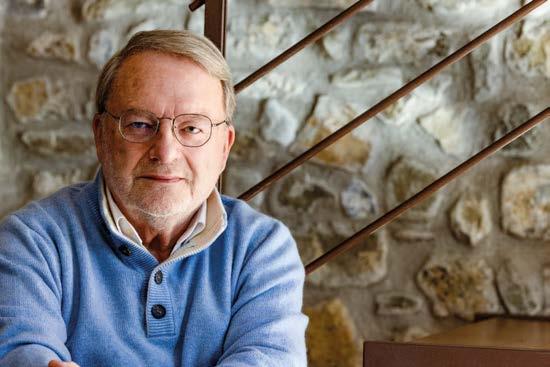
Isabella, moglie di Fulvio De Simoni, è una fig ra fondamentale all interno dello st dio, dove svolge il suo ruolo con discrezione, professionalità e competenza.
Isabella, Fulvio’s wife, is a key figure in the company. She performs her role with discretion, professionalism, and competence.



a oltre ent anni la oro al fianco di Fulvio e condivido con lui l’idea che ogni nuovo progetto deve presentare elementi di innovazione e distinzione. Considero importante l’impatto emotivo che ogni nuovo disegno deve suscitare immediatamente nell’osservatore».
«I have worked with Fulvio for over 20 years and share his belief that every new design must have elements of innovation and distinction. I think it is important that each new design has an immediate emotional impact on the observer».
Cristiano Tonarelli, designer and partner
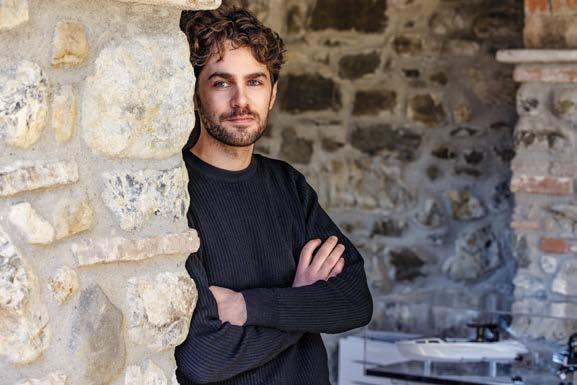

«Con una formazione in design del trasporto, la oro al fianco del team di ul io e imoni concentrandomi su esterni innovativi e funzionali. Qui coltivo la mia passione per il design e collaborando alla realizzazione di progetti unici».
«With a background in transport design, I work alongside Fulvio De Simoni’s team with a focus on innovative and functional exteriors. It is here that I cultivate my passion for design, working on unique projects in the nautical sector».
Alin Irimia, designer


ono nato e cresciuto in urc ia e spinto dalla passione per il design nautico, ho vissuto in Olanda e in Italia. Dopo aver lavorato in diversi studi di yacht design, sono rientrato per collaborare con Fulvio De imoni occupandomi di esterni modellazione esecutiva, renderizzazione e realtà virtuale».

«Da sempre appassionata del mondo dell’arte, ho fatto del disegno a mano libera il mezzo comunicativo per esprimere la mia creatività. In questi anni ho imparato che, per dar vita a un progetto, non basta l’intuizione creativa: è fondamentale unire visione e rigore, un equilibrio che Fulvio mi ha trasmesso con il suo esempio».
«I have always been passionate about the world of art, and I have made freehand drawing the communicative medium to express my creativity. Over the years, I have learnt that creative intuition is not enough to bring a project to life: it is essential to combine vision and rigour, a balance that Fulvio has passed on to me with his example».
Giuditta Napoli, designer and partner

«I was born and grew up in Turkey, and due to my passion for yacht design, I’ve lived in Holland and Italy. After working in several yacht design studios, I come back to work with Fulvio De Simoni. I deal with the exterior, executive modelling, rendering and virtual reality».
Ozan Copur, designer
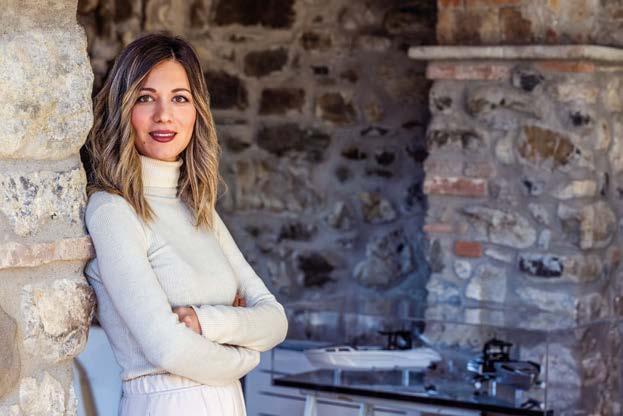
«Condivido con Fulvio l’attenzione al dettaglio e la precisione, prerogative necessarie nello sviluppo esecutivo del progetto. Lavoro prevalentemente alla realizzazione delle matematic e costrutti e fino alla rappresentazione in rendering, video e realtà virtuale».
«I share with Fulvio the attention to detail and precision, which are necessary prerogatives in the executive development of the project. I mainly work on the construction mathematics and the presentation of our projects through renderings, videos and virtual reality».
Francesco Ferrari, designer
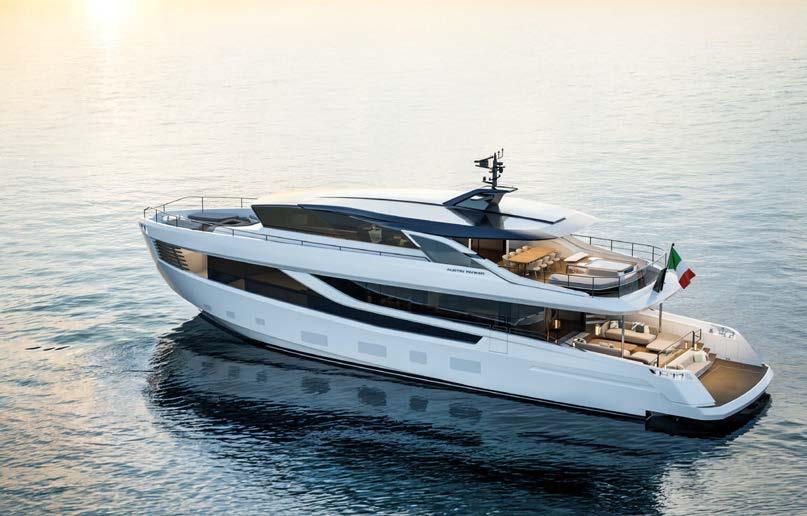
Per Austin Parker Yachts, marchio italiano di yachting con sede commerciale in Liguria e cantiere di produzione a Pisa, che è stato acquisito lo scorso anno dall’imprenditore turco Baris Nalcaci, ha disegnato diversi modelli da 77, 88 e 100
In partnership with Pininfarina, Fulvio De Simoni has designed several 77, 88 and 100-foot models for Austin Parker Yachts, an Italian yachting brand with commercial headquarters in Liguria and a production yard in Pisa, which was acquired last year
Then, in 2015, to involve my closest collaborators, we founded Fulvio De Simoni Yacht Design, in which Enrico (Lotti), Cristiano (Tonarelli), Giuditta (Napoli), Francesco (Ferrari) and my wife are partners”. The team’s skills allow the studio to express itself in every aspect of the project, with a natural and growing specialisation in exterior and interior design, but with the technical skills acquired over many years of activity behind it, enabling it to tackle each new job autonomously and creatively.
“I was involved in every aspect of the project for at least 30 years”, explains Fulvio De Simoni. “This was because a professional studio needed to offer a complete service, including, for example, the design of hulls and systems. Then, with the continuation of the business and the ever-increasing specialisation that is needed in the work, we dedicated ourselves mainly to the conception of the boat, the cutting of the interiors, the design of the superstructures, the general architecture, preferring to leave the in-depth study of the issues to the technicians and engineers. This is also because the construction sites with which we collaborate, which used to

Per Filippetti Yachts ha realizzato i progetti di una linea di megayacht di 80, 90 e 100 piedi. Il primo esemplare del nuovo modello Flybridge 100 è stato varato lo scorso anno presso la Marina dei Cesari di Fano. Lo yacht, con i suoi 30,40 metri di lunghezza, è il più grande dell’intera serie Filippetti Flybridge.
Fulvio De Simoni has designed a range of 80, 90 and 100-foot mega yachts for Filippetti Yachts. The first e ample of the new Flybridge 100 model was launched last year at the Marina dei Cesari in Fano. At 30.40 metres, the yacht is the largest in the entire Filippetti Flybridge range.
«Ogni nuova imbarcazione è un mezzo partecipato di diversi apporti complementari, che si traduce in un miglioramento generale della qualità progettuale e realizzativa».
«Each new vessel becomes a participatory vehicle for various complementary contributions, improving design and construction quality».
be ‘our responsibility’ as far as design is concerned, have also become larger and more structured, with decidedly important in house technical studies. Suffice it to say that the Ferretti Group’s superyacht shipyard in Ancona, which builds the ershin , employs around fifty hi hly specialised professionals. I remember that at one point, we were confronted with a technician dedicated exclusively to studying interference (EMI, ed) and, therefore, the correct installation on board the various antennas. In other words, it was time to take a step back and intelligently leave room for each professional to contribute. In this way, each new vessel becomes a participatory vehicle for various complementary contributions, improving design and construction quality”. Do we essentially live and work in a very different world from the one you started in? Undoubtedly. The times are long gone when Norberto and Alessandro erretti would come to ilan the first studio where I started my career alongside Alberto, who had already worked at Riva and had si nificant e perience in the field and say: ‘We thought we’d come to see you because we’re car dealers from Bologna, but we want to build boats...’. The relationship with the builders has also changed radically: when I liked boating, there was a direct, continuous and therefore profitable comparison with those who built the boats. Nowadays, the big boatyards think they can do it all themselves, delegating to a whole series of people who, in a top-down organisation, always seem to have to go around someone else. The result? You never know whether the objection they put to you is pro-domo propria or pro-domo in general. If you don’t have a direct dialogue with the person concerned, the relationship becomes colder, based only on numbers, and I don’t like that. I don’t like dealing with people
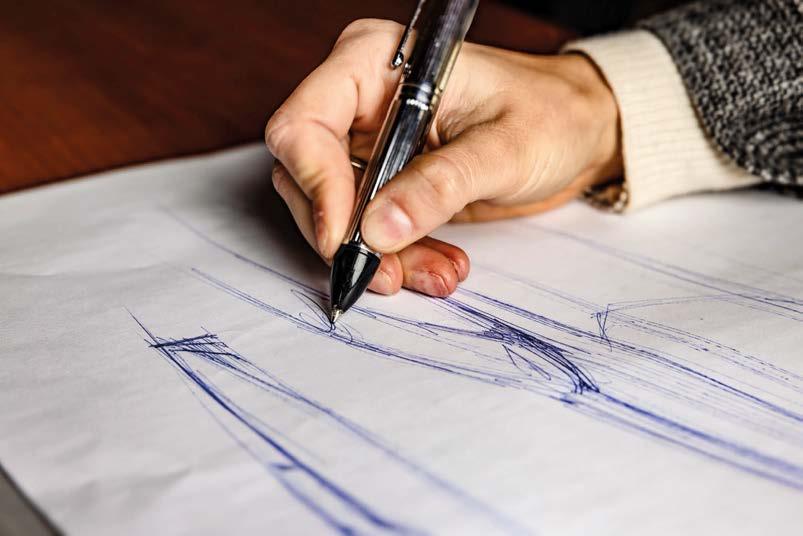
who give you the example of someone who has managed to build a boat with an extra two square metres of ybrid e. I thin it is no longer critical who builds boats well but who achieves an inevitable turnover. What are the key features of the ‘perfect’ or at least ‘right’ boat? Let’s start with the basics: most boats launched today could be described as ‘mudskippers’. hat is to say, they have to be filled with everything, they have an ever-increasing volume, the spaces inside, outside and underneath are becoming increasingly important, and they have bows that, instead of slidin , fi ht with the water and do all sorts of things. First of all, the boat must not be a mudder’. It has to be different from the ones they make now. This is also true of some of the ones they commission from us: they are the designs they have made, having had this kind of input. How did this scenario come about?
Boatbuilders have a bad habit of comparing the square metres of interiors, cabins, bathrooms, and salons to show that they always offer more than others. he first to do so, obviously unprepared, have ruined the medium-sized boat sector. The struggle to enlarge is soon done: it swells, enlarges, and rises. The result is boats that have become unidentifiable, shapeless ob ects. In other words, cubes designed by people who do not know how to draw, for whom the only important thing is that they have a vertical bow, a vertical stern, vertical sides,
a at roof, everythin as bi as possible, as long as it is ‘modern’, like the Range Rovers from which they have also removed the handles. OK for ‘modern’, but everything should work and have logic. Instead we see boats that sail badly because the weights are not where they should be and the volumes are larger than the waterline. So, to answer the question, to make a ‘proper’ boat, it must be far from all this, with completely different proportions and correct. In a sailboat, which is undoubtedly more beautiful, it would never occur to anyone to add two or three storeys to create more space. This is because they are used for different purposes. otor yachts are increasingly becoming sailing hotels, so much so that there is even talk of how much hotel electricity there is on board, not to mention the plethora of interior designers who have oc ed to the nautical world on the pretext of explaining the progressive future to us ‘poor people’ who design boats. So far, everything you think a boat should not be. On the other hand, what are the right things to tick off from your point of view? Hulls that do not move too much water when they run glide well are fast because they are not heavy and do not contain ten thousand metres of cable because there are not a hundred thousand devils to open and close. Again, let’s take a step back and avoid abusing the ability of these hulls to hold ‘things’ on top so that they become less and
less safe because the centre of the hull and all the measurements you take on board are constantly being pulled. Every time we build a new boat, we check everything with the engineer, who tells us right on time: It needs to be twenty centimetres or half a metre wider. Which, conveniently, we had already done. But he widens it anyway. This is because there is so much weight on it, so much volume, that you reduce the watertight zones and, in short, safety. In short, I understand you like your job less than you used to. That’s the way it is. Everything moves so fast; everyone has an image of everything around them on their smartphone and copies everything. So, with computers, you end up levellin and attenin a lot. It is also true that you cannot aim to invent something every day: it is not easy or always useful. It is one thing to be able to indulge the desire to do something new and realise it. It is another to invest money in a novelty that, as such, may not necessarily be successful. In this second case, taking a step back or moving cautiously might make more sense.
et us say that the first person who decides to invest a lot in something new, something different, should perhaps be able and know how to wait. The most eye-catching
example I have seen in my career is the simultaneous creation of the Pershing 115 and a yacht of the same size by another brand. Over time, it is fair to say that this yacht, with its highly innovative design, had a si nificant in uence on everythin that yachting would produce in the years to come. As far as subsequent development was concerned, my boat did not move much. A dozen were delivered, but only one was sold after many years. You must know how to interpret the moment and what you can and can’t do. Otherwise, you end up being a genius and an unruly person who takes pleasure and satisfaction in having designed a great novelty but creates problems for others.
What does innovation mean to Fulvio De Simoni? To sit down in front of a blank sheet of paper and try to come up with an idea, not caring if someone else has already thought of it. Only in this world can you consider yourself free of conditioning, clean and free to proceed. That is why, as a matter of principle, I never board boats designed by colleagues. The world is so vast and full of insights and points of observation that you don’t need to go in and see how others have done it. You would, among other things, run the not insi nificant ris of receivin
an imprint that might condition you, even unintentionally, to do such a thing. In design, you succeed in innovating when, without having to go and look at what is outside of you, you can offer the beholder’s gaze something unseen and, therefore, completely authentic, without having wonderment as an end in itself. Astonishment is épater le bourgeois; it is not necessary.
Enchantment, on the other hand, is good for the heart. And so, after spending a few hours in Fulvio De Simoni’s company, I will say goodbye to him, convinced that it is not true that he has a complex character, but rather the ability to distinguish at a distance what is beautiful and ‘good’ from what his eye does not perceive as such, to express his thoughts with determined honesty and frankness, and to avoid compromises and conventions that are harmful to his character and others. The journey to the exit is made by taking advantage of Giovanni’s passage. We stroll to enjoy a second time the scents and the views that do not fail to give us an unexpected still, that of a deer peeping through the rows of vines, adding a final memory of true beauty to a splendid day that has been enjoyed inexhaustibly.

Il team dello studio di progettazione
Fulvio De Simoni
Yacht Design: da sinistra, Ozan Copur, Enrico Lotti, Francesco Ferrari, Mauro Cantini, Cristiano Tonarelli, Isabella e Fulvio De Simoni, Alin Irimia e Giuditta Napoli.
Fulvio De Simoni
Yacht Design’s team: from the left, Ozan Copur, Enrico Lotti, Francesco Ferrari, Mauro Cantini, Cristiano Tonarelli, Isabella and Fulvio De Simoni, Alin Irimia and Giuditta Napoli.
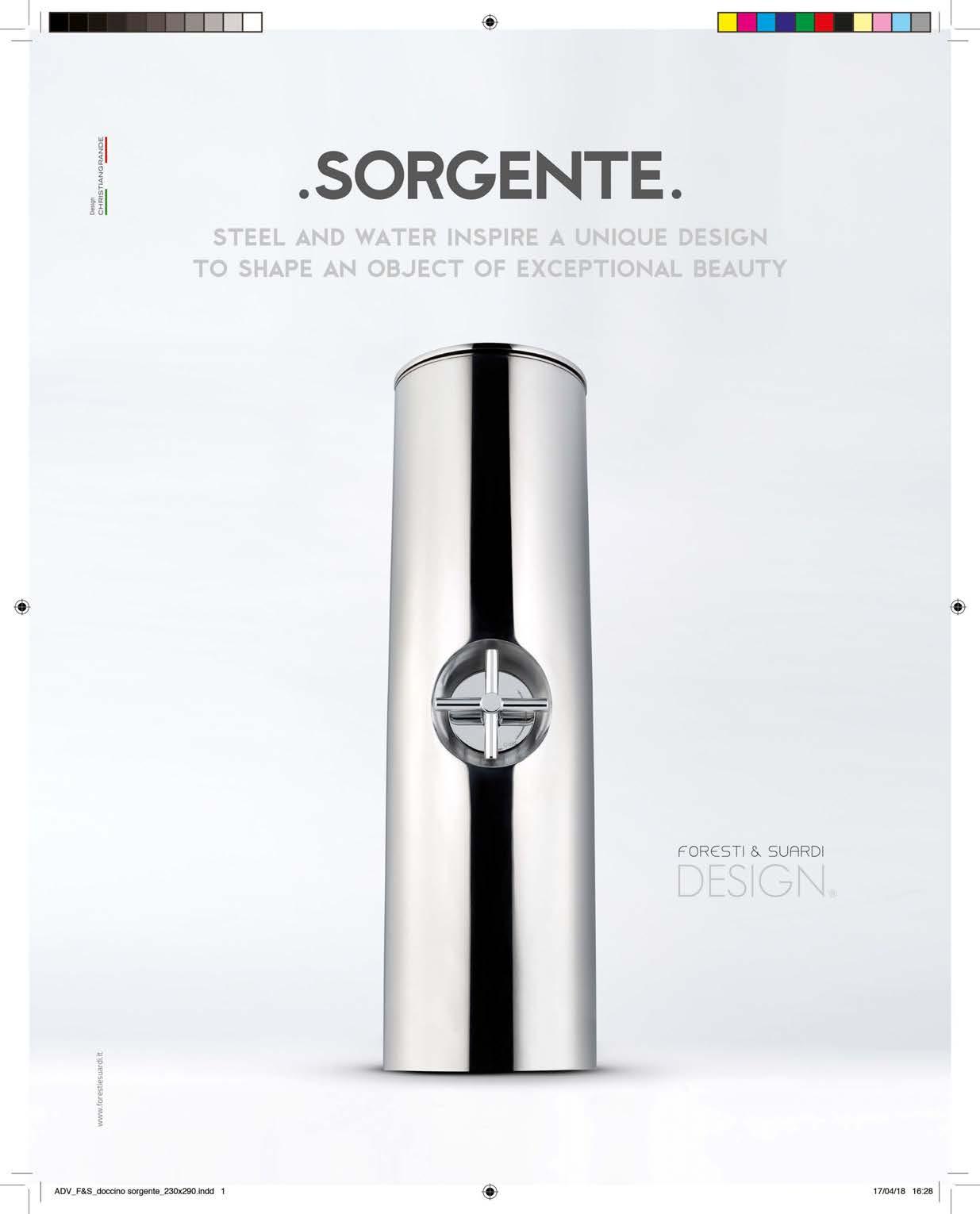




CON INTERNI ED ESTERNI DALLE LINEE MORBIDE, PROGETTATI DA HOT LAB E ARCHITETTURA NAVALE DI HYDRO TEC, ATLANTIQUE 43 DEL CANTIERE COLUMBUS YACHTS È STATO COSTRUITO IN DUE VERSIONI PER RISPONDERE ALLE ESIGENZE DEI SUOI ARMATORI WITH INTERIOR AND EXTERIOR SOFT LINES DESIGNED BY HOT LAB AND NAVAL ARCHITECTURE BY HYDRO TEC, COLUMBUS YACHTS’ ATLANTIQUE 43 WAS BUILT IN TWO VERSIONS TO MEET THE NEEDS OF THE OWNERS
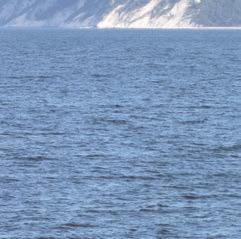
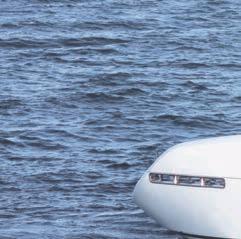
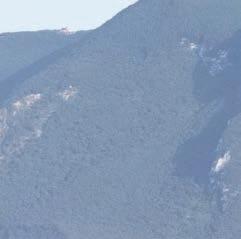
by Mari eresa Campolongo

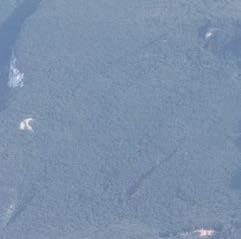
photo by Renaud Canivet and Guerrieri Visual

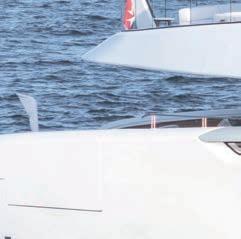

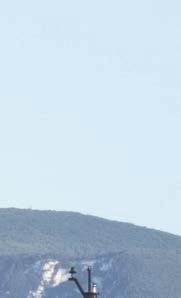
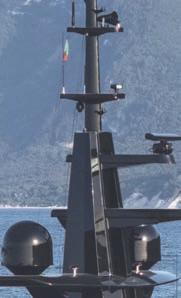
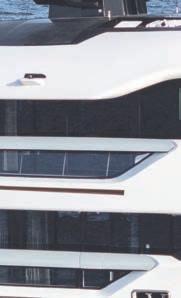
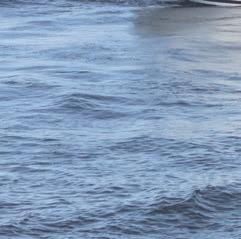

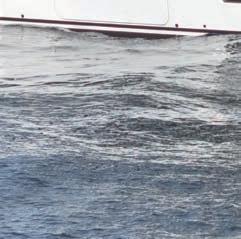

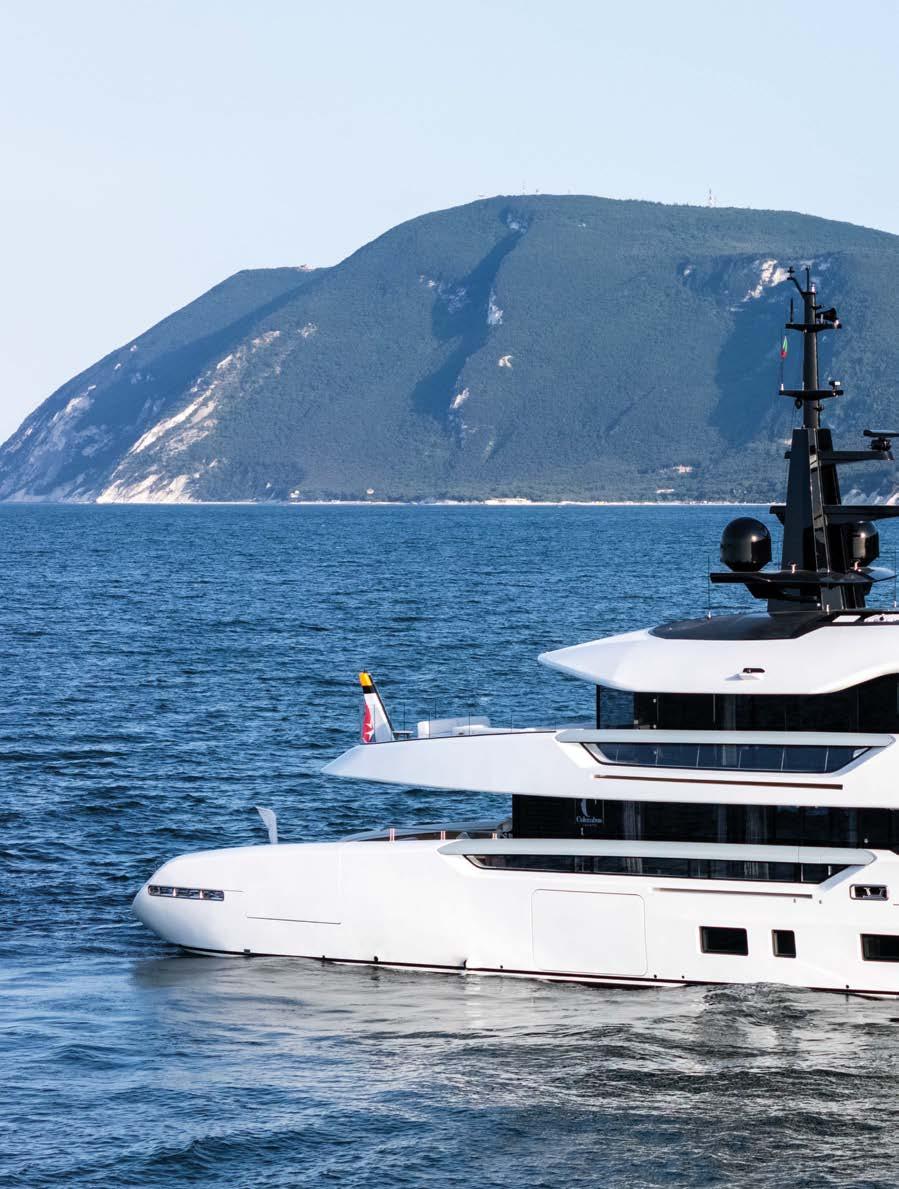
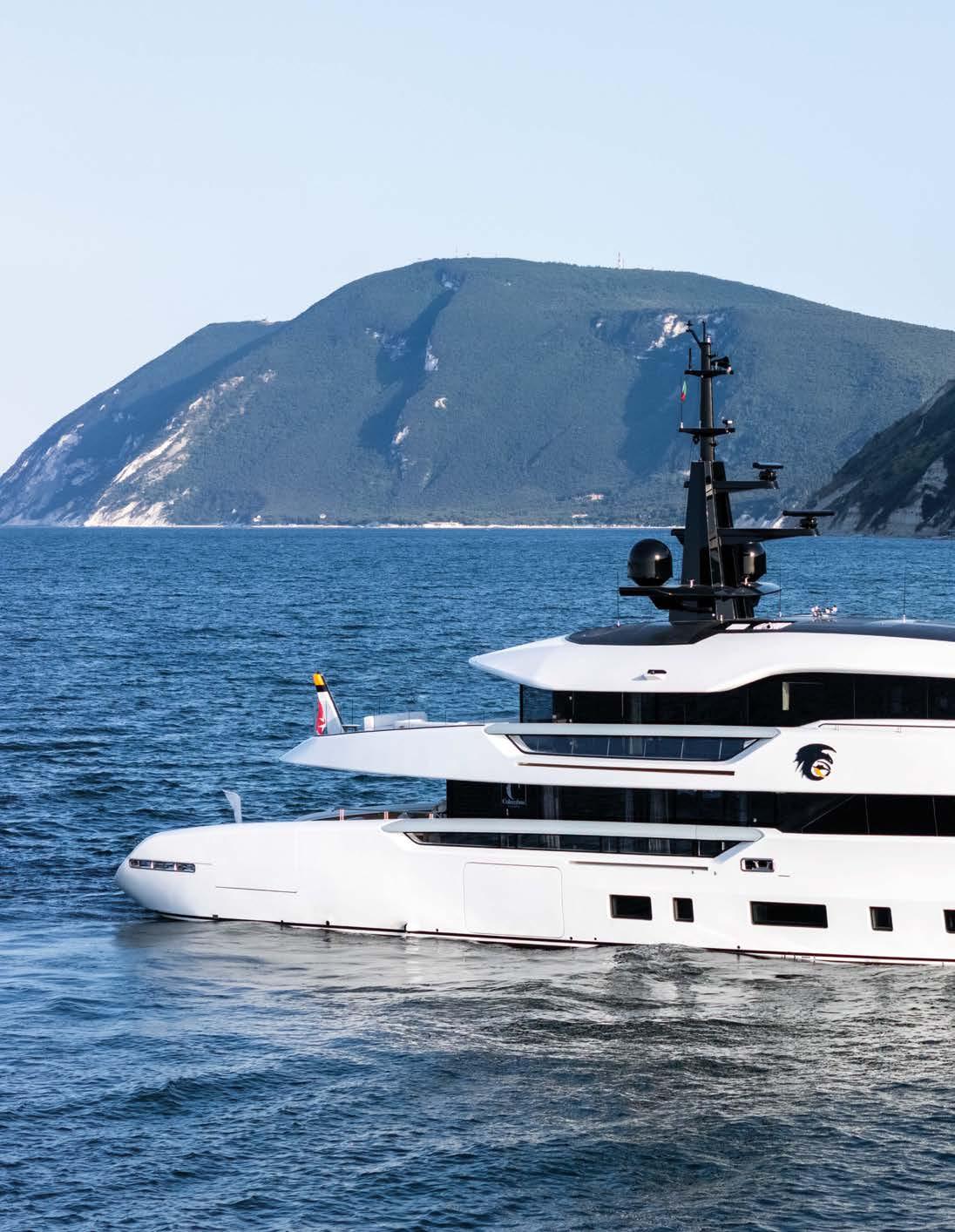

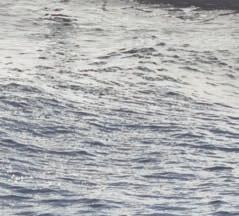


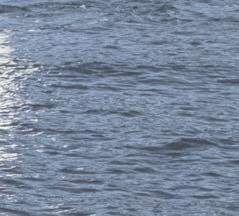

Columbus Atlantique 43 metri ha esterni e interni a firma dello studio Hot Lab e presenta una filosofia progettuale chiamata “Architecture for Voyagers” un connubio di elementi stilistici, progettuali e funzionali dedicati al viaggiare per mare godendo appieno ogni singolo momento passato a bordo. L’ingegneria navale è del cantiere in collaborazione con lo studio Hydro Tec. Lo scafo in acciaio della lunghezza di 43 metri è combinato alla sovrastruttura in alluminio, il baglio massimo è di ,50 metri e la stazza si attesta a 4 2 GT. Poppa effetto meraviglia, gusto occidentale arricchito da atmosfere orientali e linee uide. Queste sono alcune delle caratteristiche di Atlantique 43 del cantiere Columbus Yachts, parte del network Palumbo Superyachts. Ma andiamo con ordine si sa che il passo più importante da fare quando si vuole intraprendere la navigazione è il primo, quello per salire a bordo poiché, simbolicamente, comporta lo staccarsi dalla terraferma per dirigersi verso l’ignoto. Atlantique 43, con la sua bellissima poppa, invita proprio a fare questo passo, accogliendo gli ospiti con una larga passerella centrale
Night Fury II è un superyacht pensato in funzione dell’armatore e della sua famiglia, dotato di ampie aree esterne che creano un unicum con i generosi spazi interni. Dalle zone interne del main e dell’upper deck il contatto con il paesaggio circostante è totale.
che porta alla bella zona antistante la grande piscina. In linea con i trend contemporanei, la poppa garantisce uno stretto contatto con l’acqua, anche grazie alle due ali abbattibili laterali. La novità sta per nella forma sembra quasi una poppa tonda tipica della vela e la sensazione è quella di trovarsi all’interno di un guscio scavato. Gli arredi, come i divani e le sdraio sono free-standing in modo da garantire diverse configurazioni.
La grande capacità del cantiere di poter personalizzare le barche, partendo dalla stessa piattaforma e in base alle esigenze dell’armatore, si vede già dalla zona di poppa su Frette, a differenza dello scafo n 1, la zona esterna è più ristretta a vantaggio di saloni più ampi. La customizzazione ha previsto anche l’aggiunta del ponte sole e bisogna affermare che lo studio Hot Lab ha svolto un ottimo lavoro confrontando i profili di Night Fury II e di Frette le linee risultano perfettamente armoniche in entrambe le unità, esito non scontato se si pensa che a parità di dimensioni e di forme c’è un livello in più. Le linee esterne ricordano un guscio, quasi una pietra levigata e intagliata ad arte
Night Fury II is a superyacht designed with the owner and his family in mind. Her large exterior areas create a unique blend with the generous interior spaces. From the interiors of the main and upper decks, there is total contact with the surrounding landscape.
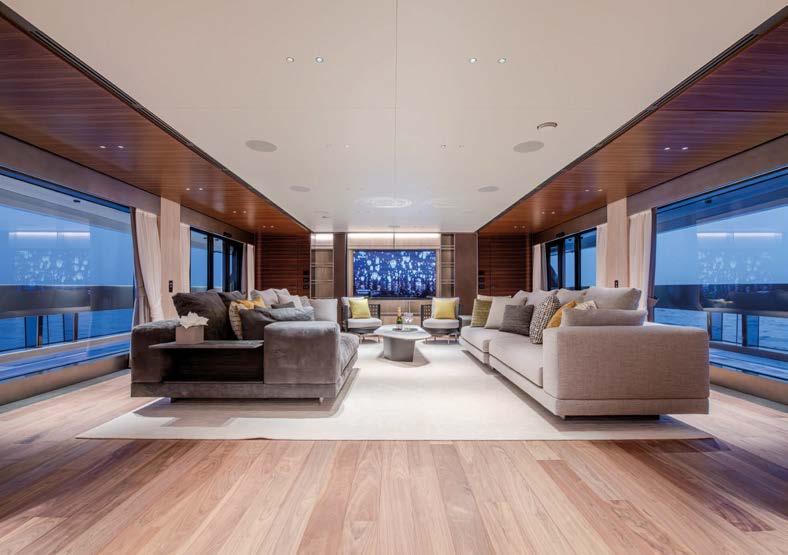


niente spigoli, niente cambi repentini di inclinazione. Solo un’unica forma, morbida e aggressiva allo stesso tempo, sintesi naturale tra uno yacht a motore e un classico scafo a vela. La uidità dei richiami velici dona a questa barca a motore un’eleganza naturale. A bordo di Night Fury II la piscina centrale, circondata da una seduta a C, si affaccia verso poppa ed è molto scenografica. Il tutto è molto basso sull’acqua grazie alla scelta di “scavare” la zona poppiera, siamo infatti a 50 centimetri dal mare e, aggiungendo anche le due ali abbattibili laterali, vi è la sensazione di avere un contatto diretto con l’acqua. Subito dietro, salendo di soli due scalini, vi sono due ampie sedute a L rivolte verso poppa e un tavolo espandibile che pu ospitare fino a 12 commensali. La zona cena, con tavolo custom Fisher Moebel e sedie Minotti, è quindi stata spostata all’esterno, grazie alle vetrate laterali frangi vento chiudibili ed a quelle che affacciano sul main saloon, si ha una sensazione di dentro fuori molto uida. Il mood degli interni si risolve attorno ai colori dell’arancio abbinato a toni del grigio e a legni caldi e freddi per uno stile quasi industriale. La parte interna del main saloon è caratterizzata da una zona con grandi divani e tavoli caffè Minotti. Vi è inoltre la possibilità di aprire completamente le due vetrate scorrevoli presenti nella zona prodiera del main saloon. Il resto del ponte principale è diviso in più aree, andando verso prua a dritta troviamo la lobby principale con il vano scale e il lift portavivande. La cucina è posizionata sulla murata di sinistra. A prua del main deck si trova l’ampia cabina armatoriale che prevede zona ufficio e cabina armadio, letto centrale e un bagno con doccia bagno turco. Il layout dell’upper deck è progettato per offrire la massima convivialità a bordo. L’area esterna di poppa è infatti composta da diversi divani della linea Minotti abbinati a tavolini Talenti e Minotti e procedendo verso prua si accede, attraverso una grande vetrata apribile, alla zona pranzo interna con tavolo Cattelan e sedie Minotti che pu ospitare fino a 12 persone. Completano l’area due grandi finetrature laterali cielo terra completamente apribili per una connessione esterna più uida. Proseguendo verso prua troviamo la plancia di comando e la cabina del Comandante. Si è voluto notevolmente enfatizzare lo spazio lounge a prua che
include una bella piscina panoramica attorniata da prendisole, zona lounge con coffe-table DFN e un bar. Il lower deck di Night Fury II ospita 4 cabine doppie, 2 Vip con bagno a murata e 2 twin, tutte con bagno privato. Negli interni di Frette continua la uidità delle linee entrando si è accolti da due grandi fotografie in bianco e nero di Venezia e del ponte East River di Manhattan e solo grazie al tatto ci accorgiamo che le superfici verticali non sono in legno di sicomoro ma sono rivestite con una carta da parati che ne ricrea l’effetto. Divani e poltrone Paolo Castelli e coffee table hanno forme morbide ed enfatizzano questo senso di uidità degli spazi, in un’atmosfera di tonalità calde ravvivate da quelle fredde del blu e dell’azzurro dei cuscini. Un altro bel contrasto è stato ottenuto grazie al gioco della finitura liscia o tridimensionale dei pannelli in legno rovere. La parete di fondo che accoglie la grande TV è in marmo onice e avorio; proprio il marmo è il protagonista della zona di prua dedicata alla sala karaoke. Seppur non siamo più abituati a vedere questo trionfo di marmo nell’interior yacht design contemporaneo, dobbiamo dire che la scelta del Calacatta viola determina un’estetica interessante. Siamo anche piacevolmente colpiti dal grip e della sensazione del parquet in legno rovere con trama Tatami finitura pietra sotto ai nostri piedi. Il bagno di servizio di questa zona è sempre realizzato in marmo Calacatta, qui nella versione bianca, e include una grande sauna. Le linee curve vengono sempre riprese nelle diverse aree dello yacht, ad esempio nella scrivania dell’ufficio armatoriale, negli specchi del bagno e della grande cabina armadio dell’armatore così come negli arredi dell’upper deck, tra cui il grande divano strutturale a semicerchio nella zona di poppa e il tavolo da pranzo interno che pu ospitare fino a 12 persone, realizzato su misura in marmo Panda. Molto bello il contrasto cromatico del tavolo con le sedie Fendi Casa, che riprendono anche le forme curve. Anche qui il parquet in noce americano spazzolato sbiancato è montato a spina di pesce con posa a 45 . Via via che visitiamo i diversi ponti notiamo come i prodotti Frette Bespoke impreziosiscano lo yacht non poteva essere diversamente, dato il nome della barca in onore dello storico marchio tessile Frette fondato nel 18 0. Molto bella l’area di prua dell’upper
Il layout dell’upper deck è progettato per o rire la massima convivialit a bordo. L’area esterna di poppa è infatti composta da diversi divani e procedendo verso prua si accede, attraverso una grande vetrata apribile, alla zona pranzo interna con tavolo Cattelan, che pu ospitare fino a 12 persone, con sedie Minotti.
The layout of the upper deck is designed to maximise socialising on board. The outdoor area at the stern features several sofas, while towards the bow, a large opening window gives access to the indoor dining area, which includes a Cattelan table for up to 12 people and Minotti chairs.



La zona cena, con tavolo custom Fisher Moebel e sedie Minotti, è stata spostata all’esterno, grazie alle vetrate laterali frangivento chiudibili ed a elle che a acciano sul main saloon.

The dining area, with a bespoke Fisher Moebel table and Minotti chairs, has been moved outdoors thanks to the closing side windows and those overlooking the main saloon.
deck, con una piscina scenografica rettangolare attorniata da prendisole bianchi, zona lounge con coffee table Paola Lenti in olmo e un bar con sgabelli in teck naturale siamo stupiti dalla vicinanza alla zona di ormeggio, ma bisogna dire che stando qui seduti la vista è spettacolare. Il ponte sole, che contraddistingue questa unità, è stato progettato con tettuccio rigido sopra al grande tavolo custom per 14 persone. A prua si trova il bar con sgabelli e ampio prendisole mentre a poppa un grande barbecue la cui altezza rimane purtroppo visibile nel profilo della barca se per pensiamo che magari pu essere la zona ideale per uno spettacolo di show cooking, allora pu essere valido
che l’estetica faccia un passo indietro a vantaggio della funzione. Il lower deck ospita 5 cabine doppie 2 Vip e 3 twin, tutte con bagno privato e rivestimenti in marmo Calacatta bianco. Il parquet delle cabine è in noce americano spazzolato sbiancato sempre montato a spina di pesce e qui combinato a pareti in tessuto melange e cielini in legno laccato bianco che vanno ad amplificare la luminosità interna. La zona prodiera del lower deck è dedicata all’equipaggio, con tre cabine doppie, tutte con bagno, la crew mess e la zona lavanderia. Con 2 Cat C32 Acert da 70 kW, Columbus Atlantique 43 pu raggiungere la velocità massima di 15,5 nodi e quella di crociera a 14,5 nodi.
A prua del main deck si trova l’ampia cabina armatoriale che prevede zona u cio e cabina armadio, letto centrale e un bagno con doccia/bagno turco.
The large master stateroom, with an o ce area, wal -in wardrobe, central bed, and en suite shower/toilet, is located aft on the main deck.





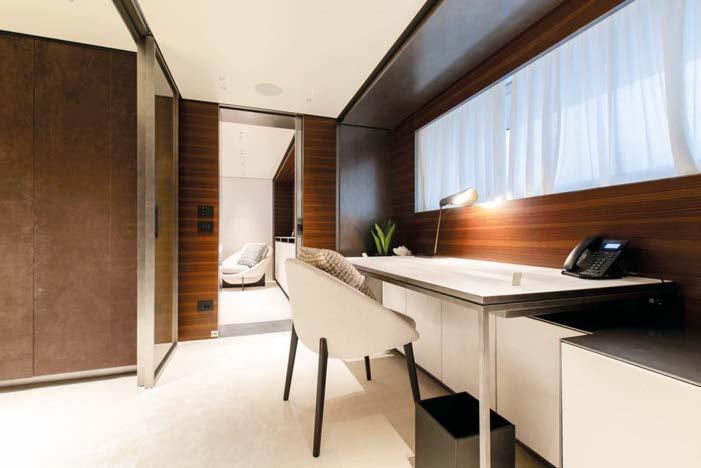
The 43-metre Columbus Atlantique, with exterior and interior designs by the Hot Lab studio, presents a design philosophy called “Architecture for Voyagers” a combination of stylistic, design and functional elements dedicated to travelling at sea and en oying every moment spent on board. The shipyard developed the naval architecture in collaboration with the Hydro Tec studio. The 43-metre steel hull is combined with an aluminium superstructure, the maximum beam is .50 metres, and the tonnage is 4 2 GT. Excellent stern effect, western taste enriched by oriental atmospheres and owing lines. These are some
that the most crucial step to take when embarking on a voyage is the first, that of getting on board since it symbolically means breaking away from the mainland and heading into the unknown.
Atlantique 43, with her beautiful stern, invites you to take this step and welcomes you with a wide central gangway leading to the beautiful area in front of the large swimming pool. In keeping with contemporary trends, the stern ensures close contact with the water thanks to the two folding side wings. The novelty, however, lies in its shape it looks almost like a typical round stern and gives the impression of being inside a hollowedout shell. The furnishings, such as sofas
to the owner’s needs, can already be seen in the stern area. Unlike hull no. 1, onboard Frette, the exterior space is more limited, to the advantage of larger salons. The customisation also included the addition of the sundeck. It must be said that the Hot Lab naval architecture studio, which was responsible for the exterior and interior design, has done an excellent ob comparing the two profiles of Night Fury II and Frette, the lines are perfectly harmonious in both units, a result that cannot be taken for granted, considering that there is an extra level for the same size and shape. The external lines are reminiscent of a shell, almost like an artistically polished

La zona pranzo interna dell’upper deck ha tavolo su misura in marmo Panda e sedie Fendi Casa. La zona lounge include due poltrone Giorgetti Caddy abbinate a due tavolini Fendi Casa.
The dining area on the upper deck features a bespoke Panda marble table and Fendi Casa chairs. The lounge area features two Giorgetti Caddy armchairs and two Fendi Casa coffee tables.

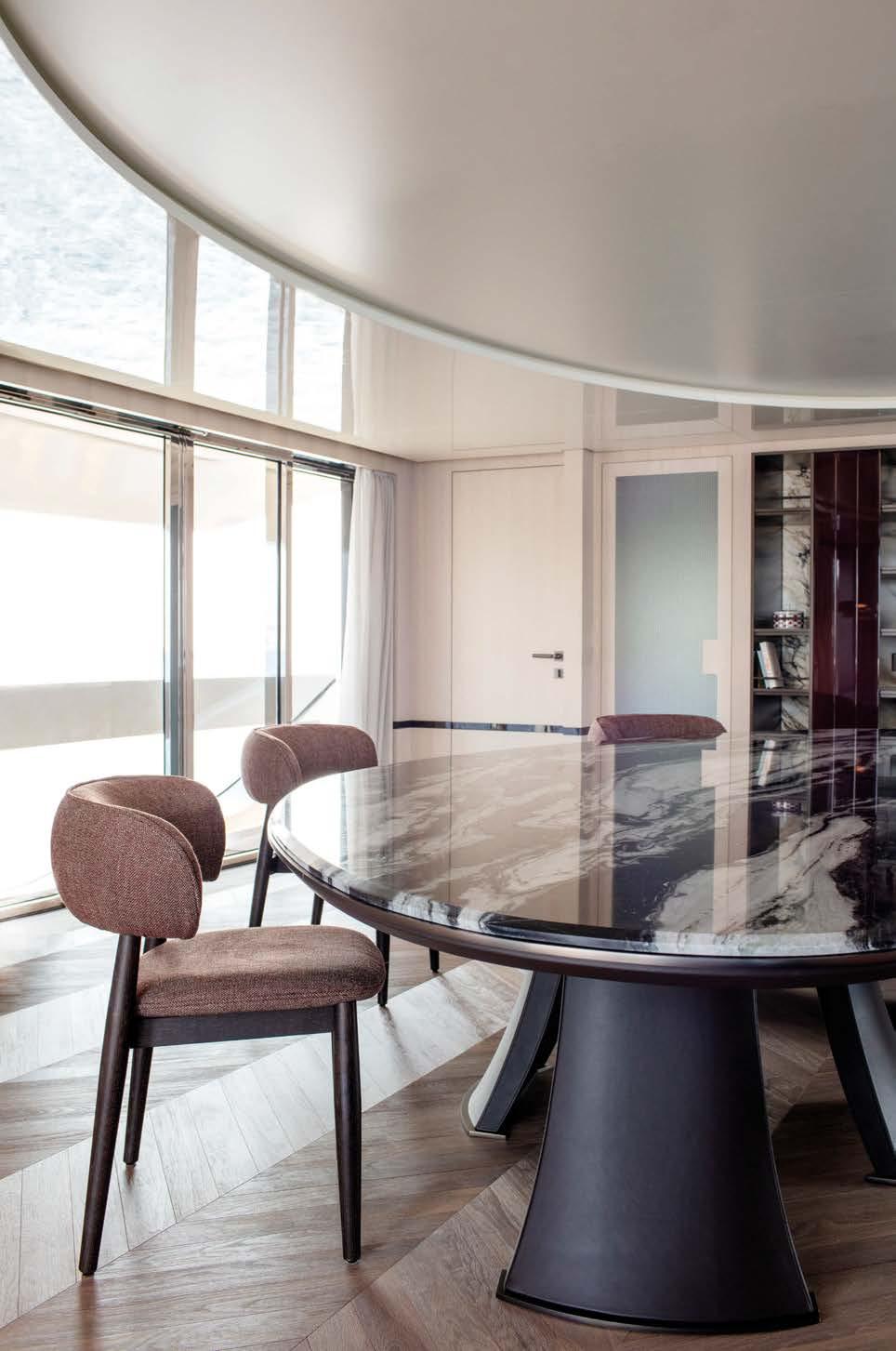
La linea morbida dei divani e delle poltrone Paolo Castelli nel living del main deck enfatizzano la uidit degli spazi. uesta area è completata da una panca Fendi in legno naturale rovere con seduta in tessuto e cinghie in pelle, oltre ad un mobile bar free standing di Poltrona Frau panna con finiture in noce canaletto.
The soft lines of the Paolo Castelli sofas and armchairs in the main deck living area emphasise the uidity of the space. A Fendi bench in natural oak with a fabric seat and leather straps complements this area, as does a Poltrona Frau freestanding bar cabinet in cream with a Canaletto walnut finish.
and a classic sailing hull. The uidity of the sails gives this motor yacht a natural elegance. On board Night Fury II, the central cockpit, surrounded by a C-shaped seat, faces aft and is very dramatic. The whole thing is very low on the water, thanks to the choice of ‘digging’ the aft area; we are, in fact, 50cm from the sea and, adding the two folding side wings, there is the feeling of having direct contact with the water. Immediately behind, ust two steps up, are two large L-shaped aft-facing seats and an extendable table that can seat up to 12 people. The dining area, with a bespoke Fisher Moebel table and Minotti chairs, has then been moved outside,
and thanks to the opening side windows and those overlooking the main saloon, there is a very uid indoor outdoor feeling. The interior is dominated by orange, shades of grey, and warm and cool woods, creating an industrial style. An area with large sofas and Minotti coffee tables characterises the interior of the main saloon. The two sliding windows at the front of the main saloon can be fully opened. The remainder of the main deck is divided into many areas, with the main lobby, staircase, and food lift to starboard. To port is the galley. Forward of the main deck is the large master stateroom with office and walk-in wardrobe area, central bed and en suite

L’ingegneria navale è del cantiere in collaborazione con lo studio Hydro Tec.
The shipyard is responsible for the naval engineering in cooperation with Hydro Tec Studio.



shower toilet. The layout of the upper deck is designed to maximise socialising on board. The outdoor area at the rear of the boat is made up of several sofas from the Minotti range, combined with Talenti and Minotti coffee tables , and, towards the bow, a large opening window gives access to the indoor dining area with a Cattelan table and Minotti chairs that can seat up to 12 people. The area is completed by two large sky land side windows that can be fully opened for a more uid external connection. Moving towards the bow, we find the helm station and the captain’s cabin. Great emphasis has been placed on the forward living area, which includes a beautiful panoramic swimming pool surrounded by sun decks, a lounge area with DFN coffee tables and a bar. Night Fury II’s lower deck accommodates four double cabins, 2 VIPs with en-suite heads and two twins, all with en-suite bathrooms. On board Frette, the uidity of the lines continues in the interiors on entering, we are greeted by two large black and white photographs of Venice and Manhattan’s East River Bridge , and only by touching them do we notice that the

La forma tonda della zona di poppa di Atlantique 43 è la parte più caratterizzante della barca.
The most enhancing part of the Atlantique 43 is the round shape of the stern area.
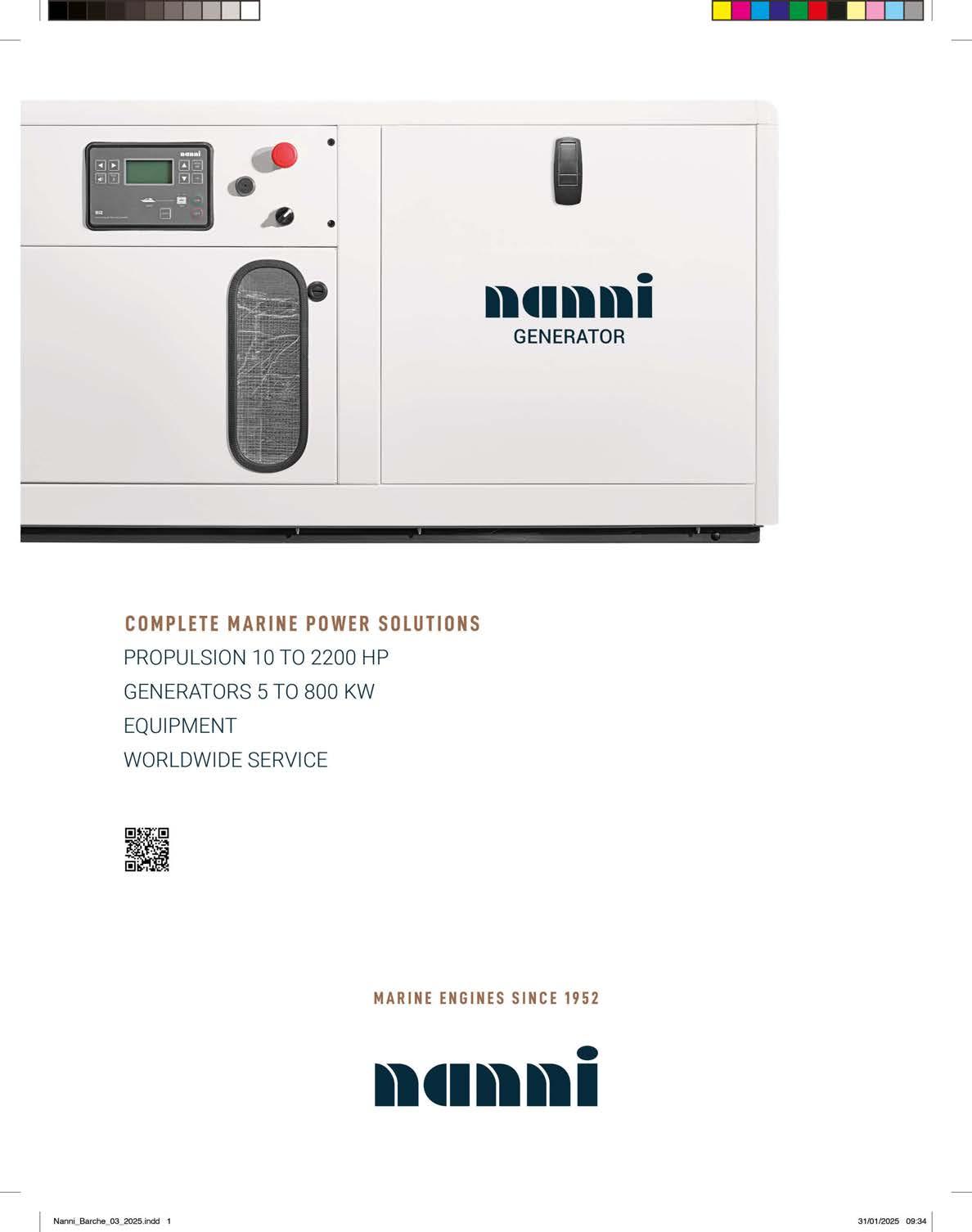
Ancona / Italia info@columbusyachts.com www.columbusyachts.it
PROGETTO
Architettura navale HydroTec e Palumbo Superyachts • Design esterni e interni Hot Lab
SCAFO
Lunghezza f.t. 43,06m • Lunghezza al galleggiamento 41,10m • Baglio massimo 9,50m • Pescaggio a pieno carico 2,60m • Scafo in acciaio • Sovrastruttura in alluminio • Dislocamento a pieno carico 420 t • Stazza internazionale 462 GT
• Capacità serbatoio carburante 50.956 l
• Capacità serbatoio acqua 8.518 l • Capacità serbatoio acque grigie/nere 8.000 l • Cabine armatore e ospiti 5/6 per 12 persone • Cabine equipaggio 5 per 9 persone
MOTORI
2 Cat C32 Acert 970 kW @1800 giri/min • Velocità massima 15.5 nodi • Velocità di crociera 14,5 nodi
• Autonomia a 10 nodi 4.000 miglia
CLASSIFICAZIONE
RINA C * HULL • MACH, YCH, UNRESTRICTED NAVIGATION, AUT UMS, REGYC COMPLIANT
PROJECT
HydroTec and Palumbo Superyachts (naval architecture) • Hot Lab (exterior
LOA 43.06m • LWL 41.10m • Maximum beam 9.50m • Draft at full load 2.60m • Steel hull • superstructure • Full mass displacement 420 t • 462 GT • Fuel tank volume
• Water tank volume waste water tanks volume
• Owner and guest cabins 5/6 up to 12 people • Crew cabins 5 per 9 people
2 CAT C32 Acert 970
• Maximum speed 15,5 knots • Cruising speed 14.5 knots – Range at 10 knots
vertical surfaces are not made of plane wood, but are covered with a wallpaper that reproduces the effect. Paolo Castelli’s sofas, armchairs and coffee tables have soft shapes and emphasise this uidity in an atmosphere of warm tones enlivened by the cushions’ cool blue and light blue. The interplay between the smooth and three-dimensional finishes of the oak panels provides another attractive contrast. The back wall houses the large television in onyx and ivory marble; marble is the star of the arched area dedicated to the karaoke room. Although we are no longer used to seeing this triumph of marble in contemporary yacht interiors, we have to say that the choice of purple Calacatta makes for an interesting aesthetic.
e are also pleasantly impressed by the feel of the oak parquet ooring with a tatami woven stone finish underfoot. The service bathroom in this area is always in Calacatta marble, here in the white version, and includes a large sauna. Curved lines are repeated throughout the yacht, from the desk in the owner’s office, the mirrors in the bathroom and the owner’s sizeable walk-in wardrobe to the furnishings on the upper deck, including the large structural semi-circular sofa in the aft area and the interior dining table for up to 12 people, custom-made in Panda marble.
The chromatic contrast between the table and the Fendi Casa chairs, which also echo the curved shapes, is very
we notice how the Frette Bespoke products enhance the yacht it could not be otherwise, as the boat is named in honour of the historic textile brand Frette, founded in 18 0. The bow area of the upper deck is lovely, with a picturesque rectangular pool surrounded by white sundecks, a lounge area with a Paola Lenti elm coffee table and a bar with natural teak stools we are surprised by its proximity to the mooring area, but it must be said that the view from here is spectacular.
The sun deck, a feature of this unit, is designed with a hardtop canopy over the sizeable bespoke table for 14 people. At the bow, there is a bar with stools and a large sundeck, while at the stern, there is a large barbecue, the height of which, unfortunately, remains visible in the boat’s profile. However, if we consider this the ideal spot for a cooking show, aesthetics should take a back seat to functionality. The lower deck houses five double cabins two VIP and three twin, all with en-suite bathrooms and white Calacatta marble panelling. The parquet ooring in the cabins is bleached brushed American walnut, always laid in a herringbone pattern. Here, it is combined with mottled fabric walls and white lacquered wooden ceilings that enhance the brightness of the interior. The forward section of the lower deck is dedicated to the crew. It includes three double cabins, all with en-suite bathrooms, the crew mess, and the
RINA C * HULL • MACH, YCH, UNRESTRICTED NAVIGATION, AUT UMS, REGYC COMPLIANT
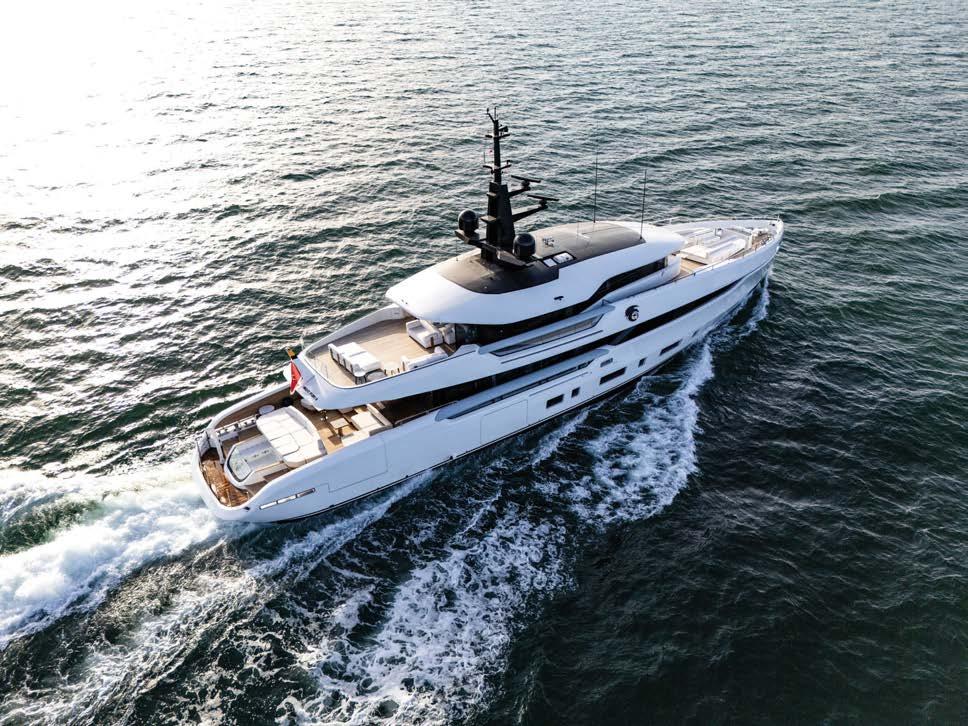



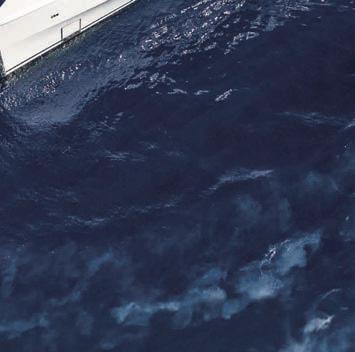
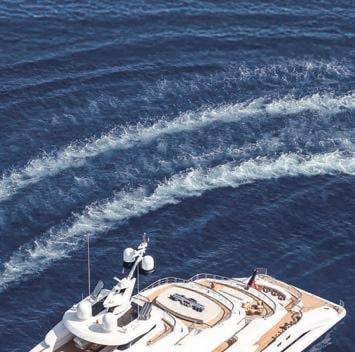
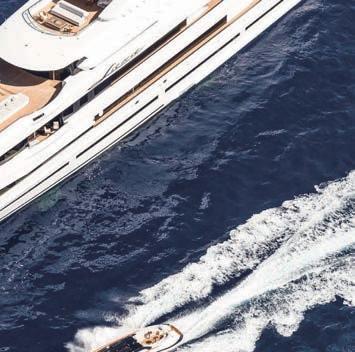
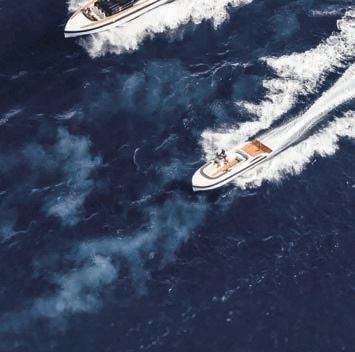




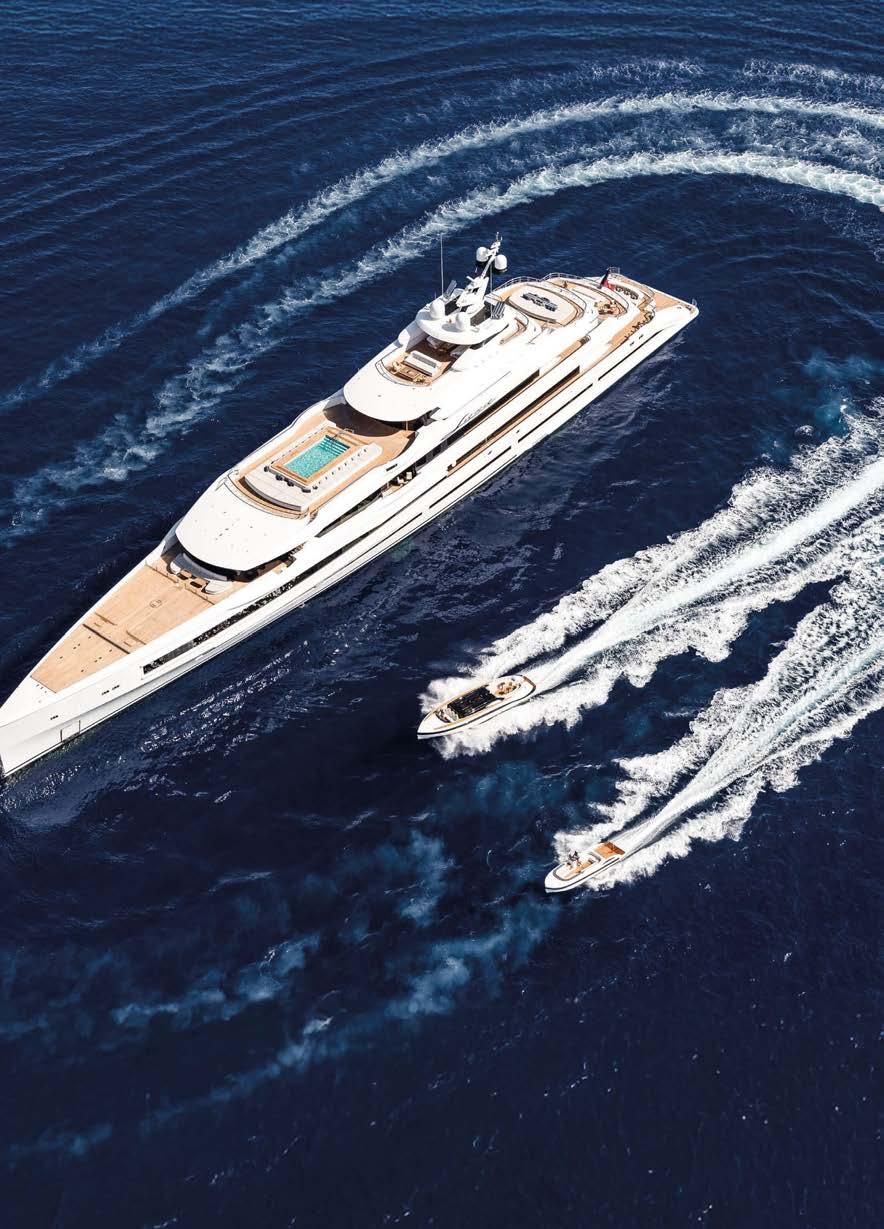
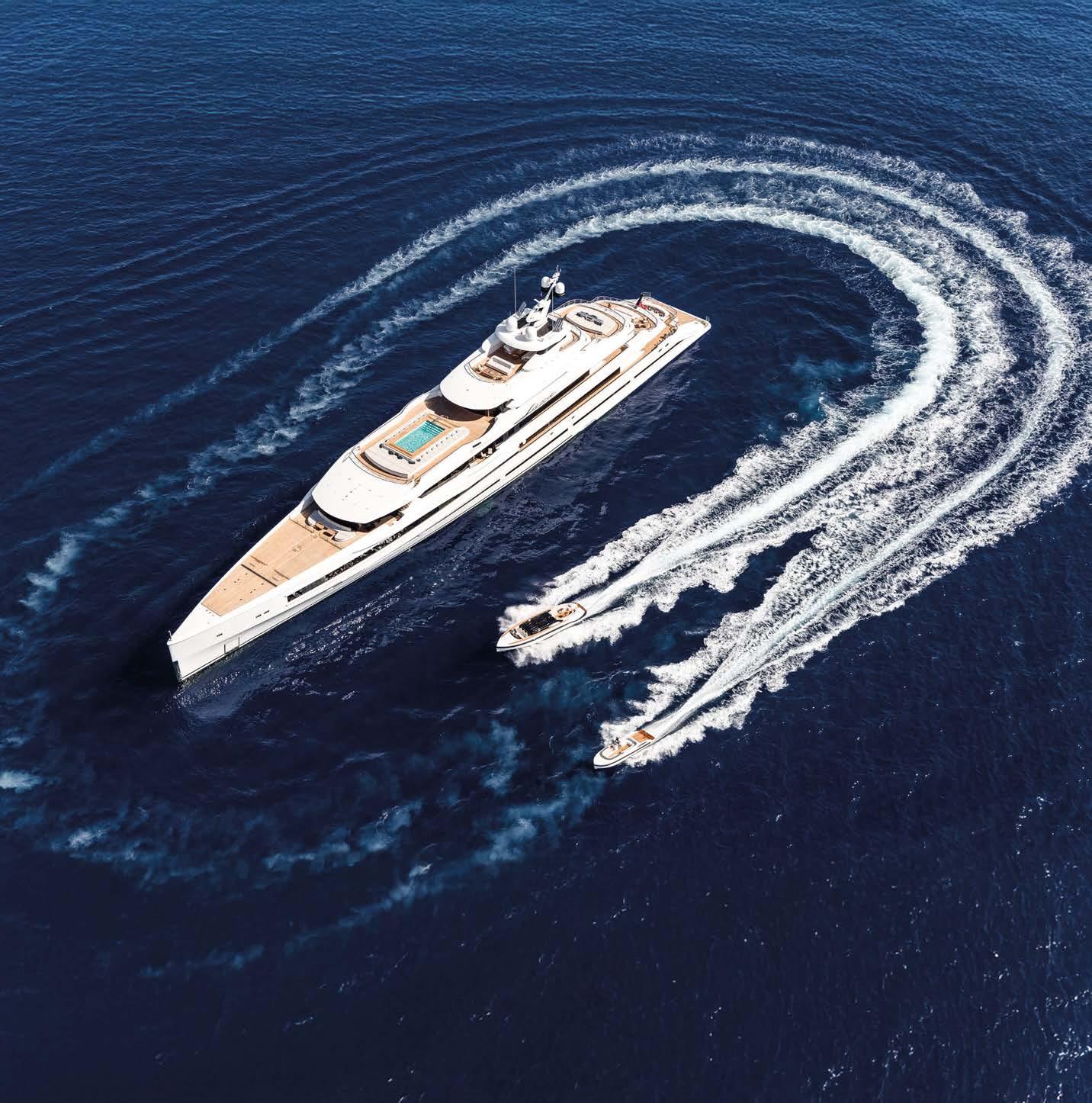
PAOLO MORETTI, AMMINISTRATORE DELEGATO DI RINA SERVICES, FA IL PUNTO SUI SERVIZI SVILUPPATI DA RINA IN AMBITO EFFICIENTAMENTO ENERGETICO, DIGITALIZZAZIONE E SOSTENIBILITÀ
PAOLO MORETTI, CEO OF RINA SERVICES, REVIEWS THE SERVICES RINA HAS DEVELOPED REGARDING ENERGY EFFICIENCY, DIGITISATION, AND SUSTAINABILITY
by Olimpia De Casa
photo by Je Brown/ Br d Media
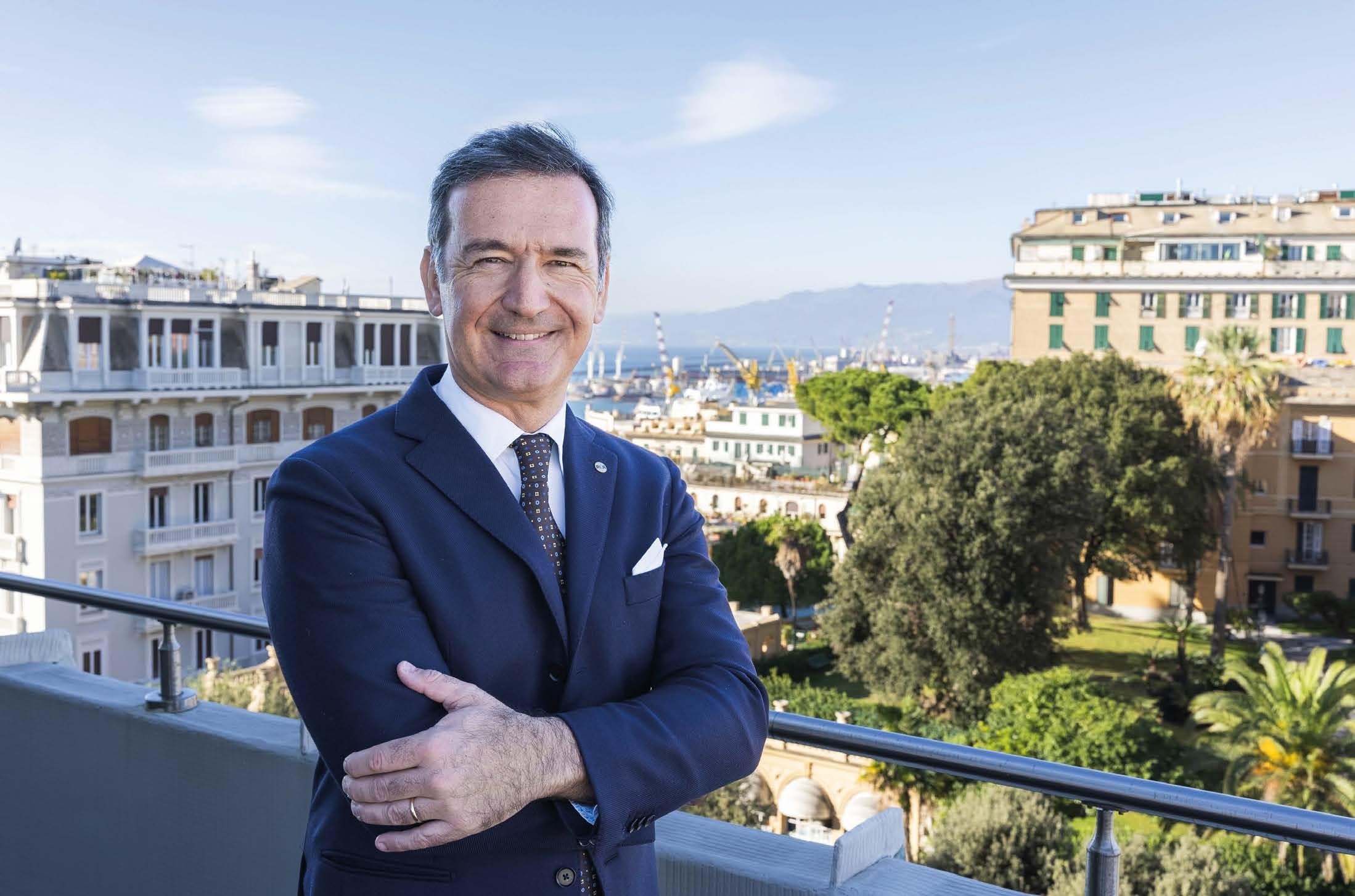
Memoria storica degli ultimi 27 anni del gruppo multinazionale di ispezione, certificazione e consulenza ingegneristica, Paolo Moretti ha iniziato la sua carriera in RINA nel 1997, ricoprendo incarichi di responsabilità crescente sino ad assumere, nel 2020, l’attuale ruolo di Amministratore Delegato di RINA Services, società attiva nei settori marittimo e della certificazione. Il suo è pertanto un curriculum professionale di peso, che lo ha visto artefice e partecipe dei risultati ottenuti nell’ultimo millennio su larga scala in relazione ai servizi forniti nei settori marine e certificazione. Laureato in ingegneria navale e marittima presso l’Università degli Studi di Genova, è entrato in RINA dopo aver assolto il servizio militare, neanche a dirlo, in Marina. “Il mio ingresso è avvenuto nel momento in cui la società di via Corsica, all’epoca attiva sostanzialmente nelle certificazioni navali, era in piena internazionalizzazione. Stava infatti uscendo dai confini nazionali per se uire clienti e armatori che andavano a costruire sempre più in Corea, Cina, Giappone. I primi anni della mia carriera sono stati proprio in Corea del Sud, dove ho seguito tutta la realizzazione del naviglio mercantile per armatori italiani. Sino al 2010 abbiamo indirizzato l’operatività strategica verso l’espansione internazionale legata ai nostri servizi core, quelli della classificazione e delle ispezioni delle piattaforme offshore, con l’apertura di nuovi uffici in uropa,
ma anche in America, Medio Oriente, Sud st Asiatico, orea e Shan hai. on l’avvio del secondo decennio è invece iniziata l’era della diversificazione e della consulenza ingegneristica in relazione a tutti i grandi settori di mercato, dall’infrastruttura all’industria. ientrano in questa finalit d’intenti le acquisizioni di D’Appollonia - ora RINA Consulting -, che portò con sé un grande know-how nel mondo della consulenza ingegneristica soprattutto per la parte energy, oil & gas e infrastrutture, e di CSM, il centro in cui per anni si sono sviluppate le più grandi tecnologie dedicate all’industria siderurgica nazionale, che ci ha consentito di realizzare test su larga scala, essendo un’eccellenza in prima linea nella sperimentazione e nelle tecnologie innovative in ottica materiali, ma anche decarbonizzazione. ramite il S acronimo di entro Sviluppo ateriali, ndr abbiamo infatti vinto un bando europeo del valore di 88 milioni di euro per un progetto della durata di sei anni, che si concretizzerà nella progettazione e
realizzazione di una ‘mini acciaieria’ che sperimenterà l’idrogeno in ogni fase del ciclo di produzione dell’acciaio. Siamo poi andati avanti con altre acquisizioni importanti, quali dif roup, societ britannica con una competenza specifica nel mondo dell’energia renewables, spazio & difesa, e via via con ‘acquisti’ in alcuni settori mirati, quali ad esempio la cyber security, che ci hanno permesso, in particolare con la software house danese Logimatic Solutions acquisita nel 2021, di ampliare la nostra capacità tecnica nel campo della fornitura di soluzioni digitali dedicate a sostenibilità ed efficientamento delle operazioni in ambito marine. L’ultimo tassello del piano di espansione internazionale in tutte le linee di business è stato quello concluso a inizio 2023 con l’acquisizione dell’intero capitale sociale di atric n ineerin , società con sede a Chicago attiva nei settori infrastrutture, trasporti ed energie rinnovabili, oggi completamente integrata in RINA Consulting”. Una panoramica costellata da asset strategici che
preme sull’acceleratore di una crescita integrata, volta a potenziare il background di competenze e specializzazioni in ambito globale. “È il coronamento di un percorso che oggi ci porta ad essere un gruppo multinazionale con oltre 6.000 dipendenti che operano sostanzialmente in tutti i continenti e in tutti i maggiori paesi al mondo negli ambiti dell’ispezione, certificazione e consulenza in e neristica. i apprestiamo a chiudere il 2024 con circa 900 milioni di euro di fatturato e una proiezione, per il 2025, di oltre un miliardo di euro. Numeri decisamente diversi da quelli del mio ingresso, quando eravamo all’incirca 500 colleghi, per la maggior parte italiani”. La conquista di un’impronta assolutamente internazionale porta ad affrontare tutte le sfide proprie di un mondo tecnologico ed evoluto, quale quello dei trasporti marittimi in generale, con sempre maggior scienza e coscienza. È indubbio, ad esempio, che il tema dello sviluppo sostenibile, dei prodotti ma anche dei processi produttivi sino alla gestione delle grandi navi da diporto, stia diventando sempre più serrato e rigoroso.

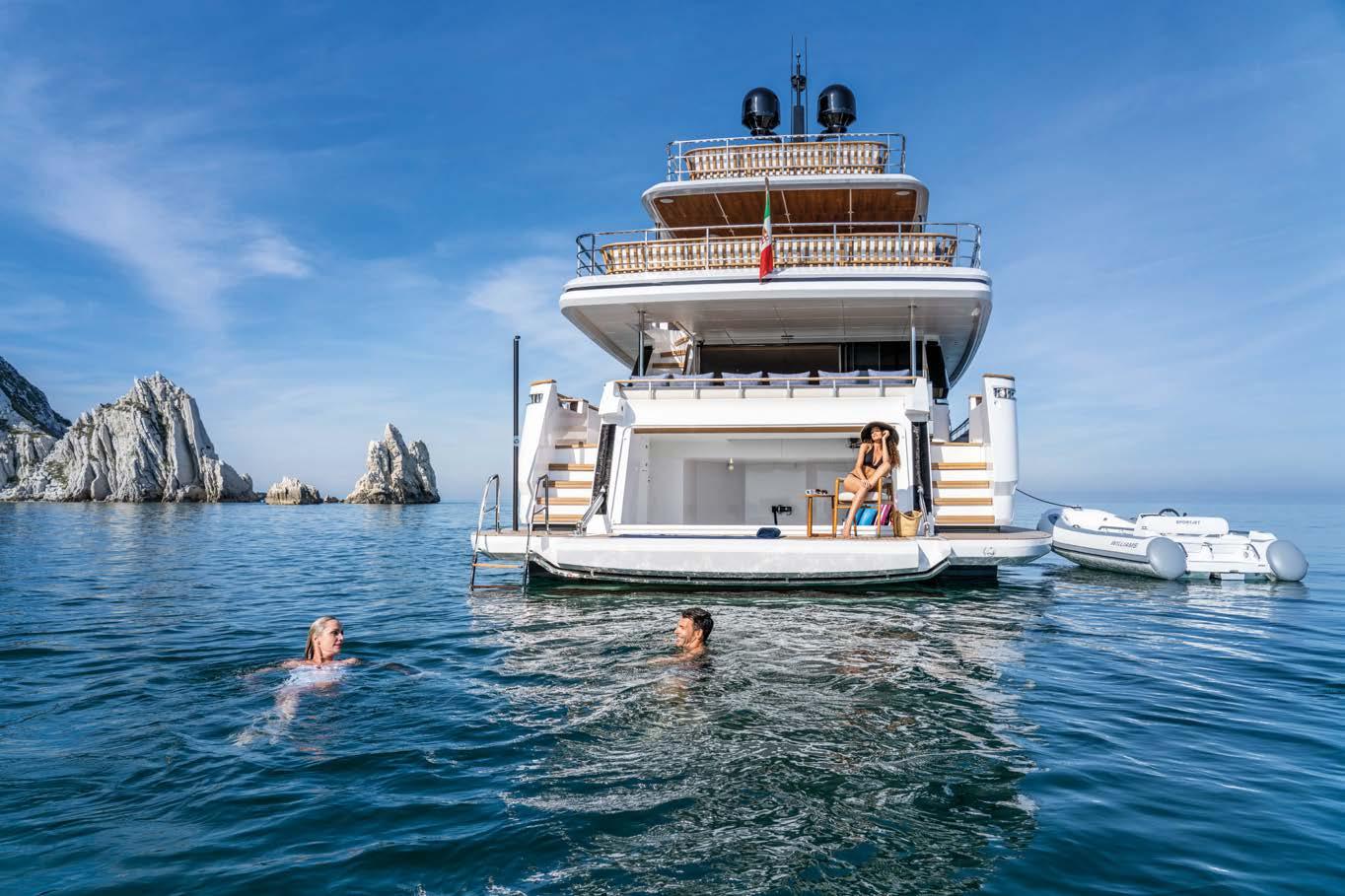
Come affronta RINA questo capitolo e quali servizi e certificazioni mirate offre ai protagonisti che operano in questo segmento dello yachting? “Il tema della sostenibilità è quello su cui si giocherà la competitività futura dei costruttori. Se è vero, infatti, che gli yacht, soprattutto quelli piccoli e medi, hanno meno l’obbligo del rispetto delle normative internazionali in relazione all’ S mission radin System , è vero anche che cresce la sensibilità, da parte del cliente che acquista il megayacht come strumento leisure, a dimostrare che non sta commissionando soltanto un’eccellenza sotto il profilo della performance, del comfort e del design, ma un prodotto che rappresenta un investimento sostenibile. I cantieri italiani si sono messi alla guida di soluzioni varie e altamente innovative, partendo

innanzitutto dall’utilizzo di materiali nuovi o riciclati e dal concepimento di scafi sempre pi efficienti nell’ottica del risparmio di combustibile. RINA ha il vantaggio di essersi dedicata al capitolo transizione energetica in settori diversi, dalle acciaierie ai primi treni a idrogeno e celle a combustibile, realizzando studi sulla possibilità di utilizzare miscele di idro eno e as naturale liquefatto e lavorando a tutti i sistemi industriali di cattura di CO2. Questo bagaglio di esperienza può essere convenientemente trasferito, con le dovute tare’ e verifiche tecniche, nel mondo marine, per procedere all’approvazione di fuel alternativi, con tutti li studi propedeutici all’utilizzo specifico a bordo di uno yacht, che chiaramente ha ingombri e necessità operative diverse da quelle di una nave passeggeri o porta container. Con i cantieri lavoriamo, pertanto, sia in relazione al metanolo come fonte alternativa sia all’idrogeno e fuel cell per l’alimentazione dei servizi ausiliari, ma anche a tutto l’efficientamento idrodinamico, di monitoraggio e diminuzione dei consumi
del condizionamento di bordo e, prima ancora, alla definizione delle best practices legate ai processi costruttivi. L’obiettivo è chiaro: migliorare l’impronta carbonica dei superyacht, sfruttando al meglio le competenze maturate negli altri settori dell’industria”.
Per quale motivo il tema della transizione energetica è strettamente legato a quello della digitalizzazione?
“Affinch la fase di transizione che stiamo vivendo possa definirsi concretamente sostenibile è opportuno agire contemporaneamente in prospettiva dual transition: quella relativa agli investimenti sui nuovi combustibili e quella legata all’importanza di monitorare e indirizzare, sulla base dei dati che si leggono dal comportamento della nave o dello yacht, le best practices operative che ci portino a risparmiare in termini di emissioni e non soltanto. Puntare sulla digitalizzazione si nifica, infatti, utilizzare sistemi che controllino e distribuiscano carichi elettrici e consumi nella maniera ottimale, facendo
lavorare la nave nella misura pi efficiente possibile. Impiegare risorse nei servizi digitali consente anche di risparmiare tempo ed energia. Basti pensare a tutte le grandi navi che, quando arrivano a destinazione, devono sostare per lungo tempo in rada, bruciando inutilmente combustibile, in attesa che il terminale le faccia entrare, o che magari predispongono una rotta che in base alle condizioni meteo marine incontrate le porta per un certo periodo ad avere mare molto mosso e venti contrari che obbligano poi a recuperare tempo, andando molto pi veloce, anzich pianificare un via io magari più lungo ma con la garanzia di una velocità costante. Questo per dire che anche gli aspetti propri del mondo mercantile, della scelta delle rotte, dell’eliminazione dei tempi morti legati alla presentazione dei registri e della documentazione nelle pratiche di entrata nei porti possono essere convenientemente gestite e presidiate in ottica sostenibile tramite efficaci sistemi di digitalizzazione. L’osservazione dei dati raccolti da parte di unit con profili operativi
diversi rappresenta inoltre uno storico di estrema utilità per andare a migliorare ulteriormente gli standard di progettazione e di operativit in chiave di efficienza e, quindi, consumi. cco perch la di italizzazione viene sempre associata alla transizione energetica: ci fa risparmiare attraverso il monitoraggio, che oltretutto può sfruttare gli algoritmi che, elaborati dall’intelligenza artificiale partendo dall’interpretazione dei dati raccolti, forniscono trend e suggerimenti alla parte operativa ma anche al design, per creare un loop di costante miglioramento ed efficientamento .
Paolo Moretti is a historical memory of the last 27 years of the multinational inspection, certification and engineering consultancy group, having started his career at RINA in 1997 and held positions of increasing responsibility until 2020, when he took up his current position as CEO of RINA Services, a company active in the marine and certification sectors. He, therefore, has an extensive professional curriculum vitae that has seen him both author and participant in the achievements of the last millennium in marine and certification services. A Naval and Maritime Engineering graduate from the University of Genoa, he joined RINA after completing his military service in the Navy. “My entry came at a time when the company, which at the time was active in ship certification, was amid internationalisation. It was going beyond national borders to follow customers and shipowners who were
increasingly building in Korea, China and apan. he first years of my career were spent in South Korea, where I followed the entire commercial shipbuilding process for Italian shipowners. Until 2010, we focused our strategic activities on international expansion, which was linked to our core services of classification and inspection of offshore platforms, with the openin of new offices in urope and America, the iddle ast, South ast Asia, orea, and Shanghai. However, with the start of the second decade came the era of diversification and engineering consultancy across all major market sectors, from infrastructure to industry. his included the acquisition of D’Appollonia - now RINA Consultingwhich brought great expertise in engineering consultancy, particularly in the energy, oil & gas and infrastructure sectors, and CSM. In this centre, the largest technologies for the domestic steel industry were developed over the years. In fact, throu h S entre for aterials evelopment, ed. , we won a uropean tender worth million for a six-year project that will lead to the design and construction of a ‘mini-steel plant’ that will experiment with hydrogen at every stage of the steel production cycle. We then proceeded with other important acquisitions, such as the dif roup, a ritish company with specific e pertise in the world of renewables, space and defence, and gradually with ‘purchases’ in certain targeted sectors, such as cybersecurity, which allowed us to expand our technical capacity in the field of providin di ital solutions dedicated to sustainability and
efficiency in marine operations, in particular with the Danish software house Logimatic Solutions, acquired in . he final piece of the international expansion plan across all business lines was the acquisition of the entire share capital of atric n ineerin , a Chicago-based company active in infrastructure, transport and renewable energy, at the beginning of 2023, which is now fully integrated into RINA Consulting”. A scenario dotted with strategic assets that boost an integrated growth aimed at enhancing the background of global competencies and specialisations. “It is the culmination of a journey that has led us to become a multinational group with more than 6,000 employees, active in inspection, certification and en ineerin consultancy on virtually every continent and in every major country in the world. We will end 2024 with a turnover of around €900 million and a projection for 2025 of more than €1 billion. uite different fi ures from when I oined, when we were around 500 colleagues, mostly Italians”. The achievement of this truly international character now allows us to face all the challenges of a technological and evolved world, such as the world of marine transport in general, with an increasing amount of science and conscience. There is no doubt, for example, that the issue of sustainable development of products, as well as production processes, up to and including the management of large yachts, is becoming increasingly urgent and rigorous. How does RINA address this issue, and what specific services

«Tramite il Centro Sviluppo Materiali abbiamo vinto un bando europeo del valore di 88 milioni di euro per un progetto della durata di sei anni, che si concretizzerà nella progettazione e realizzazione di una “mini acciaieria” che sperimenterà l’idrogeno in ogni fase del ciclo di produzione dell’acciaio».
«With CSM, we won a €88 million European tender for a six-year project to design and build a ‘mini-steel plant’ that will experiment with hydrogen at every stage of the steelmaking cycle».
and certifications does it offer to those involved in this segment of the yachting industry? “ he issue of sustainability is the one on which the future competitiveness of shipbuilders will be decided. While it is true that yachts, especially small and mediumsized ones, are less obliged to comply with international regulations relating to the S mission radin System , it is also true that there is a growing awareness on the part of the customer buying a mega yacht as a leisure tool to show that he is not only commissioning excellence in terms of performance, comfort and design but also a product that represents a sustainable investment. Italian shipyards have promoted several highly innovative solutions, starting with using new or recycled materials and desi nin increasin ly fuel efficient hulls. RINA has the advantage of having been involved in the energy transition in various sectors, from steelwor s to the first hydro en and fuel cell trains, carrying out studies on the possibility of using mixtures of hydro en and liquefied natural as and working on all industrial CO2 systems. his wealth of e perience can easily be transferred to the marine world, with the necessary ‘tares’ and technical checks to proceed with the approval of alternative fuels, with all the preparatory studies for specific use on board a yacht, which has different dimensions and operational needs from those of a passenger or container ship. We are therefore working with the shipyards both on methanol as an alternative source and on hydrogen and fuel cells to power auxiliary services, but also on hydrodynamic efficiency, on monitorin and reducing the consumption of air conditioning on board and, before that, on definin best practices in terms of construction processes. he aim is clear to improve the carbon footprint of superyachts by making the most of the expertise gained in other industry sectors”.
Why is the issue of energy transition so closely linked to digitisation? “For the transition we are currently experiencing to be defined as truly sustainable, it is necessary to act from a dual perspective: that of investing in new types of fuel, and that of the importance of monitoring and managing - based on the data that can be collected on the behaviour of the ship or yacht - the best operating practices that can help us save in terms of emissions and more. Going digital means using systems that better control and distribute loads and power consumption, allowing the vessel to operate as efficiently as possible. sin resources in digital services also saves time and energy.
«Con i cantieri lavoriamo sia in relazione al metanolo come fonte alternativa sia all’idrogeno e fuel cell per l’alimentazione dei servizi ausiliari, ma anche a tutto l e cientamento idrodinamico, di monitoraggio e diminuzione dei consumi del condizionamento di bordo e, prima ancora, alla defini ione delle best practices legate ai processi costruttivi».
«We are working with shipyards both on methanol as an alternative source and on hydrogen and fuel cells to power auxiliary services, as well as on hydrodynamic e ciency, monitoring and reducing the consumption of air conditioning systems on board, and, before that, on defining best practices for construction processes».
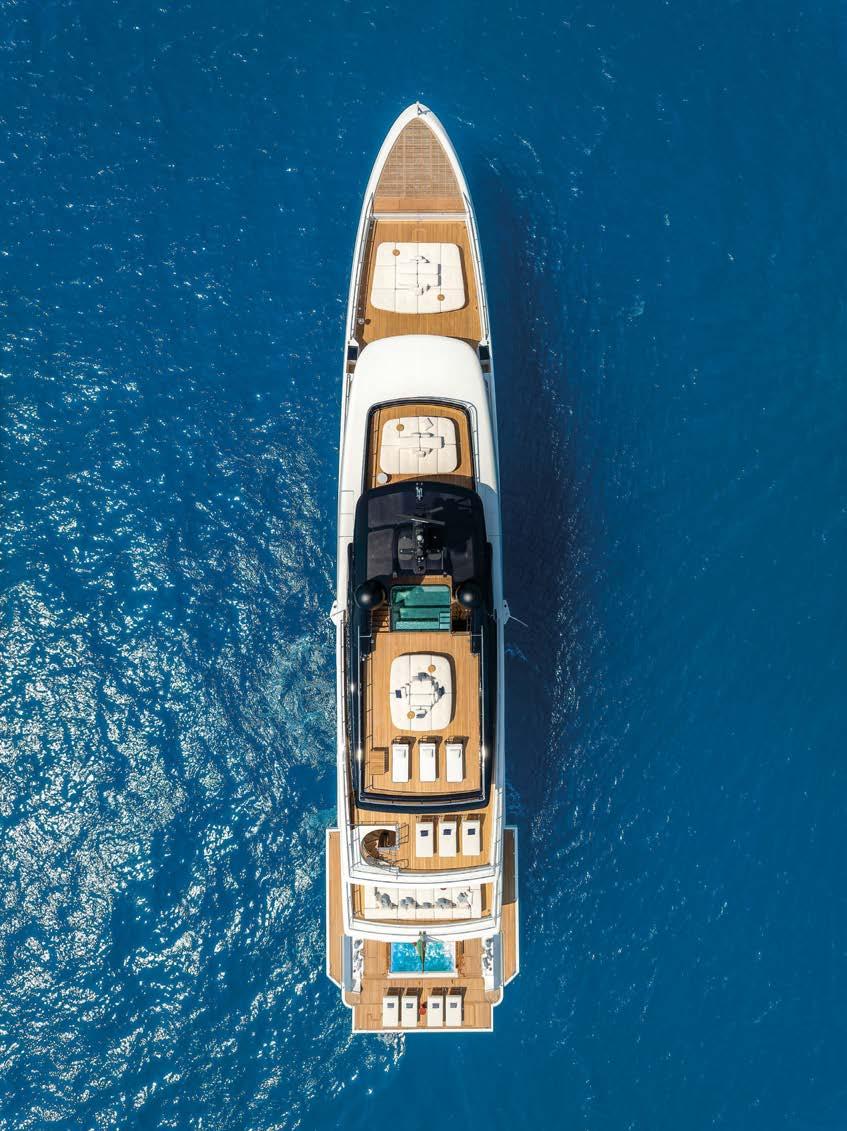

Consider the situation of large ships: when they arrive at their destination, they must stay at anchor for a long time, burning fuel unnecessarily, waiting for the terminal to allow them to enter.
In other cases, ships plan a route where they encounter unfavourable weather conditions that expose them to very rough seas or headwinds for a certain period, and this forces them to make up for lost time by sailing much faster later on, rather than planning a voyage that may be longer but where they are sure they can sail at a constant speed. his means that efficient digital systems can conveniently and sustainably handle even aspects related to the world of merchant shipping, such as route selection or the elimination of dead time related to the submission of logs and documentation in port entry procedures. Furthermore, when analysed by units with different operational profiles, the collected data can be a useful historical source for further improving design and operational standards in terms of efficiency and, thus, consumption. his is why di italisation is always associated with the energy transition: it saves us money through increased monitorin . he monitorin process can also use algorithms developed by artificial intelli ence to interpret data sets and provide trends and suggestions related to operations and design to create a continuous cycle of improvement and reater efficiency .
«Puntare sulla digitalizzazione significa utilizzare sistemi che controllino e distribuiscano carichi elettrici e consumi nella maniera ottimale, facendo lavorare la nave nella misura più efficiente possibile. Impiegare risorse nei servizi digitali consente anche di risparmiare tempo ed energia».
«Focusing on digitalisation means using systems that control and distribute electrical loads and consumption in the best possible way, allowing the ship to operate as e ciently as possible. Using resources for digital services also saves time and energy».

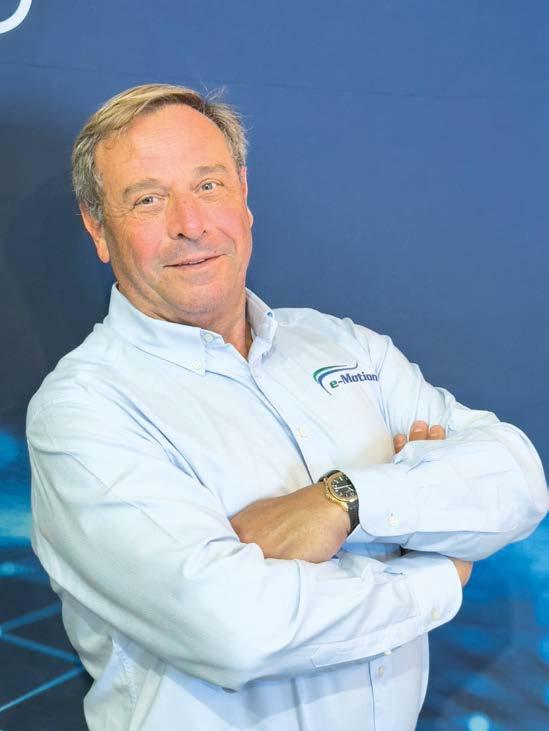
necessari per ottenere consensi e i risultati attesi. Il tema della mobilità sostenibile trova nella nautica da diporto la sua formula d’uso più comune nella propulsione promiscua o ibrida, fondata sull’azione commista diesel–elettrico e sul binomio green “riduzione inquinamento-riduzione richiesta energetica”. Tutto questo presuppone tuttavia una capacità sempre più elevata di autonomia delle batterie di bordo e di
MICHELE MAGGI, AMMINISTRATORE DELEGATO DI E-MOTION HYBRID, PROPONE SISTEMI IBRIDI STANDARDIZZATI PER SALE MACCHINE E MOTORI GIÀ ESISTENTI A BORDO DI YACHT DAI 12 AI 76 METRI
MICHELE MAGGI, THE CEO OF E-MOTION HYBRID, IS OFFERING STANDARDISED HYBRID SYSTEMS FOR ENGINE ROOMS AND EXISTING MOTORS ONBOARD YACHTS FROM 12 TO 76 METRES
by Sacha Giannini
densità raggiungibile per un full electric davvero da best range cruising! Se a bordo la quantità, lo spazio e i pesi sono spesso nemici di stabilità e planata, le attuali batterie al litio Li-ion che è possibile imbarcare a bordo senza compromettere prestazioni d’assetto, garantiscono un’autonomia “dislocante” media in electric mode di 15, 20 o al massimo 30 miglia, con velocità contenute in ogni caso entro i 10 kts. Medie tuttavia adatte a molti programmi di navigazione, perfette per manovrare in porto o navigare sotto costa senza lasciare in sospensione scie di idrocarburi, fumi o decibel, ma per
macinare miglia, rincorrendo SOG e LOG con i tempi frenetici dell’evasione dalla vita di tutti i giorni, queste lente e silenziose andature, ad alcuni proprio non si confanno. Se per “dislocare” in elettrico a 8 nodi un cabinato di 10 tonnellate servono almeno 100 kWh (pari a circa 150 cavalli termici) con migliaia di euro di batterie al seguito, per planare a 20 nodi servono enormi uscite di potenza di almeno 1.000 kWh, con diverse tonnellate di accumulatori in sentina. Immaginiamo allora quanto peso e costi aggiuntivi servirebbero per avere un’ora di autonomia in planata per un range tuttavia sempre di 20 miglia!


Un sistema ibrido parallelo e-Motion, montato di serie o in retrofit, garantisce inoltre un incremento del valore dell’usato per diventare l’anello mancante tra la rottamazione e il nuovo. Se la sostenibilità trova nel recupero , nella ri ualificazione dell’esistente la sua spinta ideologica ed ecologica, anche i fondi statali messi a disposizione per elettrificare la nautica da diporto, gli incentivi promessi dalla “transizione” per la rottamazione e il retrofit potrebbero alimentare nuove soluzioni e-Motion per allargarsi verso confini ancora inesplorati, incrementando decreti attuativi, bonus e tanti buoni propositi.
A hybrid parallel e-Motion system, as standard or as a retrofit, also means increasing the value of second-hand equipment and is the missing link between scrapping and buying new. Sustainability finds its ideological and ecological impulse from recovering and reusing what already exists. However, government funds for electrifying yachting and transition incentives for scrapping and retrofitting can drive new e-motion solutions to unexplored areas, with more administrative decrees, bonuses, and many good resolutions.
La propulsione ibrida rappresenta oggi la vera transizione per sviluppare le coscienze ma anche le densità richieste dai nuovi accumulatori di bordo, necessarie per percorrere centinaia di miglia a zero emission in completa autonomia.
La propulsione elettrica a bordo oggi è ancora riservata a chi non ha molta fretta e vuole muoversi tra scelte responsabili e rispettose dell’ambiente. Solo quando le batterie costeranno meno di 100 euro per kWh e avranno densità ben maggiori di adesso, la barca sarà forse pronta ad essere davvero elettrica per tutti e soddisfare pesi, autonomie e velocità. Per adesso la formula mista dell’Hybrid è la soluzione più adatta per aprire un nuovo capitolo nella storia della motorizzazione nautica, consentendo sia lunghi trasferimenti in diesel sia piccoli “eco” cabotaggi costieri e silenziose soste in rada in full electric & hotel load! Con poca velocità ma con una resa immediata, una coppia massima già a pochi giri e riprese fulminee, la propulsione zero emission mantiene uida e potente la manovra, proprio lì dove l’endotermico soffre maggiormente, tra avviamenti a freddo, bassi regimi, fumosità, frastuoni e combustioni.
Per definire oggi la “qualità” di un prodotto bisogna riconoscere anche la capacità di adattarsi e interagire con diverse funzioni e forze congiunte esistenti, in una fusione ibrida di soluzioni per soddisfare prestazioni,
Hybrid propulsion currently represents the transition to developing awareness. Still, another important factor is the density of onboard storage devices, which are needed to cover hundreds of miles with zero emissions and without additional support.
armatori e produttori. Michele Maggi già da tempo ha capito l’importanza della produzione seriale adattiva per trasformare, convertire e miscelare nafta con volt, litri con kW, decibel termodinamici con i nuovi e silenziosi “sound” elettromagnetici di bordo. Maggi conosce bene il mercato e tutti i componenti dei motori marini diesel, ma anche le abitudini degli armatori, dei clienti e soprattutto le manovre di uno yacht che possono essere svolte anche in modalità elettrica, risparmiando carburante ed emissioni di gas serra. Tramite un kit di ibridizzazione, di conversione, ingegnerizza l’integrazione di un motore elettrico, interposto tra volano e trasmissione, da applicare alla maggior parte dei propulsori in commercio (Yanmar, Man, Mtu, Volvo…), in un “retrofit energetico” davvero essibile e sostenibile. Restituisce così una seconda vita, “parallela” alla combustione, con una riqualificazione d’uso a 3 modalità di servizio: elettrica, ibrida o diesel. L’e-Motion Parallel Hybrid system è un sistema molto compatto formato dal motore diesel principale con relativa trasmissione, un generatore a giri variabili con all’interno un inverter integrato, un alternatore con magneti permanenti, un motore elettrico da 50 kW a 240 kW con o senza frizione elettromagnetica, un pacco batterie al litio, un sofisticato software dedicato alla gestione e diversi pannelli di controllo.
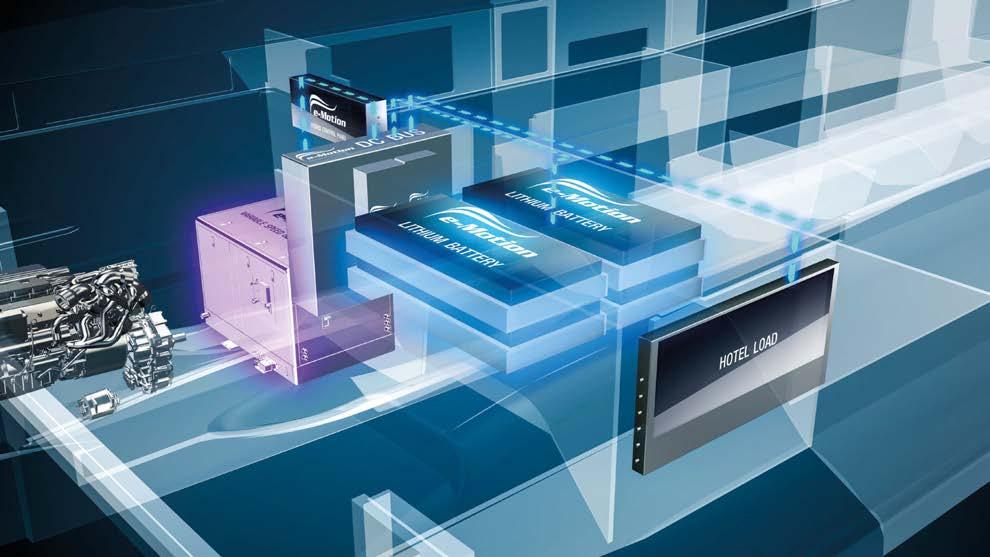
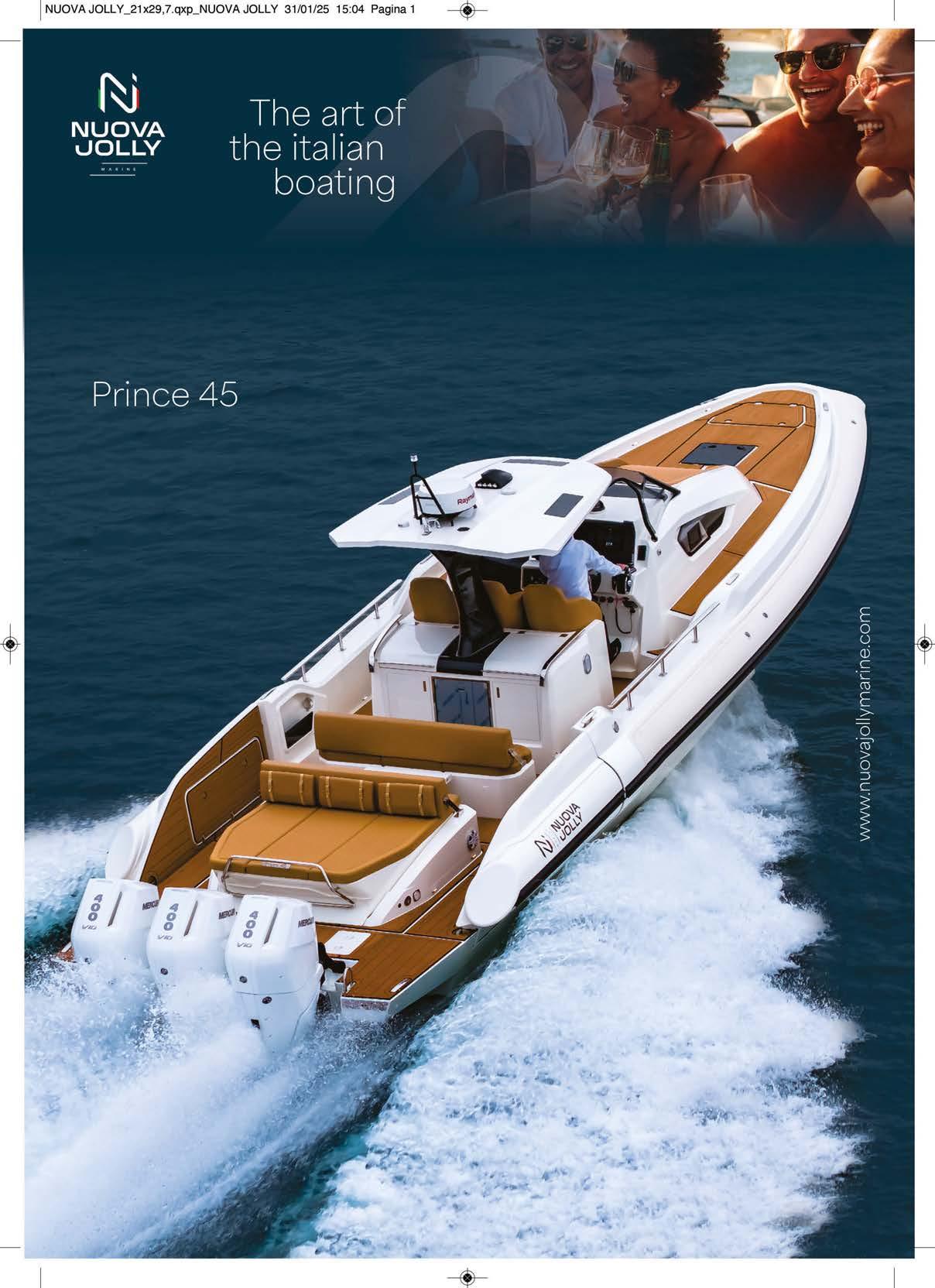
La propulsione ibrida rappresenta oggi la vera transizione per sviluppare le coscienze ma anche le densità richieste dai nuovi accumulatori di bordo, necessarie per percorrere centinaia di miglia a zero emission in completa autonomia. Useremo probabilmente batterie deep cycle agli ioni di sodio, di zolfo o di ossigeno, forse tutte allo stato solido, con anodi in grafite e celle polimeriche derivate dalle resine, saranno sicuramente riciclate dall’usato automotive ma soprattutto si ricaricheranno in pochi minuti per durare veramente molto più a lungo. Il futuro sarà dunque nella rigenerazione e nella capacità conservativa dell’energia ma anche nella difesa dei luoghi d’estrazione e produzione per poter realizzare queste nuove batterie, salvaguardando non solo le vecchie salamoie del Cile, le miniere dell’Australia o del Donbass in Ucraina ma garantendo autonomia e comfort di bordo in modo davvero sostenibile.
Hybrid propulsion currently represents the transition to developing awareness. Still, another important factor is the density of onboard storage devices, which are needed to cover hundreds of miles with zero emissions and without additional support. We will probably use deep cycle sodium ion, sulphur ion or oxygen ion batteries, all perhaps in solid state, with graphite anodes and poly cells made from resin. They will be recycled from automobiles but recharge in just a few minutes and last much longer. The future thus lies in regenerating and the ability to conserve energy, as well as in protecting the places they are extracted from and produced to make these new batteries. That means we don’t just protect the old hilean brine fields, the ustralian mines or those in Donbas in Ukraine but also ensure that we get range and onboard comfort in a truly sustainable way.

Maggi miniaturizza tutti questi componenti senza modificare i volumi delle sale macchine e senza stravolgere le configurazioni e i basamenti dei motori esistenti sui quali applicare il “retrofit”. L’ibrido seriale consente potenze maggiori fino anche a 0 kW ma viene eliminato del tutto il motore principale endotermico. Un gen-set a giri variabili alimenta “da remoto” uno o più motori elettrici direttamente collegati alla trasmissione meccanica e alle eliche, oltre che alimentare i principali servizi elettrici di bordo. Con l’e-Motion Parallel Hybrid system è possibile scegliere una partenza dal porto o dall’ancoraggio totalmente elettrica e silenziosa o una navigazione a medio raggio a zero emissioni fino a trasformarla in un trasferimento a lungo raggio in modalità ibrida diesel elettrica con il solo azionamento di un tasto. Il sistema promette riduzioni del consumo di carburante fino al 30% in modalità Economy rispetto alla tradizionale propulsione e una manutenzione standard limitata all’ordinario. Inoltre la tecnologia a magneti permanenti dei motori elettrici e degli alternatori consente, a richiesta, anche molta potenza.
Quality is among the most soughtafter values for competing and developing the “services” offered. Culture, innovation, research, partnership and sustainability are the necessary supports and allies to achieve consensus and the expected results. Sustainable mobility is most commonly seen in the yachting world using mixed or hybrid propulsion based on a dieselelectric combination and eco-friendly coupling to reduce pollution by reducing the energy required. However, all of that assumes increases in onboard battery life and attainable density for a good range, genuine full-electric cruising experience. Volumes, amount and weight are often the enemies of stability and gliding. Currently, the Li-ion lithium batteries, which you can take on board without compromising trim and performance, ensure a displacement mode average range using ust electric power of 15, 20 or at most 30 nautical miles, within all cases speeds of 10 knots or below. Those averages suit many types of usage, such as manoeuvring around the harbour or off the coast without fuel, smoke or noise trailing behind you. However, in these frenetic times when you try to
escape from everyday life, if you have to grind out long distances with your mind on the SOG and log, slow and silent speeds like this don’t work for some people. Moving a ten-tonne cabin cruiser in displacement mode at eight knots requires at least 100 kWh of electric power equal to 150 thermal horsepower , with batteries costing thousands of euros. hile to plane at 20 knots, you need enormous amounts of energy, at least 1,000 kWh, with several tonnes of batteries below. e should then consider how much weight and additional outlay would be required to stay on the plane for an hour while covering only twenty miles Onboard electric propulsion is nowadays the preserve of those who aren’t in a hurry and who want to behave in a way that is responsible and respects the environment. hen batteries cost less than 100 euros per kWh and have much greater density, boats will be ready to become electric for everybody and meet their weight, range, and speed requirements. The mixed hybrid formula is the most suitable solution for opening up a new chapter in the history of nautical motorisation. It allows long diesel-powered ourneys, small eco-friendly trips along the coast, and noise-free stops at anchor with the hotel load handled in full electricity. The speed may not be great, but it reacts immediately, with full torque at zero rpm and lightning acceleration. The zero-emission propulsion keeps the manoeuvrability uid and powerful. In contrast, conventional engines work worst being started when cold and at low rev levels, they can be noisy and smoky when firing. Nowadays, to define a product’s quality, you must also recognise its capacity to adapt and interact with various existing functions and combinations of forces in a hybrid fusion of solutions that meet performance requirements and the demands of buyers and yards.
Michele Maggi has understood the importance of adaptive serial production to transform, convert and mix fuel oil with volts, litres with kilowatts, and thermodynamic decibels with the new and silent electromagnetic onboard “sounds”. Maggi knows the market and all of the components of diesel marine engines, but he also knows buyers and how they behave once they have bought a boat. And above all, he knows everything a yacht can do in electric mode to save fuel and greenhouse

Con il sistema Ibrido Parallelo e-Motion il motore a combustione interagisce con quello elettrico in modo simultaneo, perché connesso direttamente alla linea d’asse, al pod-drive o al sail-drive, attraverso una frizione di accoppiamento opzionale che gestisce il funzionamento e l’interazione. Il motore a combustione ha sempre potenza predominante ed il motore elettrico ha la sola funzione di sostituirlo o supportarlo nelle diverse modalità previste:
• navigazione diesel/elettrico con motori spenti, generatori accesi e motori elettrici attivi.
• navigazione a zero emissioni con solo propulsione elettrica e assorbimento dalle batterie.
• navigazione economy con entrambi gli assi in funzione: un motore diesel acceso che produce anche corrente ed un motore elettrico sul secondo asse. Generatori spenti.
• modalità power boost con entrambi i motori, elettrici e diesel, che lavorano contemporaneamente per avere più spinta fino al 25 in pi .
• modalità fast charge con i generatori a giri variabili che operano ad alti giri per produrre l’energia necessaria a ricaricare le batterie al 90 in solo 30 minuti per le esigenze dell’hotel load, anche in folle in rada.
With the Parallel Hybrid e-Motion system, the combustion engine simultaneously interacts with the electric one because it is directly connected to the shaft line, pod drive, or sail drive, using an optional coupling clutch that handles the working and interaction. The combustion engine always plays the more significant role, and the electric motor only has to replace or support it in the various modes:
• diesel/electric travel mode with engines turned off, generators on and electric motors running.
• zero-emission travel mode with just electric propulsion and absorption from the batteries.
• economy travel mode with both axes working: a diesel engine producing electric current and an electric motor on the second a is. The generators are off.
• power boost mode with diesel and electric engines, working simultaneously to get up to 25% extra thrust.
• fast charge mode with variable speed generators that work at high rpm levels to produce the energy required to get batteries up to 90% in just 30 minutes to meet hotel load needs, even when in neutral and at anchor.
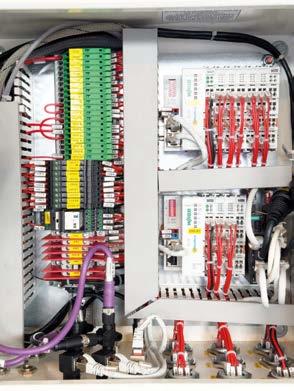

gas emissions. Using a hybridisation conversion kit, he has engineered the integration of an electric motor that sits between the ywheel and transmission and can be fitted to most of the engines currently being sold (Yanmar, MAN, MTU, Volvo . These energy retrofits are exible and sustainable and thus give a second parallel life to combustion engines, giving them three usage modes: electric, hybrid and diesel. The e-Motion Parallel Hybrid system is very compact. It consists of a main diesel motor and its transmission, a variable speed generator with integrated inverter, an alternator with permanent magnets, a 50 to 240 kW electric motor, with or without electromagnetic clutch, a lithium battery pack, sophisticated control software, and various control panels. Maggi has miniaturised all these components so that engine rooms don’t have to be enlarged without mixing up the configurations and crankcases of the engines undergoing the retrofit. Hybrid serial means you can have greater power, up to 960 kW, but the main endothermic engine is eliminated. A variable speed genset fed “remotely” by one or more electric motors is directly linked to the mechanical transmission system and the propellers and runs the main onboard electric-powered services. With the e-Motion Parallel Hybrid system, you can get the choice of leaving the harbour or your anchorage silently, using just electric power, or you can make a medium-range trip with zero emissions, and by using the hybrid diesel-electric mode, you can extend that into a longer trip just by pressing a button. The system promises reductions in fuel use of up to 30% (in economy mode) compared to traditional propulsion, and standard maintenance is required. Additionally, this technology uses permanent magnets on electric motors and alternators to deliver a lot of power.

IL SUCCESSO HA SEMPRE UNA SPIEGAZIONE, MA ANCHE DEGLI INTERPRETI. CARLO BREVINI DA CINQUE ANNI È IL GENERALE DELL’ESERCITO GARMIN E CI HA RACCONTATO QUALI SONO LE BATTAGLIE CHE HA VINTO SUCCESS ALWAYS HAS AN EXPLANATION, BUT IT ALSO HAS AN INTERPRETER. CARLO BREVINI HAS BEEN THE GENERAL OF THE GARMIN ARMY FOR FIVE YEARS AND TELLS US ABOUT THE BATTLES HE HAS WON
by Niccolò Volp i



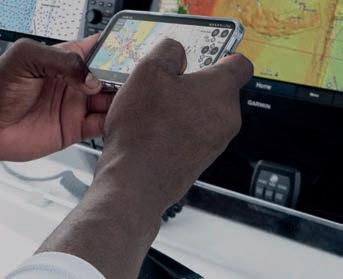
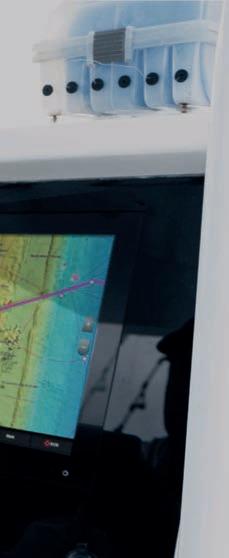




Dinome fa Carlo e non Cesare e la sua impresa è stata meno fulminea di quella dell’imperatore romano, e, per fortuna, meno cruenta. Carlo Brevini da cinque anni è responsabile del settore Marine di Garmin. Da quando ricopre questa carica, il fatturato è sempre cresciuto; nell’ultimo anno addirittura a doppia cifra e le previsioni per il 2025 sono altrettanto positive. “Non è tutto merito mio – si schermisce – ma di un’azienda che non ne sbaglia una” Garmin ha capito per tempo che le acquisizioni rappresentano un elemento fondamentale per poter offrire ai cantieri un pacchetto sempre più completo di prodotti. Dopo Fusion, azienda leader nell’entertainment è arrivata L Audio per la diffusione del suono a bordo, e l’ultima in termini di tempo, è Lumishore che produce luci a Led per interni, coperta e subacquee. Al contempo, non
«L’azienda a livello globale ha un numero elevato di ingegneri e quando servono risorse per sviluppare un nuovo prodotto nel settore marino, è in grado di destinarne una buona percentuale di questi ingegneri proprio per sviluppare un nuovo prodotto o un nuovo software».
ha dimenticato che una fetta significativa dei suoi clienti sono pescatori e diportisti che cercano un prodotto stand alone e plug play. Il ventaglio della clientela è ampio, si va dall’appassionato di pesca al comandante o armatore di un super yacht. Garmin opera in cinque diversi settori: oltre al marino ci sono sport, automotive, aviazione e outdoor. “Per me sono una medaglia da appuntarsi al petto. L’integrazione si fa anche con altri settori, è questa la forza di Garmin. L’azienda a livello globale ha un numero elevato di ingegneri e quando servono risorse per sviluppare un nuovo prodotto nel settore marino, è in grado di destinarne una buona percentuale di questi ingegneri proprio per sviluppare un nuovo prodotto o un nuovo software”, afferma Brevini. Ed è bene non dimenticarsi che un’azienda che ha sette miliardi di fatturato, ha certamente le risorse necessarie per investire in
«The company globally has a large number of engineers, and when resources are needed to develop a new product in the marine sector, it can allocate a good percentage of these engineers precisely to create a new product or software».
ricerca e sviluppo. Questo le consente di non rallentare mai. “I nostri ingegneri hanno una visione che arriva fino a otto o dieci anni in avanti. È il loro compito, studiare, progettare e immaginarsi quale possa essere lo sviluppo futuro dell’elettronica e dell’integrazione a bordo. Non dobbiamo rincorrere una tendenza, ma prevederla e anticiparla”. Per riuscirci, c’è un costante scambio, anche tra diversi settori. Non è un segreto che molte innovazioni arrivino dall’automotive e quindi un’azienda che opera anche in questo settore ha indubbiamente un vantaggio. I primi esempi che mi vengono in mente sono due l’autorouting, cioè il sistema che permette al plotter di tracciare una rotta evitando gli ostacoli e, grazie all’integrazione, di condividere questa rotta con il pilota automatico; e il segnale acustico che si attiva mentre ci si avvicina di poppa in banchina. È del tutto simile al cicalino che si vede sul display di un’auto quando si parcheggia in retromarcia ed è ovvio che proprio questa similitudine contribuisce a rendere friendly le manovre di ormeggio. Oggi Garmin ha una gamma davvero vasta di prodotti, da quelli cosiddetti consumer ai sistemi integrati più complessi. È diverso il cliente, diversa la distribuzione e quindi anche diverso il servizio post vendita. “Per avere successo, oltre a un prodotto all’avanguardia e di qualità e a un buon marketing, servono i servizi.

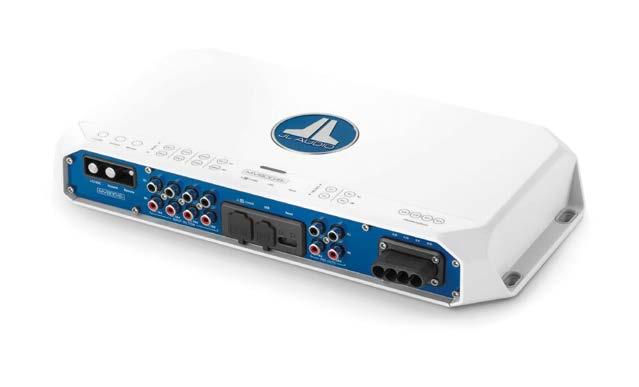
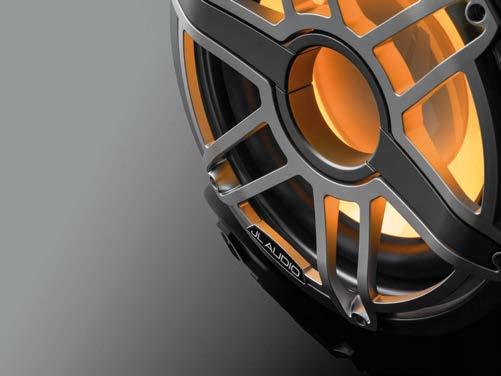


Paesi remoti, tutto parte da qui e questo ci consente di rispondere alle urgenze”
Anche l’assistenza è centralizzata ed umana, non artificiale. I clienti sono molto diversi tra loro e la nautica è molto varia. Impossibile pensare a risponditori automatici o intelligenza artificiale. Garmin ha appena inaugurato la sua nuova sede. Una palazzina intera nella quale un piano è occupato dal settore marino e tra le persone che ci lavorano, ce ne sono alcune dedicate all’assistenza che ascoltano quali sono i problemi, le urgenze e trovano la soluzione per risolverli nel più breve tempo possibile. Ovviamente questo servizio è attivo anche durante l’estate. Le chiamate arrivano dai consumatori, dagli installatori, dai distributori e dai cantieri e, inevitabilmente, anche dagli armatori. Il personale è molto qualificato e in continuo aggiornamento, dato che i sistemi integrati più complessi possono necessitare di soluzioni complesse. Non c’è quasi niente di standardizzato, ma solo soluzioni personalizzate. In fondo, la ricetta del successo non è un segreto. I prodotti devono essere di qualità, la gamma ampia, la ricerca e l’innovazione continue e, infine, l’assistenza capillare ed efficace. Niente di nuovo, ma bisogna
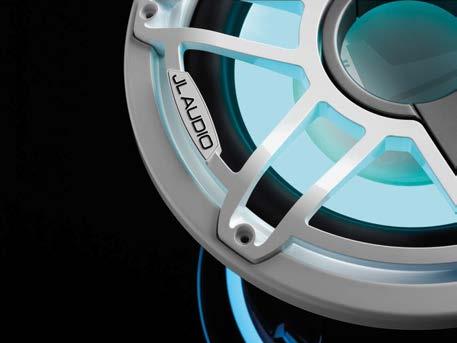

che tutte queste cose funzionino alla perfezione. E la storia ci insegna che tutte le battaglie per essere vinte hanno bisogno di un condottiero.
His name is Carlo, not Cesare, and his achievement was less lightningfast than the Roman emperor’s and, thankfully, less bloody. Carlo Brevini has been head of Garmin’s marine division for five years. Since he took over, sales have grown steadily, with double-digit growth last year, and forecasts for 2025 are equally optimistic. “It’s not all down to me; it’s down to a company that doesn’t make mistakes”. Garmin realised early on that acquisitions were a key element in offering yards an increasingly complete package of products. After Fusion, a
leading entertainment company, came L Audio for onboard sound distribution, and the most recent is Lumishore, which makes LED lights for interior, deck and underwater use. At the same time, it has not forgotten that many of its customers are fishermen and yachtsmen looking for a stand-alone, plug-and-play product. The customer base is broad, ranging from the fishing enthusiast to the captain or owner of a super yacht. Garmin operates in five sectors marine, sports, automotive, aviation and outdoor. “I believe they are a medal to be pinned on the chest. Integration with other sectors is also a strength of Garmin. The company has a large number of engineers around the world. When resources are needed to develop a new product in the marine sector, it can
Navionics, Fusion, EmpirBus, JL Audio e più recentemente Lumishore. Garmin ha acquisito molte aziende e non sembra aver intenzione di smettere. Oltre al marino, i settori coperti dai suoi prodotti sono: automotive, outdoor, sport fitness e aeronautica. Inoltre, da anni, agli strumenti elettronici, ha a ancato anche la produzione di smartwatch. Il fatturato del 2024 per il settore marino di Garmin Italia è cresciuto di oltre il 10% e le previsioni per il prossimo anno sono le stesse. Sono cinque anni che il fatturato cresce. La nuova sede di Milano è un’intera palazzina di 5.000 m2 di u ci. Ci lavorano 76 persone, ma è previsto che arrivino a 130 nel prossimo futuro.
Navionics, Fusion, EmpirBus, JL Audio and, most recently, Lumishore. Garmin has acquired many companies and seems to have no intention of stopping. In addition to marine, its products cover the automotive, outdoor, sports fitness and aviation sectors. It has also been producing smartwatches for years. Garmin Italia’s marine sales grew by more than 10% in 2024, and the forecast for next year is the same. Sales have been growing for five years. The new headquarters in Milan is an entire 5,000 m2 o ce building. It employs 76 people, which is expected to rise to 130 shortly.
allocate a good percentage of those engineers to develop a new product or software”, says Brevini. And don’t forget that a company with a turnover of seven billion certainly has the resources to invest in research and development. So it never slows down. “Our engineers have a vision of up to eight or ten years ahead. Their job is to study, design and imagine the future development of electronics and on-board integration. We must not chase a trend but predict and anticipate it”. To achieve this, there is a constant exchange between different sectors. It’s no secret that many innovations come from the automotive industry, so an active company in this sector undoubtedly has an advantage. The first examples that come to mind are two auto-routing, the system that allows the Chartplotter to plot a route that avoids obstacles and, thanks to integration, to share this route with the autopilot, and the acoustic signal that is activated when you approach the stern of the dock. It is very similar to the buzzer you hear on a car display when you reverse into a parking space, and it is clear that this similarity contributes to friendly mooring manoeuvres. Today, Garmin has a wide range of products, from consumer products to more complex integrated systems. The customer and distribution are different, and so is the after-sales service. “To be successful, you need services, a modern, high-quality product, and good marketing.
Services raise the bar. And service means fast delivery and service. We have a warehouse in Milan that can ship any product anywhere in Italy within 24 hours. We don’t ship from distant countries; everything starts from here, allowing us to respond to emergencies”. Support is also centralised and human, not artificial. Customers are very different, and the boating industry is very diverse. It is impossible to think of automatic responders or artificial intelligence. Garmin ust opened its new headquarters. A whole building, one oor of which is dedicated to the marine sector, and among the people who work there are some dedicated to support, listening to the problems, the urgencies, and finding a solution to resolve them as quickly as possible. Of course, this service is also active during the summer. Calls are received from consumers, installers, distributors, shipyards and, inevitably, shipowners. The staff is highly qualified and constantly updated, as the most complex integrated systems can require complex solutions. There is almost nothing standardised, only customised solutions. The recipe for success is no secret. The products must be of high quality, the range must be broad, research and innovation must be continuous and, finally, widespread and practical support. Nothing is new there, but all these things have to work perfectly. And history teaches us that all battles need a leader to be won.
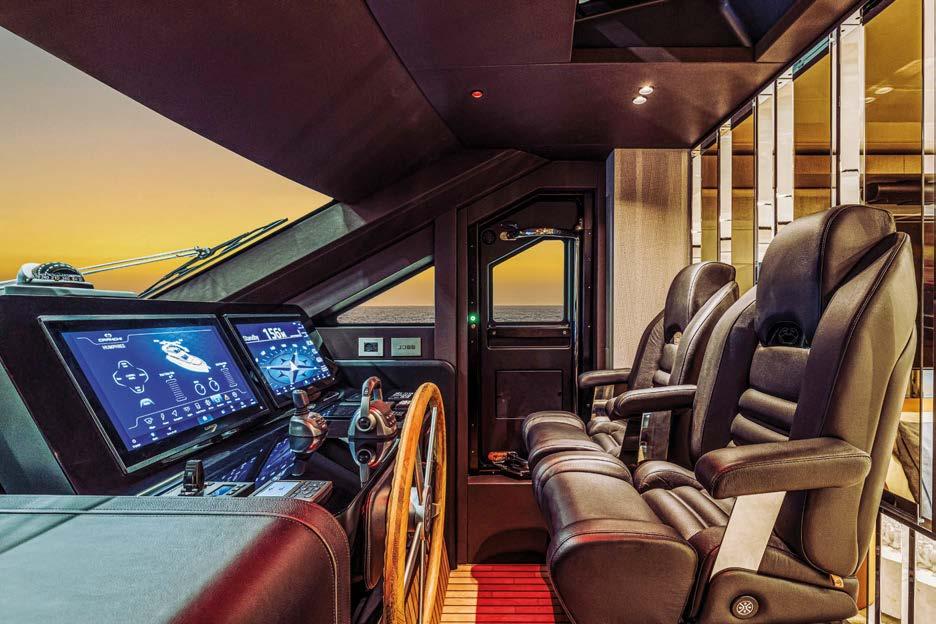
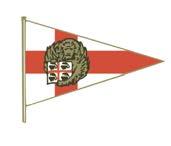
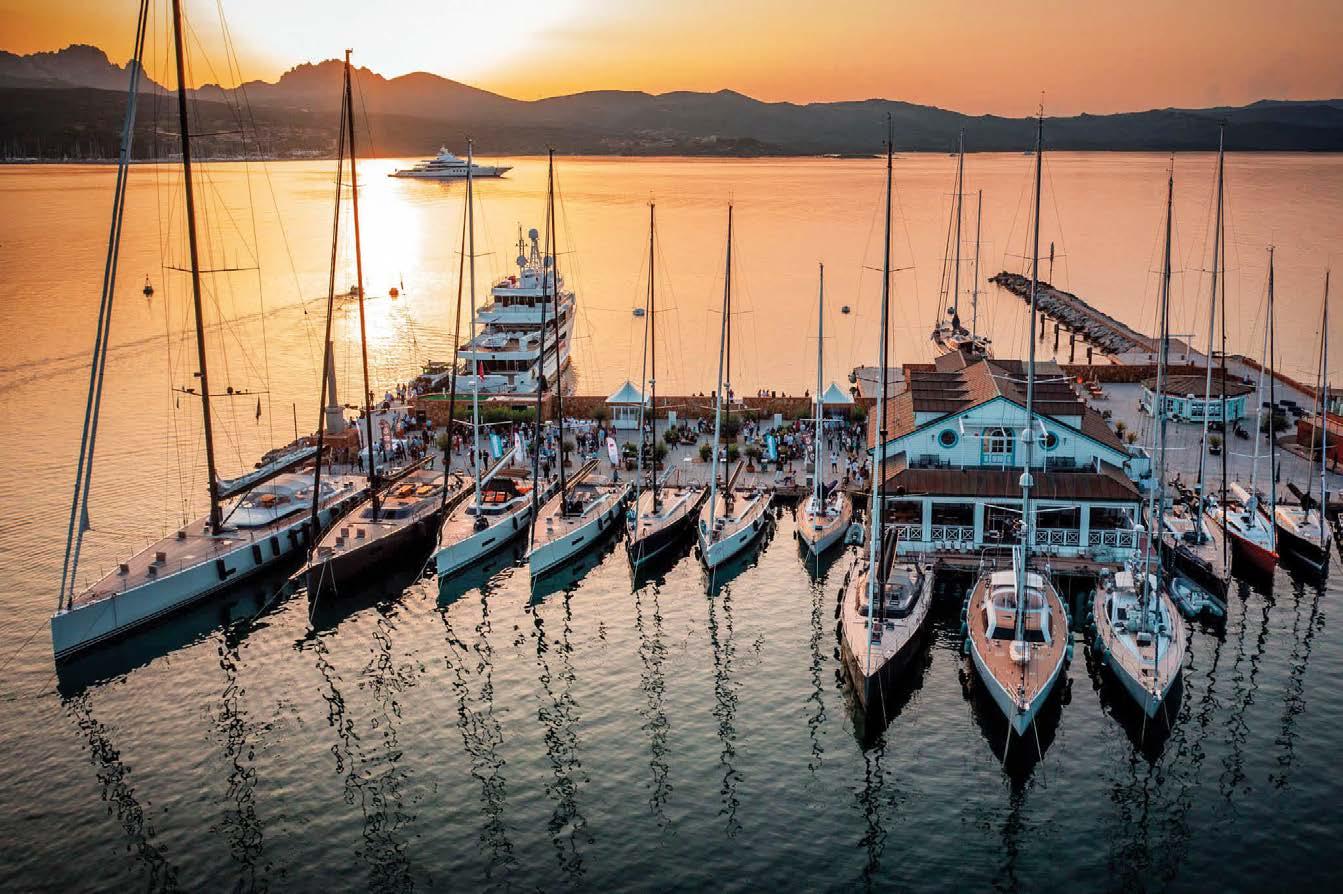
P.zza Yacht Club Porto Rotondo 1 Porto Rotondo, Sardinia +39 0789 34010 - info@ycpr.it www.ycpr.it

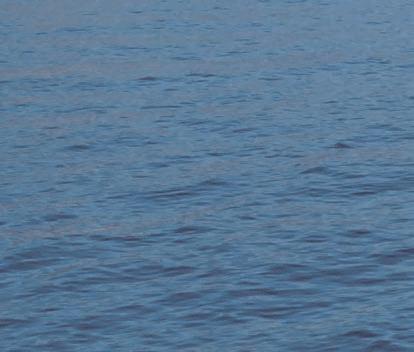


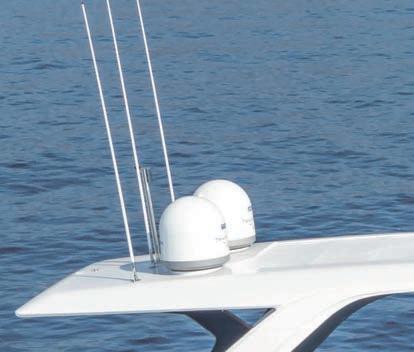




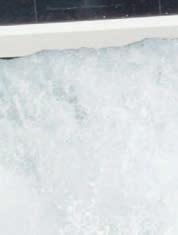







by Niccolò Volp i
Unabarca che poggia su solide basi. Quali sono queste basi? Il precedente Ferretti 670 è stato presentato nel 2017 e in sette anni ne sono stati realizzati ben 50 esemplari. Un modello di successo, senza ombra di dubbio. Il cantiere ha deciso perciò di realizzare un restyling, mantenendo invariata la carena e intervenendo solamente sul design delle linee esterne. L’aspetto è quello di uno yacht più filante e sportivo, meno appesantito dalla struttura del y. Il lavoro di Filippo Salvetti si è concentrato, oltre che sulle linee, nelle finestrature sulle fiancate e nelle aperture sulle falchette, cioè al di sotto della battagliola. L’obiettivo è quello di aumentare la vista verso l’esterno rimuovendo la maggior parte di ostacoli possibili e quindi più finestrature e più superficie aperte, a beneficio di un rapporto più diretto con il mare. È una sensazione che si percepisce osservando la barca dalla banchina, ma soprattutto quando ci si trova a bordo. La vista verso l’esterno è indubbiamente ampliata rispetto alla versione del 2017, dagli interni, ma anche dai passavanti laterali. È un lavoro molto ben riuscito perché non si ha la sensazione di uno yacht che è stato bucato il più possibile per obl , finestrature e aperture, ma gli interventi che sono stati fatti, non solo sono equilibrati, ma anche all’altezza giusta. Ogni volta che, da bordo, guardo verso l’esterno, sia che mi trovi sul ponte principale, sia nell’area notte del ponte inferiore o che mi trovi in pozzetto o percorrendo i passavanti laterali, riesco a vedere il mare. Il y è stato alleggerito grazie a una costruzione di vetroresina sottovuoto e carbonio. L’effetto, più che nel peso complessivo dell’imbarcazione, si vede nell’assetto in navigazione. Il dislocamento, infatti, è aumentato di due tonnellate rispetto alla versione precedente. Dalla postazione del y, così come da quella interna, la visibilità è perfetta. Non ci sono montanti nel parabrezza e nemmeno per l’hardtop sul y. O meglio, i montanti ci sono ovviamente, ma non sono di ostacolo alla vista di chi sta al timone. Il passaggio sull’onda è particolarmente morbido. La sensazione è che la V di prua la fenda a dovere e poi il peso dello scafo contribuisca a spianare la superficie del mare. Ed è una sensazione che ho sia con il mezzo metro di onda ripida che ho incontrato fuori dalla diga foranea di Cannes, ma anche

attraversando le onde di scia delle navi in transito. La manovrabilità e la capacità di stringere la virata sono notevoli, soprattutto in considerazione del fatto che la trasmissione è una linea d’asse tradizionale. A bordo ci sono due Seakeeper attivi, gli interceptor di Zipwake e il joystick di Xenta, cioè tutti gli aiuti che si possono desiderare. In ogni caso la sensazione è quella di una carena equilibrata, facile da condurre, che non fa fatica a trovare l’assetto e a mantenerlo. Così come non fa fatica a mantenere la planata minima che raggiungo a 13 nodi e meno di 130 litri/ora complessivi. I motori sono due Man V8 da 1.200 cavalli ciascuno, più potenti rispetto a quelli standard previsti dal cantiere che sono una coppia di 1.000 cavalli. Alla massima velocità ho raggiunto i 32 nodi con 490 litri di consumo. Il range di crociera è pertanto molto alto, quasi 20 nodi dalla minima di planata alla massima, con conseguenti variazioni nei consumi. Si passa, infatti da 10 a 15 litri per miglio a seconda della velocità. Il layout degli esterni beneficia della grande superficie a disposizione. Nella zona di prua c’è spazio sia per il prendisole, sia per il living, mentre il pozzetto, interamente protetto dall’hardtop, ospita il divanetto lineare di poppa e il tavolo da pranzo. A poppa c’è il garage per il tender e la piattaforma immergibile. Il y ha una superficie ampia che permette di avere, oltre alla seconda postazione di guida, una zona pranzo con tavolo e divanetto a U e un grande prendisole. Il salone, ovviamente tutto vetrato, offre tutto quello di cui c’è bisogno: area living con due divani contrapposti, cioè uno per fiancata e poi, più verso prua la cucina, la zona pranzo e la postazione di guida principale. Gli oltre venti metri di lunghezza danno ampia possibilità di scelta. Per pranzare, infatti, si possono
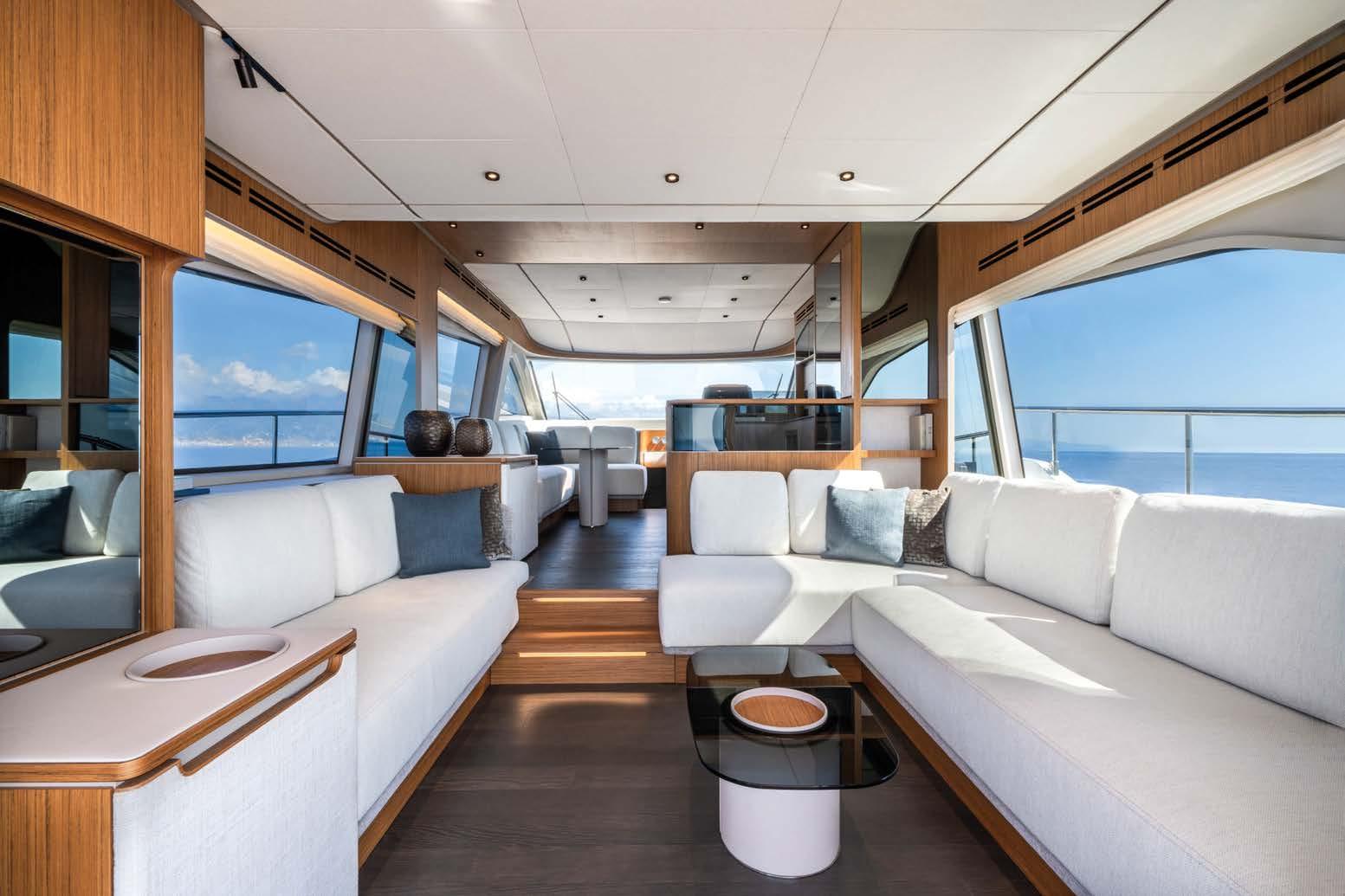


Il grande salone è circondato da vetrate e il layout a tre cabine con tre bagni garantisce il massimo comfort anche per lunghe permanenze a bordo.
Windows surround the large lounge, and the three-cabin layout with three bathrooms ensures it is incredibly comfortable, even for extended stays on board.


tutto baglio ha una superficie di 18 metri quadrati.
scegliere ben tre diverse location sul y, nel salone o in pozzetto. E tanti sono anche i layout disponibili per gli interni. Quello del modello che ho testato a Cannes aveva un armatoriale a centro barca che occupava tutto il baglio con un bagno collocato tra la cabina e la sala macchine per minimizzare il rumore durante la navigazione o quando gli impianti, come il generatore, sono in funzione. Appena si entra nell’armatoriale s’incontra un grande tavolo da lavoro e un vanity, mentre per arrivare alla cuccetta si devono scendere altri tre gradini. In questo modo, l’abitabilità nella zona letto è ancora maggiore. La zona notte è composta da altre due cabine e due bagni, tutti con box doccia separati. Se ci fosse stato un tientibene in più, la discesa dal ponte principale alle cabine sarebbe più confortevole e sicura. Gli arredi e la qualità delle finiture, soprattutto degli interni, conferiscono a questo yacht una particolare eleganza.
It is a boat built on solid foundations. But what exactly are those foundations? The previous version of the Ferretti 670 debuted in 2017, and fifty units have been made in those seven years. It is a successful model, without any doubt. The yard thus decided to restyle it, keeping the hull
unchanged and only working on the design of the external lines. It looks like a more streamlined and sporty yacht less weighed down by the y structure. The work done by Filippo Salvetti has focused on the lines, the windows on the sides, and the openings in the gunwale, so it is below the handrail. The aim is to increase the view outwards by removing as many obstacles as possible and, therefore, more windows and more open surface area, benefiting a more direct relationship with the sea. It is a sensation that can be perceived when observing the boat from the dock, but especially when you are on board. They have increased visibility from the inside of the 2017 version, but the same is true of the side decks. That has been done very well because you don’t get the feeling of a yacht that has loads of holes made in it for portholes, windows and other openings. The changes are balanced and at the right height. I could see the sea every time I looked out, whether on the main deck, in the accommodation area of the lower deck, in the cockpit or along the side decks. The ybridge has been lightened using carbon fibre and vacuum fibreglass resin construction techniques. The effect, more than on the overall weight of the boat, can be seen in the trim when underway, as displacement has increased by two tonnes.

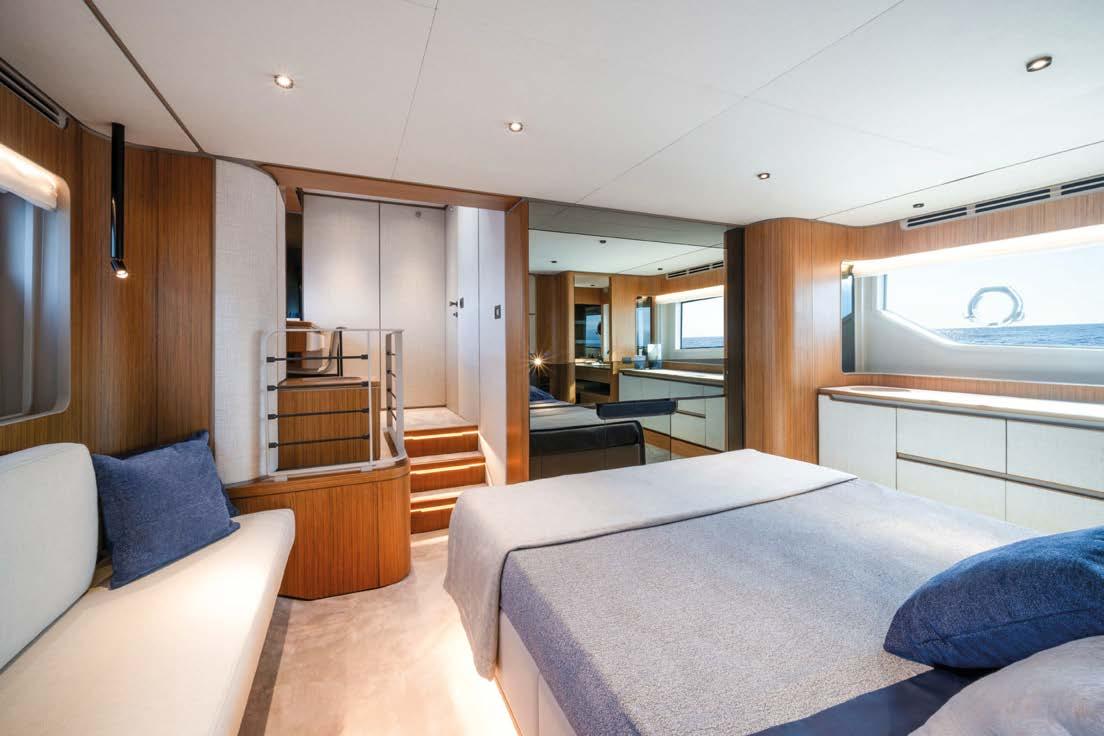



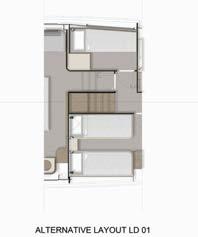


The sightlines are perfect, from the helm station on the y to the inside one. There aren’t any windscreen supports or ones holding up the ybridge hardtop. Instead, the supports are there, of course, but they do not obstruct the view when you are at the helm. It moves very comfortably across the waves.
The feeling is that the V-bow fends off the waves as it should, and then the hull’s weight helps atten the water. That is a feeling I got with the steep, half-metre waves I found off the harbour wall in Cannes and as I went over the wakes of passing ships. Its manoeuvrability and ability to turn tightly are notable, especially considering the transmission is a traditional straight shaft design. We were using two Seakeepers, Zipwake interceptors and the Xenta joystick so that you could ask for all the help. It gave the feeling of being a balanced hull that is easy to handle and doesn’t have any problems getting the proper trim and keeping it. Nor does it struggle to stay up at planing minimum, which I reached at thirteen knots while using less than 130 litres per hour overall. There are two MAN V8s, each turning out 1,200 horsepower, more than the

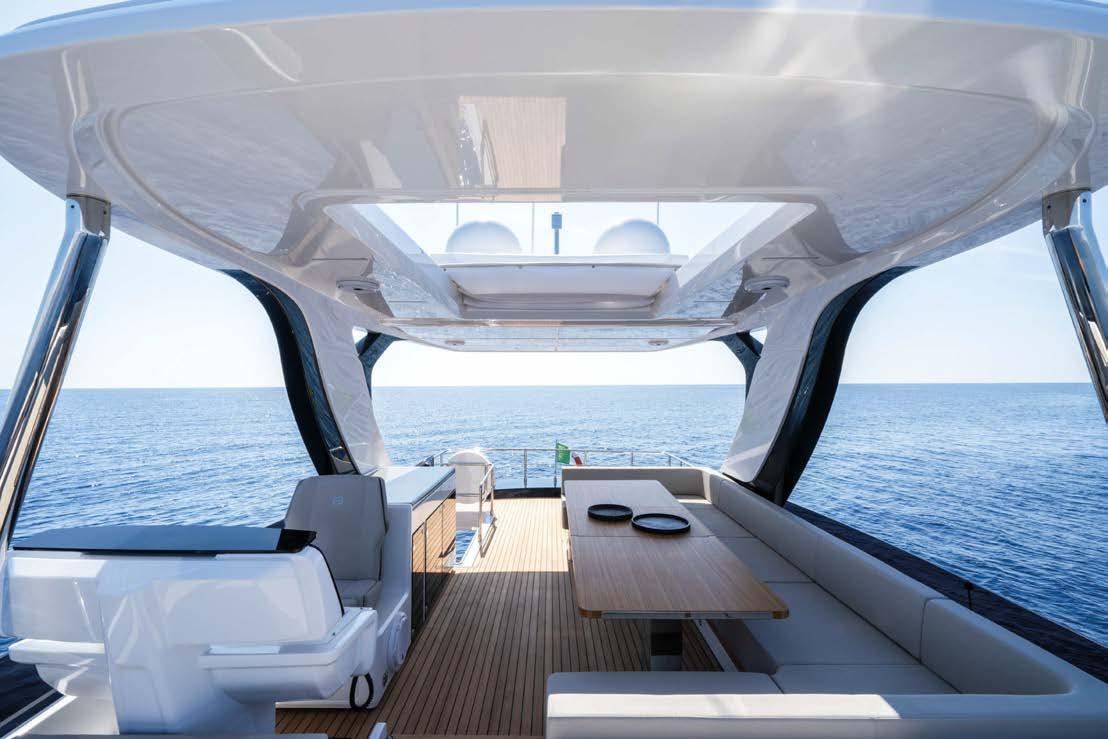


AUTONOMIA MN RANGE NM

RAPPORTO PESO POTENZA MASS OUTLET POWER
kg kw

RAPPORTO LUNG./LARG. L/W

FERRETTI YACHTS
Via Ansaldo, 7 I-47122 Forl (FC) T. +39 0543 787511 www.ferretti-yachts.com
PROGETTO
Filippo Salvetti (exterior design), IdeaeITALIA (interior design), u cio tecnico Ferretti (carena)
SCAFO
Lunghezza f.t. 20,24m Lunghezza scafo 19,29m Lunghezza al galleggiamento 17,12m Larghezza massima 5,38m Pescaggio 1,68m Dislocamento a secco 41.000 kg Dislocamento a pieno carico 48.300 kg Serbatoi carburante 3.800 l Serbatoi acqua 1.000 l
MOTORE
2x Man V8-1200 Potenza 882 kW (1.200 cv) 8 cilindri a V (90 ) Cilindrata 16,16 l Regime di rotazione 2300 giri/minuto Peso a secco 1.875 kg
CERTIFICAZIONE CE CAT A
PREZZO
Prezzo base 2.725.000 € Iva esclusa
PROJECT
Filippo Salvetti (exterior design), IdeaeITALIA (interior design), Ferretti technical department (hull)
HULL
LOA 20.24m Length 19.29m L L 17.12m
Maximum beam 5.38m Draft 1.68m Light mass displacement 41,000 kg Full load displacement 48,300 kg Fuel tank volume 3,800 l ater tank volume 1,000 l
MAIN PROPULSION
2x MAN V8-1200 Outlet mechanical power 882 kW (1,200 hp) 8 90 V-shaped cylinders Swept volume 16.16 l Maximal rotational speed 2300/min Dry weight 1,875 kg
EC CERTIFICATION CAT A
PRICE
Starting from 2,725,000 € Excl. VAT
//Place
Da zero a planata in 10 secondi
Gliding time of 10s from 0 to glide
Da zero a velocità massima in 35 secondi
Gliding time of 35s for a speed change from 0 to 32 knots (maximum speed)

Ottimo comfort, sia alla guida, sia per i passeggeri. a carena non so re il mare formato e la manovrabilità, in navigazione e all’ormeggio, è notevole.
It is incredibly comfortable, both for skippers and guests. The hull isn’t troubled by rougher seas, and the level of manoeuvrability – both underway and when mooring – is notable.
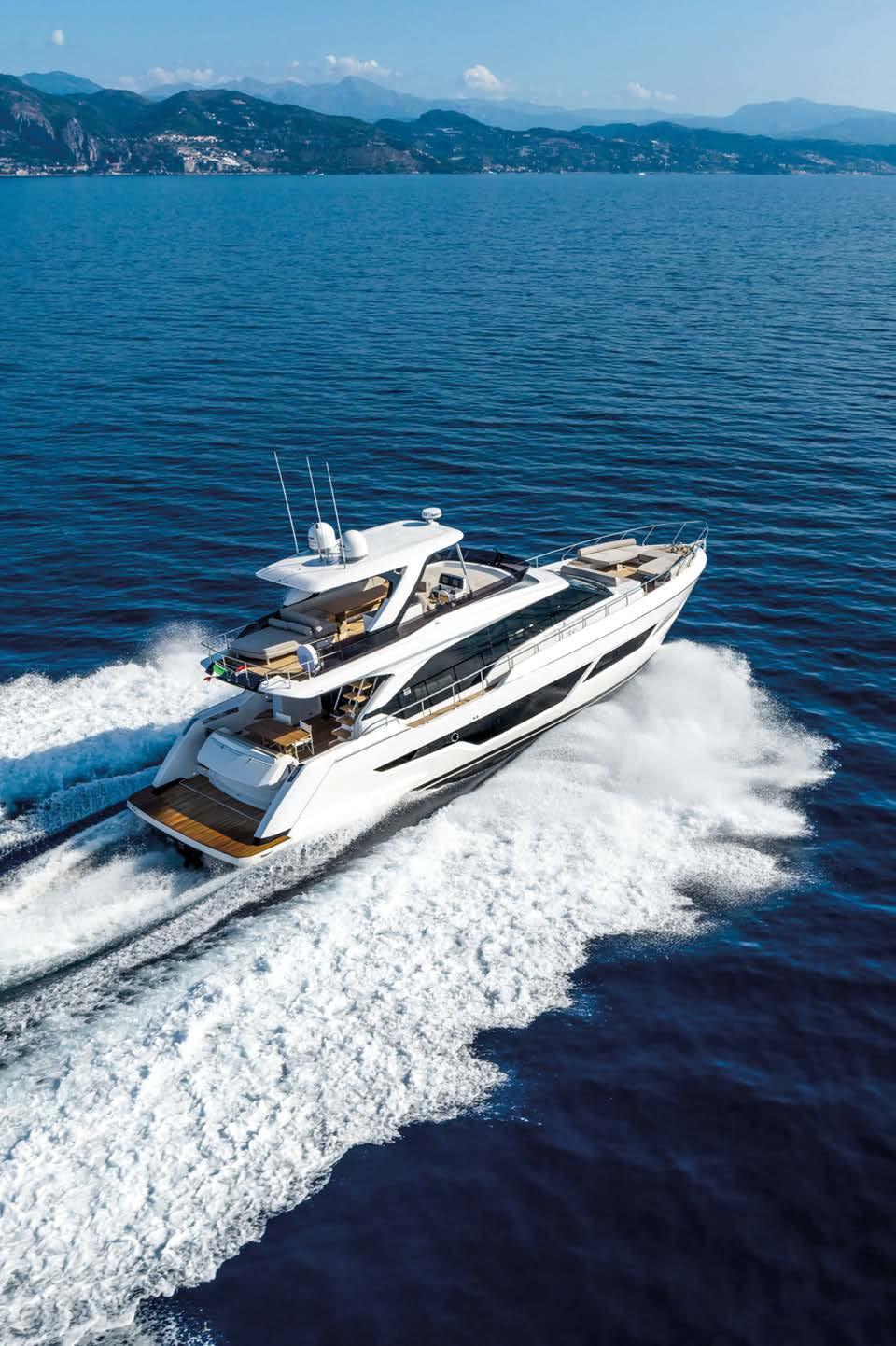
yard’s standard engine fitting a pair of 1,000 hp motors. I got to a maximum of 32 knots using 4 0 litres, and there is an extensive span of cruising speeds –nearly twenty knots from gliding, with between 10 and 15 litres used per nautical mile. The bow area has room for the sun pad and a living area, while the cockpit (entirely covered by the hardtop) houses the stern sofa and the dining table. Aft, there is the tender garage and the submersible platform. The ybridge is extensive, which means it can house a dining area with a table, a U-shaped sofa, and a large sun pad in addition to the second helm station.
The lounge, which naturally has a full array of windows, has everything you could need a living area with sofas facing each other from either side and then further forward, the galley, dining area and main helm. At over twenty metres long, it gives a wide range of choices. You have three places to choose from when you eat the ybridge, the lounge or the cockpit. And there are also a lot of layout options available for the interiors. The one on the model that I tried at Cannes had a full-beam master cabin midships with a bathroom between the engine room and the cabin to reduce noise when underway or when equipment like the generator is working. As soon as you enter the master cabin, you find a work table and vanity unit, but you must go three steps to get to the bed. That means headroom in the bed area is still more remarkable. The accommodation area comprises two more cabins and bathrooms, each with a separate shower cubicle. If they had included an extra grab handle, going from the main bridge to the cabins would have been safer and more comfortable. The furnishings and the quality of the finishes, especially indoors, mean this yacht feels
Due Man V8 da 1.200 cv sono in grado di far agevolmente superare i trenta nodi di velocità. La motorizzazione standard prevista è con una coppia di 1.000 cavalli.
Two MAN V8s producing 1200 horsepower mean you can comfortably do over thirty knots. A pair of 1,000 hp engines are fitted as standard.

VI PIACE NAVIGARE
E VI PIACE FARLO CON QUALSIASI CONDIZIONE DI MARE? S65 È LA BARCA CHE FA PER VOI: STABILE, SICURA, MARINA DO YOU ENJOY SAILING IN ALL CONDITIONS? THEN THE S65 IS THE BOAT FOR YOU: IT IS STABLE, SAFE AND SEAWORTHY
by Niccolò Volp i
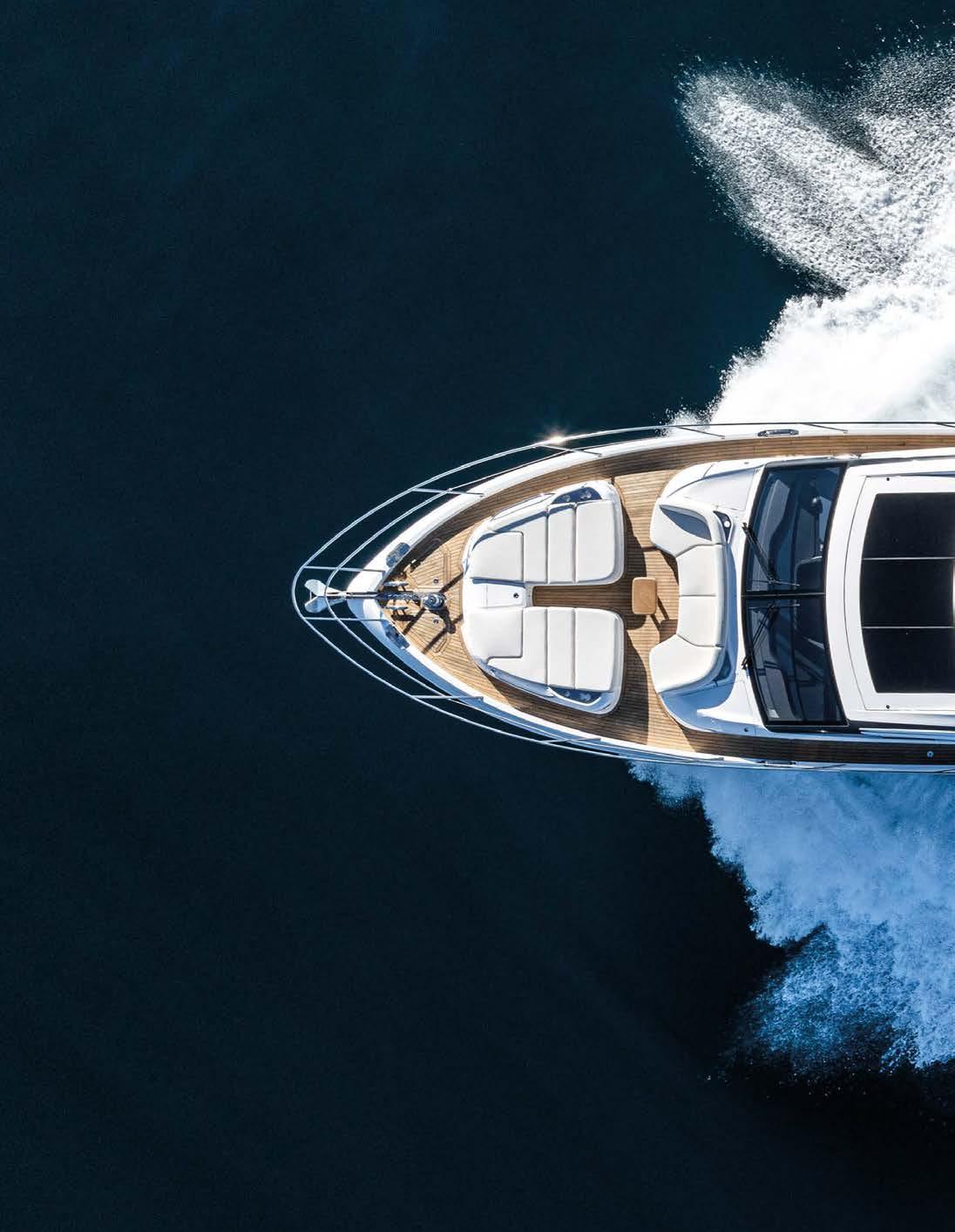



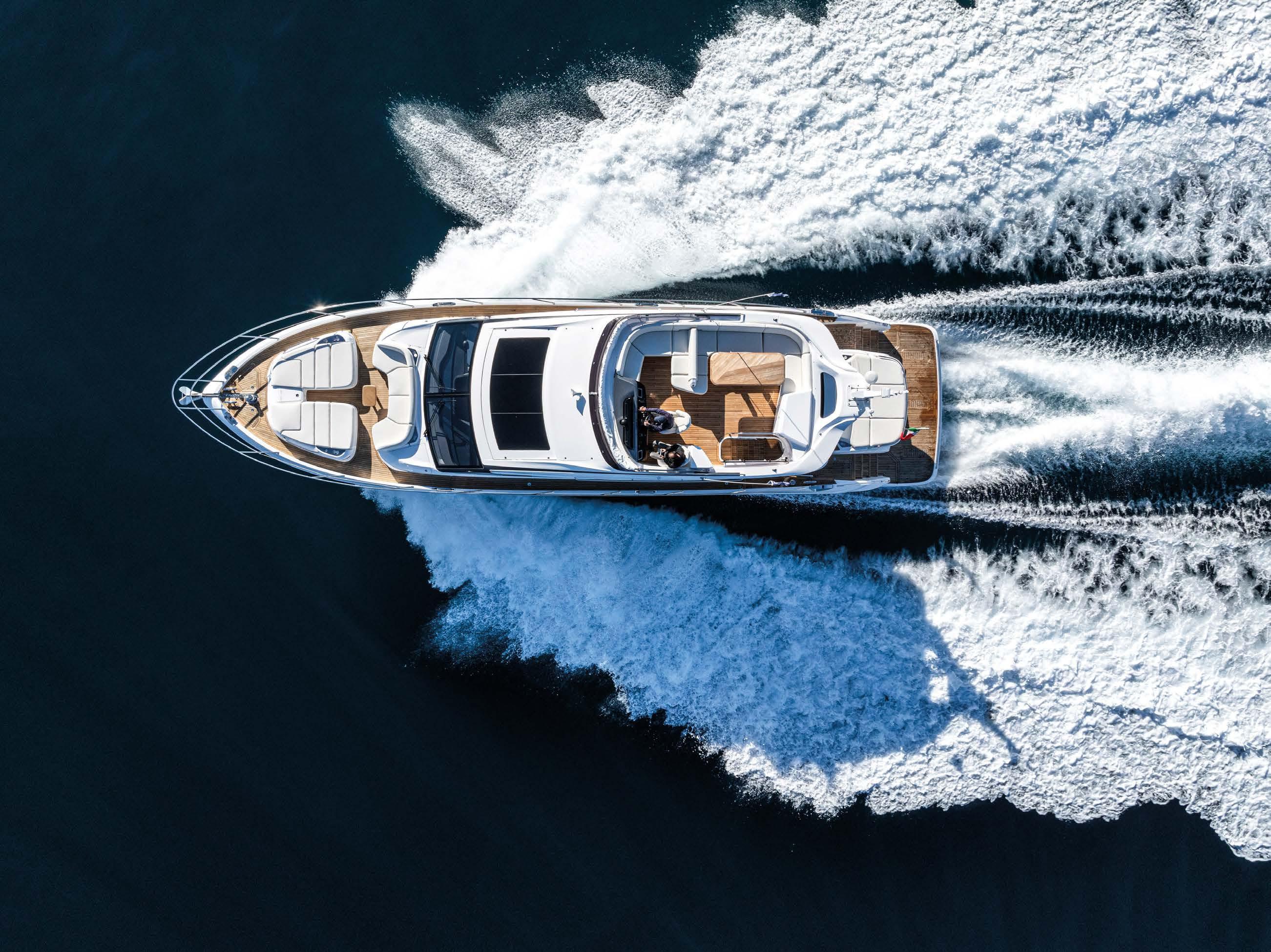
Solida, robusta, marina. Sono salito a bordo su molti modelli del cantiere e ho macinato diverse miglia negli anni. So che può sembrare banale, ma si ha sempre la sensazione di salire a bordo di uno yacht fatto per navigare. Non vorrei essere frainteso perché, a volte, quando si dice che una barca è fatta per navigare si pensa che sia spartana, che badi all’essenziale e quindi che comporti alcune rinunce, per esempio in fatto di comfort. Princess non è così. Interpreta la navigazione nel senso più moderno del termine. Il Dna è sempre quello e trasmette stabilità, sicurezza, robustezza. Me ne accorgo dalle finiture, dai materiali di coperta e interni. Tutto sembra fatto per durare nel tempo, per non soffrire il mare formato, per consentire di navigare a lungo anche in condizioni impegnative senza dover fare consistenti manutenzioni già solo dopo una stagione. Ma S65, come le altre, dà anche la sensazione di una barca ordinata. E l’ordine è essenziale per navigare senza preoccupazioni. I layout di coperta e interni offrono un allestimento dove, non solo c’è tutto ciò che serve, ma si trova anche al posto giusto e ha le proporzioni giuste. L’ingresso nel salone del ponte principale ha un camminamento
Gli interni curati da Pininfarina, coniugano design, eleganza e comfort, senza rinunciare al comfort e alla sensazione generale di robustezza.
The Pininfarina-designed interior combines design, elegance and comfort without sacrificing comfort and a general sense of robustness.




Il ponte inferiore ospita quattro cabine e due bagni. A prua c’è la Vip e altri due locali, uno con letti paralleli e uno con cuccette sovrapposte tipo pullman. Verso poppa si accede alla cabina armatoriale che occupa per intero il baglio.
The lower deck has four full cabins and two bathrooms. The VIP stateroom and two other bedrooms are set forward, with twin beds and bunks. Going aft and only three steps down, you get to the full-beam master cabin.
centrale, a sinistra c’è la cucina con tanto spazio per cucinare davvero e a dritta, proprio di fronte, il tavolo da pranzo con le ante a ribalta e tante sedute intorno. Proseguendo verso prua s’incontra la plancia di comando con due poltrone a dritta e a sinistra un’area living per circa dieci persone. Lo spazio è tanto, tutto ben sfruttato. Non serve trasformare nulla per godersi il comfort in navigazione, in rada o in porto. Le vetrate consentono di avere una vista a 360 gradi verso l’esterno. La scaletta per scendere nel ponte inferiore dove si trova l’area notte è ampia, comoda e sicura. Non mancano i tientibene, né lo spazio per muoversi senza difficoltà. Anche quando ci si trova all’interno e si naviga con mare formato non si devono compiere evoluzioni ed equilibrismi per restare in piedi. Il ponte inferiore ospita ben quattro cabine e due bagni. A prua c’è la Vip e altri due locali, uno con letti paralleli e uno con cuccette sovrapposte tipo pullman. Verso poppa, scendendo solo tre gradini, si accede alla cabina armatoriale che occupa per intero il baglio. Il bagno armatoriale è anch’esso a tutto baglio ed è stato ubicato tra la cabina e la sala macchine. Questo consente di allontanare il più
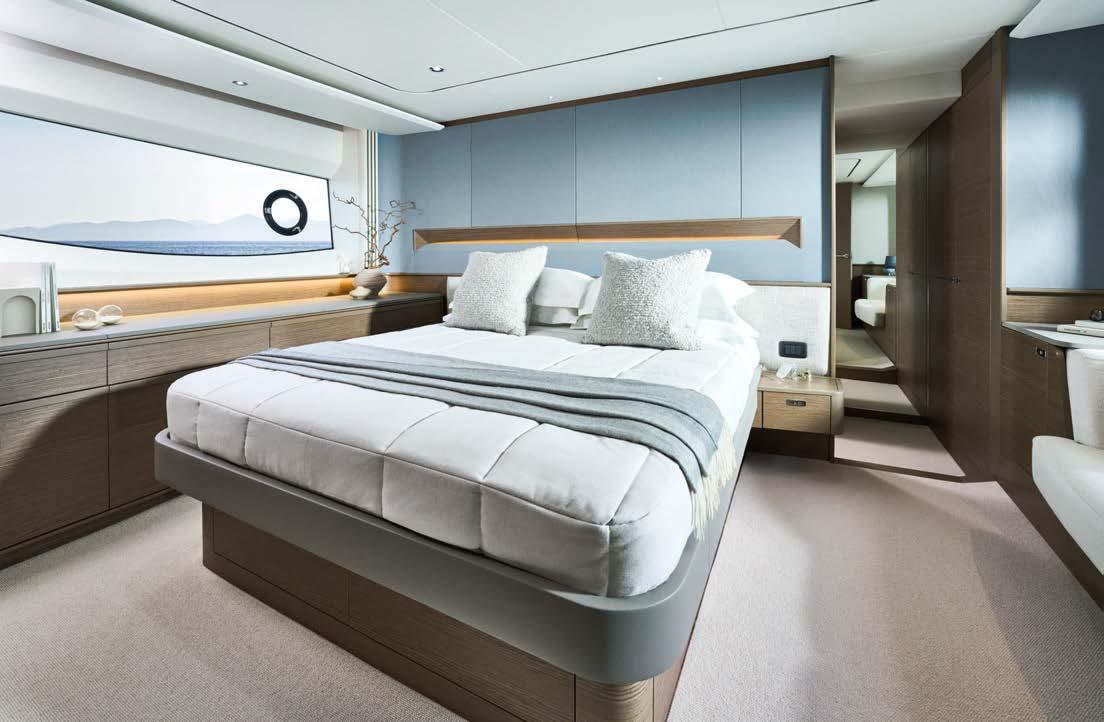
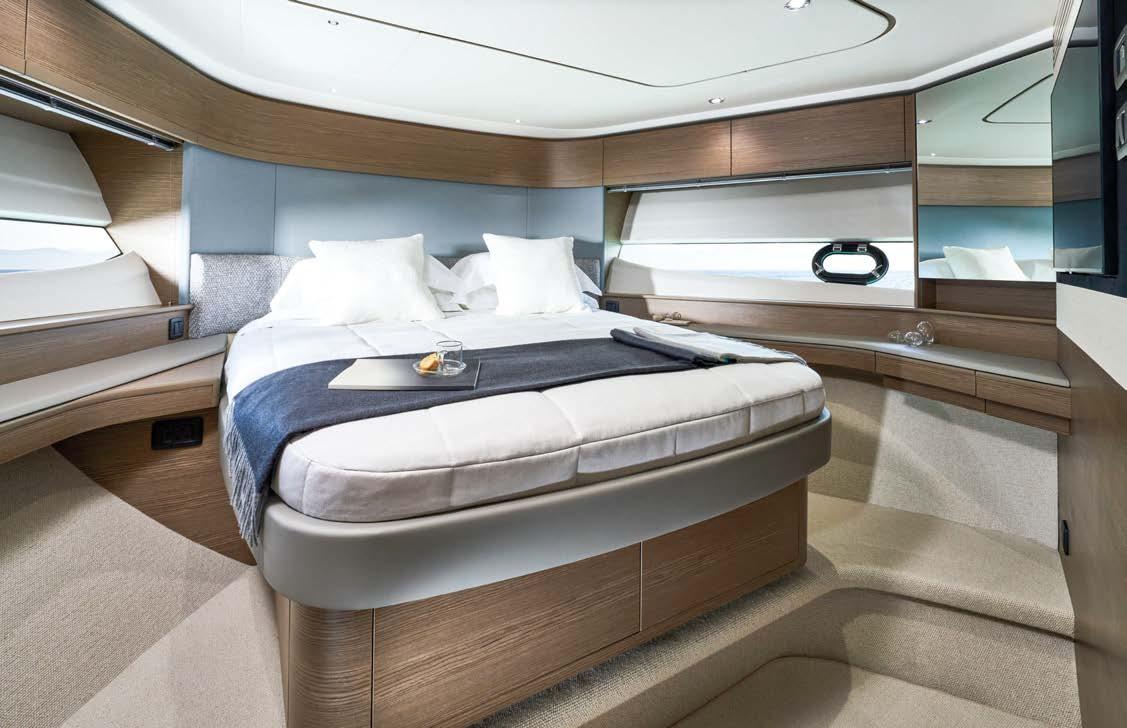


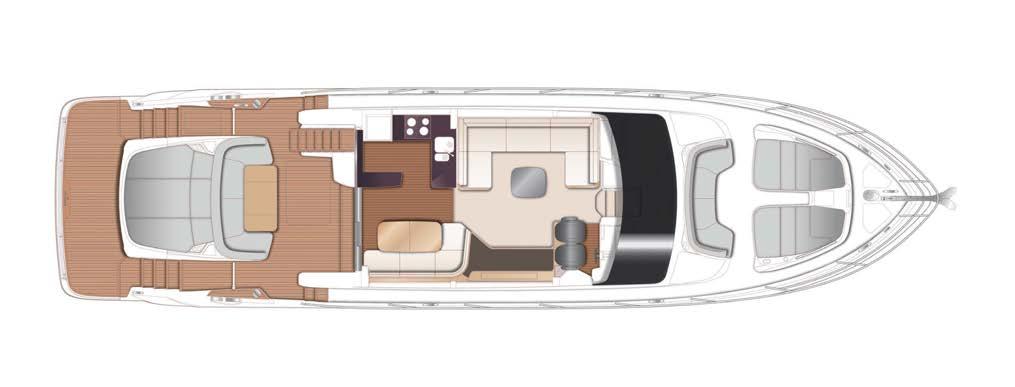
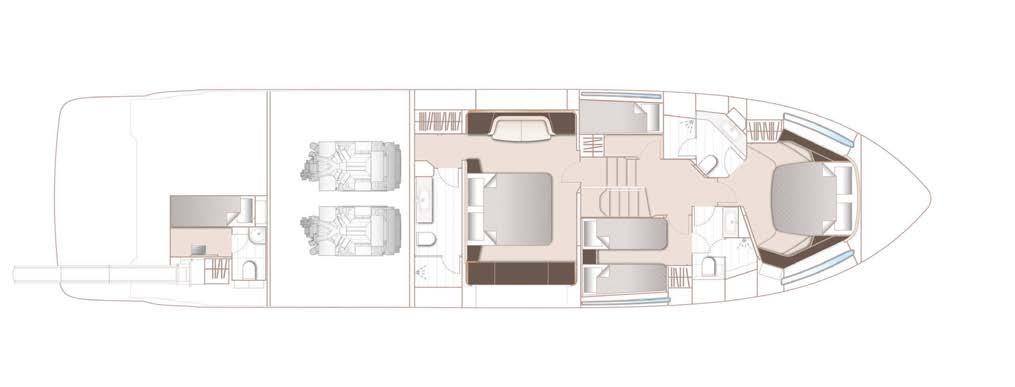
possibile la cuccetta matrimoniale dal rumore della sala macchine e infatti la quasi totale assenza di rumore e vibrazioni è una delle caratteristiche che ho più apprezzato durante la navigazione. Coperta e y rispondono alla stessa filosofia. Le bitte sono tutte sovradimensionate, la larghezza dei passavanti laterali è sufficiente per muoversi in sicurezza e la battagliola corre dal pozzetto fino all’estrema prua. L’allestimento è sempre ordinato e lo spazio per muoversi non è sacrificato. A prua ci sono due prendisole singoli con un camminamento centrale e un divanetto frontemarcia collocato a pruavia del parabrezza. In pozzetto si trova, ovviamente, il tavolo da pranzo esterno con le ante a ribalta e un secondo prendisole più a poppa, proprio sopra il garage del tender. C’è anche un piano superiore, nonostante non sia esattamente un y bridge. È un’area da utilizzare durante le soste in rada perché non ha il T-Top, ma c’è un tendalino a scomparsa che ripara dal sole. C’è un divanetto a U, un tavolo da pranzo e, inoltre, al centro, è collocata una seconda postazione di guida, perfetta da
utilizzare quando si ormeggia in porto e quando si naviga senza il sole a picco. Se Pininfarina e l’ufficio tecnico del cantiere hanno curato interni e coperta, la carena è sempre dello Studio Olesinski. Una certezza, così come la coppia di Man V12 da 1.400 cavalli ciascuno che si trova in sala macchine. È una potenza molto equilibrata, perfetta per questa barca e queste linee d’acqua. Ma anche la maneggevolezza è comunque garantita, nonostante la trasmissione in linea d’asse. Per completare una rotazione di 360 gradi servono circa un’ottantina di metri di diametro. Per planare occorrono 19 nodi e alla massima sono arrivato a 36 e mezzo. Un range abbondante. I due propulsori tirano fuori tutta la loro potenza soprattutto negli ultimi 500 giri, merito anche delle linee d’acqua della carena. L’assetto è quello giusto e la visibilità quasi perfetta. Il montante al centro del parabrezza la ostacola un po’, ma è un prezzo che si paga volentieri in cambio della robustezza che tutta la sovrastruttura offre. La rumorosità è praticamente inesistente e anche questa è una caratteristica che si apprezza molto in navigazione.
Solid, rugged and seaworthy. I have been on board many boats made by the yard and ground out miles over the years. It might seem obvious, but you always feel you are on board a yacht designed to be used. I don’t want to be misunderstood because sometimes, when you say that a boat has been made to be used at sea, you get the impression that it is spartan, sticks to the essentials, and does without a few things, for example, in terms of comfort. But Princess doesn’t work like that, and they take a modern approach to yachting. The core DNA of the firm is unchanged and conveys stability, safety and toughness. I realised that from the finishes and materials used on the deck and the interiors. Everything feels as if it were made to last and not to feel the effects of rougher seas. That means you can spend a long time underway, even in harsh conditions, without having to do substantial maintenance work after just a season. But the S65, like the other boats from the yard, gives the feeling of being well-ordered. And order is vital if you want to sail out without too much worry. The deck layouts and interiors deliver a

Comodo il portellone che dalla plancia consente di accedere direttamente al passavanti di dritta.
For your convenience, the hatch provides direct access from the dashboard to the deck on the starboard side.


VELOCITÀ MAX NODI TOP SPEED KNOTS

AUTONOMIA MN RANGE NM


RAPPORTO PESO POTENZA MASS OUTLET POWER 18 kg kw
RAPPORTO LUNG./LARG. L/W 4

PRINCESS YACHTS INTERNATIONAL
Newport Street, Plymouth Devon, PL1 3QG, United Kingdom www.princessyachts.com
Dealer Marine Group Via del Castillo 17, Portosole I-18038 Sanremo (IM), T. +39 0184 990770 info@princessitalia.it www.princessitalia.it
PROGETTO
Studio Olesinski (carena), Pininfarina (interni) e u cio tecnico del cantiere
SCAFO
Lunghezza f.t. 20,60m • Lunghezza fuori tutto escluso il pulpito 20,02m • Larghezza massima 5,09m • Pescaggio 1,65m • Dislocamento 37.240 kg • Serbatoi carburante 4.100 l • Serbatoi acqua 802 l
MOTORI
2xMan V12-1400 • Potenza 1.029 kW (1.400 cv)
CERTIFICAZIONE CE CAT B
PREZZO
A partire da 2.745.000 £ con due Man V12-1400
PROJECT
Studio Olesinski (hull), Pininfarina (interiors) and shipyard technical department
PROJECT
LOA 20.60m • Overall length excluding pulpit 20.02m
• Maximum beam 5.09m • Draught 1.65m
• Displacement 37,240 kg • Fuel tanks volume 4,100 l • Water tank volume 802 l
MAIN PROPULSION
2x MAN V12-1400 • Outlet mechanical power 1,029 kW (1,400 hp)
EC CERTIFICATION CAT B PRICE
Starting from 2,745,000 £ with twin MAN V12-1400
CONDIZIONI DELLA PROVA CONDITIONS ON TEST
Località//Place Sanremo Mare//Sea state Calmo//Calm Vento forza//Wind speed 0 Persone a bordo
VELOCITÀ IN NODI SPEED IN KNOTS
Da zero a planata in 8 secondi
Gliding time of 8s from 0 to glide
Da zero a velocità massima in 31 secondi
Gliding time of 31s for a speed change from 0 to 36.5 knots (maximum speed)
MIGLIO (VELOCITÀ DI CROCIERA) L/ NA MI (CRUISING SPEED)
13.2

In pozzetto si trova il tavolo da pranzo esterno con le ante a ribalta e un secondo prendisole più a poppa.

In the cockpit, you can find an outdoor dining table with folding sides and a second sun pad further aft.

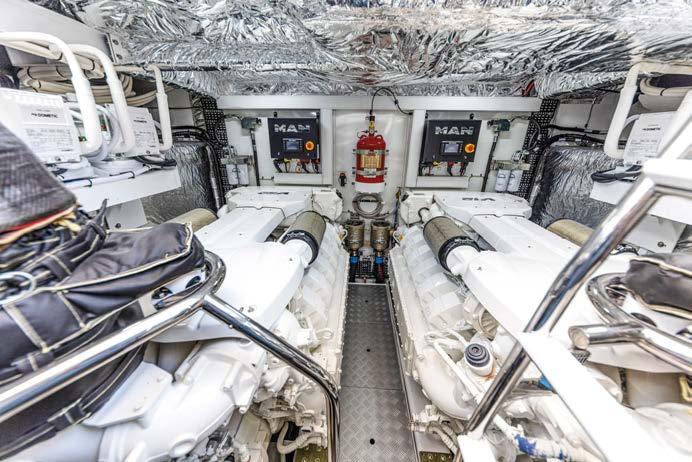
Due Man V12 da 1.400 cv ciascuno con trasmissione in linea d’asse. Si tratta di una motorizzazione scelta spesso da Princess per i modelli di questa taglia.
Two MAN V12s of 1,400 hp each with shaft drive. This is an engine often chosen by Princess for models of this size.
The equipment and furnishings are always well-ordered, and the room to get around has not been sacrificed. Going into the bow, two individual sun pads with a central walkway and a forward-facing sofa set forward from the windscreen. In the cockpit, you can find an outdoor dining table with folding sides and a second sun pad further aft, right above the tender garage. There is also an upper deck, although it is not precisely a ybridge, and it is more of an area to be used during stopovers because it doesn’t have a T-Top but rather an awning to keep the sun off. There is a U-shaped
sofa, a dining table, and also – in the middle – a second helm station, which is perfect for use in port or when the sun isn’t beating down. Pininfarina and the yard’s technical department looked after interiors and superstructure, while the hull always come from Studio Olesinski. That’s a sure bet, as are the pair of MAN V12s, each developing 1,400 horsepower in the engine room. That balanced output is perfect for this boat and its waterlines. However, manoeuvrability is ensured despite the straight shaft transmission system. For a complete 360-degree turn, you need a diameter of around 80 metres. It took 19 knots to the plane, and the fastest I reached was 36.5. So, there is a broad span of cruising speeds to choose from. The two engines deliver their power, especially in the final 500 revs. That is also thanks to the waterlines. The trim is just right, and visibility is nearly perfect, being just slightly impaired by the support in the middle of the windscreen. But that is a price that you will happily pay for the toughness that the whole superstructure offers. There is almost no noise - another characteristic people like when underway.
La carena fende bene le onde autoprodotte. La sensazione è che non so ra per niente il mare formato. The hull cuts through the self-generated waves well. You get the feeling that it doesn t suffer at all from the sea.



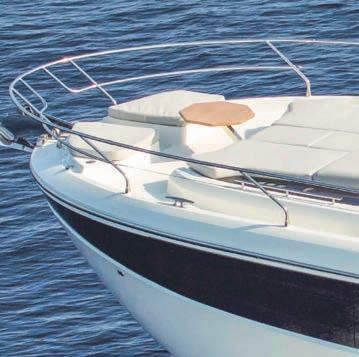

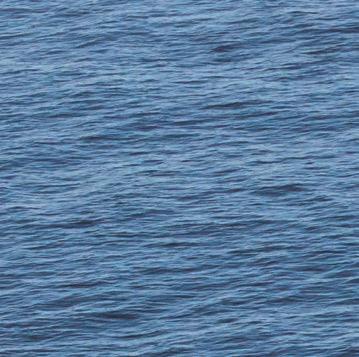


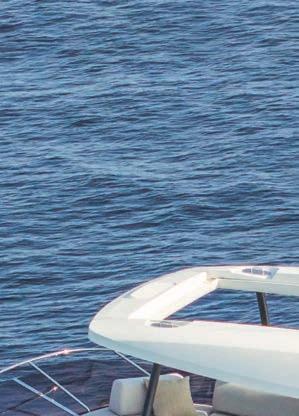



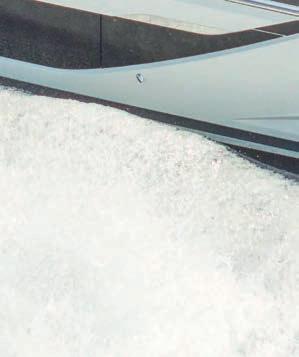
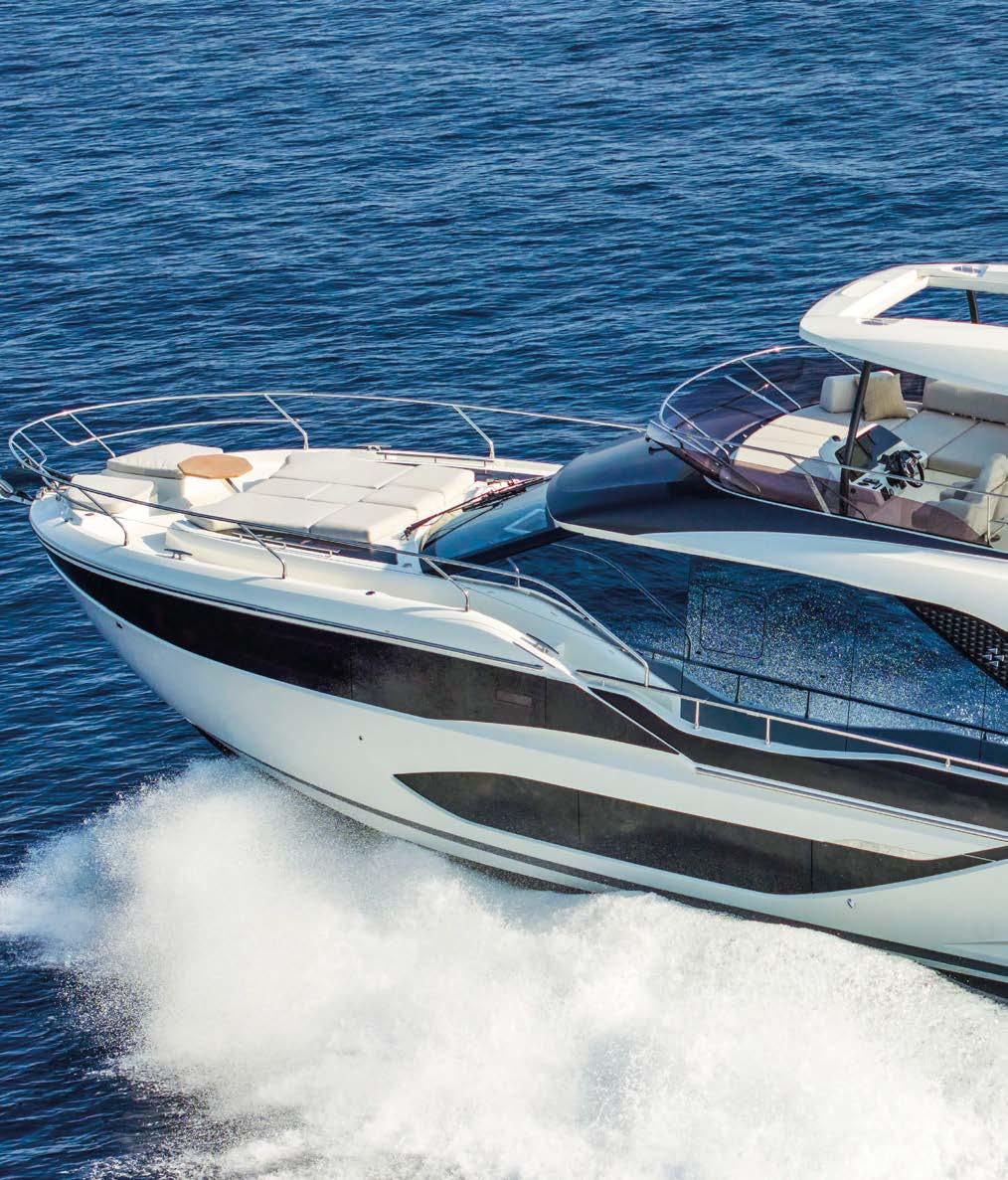
TRANQUILLA, SICURA, RILASSANTE. QUESTO È, DA SEMPRE, IL DNA PRESTIGE CHE SI RISCONTRA ANCHE NELL’F5.7 DISEGNATO DA CAMILLO GARRONI CALM, SAFE, RELAXING. THOSE HAVE ALWAYS BEEN THE KEY ELEMENTS THAT MAKE UP THE DNA OF PRESTIGE BOATS AND CAN ALSO BE FOUND IN THE F5.7 DESIGNED BY CAMILLO GARRONI by Niccolò Volpati
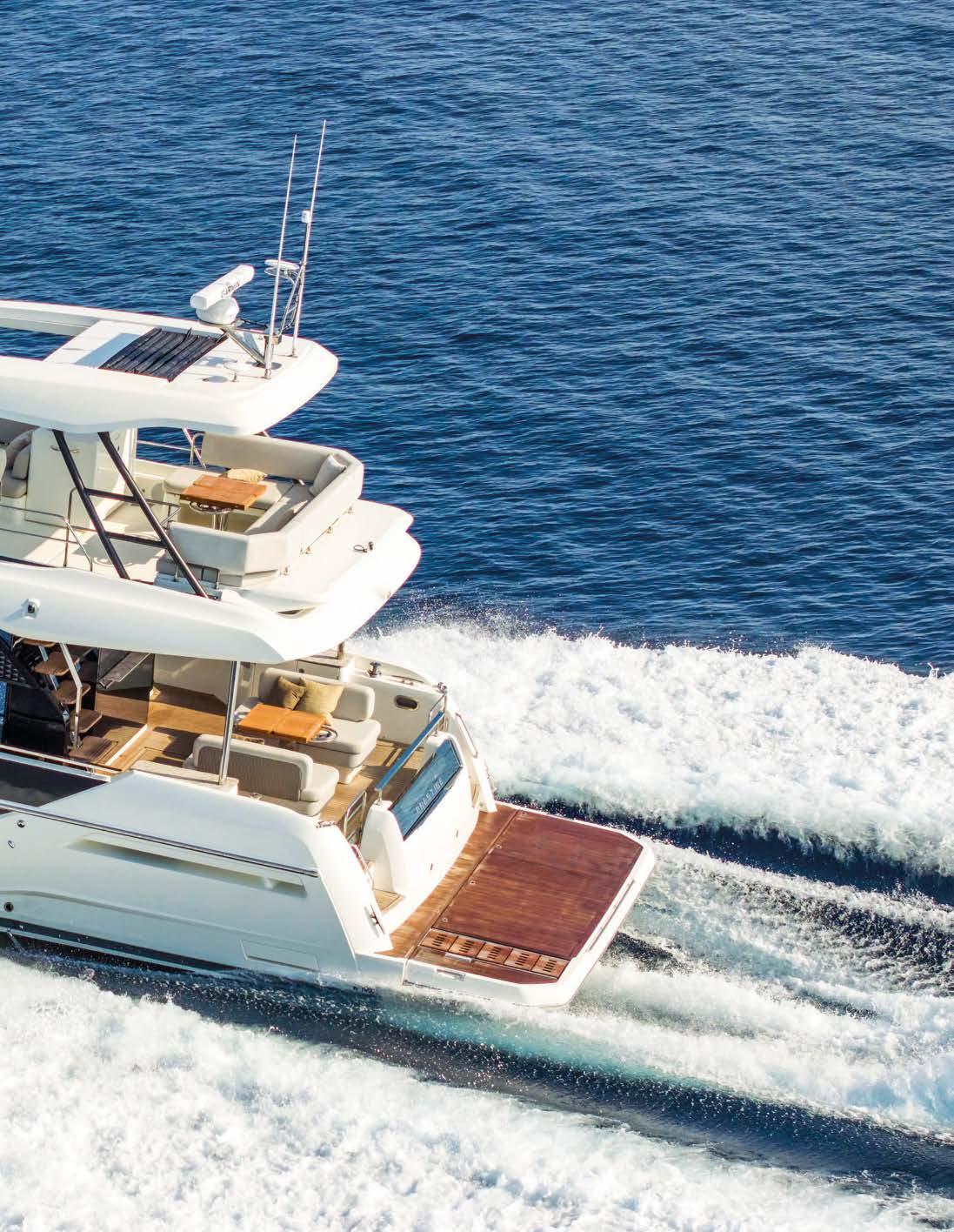
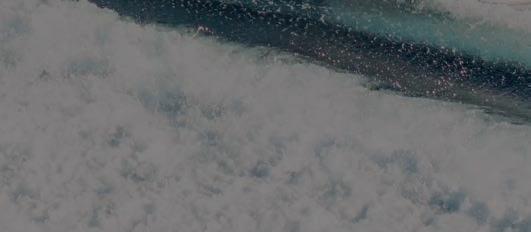

17.29m

Quando ti spiegano che sono arrivati alla terza generazione della gamma F-Line capisci che si tratta di una barca che ha segnato la storia recente della nautica. Ci sono infatti migliaia di persone in tutto il mondo che hanno navigato su un y prodotto da Prestige. F5.7 è il secondo modello, il primo è stato F4.9 che ha fatto la sua comparsa solo poco tempo fa. Il progettista è sempre Camillo Garroni che assomiglia al nucleo della fusione nucleare. Non si esaurisce mai. Riesce sempre a innovare, modificare e migliorare le sue creazioni. Il segreto forse è proprio la lunga relazione con il cantiere francese. La produzione in serie permette di avere un riscontro incredibile dagli armatori e riuscire a farne tesoro è il modo migliore per indovinare i gusti dei clienti. Il gruppo
nasconderlo, questo è un periodo difficile –afferma Michelangelo Casadei, General Manager Motor Yachting Business Unit del Gruppo Bénéteau – ma è proprio in momenti come questi che si deve osare e proporre innovazione tecnologica come il sistema di assistenza e monitoraggio che è stato installato su F5.7”. Tutte le funzioni, dall’aria condizionata alle pompe di sentina, sono facilmente leggibili. Il sistema appare come una sorta di computer di bordo che consente di avere tutto sotto controllo senza dover essere un ingegnere informatico per comprenderlo. Ma innovare significa introdurre novità senza gettare alle ortiche ci che di buono è stato fatto finora. Ed è questa la sensazione che si prova salendo a bordo di F5.7. Riconosco il Dna, ma percepisco anche soluzioni nuove. L’integrazione tra spazi interni
che si affaccia sul pozzetto sporge proprio verso l’esterno. Non è solo una cucina, ma anche una sorta di bancone bar per chi si trova sui divanetti a poppa. Il portello a finestra completa l’opera. I divanetti in pozzetto sono contrapposti ma collocati orizzontalmente in modo da non compromettere la vista sul mare. Nel ponte inferiore si trovano tre cabine l’armatoriale a prua, la Vip e la terza cabina con letti paralleli a centro scafo. L’allestimento, in particolare della cabina Vip, grazie alla cuccetta matrimoniale collocata in diagonale, consente di muoversi agevolmente intorno al letto. L’attenzione dei progettisti è stata dedicata anche alla facilità di muoversi a bordo, sia all’esterno, sia sul y, ma anche nelle aree interne. Il y, oltre a ospitare la postazione di guida esterna, è dotato
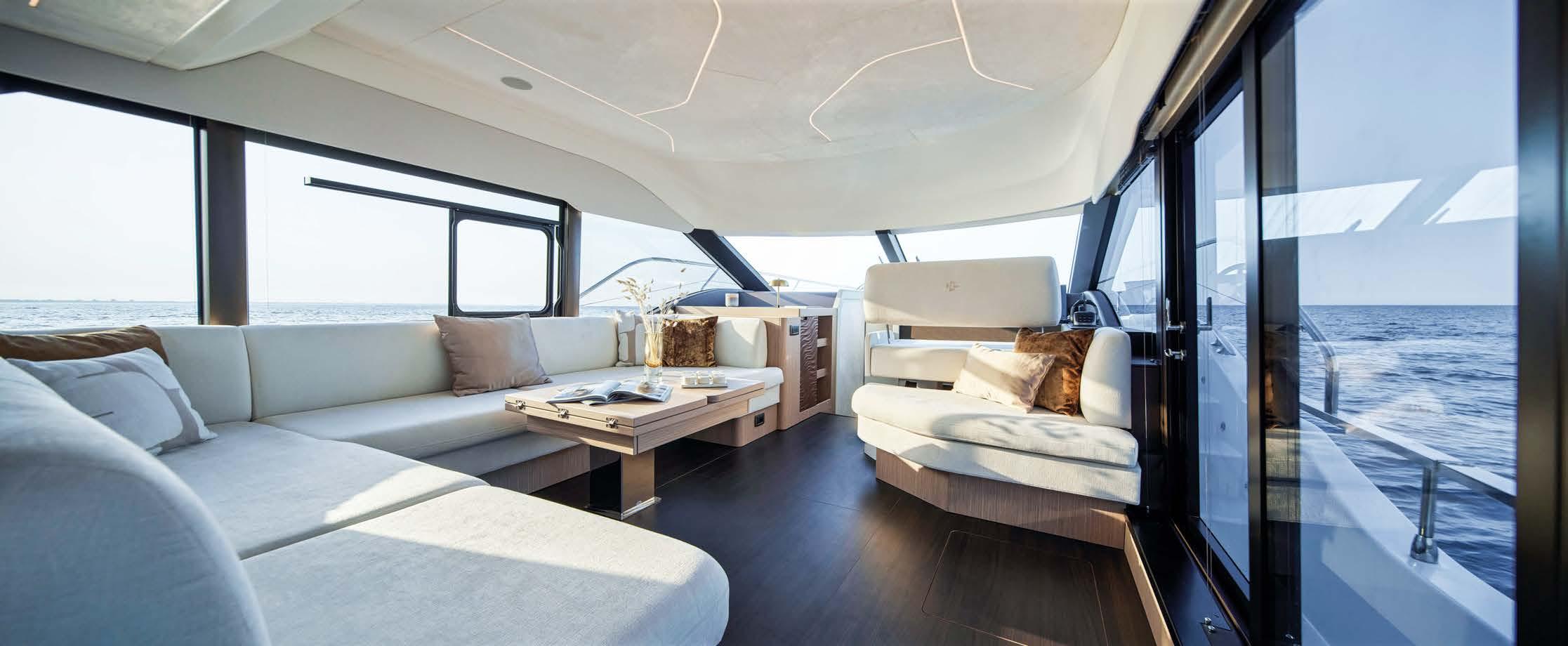
walkaround più che quelli di un ybridge di oltre diciassette metri di lunghezza fuori tutto. È un dettaglio che contribuisce a “snellire” l’estetica della barca e non è facile dare questa sensazione su questa tipologia di barca. F5.7 è stata progettata per la navigazione in famiglia, è in grado di ospitare sei persone comode e anche di essere condotta senza l’ausilio di un comandante o di un equipaggio, se l’armatore è esperto. Partiamo dalla sala macchine dove troneggia il sistema Ips 800 con due Volvo D8 da 00 cavalli ciascuno. Tutto ben organizzato e facilmente accessibile, perché nessuno in crociera ha voglia di impazzire se deve fare manutenzione su un motore o un impianto.


Inoltre, gli Ips sono garanzia di manovrabilità e bassi consumi, altri due elementi imprescindibili. E così è alla prova dei fatti. La carena si comporta bene perché è soprattutto facile da condurre. Il mare in Costa Azzurra è incrociato, anche se l’onda non è eccessiva, ma è comunque sufficiente per essere fastidiosa. Ma non è il fastidio che si prova al timone di F5.7 Al contrario, la sensazione è quella del comfort. La visibilità è sempre ottima. Questo contribuisce a una navigazione tranquilla così come tranquilla è la motorizzazione. I due D8 da 00 cavalli rappresentano una potenza equilibrata, perfetta per la crociera. Alla massima si arriva a 25 nodi e per planare ne bastano tredici e mezzo. I consumi sono compresi tra 1 0 litri ora della planata minima e i 243 litri ora della massima velocità. Un valore decisamente contenuto soprattutto se si tiene conto che si tratta di una barca di oltre 17 metri di lunghezza fuori tutto, con il y, e oltre 20
When people tell you that the third generation of the F-Line has arrived, you realise that this boat has become part of recent yachting history. Thousands of people around the world have en oyed a Prestige ybridge boat. The F5.7 is the second model, the first being the F4.9, which appeared brie y. The designer is again Camillo Garroni, who could be compared to the centre of a nuclear fusion, with an active core that never runs out of energy. He is always finding ways to innovate, modify and improve his creations. The secret perhaps lies in his long relationship with the French yard. Assembly-line production volumes mean you get incredible feedback from owners; making good use of that is the best way to determine what clients seek. The group has recently been explicitly reorganised to tackle the challenges and has been structured into three lines one for marketing, one for products and one for clients. “There’s no use hiding it;
Casadei, General Manager at the Bénéteau Group’s Motor Yachting division. “But it is at moments like this that you have to dare and bring on innovations like the assistance and monitoring system installed on the F5.7”. All functions, from air conditioning to bilge pumps, are easy to understand. The system looks like an onboard computer, which lets you keep track of everything without being a software engineer to understand it. However, innovating means introducing new things without throwing away anything good that has been created thus far. And that is your feeling when
Le cabine non sono fatte solo per dormire. Lo spazio a disposizione, i volumi di stivaggio e le ampie superfici calpestabili intorno alle cuccette le rendono ideali per lunghe permanenze a bordo.
Cabins are not just for sleeping. The space available, the stowage, and the large walking areas around the berths make them ideal for




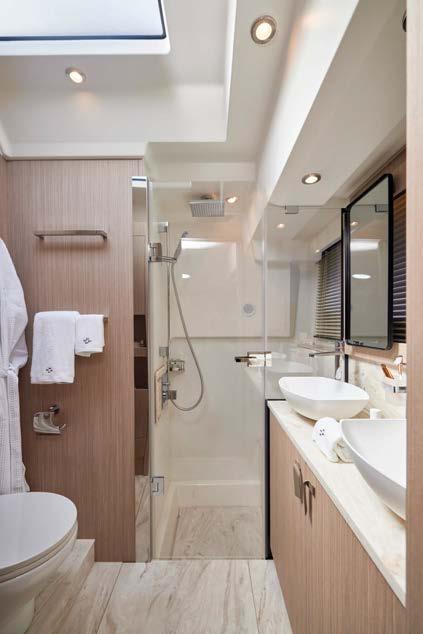



«È inutile nasconderlo, questo è un periodo di cile ma proprio in momenti come questi che si deve osare e proporre innovazione tecnologica come il sistema di assistenza e monitoraggio che è stato installato su F5.7».
Michelangelo Casadei, General Manager Motor Yachting Business Unit del Gruppo Bénéteau
you get on board the F5.7. I recognise the innate Prestige identity, but I also sense some new things are in the package. The integration between internal and external areas felt, if anything, even better than the already high standards that Prestige has got us accustomed to. The living area and the dinette en oy a 3 0-degree view because of the many windows, and the galley, which looks onto the cockpit, opens towards the exterior. It isn’t ust a galley and a bar for people on the aft sofas. It’s rounded
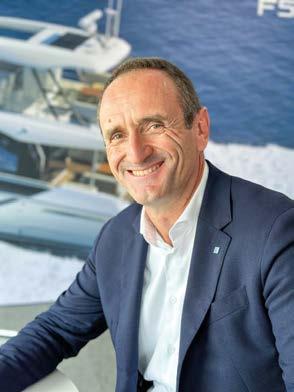
off with a French window. The cockpit sofas face one another but are set along the central axis so as not to interrupt the view of the sea. There are three cabins on the lower deck the master room in the bow, the VIP stateroom and the third room with twin beds midships. The set-up, especially in the main guest room, which has the double bed set diagonally, lets you move around the bed quickly. The designers have looked at that freedom of movement carefully, externally and on the ybridge, but
«There is no point in hiding the fact that these are di cult times, but it is precisely at times like these that one must dare to propose technological innovations such as the assistance and monitoring system installed on the F5.7».
Michelangelo Casadei, General Manager Motor Yachting Business Unit del Gruppo Bénéteau
inside too. The ybridge and housing of the outside helm station also have grill units, sofas, seats, and a sun pad. The structure that holds up the softtop is unusual, given that it sits on four strong supports that are painted black, which is reminiscent of a walkaround boat rather than one with a ybridge of over 17 metres LOA. That helps thin out the look of the lines, which is not easy to do on this kind of boat. The F5.7 was designed with family cruises in mind and can comfortably house six people.
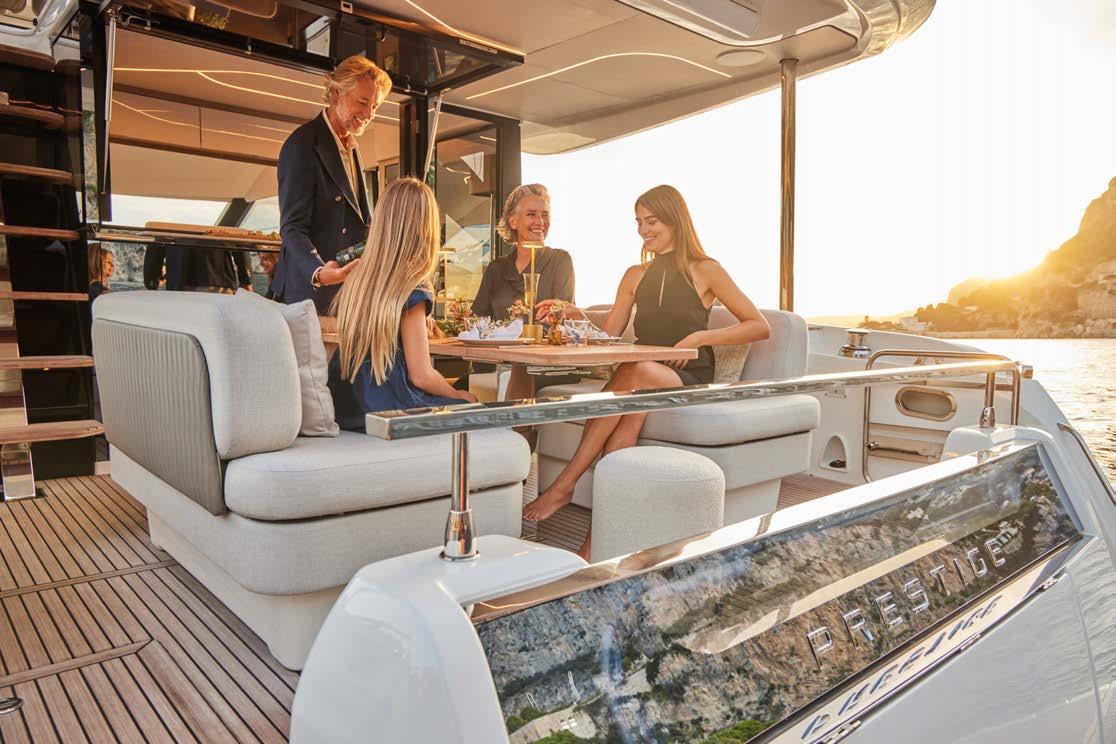






PRESTIGE BÉNÉTEAU GROUP
34 Rue Eric Tabarly F-85170 Dompierre-sur-Yon www.prestige-yachts.com
PROGETTO
Garroni Design/Philippe Briand/ Valentina Militerno De Romedis
SCAFO
Lunghezza f.t. 17,29m • Lunghezza scafo 15,25m • Larghezza massima 4,69m • Pescaggio 1,32m • Dislocamento a secco 20.417 kg • Serbatoi carburante 2.200 l • Serbatoi acqua 580 l
MOTORI
2x Volvo D8-Ips 800 • Potenza 441 kW (600 cv)
• 6 cilindri in linea • Cilindrata 7,7 l • Alesaggio per corsa 110mm x 135mm • Rapporto di compressione 16.6:1 • Regime di rotazione massimo 3000 giri/minuto • Peso 1.410 kg
CERTIFICAZIONE CE CAT B
PREZZO BASE
1.285.000€ Iva esclusa
PROJECT
Garroni Design/ Philippe Briand/ Valentina Militerno De Romedis
HULL
LOA 17,29m • Length 15.25m • Maximum beam 4.69m
• Draft 1.32m • Light mass displacement 20,417 kg
• Fuel tank volume 2,200 l • Water tank volume 580 l
MAIN PROPULSION
2x Volvo D8-IPS 800 • Outlet mechanical power 441 kW (600 hp) • 6 in-line cylinders • Swept volume 7.7 l • Bore&Stroke 110mm x 135mm • Compression ratio 16.6:1 • Maximal rotational speed 3000/min
• Weight 1,410 kg
EC CERTIFICATION CAT B
BASE PRICE
1,285,000€ Excl. Vat
Da zero a planata in 13,5 secondi
Gliding time of 13.5s from 0 to glide
Da zero a velocità massima in 28 secondi
Gliding time of 28s for a speed change from 0 to 25 knots (maximum speed)
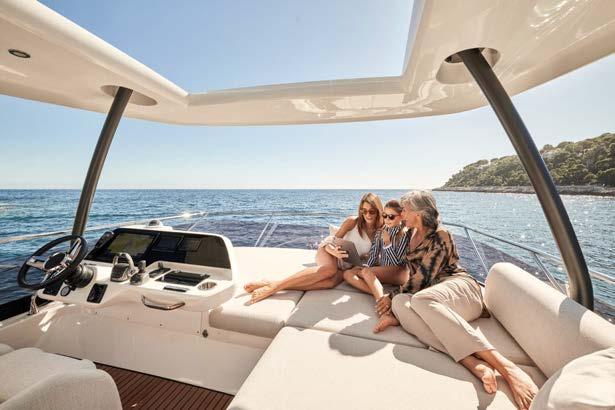
Due Volvo da 600 cavalli ciascuno sono su cienti per una crociera tranquilla: 25 nodi di massima, 20 di crociera e consumi contenuti.
Two Volvo engines, each 600 hp, are enough for quiet cruising: 25 knots at top speed, 20 at cruising speed, and low consumption.
It can be handled without requiring a skipper or a crew if the owner is experienced enough. Let’s start with the engine room, which is presided over by the IPS 800 system with two Volvo D8s, each developing 00 horsepower. It’s all well organised and easily accessible, not least because nobody on a cruise wants to pull their hair out doing maintenance while on a boat trip. The IPS units ensure manoeuvrability and low fuel consumption, two more vital elements. And that is borne out by the facts. The hull behaves well, principally because it
Gli Ips di Volvo garantiscono un’ottima manovrabilità. Un armatore esperto può anche pensare di condurla da solo, senza l’ausilio dell’equipaggio.
Volvo’s IPS ensures excellent manoeuvrability. An experienced owner can even think about driving it alone without the help of a crew.
is easy to handle. There were cross seas off the French Riviera, and although the waves weren’t excessive, they were enough to be annoying. But it’s not an annoyance you feel when at the helm of the F5.7. Quite the contrary, what you think is how comfortable it is. The sightlines, which are always excellent, contribute to the feeling of calm when underway, as does the choice of the two 00-hp D8s, a balanced output which is ust right for cruising. You can get to 25 knots, and 13.5 was enough for us to get on the plane. Fuel consumption was between 1 0 litres per hour at planning minimum and 243 litres at top speed. That’s not much at all, especially since we are talking about a boat with a length of over 17 metres, with a ybridge, which displaces over twenty tonnes in total.






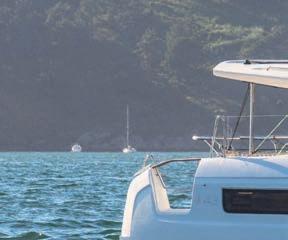

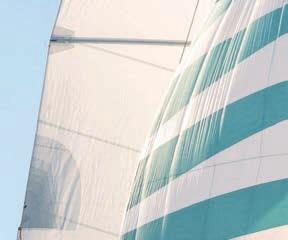


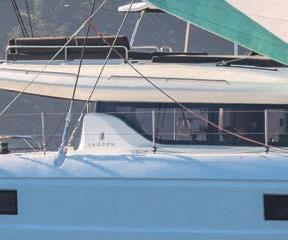

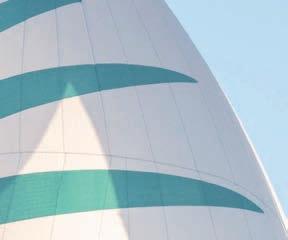




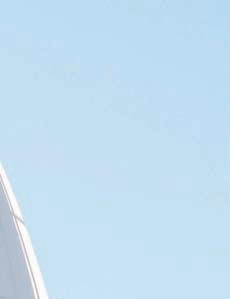

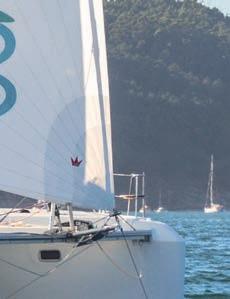


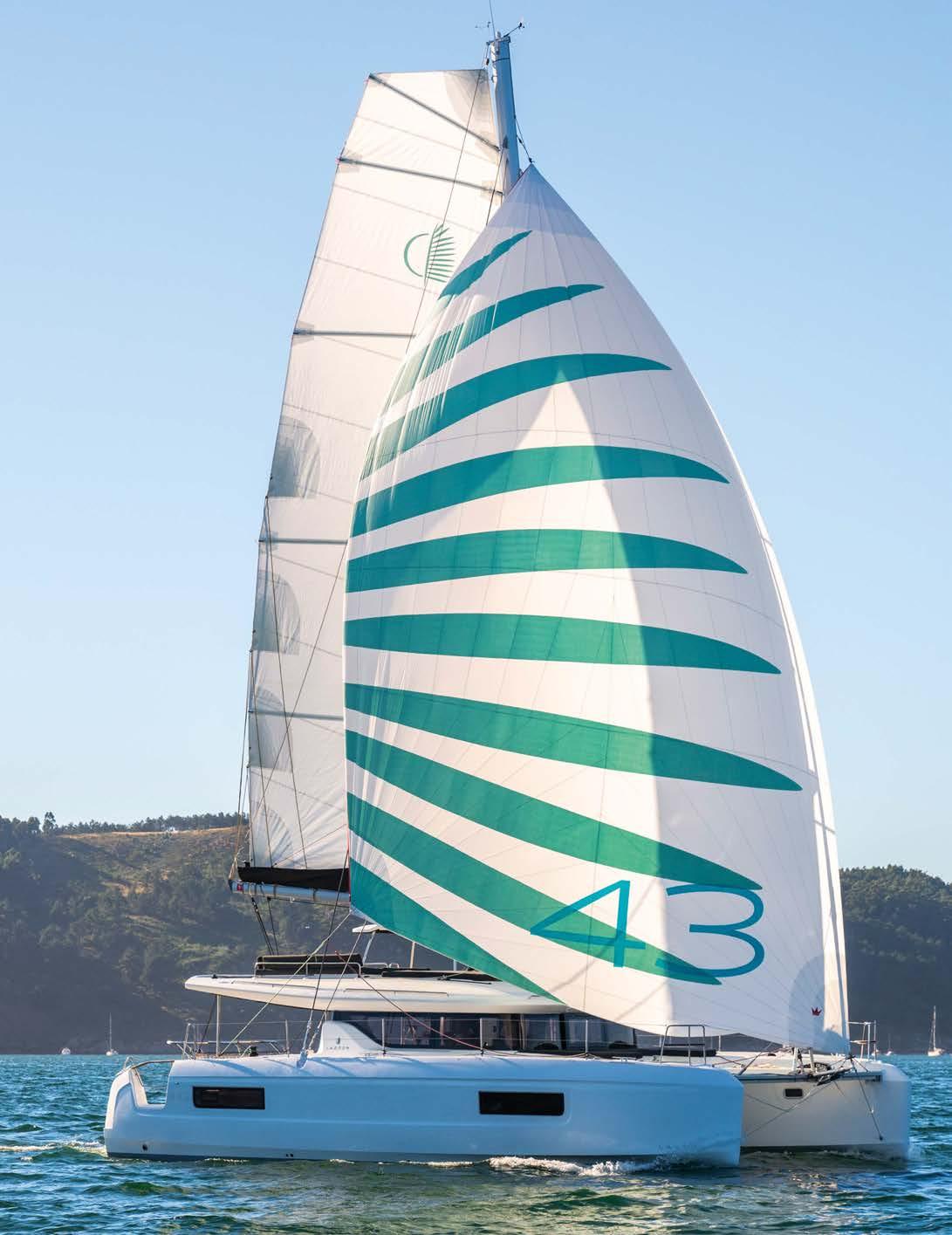
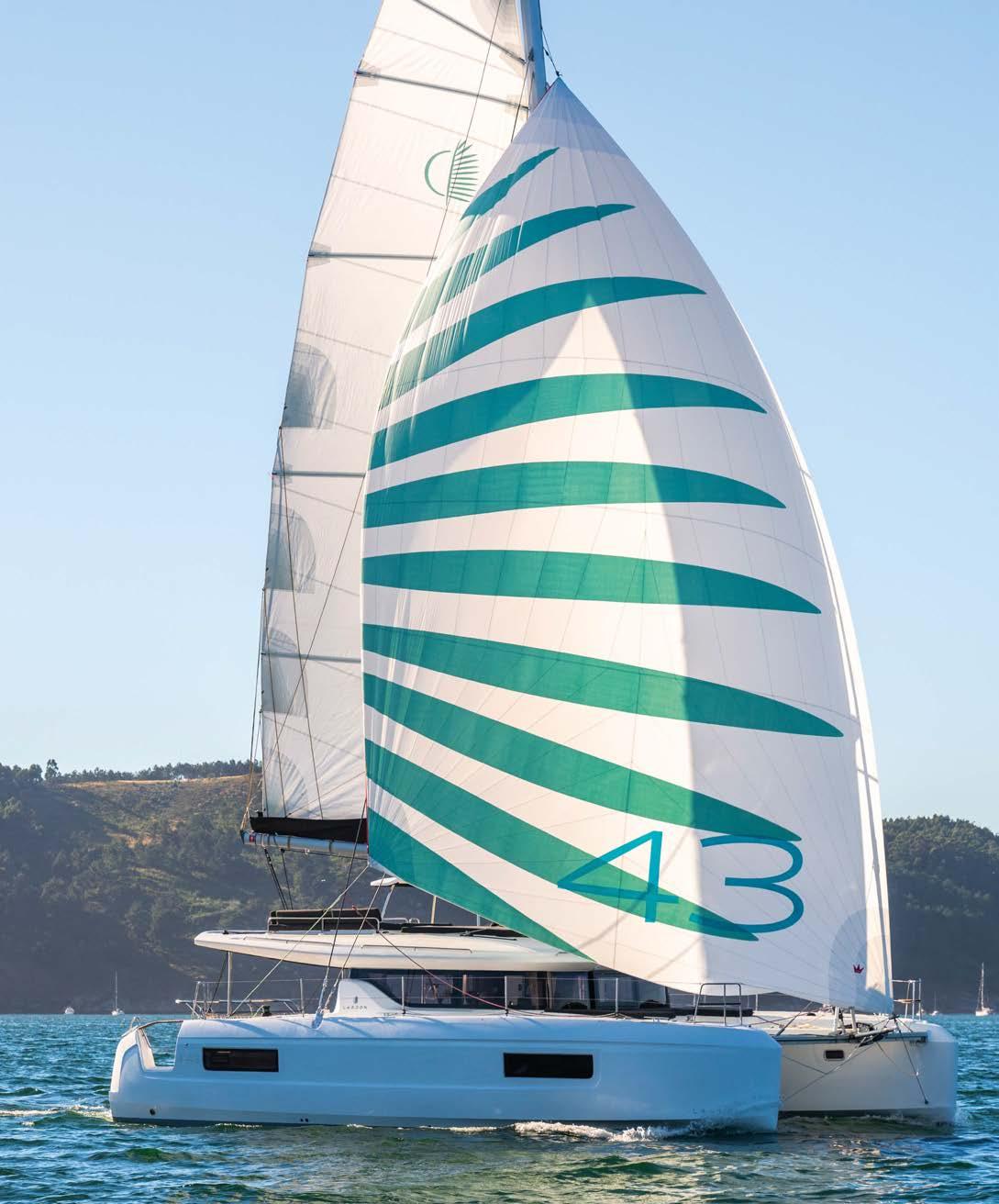
GLI ESTERNI SONO STATI
DISEGNATI DA PATRICK LE QUÉMENT. LO STUDIO VPLP
HA FIRMATO L’ARCHITETTURA
NAVALE E NAUTA DESIGN
HA PROGETTATO GLI INTERNI. UN TEAM CONSOLIDATO
CHE HA CONCEPITO UN’IMBARCAZIONE VERSATILE E SORPRENDENTE
PATRICK LE QUÉMENT
CREATED THE EXTERIORS, THE VPLP STUDIO DID THE NAVAL ARCHITECTURE, AND NAUTA DESIGN CREATED THE INTERIORS. THIS CONSOLIDATED TEAM HAS DEVELOPED A VERSATILE AND SURPRISING BOAT
by Sacha Giannini
photo by Julien Gazeau
Sebbene la nautica da diporto non abbia ancora trovato oggi la sua vera identità e vive nella costante ricerca di soluzioni “evolutive” e risposte d’avanguardia, è tuttavia sempre più convinta che per identificarsi e distinguersi, debba trasferire e adattare allo scafo un’abitazione o qualche suo vincente schema edilizio. In questo scenario di incognite e astrazioni Lagoon conserva, con l’audacia del progresso, il buon senso tra tutte queste “combinazioni” all’interno di una finestra temporale che va ben oltre le smanie dei cambiamenti tout court. Lagoon, come produttore mondiale di catamarani a vela, aggiorna costantemente i propri scafi con un’operazione di sottrazione da imitazioni e facili manierismi. Dalle ispirazioni “automotive” per gli chassis e il car design, a quelle più “edificatorie” delle case sull’acqua, Lagoon, nei suoi primi 40 anni di attività, ha assorbito e dettato mode con sperimentazioni e
un coerente uso del design, del buon senso, delle proporzioni e degli equilibri tra volumi, tecnologia e marketing. Lagoon si interroga costantemente sui valori più “giusti” da associare al prodotto diportistico, dallo styling alle tecniche costruttive, fino al concetto e alle previsioni di durata attraverso anche i programmi di refit NEO che restituiscono nuova vita all’usato Lagoon con un upgrade e refresh Standard, Silent o Premium Pack per un obiettivo sostenibile di riuso della vetroresina attraverso una ricomposizione quasi archeologica, “anastilotica” dei pezzi originali smontati e rinnovati e una garanzia di 2 anni come nel nuovo. Sebbene riconoscere che un prodotto industriale, come un catamarano di serie, nasce con una vita predeterminata lunga quanto quella necessaria per preparare il modello successivo, riesce a programmare innovazione e ricerca senza molte scadenze e senza fermarsi
mai a facili “travestimenti” e alle sole dimensioni che contano. I nuovi Cat Lagoon “midsize” 43 hanno LOA e Beam contenuti, ideali per la famiglia e per il diporto poiché attrezzati di tutto il necessario non solo per arrivare, ma per viaggiare, ed è proprio in questo intervallo tra l’inizio e la fine del viaggio che trovano la loro forte espressione di servizio e di accoglienza. Il nuovo 43, che aggiorna il precedente 420, bestseller del marchio con più di 1.000 vari alle spalle dal 2016, senza esporsi più di tanto all’insolito, rimane nell’abituale, nel sicuro, cadenzando forme e ritmi di bordo con nuovi aggiornamenti di spazio e d’uso, invitando il viaggiatore spaesato e non abituato alla “fissa dimora”, verso una nuova esperienza in mare, personalizzata e immersiva in un comfort sempre più familiare. In questa nuova veste, il 43 offre attenzioni e cure, aggiungendo soluzioni pratiche e veloci sia per navigare a vela, sia per essere comode house boat. In particolare: un ingresso laterale sulle due murate in zona poppiera garantisce accessi facili e sicuri con ormeggi all’inglese, la timoneria a mezzanino in coperta lato sx permette un pieno controllo della visibilità sia a vela, sia in fase d’ormeggio, il ybridge e il pozzetto di prua sono entrambi abitabili con comodi prendisole e divani, il tavolo modulare da 6 posti all’interno del decksaloon si estende all’occorrenza al pozzetto in modalità “inside-out” per ospitare fino a 12 persone, combinando divani e pavimento alla nuova configurazione.

È una barca piena di sorprese, di livelli e calpestii, ben articolata con uno stampo virtuoso con soluzioni disegnate e un controstampo alla ricerca di massimi spazi e comfort. Nella versione a 3 cabine, l’armatoriale ha l’intero scafo di dritta a disposizione per un letto matrimoniale a prua e un

bagno con doccia a poppa, spazi di stivaggio e percorsi da suite d’albergo! In entrambe le versioni da 3 o 4 cabine i letti matrimoniali “a isola” hanno tutti la stessa dimensione, grazie ad un aumento dei masconi che permettono di recuperare ben oltre 50 cm a prua con una fascia di bordo che avvolge le murate e sovrappone gli scafi creando un gradino simile a un “chine at su ogni lato, un “ginocchio” fuori galleggiamento con doti stabilizzatrici all’ancora per rollii sfuggiti al controllo di carena. Un’altra novità in casa Lagoon è la cucina a baglio che guarda a prua, funzionale alla grande apertura tra dinette e pozzetto, ma un po’ meno per la perdita di comodi pensili e sportelli che per ovvie ragioni di visuali sono dovuti slittare sottopiano. Interessante è la soluzione del divano ad estrema poppa con lo schienale basculante come anche le gruette per il tender in acciaio che
La cucina, orientata verso prua e senza mobili alti, o re maggiore spazio di lavoro rispetto al Lagoon 42.
Compared to the Lagoon 42, the bow-facing galley offers more wor space without the high cupboards.
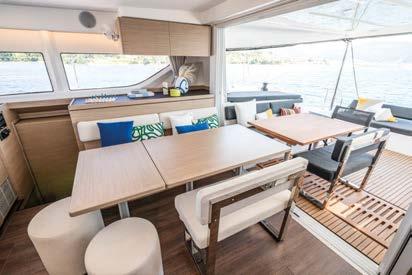


Il tavolo da pranzo è modulare e si estende fino al pozzetto, con la possibilit di ospitare fino a dodici persone. uesta funzionalit resa possibile dalle finestrature pi ampie rispetto ai modelli precedenti, che uniscono gli spazi interni ed esterni, massimizzando l’area dedicata alla convivialit .
The modular dining table e tends into the coc pit to seat up to twelve people. arger windows than on previous models ma e this functionality possible, bringing the interior and e terior spaces together and ma imising the area dedicated to socialising.

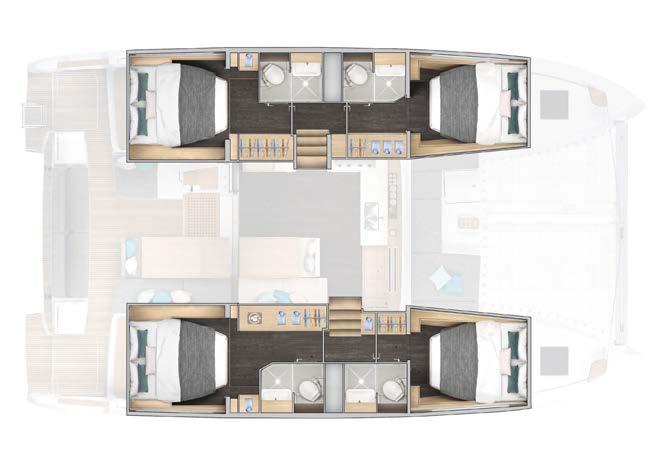
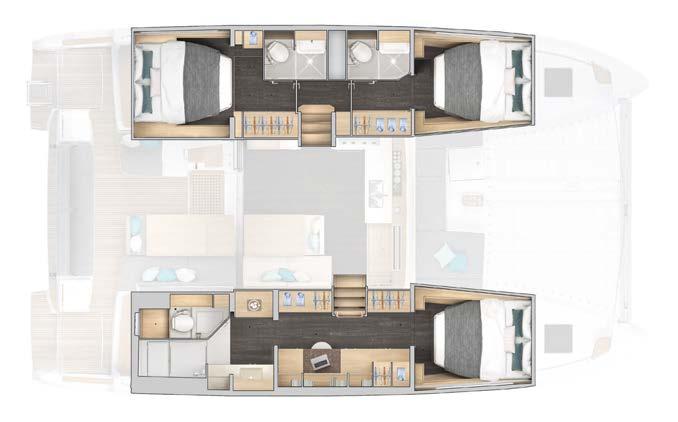
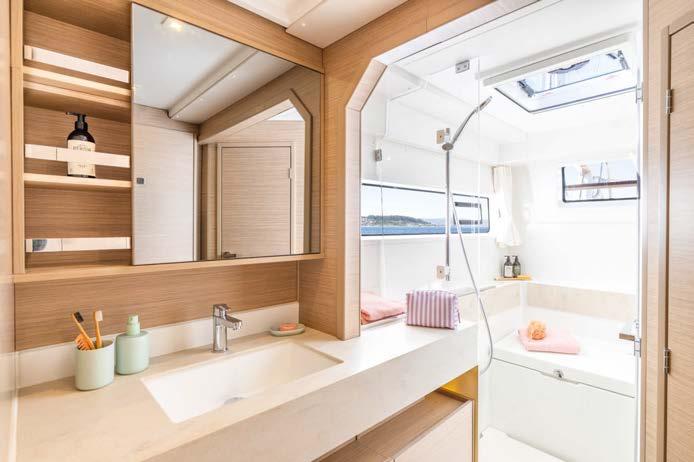
Un nuovo design dello scafo migliora gli spazi interni con cabine pi ampie e un’abitabilit superiore. Nella versione con tre cabine, lo scafo di dritta ospita una lussuosa cabina armatoriale con la zona notte a prua e un bagno con doccia separata a poppa, garantendo comfort e privacy a livello di una suite d’albergo.
new hull design enhances the interior space with larger cabins and superior livability. n the three-cabin version, the starboard hull features a lu urious master stateroom with a forward berth and an aft en suite with a separate shower, providing hotel suite-level comfort and privacy.

rispettivamente permettono di sedersi guardando verso prua o verso il mare e di trasformarsi in modo facile e rapido in una comoda piattaforma prendisole. Nel nuovo piano velico è previsto di serie, in sostituzione del fiocco autovirante del modello precedente, un Genoa sovrapposto con una superficie notevolmente più ampia, favorendo così anche alle brezze leggere di garantire più potenza grazie pure al generoso Code Zero opzionale per le andature portanti. La comoda seduta imbottita della timoneria è un po’ bassa rispetto alla consolle e al sistema ruota/ strumenti/visibilità, ma basterebbero poco meno di 10 cm in più per avere una postura e visibilità perfetta, grazie anche alla posizione ideale di governo “a mezzanino” sul ponte di coperta che permette ogni angolazione. Sempre in zona timoneria, la pedana poggiapiedi per rialzarsi in fase di ormeggio o per scrutare meglio prua e orizzonte è un po’ troppo vicina al timone con il rischio di attriti e usure di scarpe o stivali da barca, che tangenti al diametro della “ruota”, si ritrovano quasi d’impiccio! Il comando elettrico del trasto randa, per regolare il binario ad estrema poppa del y, è forse un po distante dal timoniere per una gestione autonoma della regolazione vele senza aiuti di familiari o amici al seguito. Per ultimo ma non per importanza, in tuga vicino all’albero, due tientibene a cavalletto sarebbero ben visti da armatori neofiti o improvvisati familiari marinai, per regolare in sicurezza lazy jack, lazy bag, cerniere e drizze.
Nonostante queste piccole e personali avvertenze, la barca è piena di ottime soluzioni, è oggettivamente armoniosa, pulita ed estremamente comoda. Durante il sea trial di Palma di Maiorca il meteo è buono, il mare è calmo e i venti sono tesi tra 10 e 15 nodi reali. Siamo 7 a bordo, Con il 50% di acqua su 300 litri totali e il 100% di nafta su 570 litri, sono armati randa e nuovo Genoa sovrapposto (circa 105 m2 totali) e con 13,8 nodi di vento reali su una bolina stretta di 45-50 gradi procediamo a velocità di 6,2 nodi. Il vento aumenta con raffiche fino a 1 ,8 - 17 reali e la SOG raggiunge , - 7 nodi, davvero buoni per un cat sotto bolina stretta. Poggiando progressivamente verso i 60° si guadagna velocemente quasi mezzo nodo, fino a toccare 7,1 nodi e 7,5 con un leggero rinforzo di vento a 17,5 nodi reali. Al traverso con 90° e soli 10 nodi di vento decidiamo di issare il



DISLOCAMENTO DISPLACEMENT
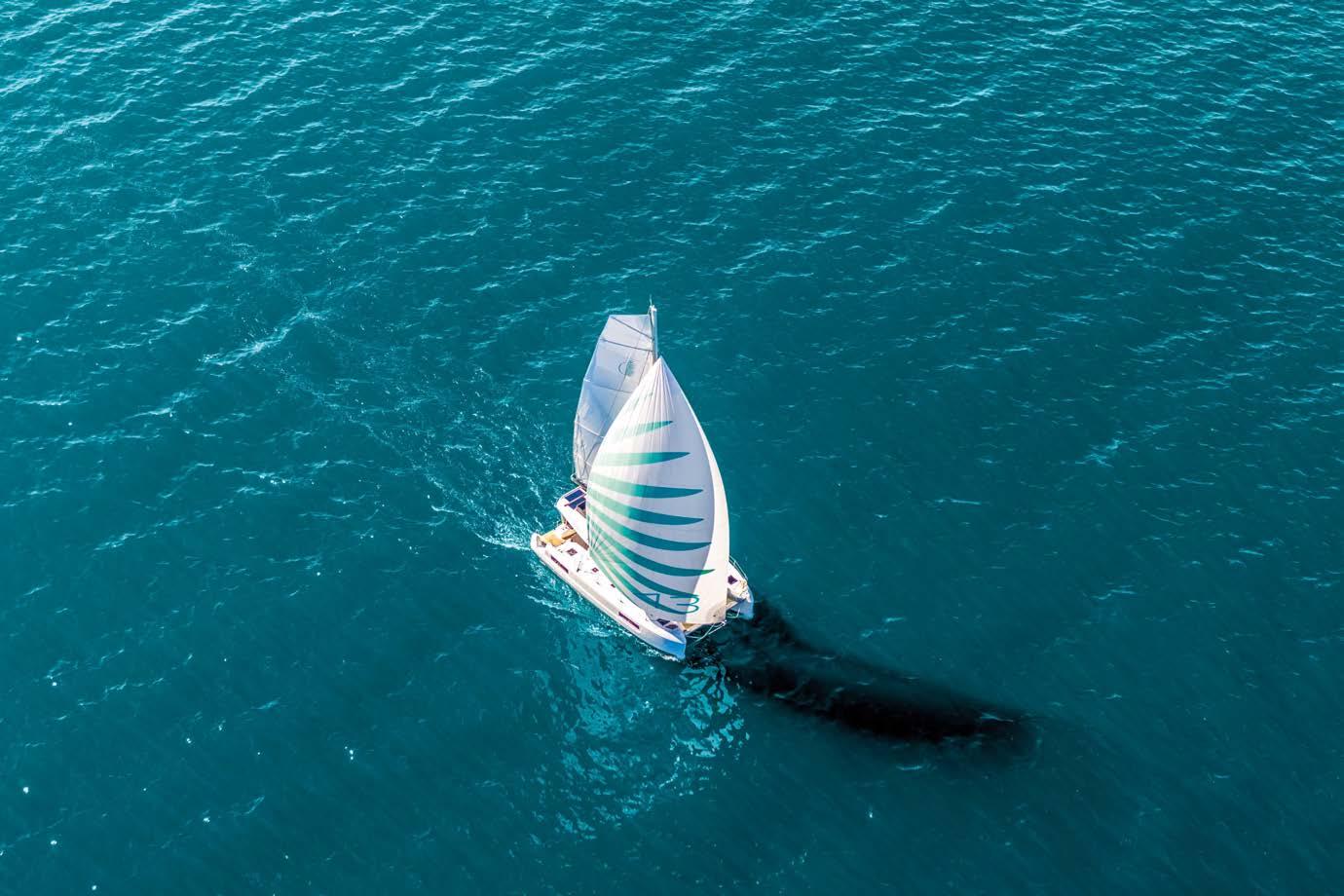

Per essere un catamarano da crociera, dimostra tutta la sua abilit a vela e, senza grosse pretese, naviga indisturbato e silenzioso anche a motore. A 6 nodi e 2100 consuma di circa 10 l/h per coppia motori e pu percorrere fino a 340 miglia nautiche come best range cruising. or a cruising catamaran, it shows its true colours under sail and, without any pretensions, sails smoothly and uietly, even under power. t nots and 1 rpm, it burns around 1 litres per hour per pair of engines and can cover up to 3 nautical miles in the best cruising range.
Code Zero e riprendiamo velocità a 7 nodi, poggiamo fino a 120 al lasco e il vento a 8 nodi spinge il Cat a 5,5 – 6 nodi di sog. L’angolo di virata con 50° di mura è superiore ai 100° e un po’ lentamente si riprende assetto e corsa senza perdersi per strada.
Even though modern-day yachting hasn’t yet found its true identity and lives in the constant search for “evolutionary” solutions and cuttingedge answers, the sector is nevertheless increasingly convinced that to create an identity and set itself apart; it will have to transfer a dwelling to a hull and adapt it, or at least some winning recipe from the building trade. In a situation with unknowns and abstractions, Lagoon has steered – with the audacity of progress – a straight line of good
a timeframe which goes far beyond the yearnings of change for change’s sake. As an international producer of sailing catamarans, Lagoon is constantly updating its boats by eliminating any imitation or facile affectation. From inspiration drawn from the automobile industry and the chassis and designs of cars to attempts to build houses on water, in its first forty years in the business, Lagoon has absorbed and also laid down fashion with experimentation and coherent use of design of common sense, proportions and balance between volumes, technology and marketing. The yard constantly re-evaluates the correct values associated with its yachting output, from styling to construction techniques to the design concept and lifespan estimates. It also offers a neo-refit programme to give

upgrades, or refresher programmes, come in Standard, Silent or Premium versions for a sustainable goal of reusing fibreglass through a diligent, practical archaeological, conservative recomposition of the original pieces, which are taken apart and renewed. It comes with a two-year guarantee, the same as for new builds. Although the firm recognises that an industrial good such as a production line catamaran is created with an output timeframe that only lasts as long as it takes to put the next model together, it manages to establish an innovation and research programme without many deadlines and without ever limiting itself to simplistic disguises and just to the dimensions that count. This new midsize catamaran, the Lagoon 43, is neither too long nor too broad and is ideal for a family and for yachting since it is fitted out

La timoneria a mezzanino, tipica anche dei modelli minori, migliora la manovrabilità e la visibilità, rendendo la barca gestibile in equipaggio ridotto.
The raised wheelhouse, a typical feature of the smaller models, improves manoeuvrability and visibility, making the boat easier to handle with a smaller crew.
L’ampio ybridge con prendisole e divani a C e un’area relax a prua, sono gli spazi ideali per indimenticabili aperitivi al tramonto.
The spacious ybridge, with a sundec , -shaped sofas, and a rela ation area in the bow, is ideal for unforgettable sunset aperitifs.
with everything you need not just to get somewhere but to travel. And it is precisely in that time between setting off and arriving that it finds its true expression in terms of the welcoming feel that it provides. The new 43, which is an update on the brand’s best-selling (with over a thousand units built since 2016), hasn’t ventured that much into the unknown and has stuck with what it knows, with tried and tested choices by creating shapes and rhythms on board with new uses for spaces. This invites disorientated travellers with no fixed abode to enjoy a new experience on the sea that is personalised and immersive and has a comfortable, family feel. In this new set-up, the 43 delivers attentive, carefully conceived and practical solutions that make it sail faster and work as a comfortable place to spend time. Examples of this include the side access aft on the two anks, which makes things easier and safer when moored side-on, while the mezzanine level steering position on the port side of the deck gives you full sight of everything, either with the sails up or when mooring. The ybridge and the forward cockpit area have comfortable sun pads and sofas. At the same time, the versatile six-person table in the main salon can be extended into the cockpit – the ooring and sofas all adjust to this new 12-seater configuration.
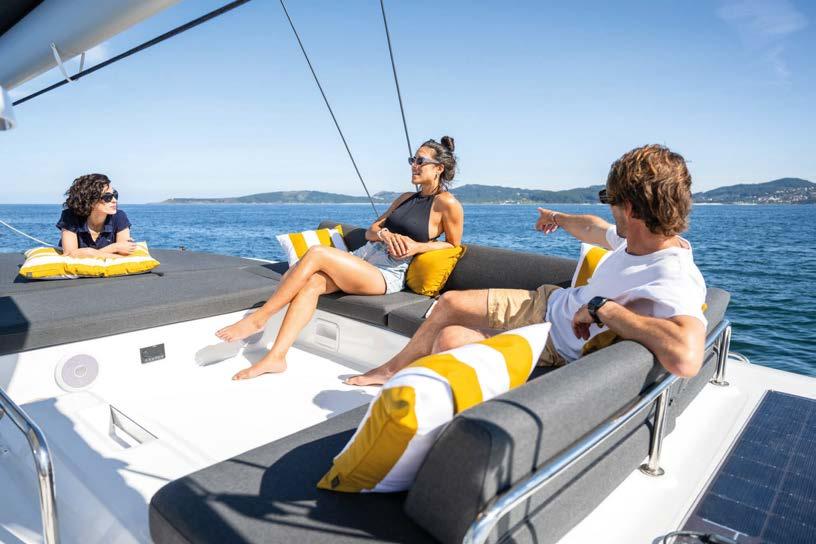
The boat is full of surprises, with various levels nicely brought together, a nice layout and sound, and comfortable areas with maximised spaces. In the three-cabin version, the master room is an entire starboard hull for its double bed (forward), bathroom with shower aft, luggage storage, and hotel-level finish. In both the three- and four-room models, all double beds that do not touch the sides are the same size, thanks to an increase in the length of the bow section. That has meant that over fifty centimetres have been recovered in the bow with a band edging that covers the sides and overlaps the hulls to create a step similar to a chine at on each side and a “knee” beyond the waterline with stabilising benefits at anchor to stop
rolling. Another development is that Lagoon has installed a full-beam kitchen that looks forward, which works well in the large opening between the dinette and cockpit. It is not so good that they have removed some helpful wall units and cabinets, which, for obvious reasons, have had to be moved below the top to allow a view out. Other interesting solutions are the sofa right in the stern, which has a reclinable back, and the steel tender cranes, which mean you can sit down and look forward or at the water, which can easily be used to create a comfortable sun pad platform. The new sail plan has a much larger overlapping Genoa as standard, replacing the self-tacking jib from the previous model. Thus, the plan maximises lighter winds, and the sizeable Code Zero (which comes as optional) delivers more power downwind. The comfortable padded helm seat is a bit low regarding the console, wheel/instruments, and eyelines. It would only take slightly under ten extra centimetres to have perfect posture and visibility, also thanks to the ideal “mezzanine” steering position on the upper deck, which accommodates every possible angle. Staying in the bridge area, the footrest to stand higher while mooring or to scan the bow and horizon is a bit too close to the helm, and you risk scraping your boat shoes, touching the edge of the
wheel, which is nearly in the way. To adjust the rail at the extreme aft section of the ybridge, the mainsail traveller s electrical control is perhaps a bit too far from the helm for the sails to be trimmed without the help of family members or friends. Lastly, owners or guests new to sailing might have liked to see a pair of grab handles on the coachroof to stay safe while adjusting the lazy jack, bag, zips and halyards. Despite those minor quibbles, the boat is full of excellent ideas, has harmonious, clean lines, and is extremely comfortable. The weather and the sea were calm during the trial off Palma de Mallorca, with a stiffish breeze coming in between 10 and 15 knots. There were seven of us, with the 300-litre water tank half full but all 570 litres of fuel on board. With the mainsail and new overlapping genoa (around 105 m2) and 13.8 knots of true wind, we were close-hauled at 45-50 degrees and did 6.2 knots. The wind picked up with gusts of 1 .8 or 17, and the SOG increased to . or 7 knots, suitable for a cat sailing close hauled. It reached 7.1 and even 7.5 knots, and the actual wind speed rose to 17.5. On a beam reach and with the wind at just ten knots, we bore away to a broad reach at 120 degrees, and the 8-knot wind got us to 5.5 or knots SOG. e turned at over 100 degrees with a 50-degree sheeting angle, and – albeit relatively slowly – we settled down and got back on course without losing our way.
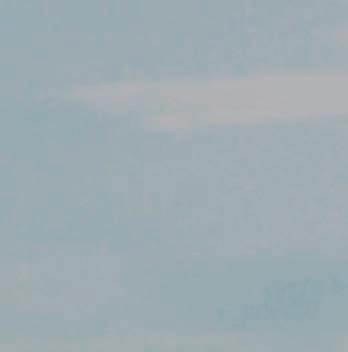
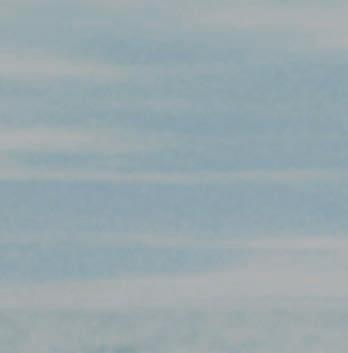


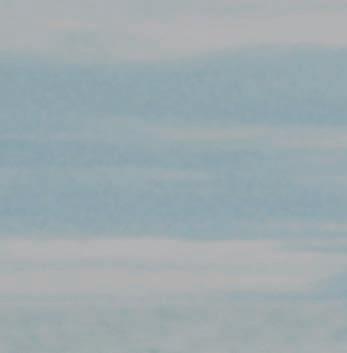
AMPIE SUPERFICI ALL’APERTO, BUONI VOLUMI INTERNI E DUE SCAFI CHE GARANTISCONO MOLTA STABILITÀ IN NAVIGAZIONE E ALLA FONDA. È TUTTO QUEL CHE SERVE PER LA CROCIERA THERE IS PLENTY OF OPENAIR SPACE, GOOD INTERNAL VOLUME, AND TWO HULLS THAT DELIVER GOOD STABILITY WHEN UNDERWAY AND AT ANCHOR. IT HAS EVERYTHING YOU NEED FOR A CRUISE
by Niccolò Volp i
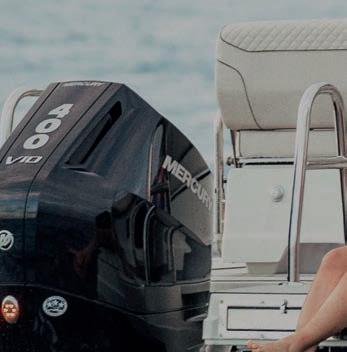

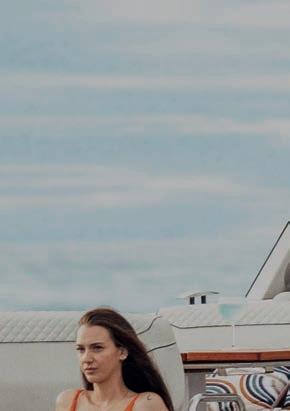



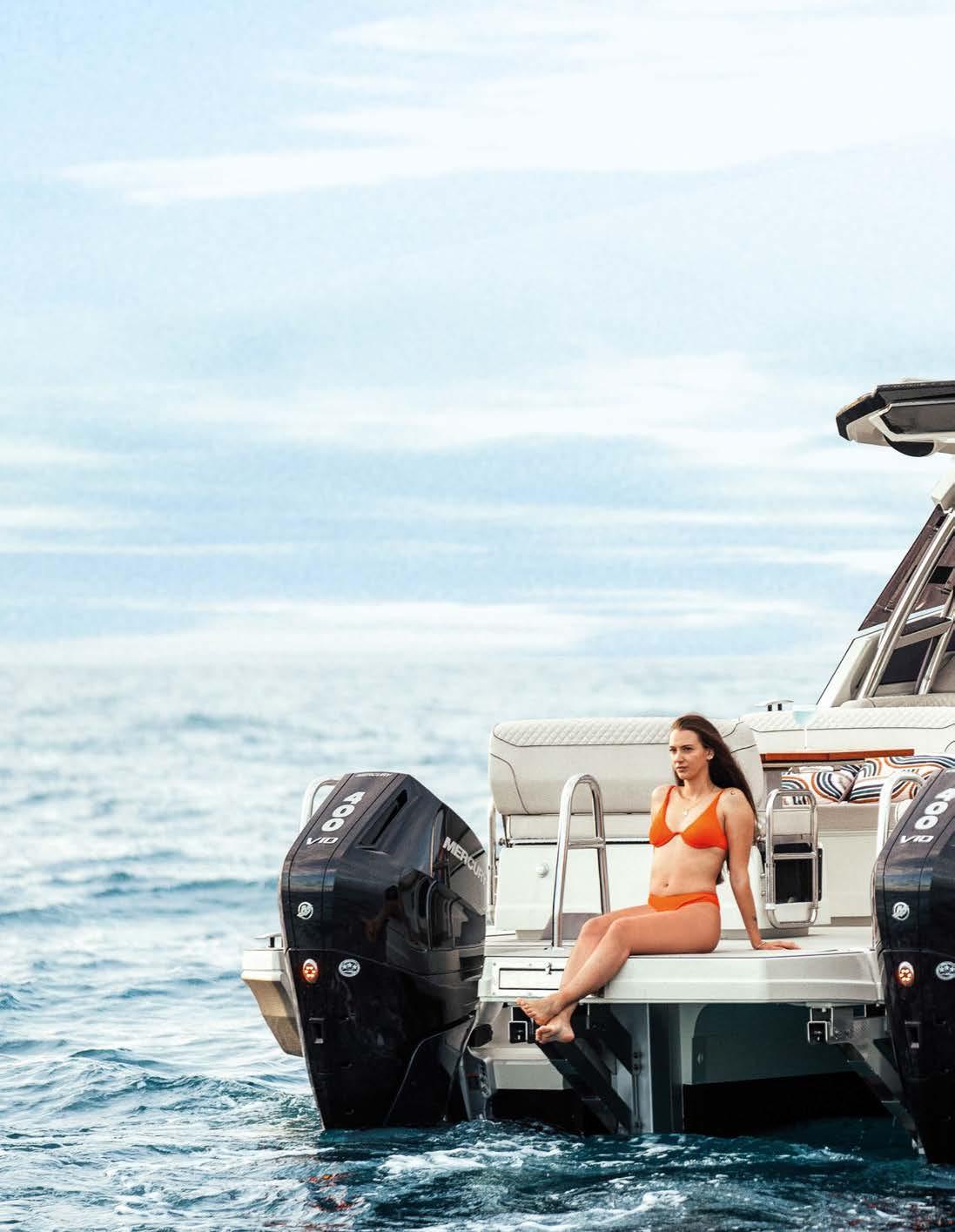


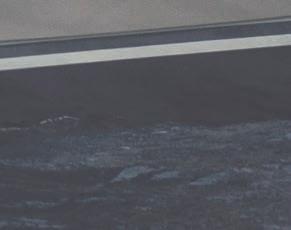
12.57m

Yot è un brand creato da Catana che, oltre ai catamarani a vela Catana e Bali, ha deciso di investire nei modelli a motore. Lo ha fatto con convinzione, tanto che l’investimento è stato di 40 milioni di Euro con l’apertura di un cantiere in Portogallo dove vengono prodotte tutte le unità a motore. La struttura sta per essere ultimata e l’azienda prevede che, a regime, possano realizzare 400 multiscafi all’anno. Attualmente sono in produzione il nuovo 41, presentato a settembre al salone di Cannes, e il 36, lanciato solo un anno prima. A breve sarà la volta di Yot 46 che andrà a completare la gamma fuoribordo. Nel 2026 e 2027 sono previsti modelli più grandi con motorizzazione entrobordo. Il primo sarà un 50 piedi.
Yot is a brand created by Catana that has decided to invest in powered craft and its sailing catamarans Catana and Bali. It made a decisive move, investing forty million euros and creating a yard in Portugal where all motorised cats are produced. This facility is about to be finished, and the company e pects it to have an annual capacity of 400 units. It is currently turning out the new 41 (presented in September at the Cannes show) and the 36, which debuted just a year prior. And shortly, it will be time for the Yot 46, which will complete the outboard-powered range. More e tensive models with inboard engines are e pected in and , of which the first will be a -footer.

Sono nati prima l’esigenza di ampi spazi a bordo o i catamarani a motore? Non ho la risposta e, del resto, penso non ce l’abbia nessuno. I multiscafi a motore, ormai lo sanno anche i pesci pelagici, non sono semplici catamarani a vela senza albero e con due propulsori a poppa. Sono progetti sviluppati appositamente e non semplici adattamenti. O, almeno, così avviene sempre più spesso. Qual è la differenza? I due scafi non sono così tanto distanti tra loro come avviene su quelli a vela. Le superfici a disposizione sono comunque enormi e si ottiene un’ottima navigabilità anche perché non c’è bisogno di contrastare lo sbandamento provocato dalle vele. Un catamarano a motore è stabile. Lo è in navigazione e lo è alla fonda. E questa è la prima caratteristica che ho notato in Yot 41, l’ultimo nato di Yot Power Catamarans, il brand dedicato ai multiscafi a motore di Catana. Mentre viri, gli scafi sono incollati sull’acqua, nulla si inclina, ma temi che da un momento all’altro ti capiti di scuffiare. Non è così a bordo di Yot 41. Si può virare, anche stretto a velocità sostenuta, e farlo senza alcuna preoccupazione, anzi senza nessuna brutta sensazione. Due scafi significano anche meno resistenza idrodinamica e infatti Yot 41 con due Mercury V10 da 400 cavalli ciascuno supera i 33 nodi di
L’allestimento è simmetrico tra uno scafo e l’altro. Due cabine con grande cuccetta e bagno con box doccia separato.
The layout is symmetrical between one hull and the other—two cabins with large berths and a bathroom with a separate shower compartment.

VELOCITÀ MAX NODI TOP SPEED KNOTS 33.4

AUTONOMIA MN RANGE NM


RAPPORTO PESO POTENZA MASS OUTLET POWER 14 kg kw
RAPPORTO LUNG./LARG. L/W
YOT POWER CATAMARANS – CATANA GROUP
Zone Technique du Port F-66140 Canet-en-Roussillon (France) T. +33 (0)4 68801313 www.yot-power-catamarans.com
PROGETTO
J&J Design
SCAFO
Lunghezza f.t. 12,57m • Larghezza massima 4,49m
• Pescaggio 1,13m • Serbatoio carburante 1. l
• Serbatoio acqua 400 l
MOTORI
2x Mercury Verado V10-400 • Potenza 294 kW (400 cv) • Cilindrata , l • 10 cilindri a V • Rapporto di riduzione 2.08:1 • Regime di rotazione 5800-6400 giri/minuto • Peso 316 kg
CERTIFICAZIONE CE CAT B
PREZZO
475.000 € con 2x Mercury V8 da 300 cv (standard)
PROJECT
J&J Design
HULL
LOA 12.57m • Maximum beam 4.49m • Draft 1.13m
• Fuel tank volume 1. l • Water tank volume 400 l
MAIN PROPULSION
2x Mercury Verado V10-400 • Outlet mechanical power 294 kW (400 hp) • Swept volume . l • 10 V-shaped cylinders • Compression ratio 2.08:1
• Maximal rotational speed 5800-6400/min
• Weight 316 kg
EC CERTIFICATION CAT B
PRICE
475.000 € powered with 2x Mercury V8 of 300 hp (as standard)
CONDIZIONI DELLA PROVA CONDITIONS ON TEST
Località//Place Canet-en-Roussillon – France
Altezza onda//Wave height 40 cm
Vento forza//Wind speed 3 nodi//knots
Persone a bordo//People on board 4
Carburante imbarcato l
Fuel volume on board
Acqua imbarcata l Water volume on board
VELOCITÀ IN NODI SPEED IN KNOTS
Da 0 a planata in 5 secondi
Gliding time of 5s from 0 to glide
Da 0 a velocità massima in 37 secondi
Gliding time of 37s for a speed change from 0 to 33.4 knots (maximum speed)
2.8 LITRO MIGLIO (VELOCITÀ DI CROCIERA) L/ NA MI (CRUISING SPEED)
6.8

velocità massima consumando meno di 260 litri/ora totali. Ma è alle andature di crociera che si apprezzano ancor di più le caratteristiche di questo catamarano. Per navigare a 25 nodi bastano 170 litri/ora e a 20 nodi ne servono circa 120. Gli altri aspetti positivi della navigazione sono la visibilità, che è sempre ottima, e la sensazione di protezione. Il parabrezza e l’hardtop
L’unico aspetto non troppo convincente riguarda le due terrazze sulle fiancate del pozzetto perché in virata lasciano entrare parecchia acqua che arriva in pozzetto, soprattutto quando il mare è un po’ formato. La coperta e l’estensione della superficie a disposizione è, ovviamente, l’altro grande vantaggio di un catamarano a motore. Yot 41 misura dodici metri e mezzo di lunghezza per quattro e mezzo di larghezza. Aprendo le fiancate a poppa, la larghezza arriva addirittura a 5,8 metri. In tutto, con le terrazze aperte, la superficie della coperta è di ben 53 m2. E i vantaggi del multiscafo si notano anche a poppa.

Tra i due propulsori, infatti, c’è la piattaforma immergibile. In questo modo, nonostante la motorizzazione sia fuoribordo, si ha una spiaggetta di poppa che solitamente non si incontra se non su barche che hanno i piedi poppieri. Il progetto, curato interamente da J&J Design, prevede un camminamento centrale per accedere a prua, simile a quello dei bow rider americani. Anziché i passavanti laterali in stile walkaround, Yot 41 ha un unico camminamento centrale che sfrutta il portello al centro del parabrezza. È largo, comodo e sicuro. Molto meglio di due passavanti stretti e con pochi punti dove attaccarsi. Con questa configurazione si pu accedere a prua anche durante la navigazione e lo si fa sempre in sicurezza. Inoltre, gli arredi sono tutti doppi. Due doppi divanetti lineari contrapposti con tavolo al centro in pozzetto che si trasformano in prendisole. Due mobili cucina a L, quattro sedute per pilota e copiloti, due per lato e, infine, due prendisole a prua. Il tutto sempre diviso dal camminamento centrale che parte dal pozzetto e arriva fino all’estrema prua. Sottocoperta ci sono due cabine, una per ogni scafo. Entrambe hanno un bagno con box doccia separato e delle cuccette matrimoniali di ben 160 cm di larghezza. Anche l’abitabilità degli interni è decisamente confortevole perché in ogni ambiente c’è un’altezza di circa due metri. In definitiva, volumi interni, ampiezza delle superfici all’aperto e prestazioni, fanno sì che Yot 41 interpreti alla perfezione la barca da crociera moderna.
Tanti divanetti che si trasformano facilmente in prendisole in pozzetto e altri prendisole a prua. C’è solo l’imbarazzo della scelta.
There are many sofas in the cockpit that easily convert to sunbeds, and there are more in the bow. You are spoilt for choice.
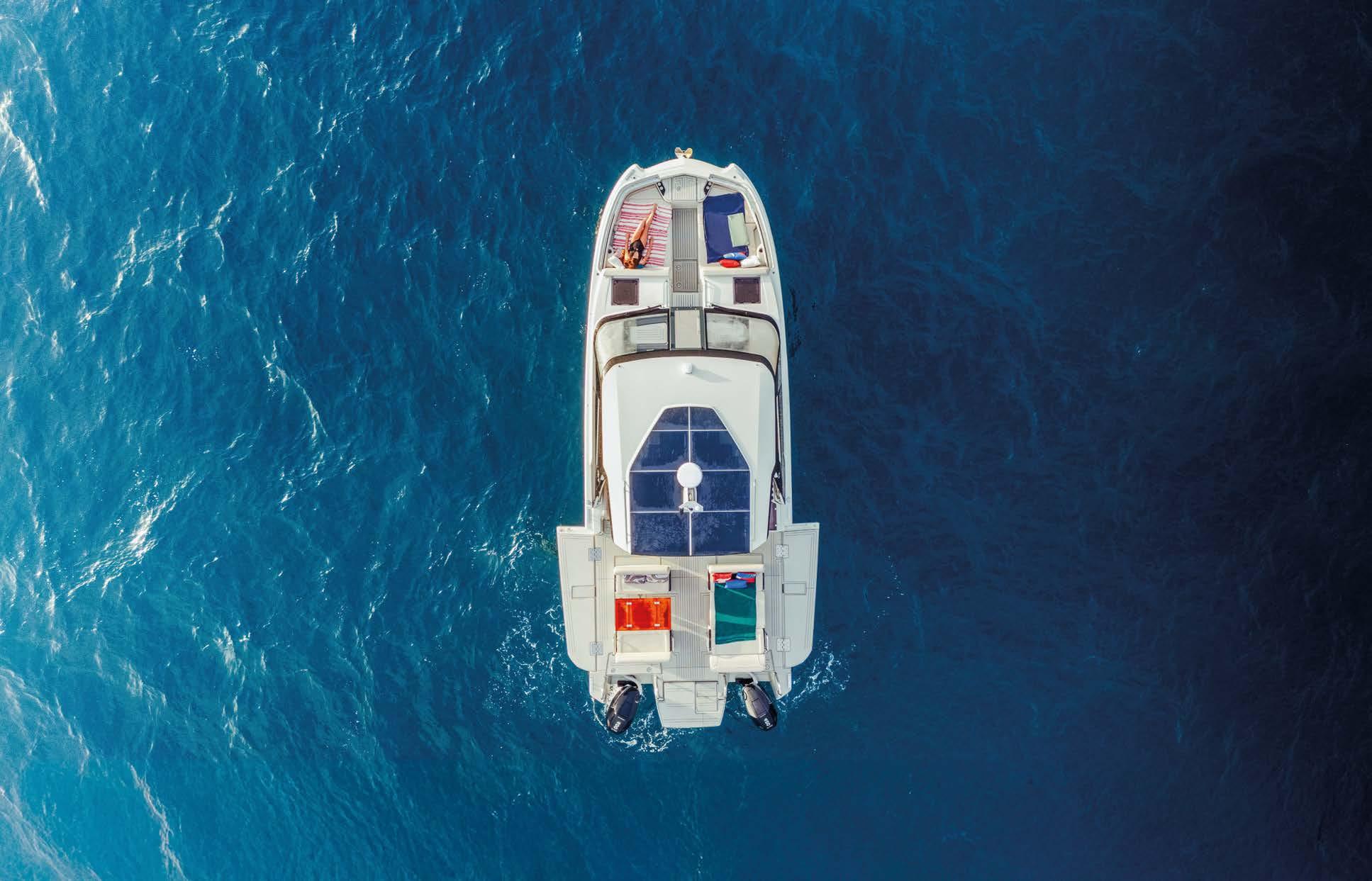
What came first, the need for bigger on-board spaces or powered catamarans? I don’t know the answer, and I don’t think anybody does either. As even the fish now know, powered multi-hulls are not just simply sailing catamarans with the mast removed and two engines added. They are specifically designed and developed rather than just adaptations. Or at least that is what is increasingly happening. What is the difference? The two hulls are not as far apart as they are on sailing cats. Even so, a considerable amount of area is available, and it moves very nicely through the water, so there is no need to counteract the heeling caused by the sails. A powered cat is stable, whether underway or at anchor. That was the first thing that stood out for me in the Yot 41, the latest product from Yot Power
and hardtop protect the helm area but never block the view. The ergonomics are also excellent because the skipper’s seat is just at the proper distance and is comfortable whether sitting or standing when at the wheel. The only thing that isn’t quite as convincing comes from the two terraces on the sides of the cockpit because they let in a fair bit of water when you turn, which gets to the cockpit, especially when the sea is rougher. The deck and the amount of usable space are the other significant advantages of a power cat. The Yot 41 is 12.5 metres long by 4.5 vast, and when you open the sides up in the stern area, that figure increases to as much as 5.8 metres. With the terraces open, the deck surface is 53 square metres. The advantages of having a multihull can also be seen in the stern area. Between the two engines, there is a submergible platform, which means that despite fitting outboards, you still get a stern platform that you don’t usually get except on a boat with stern drives. The development project has been handled entirely by J&J Design, which has included a central walkway to get to the foredeck, similar to what you find on an American bow rider, rather than side decks like on a walkaround. It goes through the hatch in the middle of the windscreen, which is wide, comfortable and safe – making it much better than two narrow gangways with few places to hang on. This setup means you can get to the bows safely even when underway. All pieces of furniture have been doubled up, so two double sofas face one another with a table in the middle in the cockpit, which can be converted into a sun pad. Two L-shaped kitchen

units, four seats for skipper and mates (two on either side), and two sun pads in the bow. This is divided by the central walkway, which starts in the cockpit and goes right to the end of the bow. Below the decks, there are two cabins, one for each hull. They have a bathroom with a separate shower cubicle and double beds 160 centimetres wide. And at nearly two metres throughout, the headroom is good. So essentially, the interiors, the size of the outdoor spaces and the performance all mean that the Yot 41 is a perfect interpretation of a modern cruising boat.

Due Mercury Verado V10 da 400 cv sono perfetti per ottenere prestazioni elevate e consumi contenuti, soprattutto a regime di crociera.
Twin 400hp Mercury Verado V10s are perfect for high performance and low fuel consumption, especially at cruising speed.
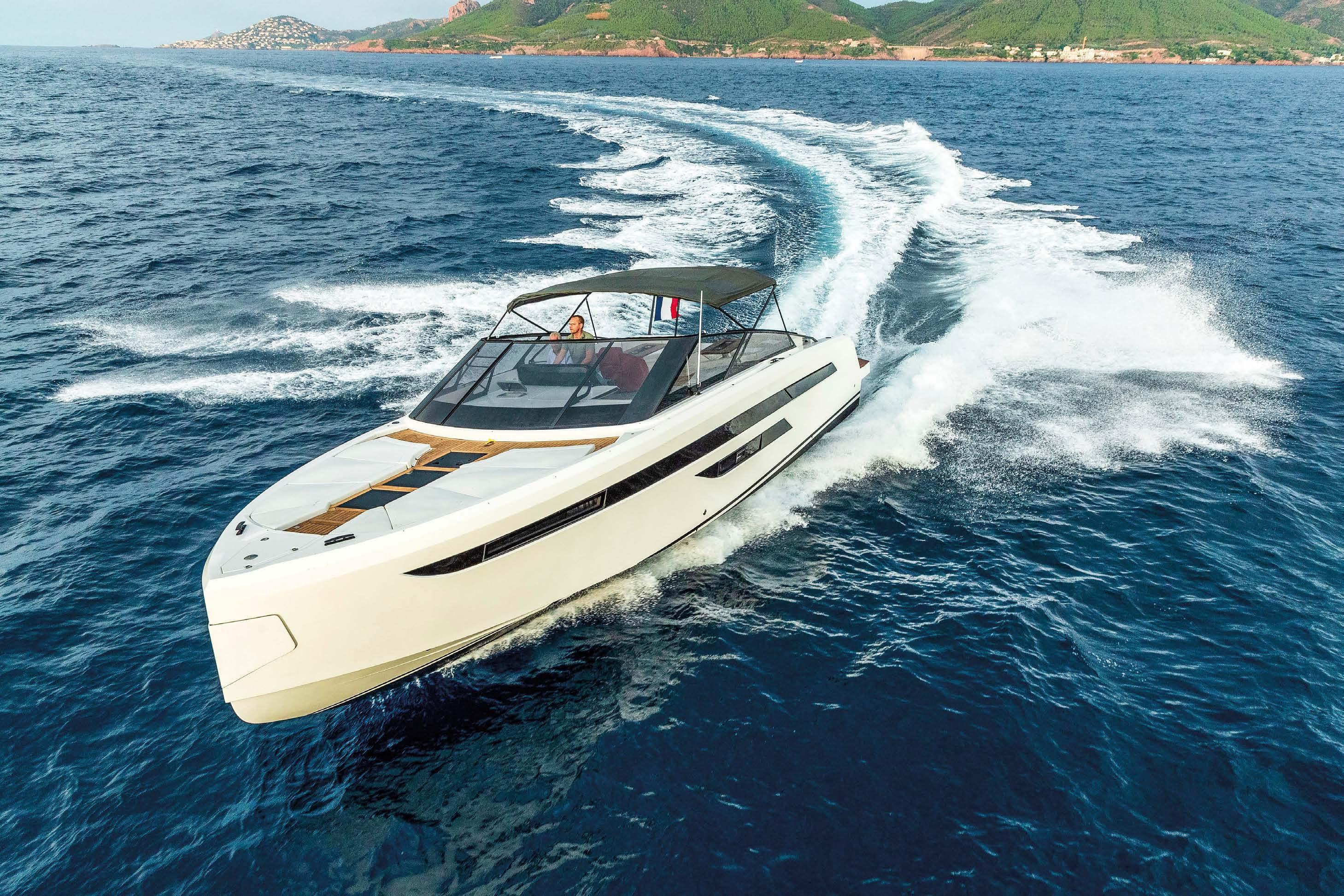
DIVERSA DALLE ALTRE, MA L’ESTETICA NON È LA SUA SOLA VIRTÙ. COMODA, FUNZIONALE, ACCOGLIENTE. L’IDEALE PER UNA GIORNATA AL MARE O PER CROCIERE A CORTO E MEDIO RAGGIO IT’S DIFFERENT FROM THE OTHERS, BUT LOOKS AREN’T ITS ONLY STRONG POINT. IT’S COMFORTABLE, FUNCTIONAL AND WELCOMING. SO PERFECT FOR A DAY ON THE WATER OR SHORT OR MEDIUM-RANGE CRUISING
by Niccolò Volp i

14.25m


Ilnome è evocativo, non c’è dubbio. BB Yachts è un omaggio a Brigitte Bardot. Del resto, la signora Bardot, tra le sue tante doti, ha dimostrato di intendersene di barche. Come dimenticare la foto iconica che la vedeva a bordo di un Riva Aquarama? Il cantiere è nuovo, un piede in Francia, dove ha sede, e uno in Italia, dove le barche vengono costruite. In particolare, quelle più grandi, saranno realizzate a Viareggio. In Costa Azzurra ho avuto modo di testare il 44’ Ischia, che è il primo modello, ma stanno già realizzando un 33’ e nei prossimi mesi sarà la volta del 66’. BB Yachts è arrivata da poco, ma sta indubbiamente bruciando le tappe. Quali sono i meriti del 44’ Ischia? Il primo, che si nota subito, è che finalmente non si tratta dell’ennesimo walkaround. Questa è una taglia nella quale sembra impossibile non realizzare un walkaround e finalmente è arrivato un cantiere che invece non si sottomette a questa regola. Il progetto, tutto curato da Paolo Ferragni, prevede un layout con
Allestimento simmetrico e camminamento al centro. Il risultato è un’ottimizzazione delle superfici a disposizione e la comodità di muoversi in sicurezza da poppa a prua. A symmetrical layout with a walkway down the middle. The result is that the surfaces have been optimised, and it is easy to get around safely from stern to bow.
un passaggio a prua sulla dritta della plancia, mentre il lato sinistro è destinato alla discesa sottocoperta. Il parabrezza occupa tutto il baglio, ma in virtù del portello a dritta che consente di accedere alla zona di prua, non è un ostacolo. Il vantaggio di questa scelta è che la plancia di comando è al centro e contribuisce a dare una sensazione di sicurezza quando si è al timone perché tutto è sotto controllo. L’allestimento della coperta è simmetrico. Da poppa a prua, infatti, il camminamento è sempre centrale. Dopo la piattaforma si incontrano due prendisole da due posti ciascuno, i divanetti con il rispettivo tavolino, uno a dritta e uno a sinistra e perfino la zona di prua ha due prendisole con un camminamento centrale. In alternativa, l’armatore può scegliere un allestimento living della prua con tutto il perimetro occupato da divanetti. Il camminamento centrale, rispetto a quello tradizionale dei walkaround, offre due vantaggi. Il primo è che al centro si è più sicuri a differenza
delle barche che hanno i passavanti laterali. Il secondo è che si spreca meno spazio. È assai improbabile che ci siano passeggeri che si muovano verso prua e altri verso poppa contemporaneamente. Avere due passavanti, uno per lato, fa sì che uno dei due non sia mai utilizzato. Meglio un solo camminamento più largo piuttosto che due sacrificati. La zona centrale della barca, oltre che dal parabrezza a tutto baglio, è protetta da un tendalino. Non c’è hardtop, ma questa soluzione consente di avere una linea più sportiva e meno pesante. Il bordo libero è comunque piuttosto pronunciato, ma lo è per i volumi a disposizione degli interni. Se Paolo Ferragni avesse scelto di aggiungere un hardtop con i montanti o la sovrastruttura in inox per sorreggerlo, avrebbe certamente appesantito le linee della barca. Sottocoperta ci sono quattro posti letto: due nella dinette trasformabile di prua e due nelle cuccette singole di poppa. L’abitabilità è più che sufficiente per non sentirsi in un ambiente ostile.

VELOCITÀ MAX NODI TOP SPEED KNOTS 27.8

AUTONOMIA MN RANGE NM 250


RAPPORTO PESO POTENZA MASS OUTLET POWER

23 kg kw
RAPPORTO LUNG./LARG. L/W
3.4

MELI BB YACHTS
11 rue Poissonière F-75002 Parigi www.bb-yachts.com
PROGETTO
Ferragni Progetti
SCAFO
Lunghezza f.t. 14,25m • Lunghezza scafo 12,99m
• Larghezza massima 4,15m • Pescaggio 1,20m • Dislocamento 15.000 kg • Serbatoio carburante 1.300 l • Serbatoio acqua 350 l • Potenza massima installabile 1.500 cv (versione fuoribordo)
MOTORE
2x Cummins QSB6.7 • Potenza 321 kW (430 cv) • 6 cilindri in linea • Cilindrata 6,7 l • Alesaggio per corsa 107mm x 124mm • Regime di rotazione massimo 3000 giri/minuto • Peso a secco 658 kg
CERTIFICAZIONE CE CAT B
PREZZO
826.000€ Iva esclusa come da prova 698.000€ Iva esclusa – modello base
PROJECT
Ferragni Progetti
HULL
LOA 14.25m • Length 12.99m • Maximum beam 4.15m • Draft 1.20m • Displacement 15,000 kg • Fuel tank volume 1,300 l • Water tank volume 350 l • Maximum rated power 1,500 hp (outboard version)
MAIN PROPULSION
2x Cummins QSB6.7 • Outlet mechanical power 321 kW (430 hp) • 6 in-line cylinders • Swept volume 6.7 l • Bore&Stroke 107mm x 124mm • Maximal rotational speed 3000/min • Dry weight 658 kg
EC CERTIFICATION CAT B PRICE
826,000 Excl. VAT as tested 698,000 Excl. VAT as standard
CONDIZIONI DELLA PROVA CONDITIONS ON TEST
Località//Place Golfe Juan (France)
Altezza onda//Wave height 30 cm
Vento forza//Wind speed 8 nodi//knots
Persone a bordo//People on board 3
Carburante imbarcato 650 l
Fuel volume on board
Acqua imbarcata 170 l
Water volume on board
VELOCITÀ IN NODI SPEED IN KNOTS
Da zero a planata in 5 secondi
Gliding time of 5s from 0 to glide
Da zero a velocità massima in 23 secondi
Gliding time of 23s for a speed change from 0 to 27.8 knots (maximum speed)
5.1
Anche le cuccette di poppa, nonostante rimangano sotto il piano di calpestio del pozzetto, hanno un’altezza confortevole. E, infine, c’è un ampio bagno in un locale separato. In definitiva, si tratta di un allestimento che garantisce il giusto comfort per crociere a corto e medio raggio per quattro persone. BB 44’ Ischia offre anche un altro evidente vantaggio la gamma di possibili motorizzazioni è molto ampia. Si può scegliere tra gli entrobordo Cummins di varie potenze oppure una tripla motorizzazione fuoribordo con addirittura tre Mercury V10 da 500 cavalli ciascuno. Insomma, chi lo desidera può optare per una motorizzazione molto più potente rispetto a quella che ho avuto a disposizione durante la prova e non lo dico perché i Cummins non mi abbiano convinto, anzi. Alla massima velocità sono arrivato a sfiorare i
Il pacco batterie è consistente e assicura 12 ore di autonomia in rada anche con l’aria condizionata accesa.
The battery pack is substantial and delivers twelve hours of use at anchor, even with the air conditioning on.
28 nodi, un valore giusto, secondo me, per una crociera tranquilla. Per planare sono bastati undici nodi e mezzo e, soprattutto, la conseguenza di una motorizzazione non troppo spinta porta vantaggi per i consumi e, di conseguenza, l’autonomia. Navigare in crociera tra i 60 e i 170 litri/ ora per entrambi i motori è un dato fuori dall’ordinario. Non sono molti i motoscafi cabinati di più di quattordici metri di lunghezza fuori tutto che ci riescono. Anche la sensazione al timone è stata positiva. La carena è stabile e tiene bene la rotta. Si potrebbero perfino togliere le mani dal volante, ma, al tempo stesso, riesce a virare in uno spazio non eccessivo. L’unico difetto che ho riscontrato è quello di una timoneria troppo dura che, in particolare se si naviga un po’ a lungo, risulta essere faticosa.
There’s no doubt that the name is evocative. BB Yachts is a tribute to Brigitte Bardot, who, amongst her many talents, has shown she knows something about boats. How could anybody forget the iconic photo of her on board a Riva Aquarama? The yard has just been founded and is based in France, but the boats are built in Italy, with the largest ones constructed at Viareggio. I had the chance to try out the 44’ Ischia on the Cote d’Azur. That’s their first model, but they are already
making a 33’, and in the coming months, there will also be a 66-footer. BB Yachts is the new kid on the block, but they are growing up fast. So what are the good points of the 44’ Ischia? Firstly, and something immediately apparent, is that it is not just another walkaround. Boats of that size always seem destined to be walkarounds, but finally, a yard has appeared that doesn’t submit to those rules. The design project, which Paolo Ferragni has entirely handled, has a layout with a walkway to the right of the helm station, while the left is set aside for the companionway. The windscreen covers the entire beam, but the hatch on the starboard side, which gives access to the bow area, means it isn’t an obstacle. The advantage of doing it that way is that the dashboard is in the middle and helps to give a feeling of safety when one is at the helm because everything is under control. The deck has a symmetrical setup. From stern to bow, the walkway is always central. After the stern platform, you get two double sun pads, sofas with their table, one on either side and even the bow with two sun pads with a central walkway. Alternatively, buyers can go for a living-area style set-up for the foredeck, with sofas taking up the whole of the perimeter. A central walkway has two advantages compared to the one used on walkarounds. First, you are safer in the middle than on a side deck.
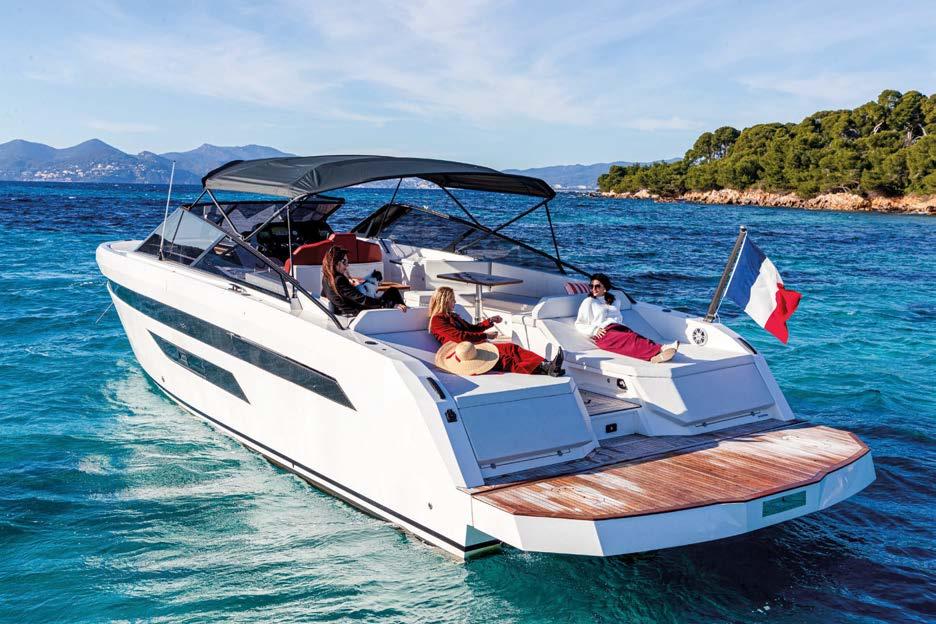

The second is that you don’t waste so much space. It isn’t very likely to have people going stern-to-bow and the other way around simultaneously. Having walkways on both sides means that one of them is never used. It is better to have a single larger one rather than two that are a bit cramped. The central area is protected not just by the full-width windscreen but also by an awning. It doesn’t have a hardtop, but that solution means the lines are lighter and more sporty. The freeboard is pretty pronounced, but that re ects how much room is available below decks. If Paolo Ferragni had decided to add a hardtop with supports or a stainless-
steel structure to keep it up, that would undoubtedly have weighed down the boat’s lines. Below are four berths – two in the convertible dinette in the bow and two in the single berth in the stern. The headroom is more than enough not to find it threatening. Even the stern beds, even though they are below the cockpit oor, have a comfortable height above them. And finally, there is a substantial bathroom in a separate room. So essentially, it is a set-up that ensures the right level of comfort for four people for short- and medium-range cruising. Another point favouring the BB 44’ Ischia is the number of different power options. You can choose Cummins
inboard-outboards with varying power outputs, or you can go for the triple outboard setup, which has three Mercury V10s, each turning out 500 horsepower. So basically, if you want to, you can get a lot more powerful installation than the engines I had on during the test, and I am not saying that because I didn’t find the Cummins convincing; it’s quite the contrary. I touched a top speed of 28 knots, which is just right for peaceful cruising. 11.5 knots were enough to plane, and above all, not having too much power is beneficial in terms of fuel consumption and, consequently, range. Consuming between 60 and 170 litres per hour when cruising is extraordinary. There aren’t many cabin cruisers of over 14 metres that can do that. And it also feels terrific at the helm. The hull is stable and holds course well. So much so that you can even take your hands off the wheel and simultaneously turn in a limited space. The only defect I found was the somewhat stiff steering, which gets tiring if you have to helm for a while.

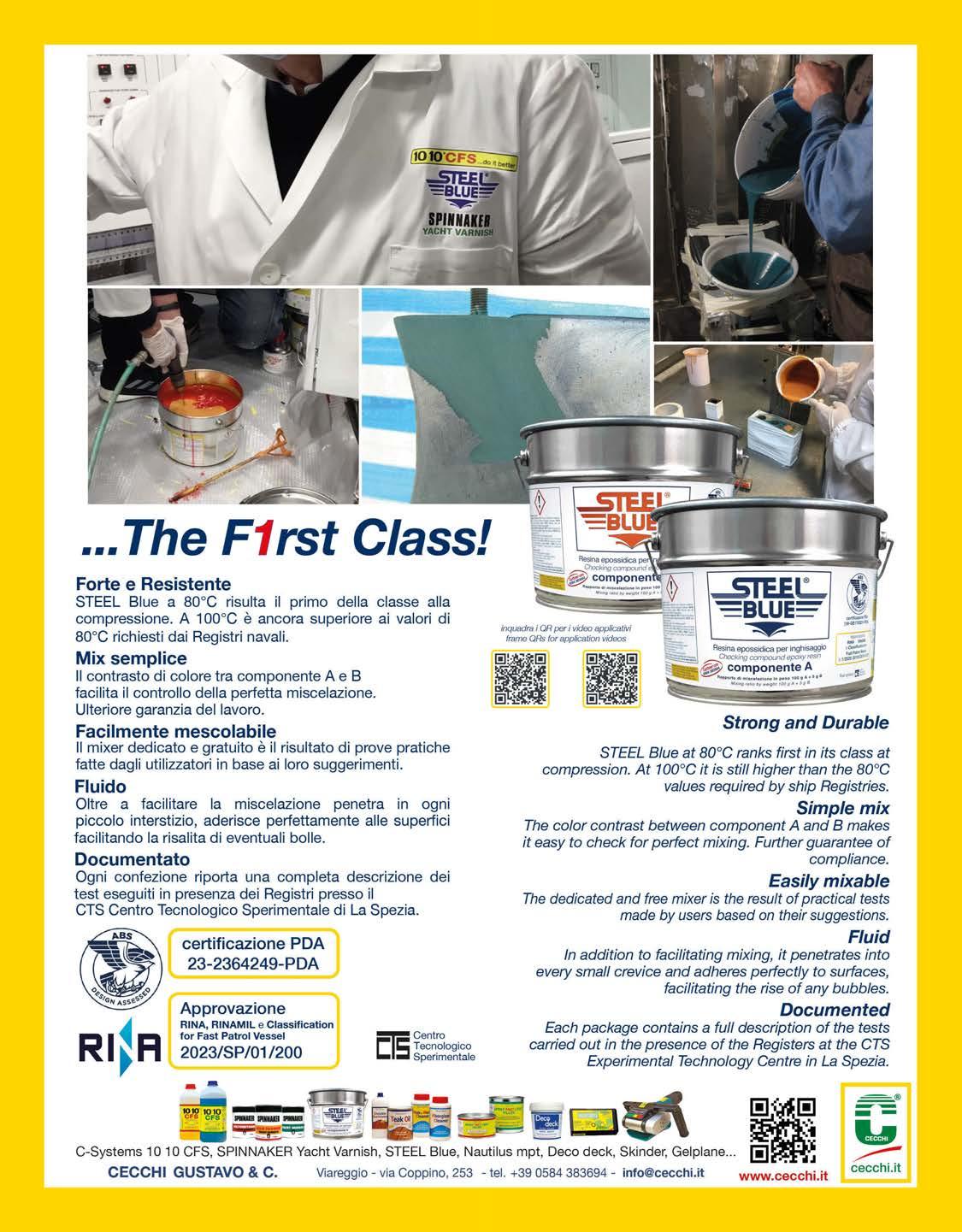

NUOVA CARENA, NUOVI GLI INTERNI E LA COPERTA, MA IL RISULTATO È SEMPRE LO STESSO: LUSSO, SPORTIVITÀ E COMFORT A NEW HULL, NEW INTERIORS AND DECK, BUT THE RESULT IS ALWAYS THE SAME: LUXURY, SPORTINESS AND COMFORT
by Niccolò Volp i
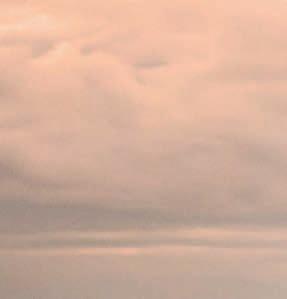

photo by Pi ro Bianchi

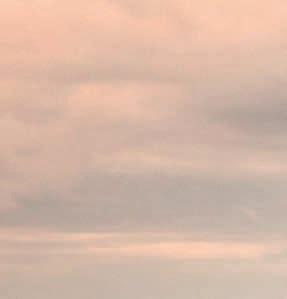



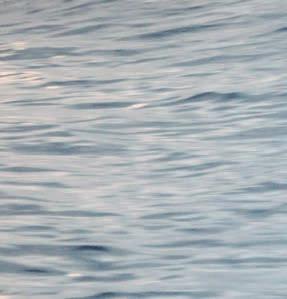


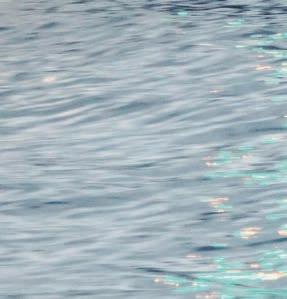





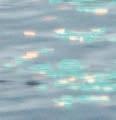



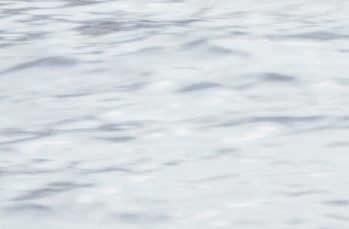
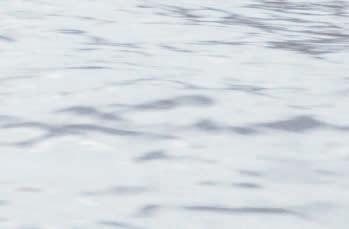




L’abitabilità arriva a 190 cm e i volumi sono generosi. Strider 13 è ideale anche per le crociere a medio raggio.
The Strider 13 has a generous volume and 190 cm of headroom, making it ideal for mid-range cruising.
Dieci anni sono un tempo sufficiente per un aggiornamento, ma Sacs Tecnorib ha deciso di renderlo radicale. Quando comparve Strider 13 segnò un punto di svolta nel mondo dei rib e non solo per le dimensioni che allora erano tra le più grandi sul mercato. Fu un modello che fece capire che il design aveva un ruolo importante anche per un battello pneumatico.
Oggi il cantiere ha deciso che il tempo era maturo per un nuovo Strider 13, ma non si è limitato a rifare il trucco. La carena è stata progettata sempre da Federico Fiorentino, ma è completamente nuova, così come interni e coperta, anch’essi frutto dello stesso progettista della precedente versione
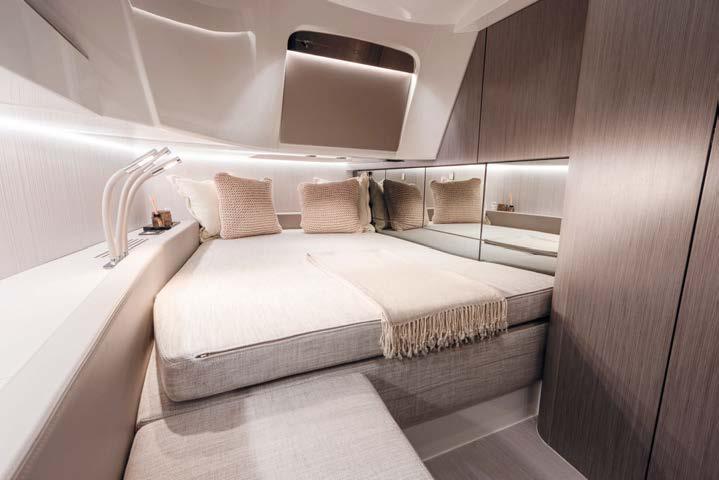
ovvero Christian Grande. La coperta rispetta due caratteristiche fondamentali. La prima è quella di avere spazi ampi, ideali per molti ospiti e l’altra è che a bordo ci si deve muovere con facilità. La versione della prova monta due motori entrofuoribordo con piedi poppieri Volvo Penta D6 di 400 cavalli ciascuno. Salire a bordo dalla banchina, attraverso la piattaforma di poppa, è facile, così come facile è l’ingresso in pozzetto perché i prendisole sono due, ciascuno da due posti, con il camminamento centrale. In pozzetto ci si muove sempre al centro, dato che i divanetti a L e i rispettivi tavolini sono due. Nel caso ci siano molti ospiti a bordo però i due tavolini a ribalta si uniscono e con l’aggiunta di un cuscino anche i divanetti diventano un’unica seduta per una decina di persone. I passavanti laterali sono ampi e i tubolari non rappresentano un ostacolo, anzi. Il problema è che manca un tientibene che, soprattutto per accedere a prua, sarebbe stato utile.
A differenza della poppa, infatti, che ha il camminamento centrale, qui il passaggio è sull’esterno e il piano di calpestio è a filo dei tubolari quindi un punto a cui aggrapparsi avrebbe aumentato la sicurezza negli spostamenti. La zona di prua è interamente occupata da un altro grande prendisole che sfrutta per intero la superficie disponibile anche perché l’ancora esce dall’occhio di cubìa. Il musone pertanto ha dimensioni



AUTONOMIA MN RANGE NM

RAPPORTO PESO POTENZA MASS OUTLET POWER
kg kw

RAPPORTO LUNG./LARG. L/W

SACS TECNORIB
Via Don Locatelli, 51 I-20877 Roncello (MB) T. +39 039 6885489 info@sacstecnorib.com www.sacsrebel.com
PROGETTO
Federico Fiorentino (carena) • Christian Grande Design Works (interni e coperta)
SCAFO
Lunghezza f.t. 13,47m • Lunghezza di omologazione 11,94m • Larghezza massima 4,26m • Pescaggio 1,05m • Serbatoio carburante 1.160 l • Serbatoio acqua 200 l • Potenza massima applicabile 1.200 cv
MOTORI
Volvo Penta 2xD6-400 DPI • Potenza 294 kW (400 cv) • 6 cilindri in linea • Cilindrata 5,5 l • Rapporto di compressione 1,69:1 • Regime di rotazione 3500 giri/minuto
CERTIFICAZIONE CE CAT B
PREZZO
710.000 € + Iva in configurazione standard
PROJECT
Federico Fiorentino (hull) • Christian Grande Design Works (interiors and superstructure)
HULL
LOA 13.47m • Length 11.94m • Maximum beam 4.26m • Draft 1.05m • Fuel tank volume 1,160 l • Water tank volume 200 l • Maximum rated power 1,200 hp
MAIN PROPULSION
Volvo Penta 2xD6-400 DPI • Outlet mechanical power 294 kW (400 hp) • 6 in-line cylinders • Swept volume 5,5 l • Compression ratio 1.69:1 • Maximal rotational speed 3,500 rpm
EC CERTIFICATION CAT B
PRICE
710,000 € Excl. VAT in a standard configuration
Località//Place Genova Altezza onda//Wave height 20 cm
Vento forza//Wind speed 10 nodi//knots Persone a bordo//People on board 5
Carburante imbarcato 500 l Fuel volume on board
Acqua imbarcata 100 l Water volume on board
Da zero a velocità di planata in 4 secondi
Gliding time of 4s from 0 to glide
Da zero a velocità massima in 29 secondi
Gliding time of 29s for a speed change from 0 to 38 knots (maximum speed)
rialzata rispetto al resto del piano di calpestio della coperta per avere un’abitabilità maggiore sottocoperta. Gli interni sono altrettanto confortevoli. L’altezza è di 190 centimetri e la cuccetta matrimoniale ha una larghezza di 160. Il bagno è ampio e dispone di box doccia separato. A centro barca ci sono altre due cuccette, queste, ovviamente, più sacrificate in altezza dato che sono ubicate sotto il pozzetto. Le cuccette però sono collocate in orizzontale per sfruttare al meglio tutta la superficie della cabina. L’armatore può scegliere un allestimento con dinette al posto delle cuccette e, ovviamente, i colori dei tessuti e dei materiali. Ma quella degli interni non è l’unica personalizzazione prevista. La scelta della motorizzazione è ampia. Oltre ai due Volvo D6 da 400 cavalli si può optare per una massima complessiva di 880 cavalli e anche una configurazione con i fuoribordo che, al massimo, possono essere tre da 400 ciascuno per un totale di 1.200 cavalli. A Genova, durante il test, c’erano i due Volvo D6 da 400 cavalli con i piedi poppieri. Il mare era calmo. Per verificare il comportamento sull’onda mi sono accontentato di quella di scia delle navi di passaggio che comunque non erano poche e nemmeno piccole. La sensazione è quella che era attesa: stabilità, facilità di conduzione e performance. Nessuno di questi aspetti delude. Nonostante una motorizzazione non particolarmente spinta, Strider 13 arriva a 38 nodi di massima e plana a soli dieci nodi. È un valore decisamente fuori dal comune che denota l’efficienza delle linee d’acqua
dello scafo. Ottimi anche i consumi e, di conseguenza, l’autonomia. A 30 nodi di velocità bastano circa 100 litri/ora e quindi poco più di tre litri per miglio. I serbatoi del carburante hanno una capacità di 1.160 litri, perciò l’autonomia tra il minimo di planata e la velocità massima varia da più di 400 miglia a 290. A qualsiasi andatura quindi si riesce ad attraversare in lungo e in largo il Mediterraneo. Strider 13, infatti, non è solo un luxury tender o una chaise boat di un megayacht, ma, per chi lo desidera, anche un rib ideale per la crociera a medio raggio. La visibilità dalla postazione di guida è ottima, anche perché l’assetto è quello giusto. Lo scafo è sempre ben disteso sulla superficie dell’acqua e i tubolari fungono bene da bottazzo dato che in coperta non arrivano mai spruzzi, nemmeno quando si naviga sul mare formato. La sensazione di avere tutto sotto controllo è amplificata dalla posizione centrale della consolle e dall’ergonomia della plancia. Tutto è a portata di mano, alla giusta distanza e quindi timonare è un vero piacere.
Ten years is enough for a bit of an update; however, Sacs Tecnorib has decided to do a radical one. When the Strider 13 appeared, it marked a change in the RIB sector, and not just because of its size: it was then amongst the largest on the market. It was a model that let you know that design also had a significant role in an in atable. And now the yard has decided the time is right for a new Strider 13. But it hasn’t just made cosmetic changes. Federico Fiorentino once more
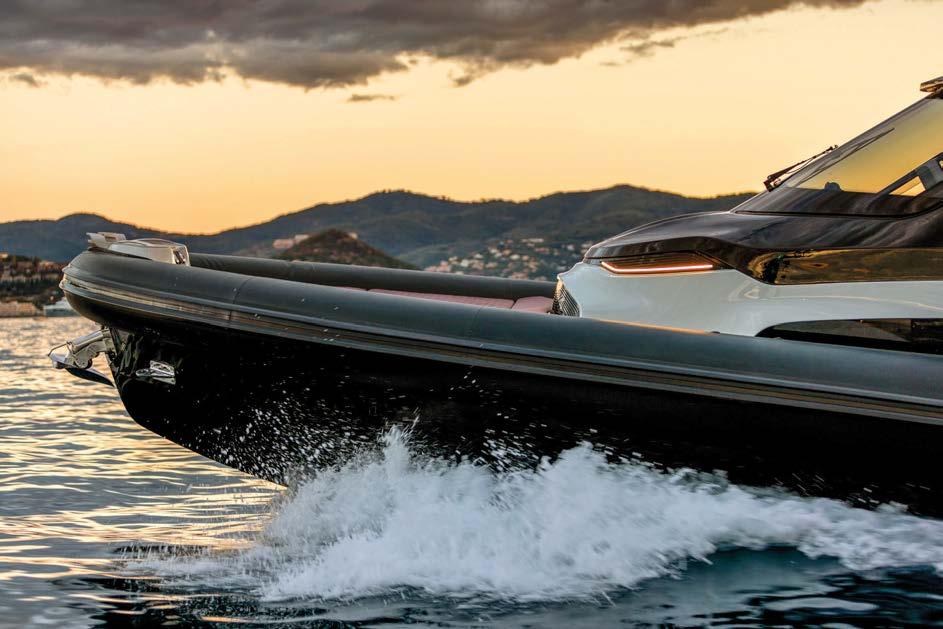

Parabrezza e T-Top riescono a garantire protezione senza compromettere la visibilità e la sensazione di spazi aperti che un rib deve avere.
Windscreens and T-Tops o er protection without compromising the visibility and open space a rib should provide.
designed the hull on this new boat, but it has been done entirely from scratch, as were the interiors and deck, which are again the work of Christian Grande. The deck looks for two things above all. The first is to have plenty of room so that it can host lots of guests, and the other is that you have to be able to get around quickly on board. The version we tried had two inboard-outboards with D6 Volvo Penta stern drives, each turning out 400 horsepower. It’s easy to get from the quay and onto the stern platform to come on board. The same goes for getting into the cockpit because there are two sun pads, each taking two people, with a central walkway. The cockpit has two L-shaped sofas and their respective tables, so room is available in the middle. The tables can be opened up and joined together if there are extra guests, and with the addition of a cushion, the sofas become one, with room for ten or so people. The side decks are expansive, and the tubes don’t get in the way, far from it. The problem is that there aren’t any grab handles to get to the foredeck, and they would have been helpful. In contrast to the stern, which has a central walkway, the route is down the outside, and the walking surface is level with the tubes. So, having something to hold on to as you get around would have felt safer. The foredeck is entirely taken up by another large sun pad, not least because the anchor comes out of the hawsehole. That means the stem is not very large. It is helpful to stand on when getting off when moored bow-to, and it also has two foldaway cleats and buttons for the windlass. This area is slightly raised above deck level to allow for more excellent headroom below (190 centimetres, while the double bed is 160 cm wide). The interiors are also very comfortable –and the bathroom is spacious and includes a separate shower cubicle. There are two other beds amidships, but these are a bit more restricted in terms of headroom since they are under the cockpit. The berths are laid out across the beam to get the most out of the available area. Buyers can have a dinette rather than the beds and can - of course - choose the fabrics and colours used. But the interiors aren’t the only thing you can customise, as there is a lot of choice regarding engines. As well as the two 400-hp Volvo D6s, you can go for a total output of 880 horsepower or an outboard set-up – the top rating would

be three 400s, for a total of 1,200 hp. We had two 400-horsepower Volvo D6s with stern drives in Genoa for our test. The sea was calm, so to see how it handled waves, I had to make do with going over the waves left by passing ships. There were quite a few of them, and they were by no means small. I got the feeling I was expecting: it is stable, easy to handle and performs well without disappointment in any category. Despite not having mighty engines, the Strider 13 gets to 38 knots. And it planes at just ten, which
is remarkable and shows how efficient the waterlines are. Fuel consumption is also excellent, and consequently, so is range. At 30 knots, you need around 100 litres per hour, so you need just over three litres per mile. The fuel tanks hold 1160 litres, so the range varies between 290 nautical miles and over 400 at planing minimum. So you can go up and down the Mediterranean at any speed. Indeed, the Strider 13 is not just a luxury tender or a chase boat for a mega yacht but can also be the perfect RIB
for a medium-range cruise. The helm station has excellent visibility because the trim is just right. The hull is always nicely out of the water, and the tubes work well as a rubbing strake, given that the spray never got on deck, not even in rougher water. The console’s central position and the dashboard’s ergonomics further enhanced the feeling of having everything under control. Everything is to hand and at the proper distance, making it an absolute pleasure to be at the helm.
Due Volvo D6 da 400 cavalli ciascuno e i piedi poppieri sono solo una delle motorizzazioni possibili. Volendo si arriva a 880 cavalli complessivi oppure a 1.200 con i fuoribordo.
Two 400hp Volvo D6s with stern drive are just one of the possible engines. A total of 880 hp is possible, or 1,200 hp with outboards.
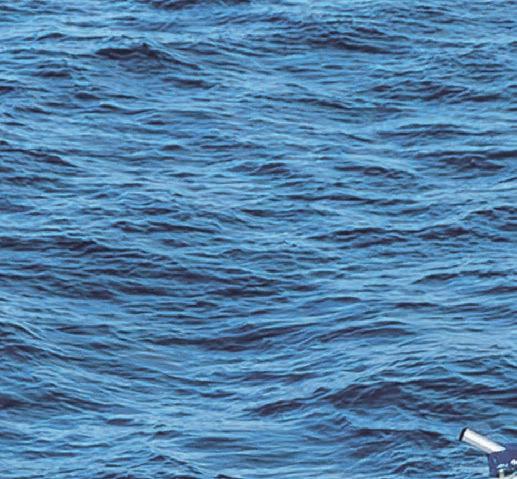


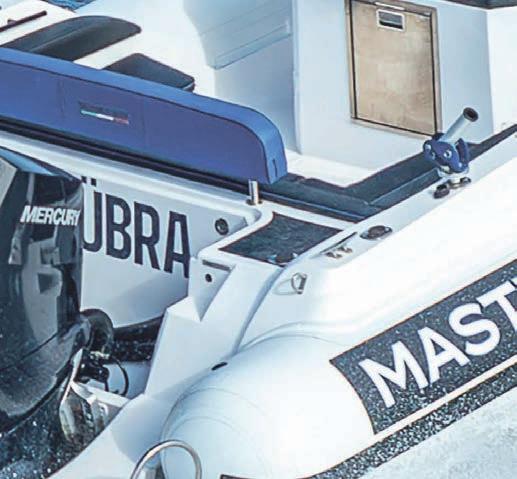
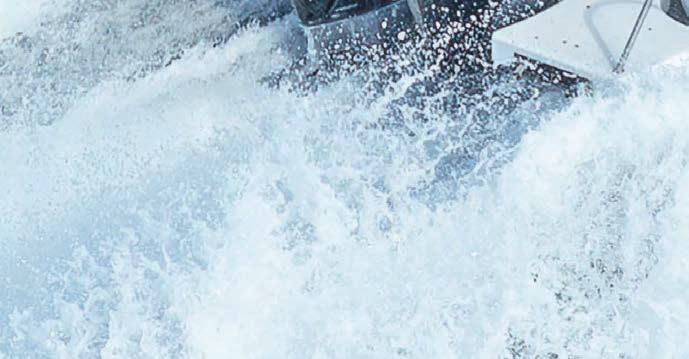
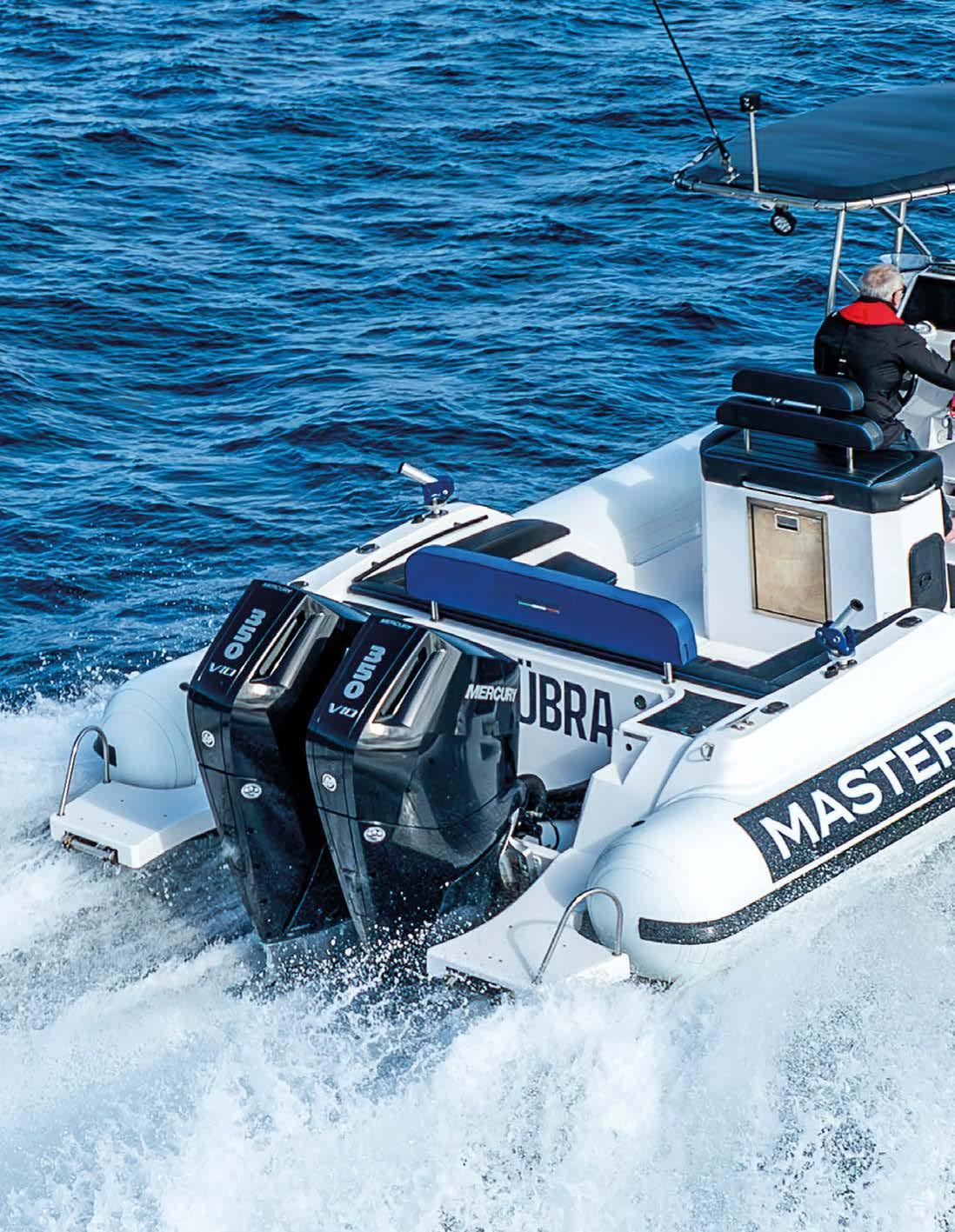


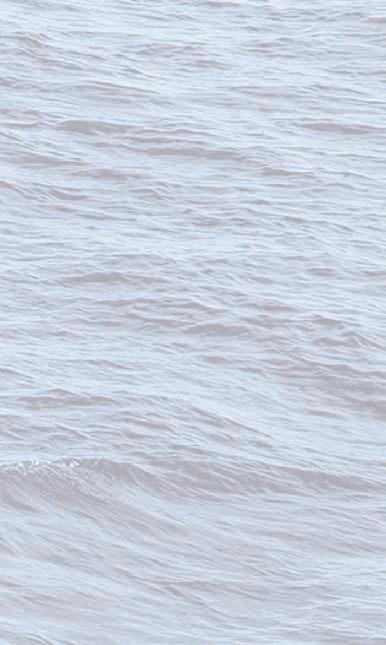
Seuna carena veloce è progettata per lavorare il mare da prua a poppa, sfruttando in planata i piani di galleggiamento, anche la scia di un fuoribordo e i suoi “baffi” possono raccontare molto di una barca e tradire alcuni difetti di progettazione, perché proprio a poppa si concentrano i risultati di assetti, pesi e spinte, rilevando turbolenze e prestazioni di scafo e propulsori. La scienza un tempo si mescolava con l’improvvisazione, la ricerca con la sperimentazione e c’era chi insisteva nella teoria, chi si affidava al design e chi copiava la tecnica dai grandi. Pietro Gargiulo, padre fondatore della Master Gommoni è stato sicuramente uno di questi “grandi”, il Mastru Piè, il “Mister Master” dei Rib, da terzista nella lavorazione di tubolari in neoprene fino a diventare abile costruttore, ha sviluppato nuove idee per i moderni i id ull In atable oat in vetroresina con un’attenta combinazione di spinte ed equilibri tra scafo e propulsori fuoribordo. L’intuito e la visione degli obiettivi di papà Pietro sono stati tramandati alla figlia Annalisa che ha ereditato la passione e determinazione, necessarie ad assorbire moderni strumenti di analisi e di conduzione aziendale per portare il marchio a livelli internazionali.


Giannini
ABBIAMO PROVATO IN SICILIA I BATTELLI MASTER ABBINATI AI FUORIBORDO MERCURY. IL 996 FISHING CON 2 VERADO V10 350, IL 775 FISHING CON 2 FOURSTROKE V6 200 E IL 699 FISHING CON 1 FOURSTROKE V6 200 WE TRIED OUT SOME BOATS FROM THE MASTER YARD IN SICILY POWERED BY MERCURY OUTBOARDS. THE 996 FISHING WITH TWO VERADO V10 350S, THE 775 FISHING WITH TWO FOURSTROKE V6 200S, AND THE 699 FISHING WITH A SINGLE FOURSTROKE V6 200 by Sacha

Master 996 Fishing è il top per lunghezza fuori tutti della gamma, con 9,96 m x 3,36 m, 1.810 kg di peso a secco, categoria CE Cper 20 persone con potenza massima a poppa di 700 cv. Motorizzato con 2 x 350 V10 Verado e con trim positivi al massimo, ha raggiunto i 52 nodi in planata su un mare leggermente increspato preso al mascone, dimostrando un controllo reattivo e aderente negli assetti e sbandamenti da sterzo durante tutta la
Master 996 Fishing is the top of the range in terms of length at 9.96m x 3.36m, 1,810 kg dry weight, EC C category for 20 people, and a maximum aft power of 700 hp. Powered by 2 x 350 V10 Verado and with positive trims at maximum, it reached 52 knots in planing in a slightly choppy sea taken at the jaw, demonstrating responsive and tight control in trim and heel throughout the planning run at full throttle.
Master & Mercury, vivono oggi una bella simbiosi, in una combinazione perfetta che sostiene, rivela e condivide le reciproche qualità dell’uno e dell’altro, mostrando quelle di una piccola eccellenza italiana che guarda al futuro e di un colosso americano capace addirittura di prevederlo. La serie Verado e FourStroke della Mercury Marine, divisione della runswic Corporation di Lake Forest (Illinois) in USA, è stata messa a disposizione sulle poppe dei diversi Rib per una approfondita giornata di test a mare tra Capo Zafferano e Mondello, nelle acque antistanti il Palermo Marina Yachting. Il Molo Trapezoidale ha dato ospitalità all’evento, dove tra tecnici, fotografi, giornalisti e tester abbiamo potuto osservare e provare il 996 Fishing con 2 Verado V10 350, il 775 Fishing con 2 FourStroke V6 200 e il 699 Fishing con 1 FourStroke V 200. Avere a che fare con diversi gommoni è stato davvero un piacere perché tutti hanno dimostrato potenza, affidabilità e prestazioni lavorando sempre in condizioni ottimali ad ogni regime, assetto, andatura. Con una calandra aerodinamica e compatta quasi da racing, in tonalità Phantom lac , earl o in Fusion White cold o warm, le 3 versioni proposte in prova da Mercury solo a guardarle invitano
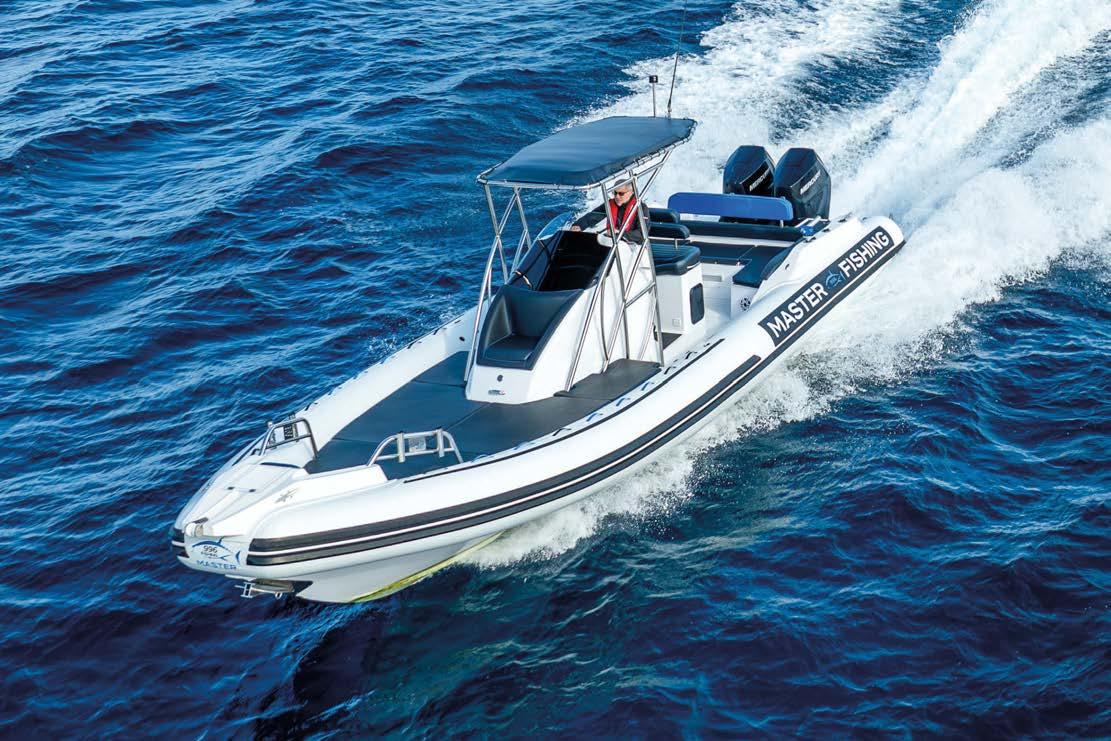

a navigare, ad accendere i motori e mollare gli ormeggi. Mostrano da subito potenza e numerose funzioni integrate come il Digital Throttle Shift DTS per cambiate uide e silenziose con una risposta istantanea dell’acceleratore, la timoneria elettrica (solo per i multimotori) con un servosterzo reattivo e silenzioso a prova di manovra e virate, il controllo adattivo della velocit AS , il sistema Advanced MidSection (AMS) che isola dalle vibrazioni e il Sound Control che fa scegliere il “volume” del rombo del motore, poderoso o più sommesso all’avvio o al minimo.
Con molta accelerazione e tanta coppia già a bassi regimi, i fuoribordo testati hanno tutti in comune poche vibrazioni, silenziosità e un elevato rapporto di compressione dentro un raffinato connubio di estetica, meccanica, elettronica e decibel.
Il vento è ancora debole da Sud ma appena fuori il frangi utti aumenta d’intensità increspando il mare e anche le nostre condizioni d’assetto, mettendo così a dura prova equilibri ed esperienze di guida. Le carene dei aster , e 996 sono tutte mediamente profonde e reattive, adatte per le condizioni di prova e per le potenze Mercury appese a poppa che, se ben governate, portano in corsa e in “piega” gli scafi tracciando binari rettilinei e cerchi di virata precisi e stretti, ma mai oltre sobbalzi o sbandamenti critici. Il primo seatrial è il maxi-rib Master 996 Fishing, il top della gamma, con 9,96 metri di lunghezza e 3,36 di baglio, 1.810 kg peso a secco, categoria CE C per 20 persone con potenza massima a poppa di 700 cavalli. Motorizzato con due 350 V10 Verado e con trim positivi al massimo ha raggiunto i 52 nodi in planata su un mare leggermente increspato preso al mascone, dimostrando un controllo reattivo e aderente negli assetti e sbandamenti da sterzo durante tutta la fuga planante a pieno regime di giri mantenendo sempre l’assetto sull’onda senza perdere mai il controllo e la presa. Il 775 Fishing è un fuoriclasse della linea dedicata ai pescatori, in prova con 4 persone a bordo e due V6 FourStroke di 200 cavalli ciascuno, ha raggiunto agevolmente i 47 nodi a 5500 giri con 128 litri ora di consumo. La crociera veloce è tra i 30 e 35 nodi con 3500/4000 rpm e un consumo compreso tra 50 e 60 litri ora. A 2000 rpm entra in planata in poco meno di 3 secondi a circa 10 nodi con un consumo di 21 litri ora.
Il 699 Fishing è il capostipite della serie attrezzata per la pesca ma disponibile anche in versione diporto “GP”, con la sigla di Gargiulo Pietro, papà di Annalisa che proprio durante l’allestimento lasciò in eredità alla figlia il compito di terminare il lavoro. La versione in prova è invece quella dedicata agli “anglers”, motorizzata con un singolo Mercury 200 cv V6 FourStroke. A 5000 rpm abbiamo raggiunto 41,3 nodi di SOG, tuttavia un po’ inferiore rispetto al dato registrato dal cantiere con circa 60 l/h di consumo. Il 699 si è dimostrato all’altezza dei modelli maggiori della gamma, smentendo l’idea che “tanto il motore spinge tutto” perché buoni “triangoli” di carena e buoni motori richiedono una perfetta sintonia, accorgendosi di ogni minima imperfezione. Mercury & Master trovano sempre il loro giusto equilibri
Ifa fast hull is designed to work the sea from bow to stern, exploiting the waterline planes in glide, even the wake of an outboard and its ‘whiskers’ can tell a lot about a boat and even betray some design aws because it is precisely at the stern that the results of trim, weight and thrust are concentrated, detecting turbulence and the performance of the hull and thrusters. There was a time when science blended with improvisation and research with experimentation, and some insisted on theory and relied on design. In contrast, others copied the techniques used by the greats. Pietro Gargiulo, the founding father of Master Gommoni, was one of those “greats”. Known as “Maestro Pete” and the “RIB boss”, he went from being a neoprene tube contractor to an able constructor. He developed new ideas for modern, fibreglass rigid hull in atable boats by carefully finding a combination of thrust and a balance between the hull and outboard engines. Pietro’s insight and visionary goals have been passed down to his daughter, Annalisa, who inherited the passion and determination to master modern business analysis and management tools to ensure the brand rises internationally. The Master yard and Mercury are now experiencing a beautiful symbiosis, in a perfect combination that supports, reveals and shares the qualities of the small, forward-looking Italian centre of excellence and an American colossus that can anticipate how things will be.

La chiglia Master è decisa, lineare, tradizionale, con un diedro pressoché costante, una ruota di prua dal profilo avanzato a sezione prodiera pronunciata ma con su ciente portanza per evitare spiacevoli “spin out” e un diedro poppiero ben sopra i 20 gradi. Spinta anche da un solo fuoribordo Mercury diventa estremamente marina, prepotente sull’onda e in virata non molla mai la sua traiettoria. Pettinata solo da poche e lineari nervature d’assetto longitudinali sotto il galleggiamento, corre stabile in planata e mantiene sempre presa e reazione sull’ac ua, perfino uando si “scatena” oltre i 40 nodi.
The keels that the Master yard produces are decisive, linear and traditional, with an almost constant dihedral angle, a bow with an advanced profile with a pronounced stern section but has enough lift to avoid unpleasant spin-outs and a stern dihedral angle of well over twenty degrees. Powered by a single Mercury outboard, it holds the water well, dominates when approaching waves, and never veers off course. The eel is crossed only by a few longitudinal linear trim lines below the water line, holds stable when on a plane, and is always reactive, even when unleashed to exceed forty knots.

Il Master 775 Fishing, dedicato ai pescatori, misura 7,70 metri (con plancetta 8,10m per 3,10m di baglio, ha un peso a secco di 1.100 kg. Categoria CE C con 16 persone trasportabili, una potenza massima motori di 402 cv, un generoso pozzetto pesca di 1,8x2,08 metri per il “combattimento”, con una vasca del pescato di 375 litri e del vivo di 140. In prova, con 4 persone a bordo e 2x200 V6 FourStroke, ha registrato un massimo di 47 nodi a 5500 giri con 128 l/h di consumo.
The Master 775 Fishing, dedicated to fishermen, measures . metres with a platform 8.10m) by 3.10m beam and has a dry weight of 1,100 kg. EC C category has 16 people that can be transported, a maximum engine power of 402 hp, a generous 1.8 . 8 metre fishing coc pit for ‘combat’, a 375-litre catch tank and a 140-litre live storage tank. Under test, with four people on board and a 2x200 V6 FourStroke, she recorded a maximum of 47 knots at 5500 rpm with 128 l/h consumption.
Con i motori Mercury, i Master Rib hanno un assetto ideale e una buona navigazione in mare mosso, perdonando anche piccoli errori e distrazioni del pilota. Riescono inoltre a saltare di cresta in cresta solcando il pelo d’acqua in un sostentamento idrostatico senza delfinamenti, sussulti o necessarie correzioni tramite trim o interceptor.
Powered by Mercury engines, the Master Ribs have ideal trim and good navigation in rough seas, forgiving minor errors and pilot distractions. They can also jump from wave to wave, ploughing the water’s surface in hydrostatic drive without delphination, shuddering, or needing corrections via trim or interceptor.
The Verado and FourStroke series from Mercury Marine, a division of the runswic orporation of Lake Forest, Illinois, was made available on the transoms of various RIBs for a day of detailed testing between Capo Zafferano and Mondello on the seas off Palermo Marina Yachting. The Molo Trapezoidale quay area hosted the technicians, photographers, journalists and testers at the event, where we were able to take a close look at the 996 Fishing, which fitted two Verado V10 350s, the 775 Fishing with two FourStroke V6 200s and the 699 Fishing with one FourStroke V6 200. It was a pleasure dealing with different RIBs because they were powerful, reliable, and high-performance–functioning excellently at every rev level, trim level, and speed. They have a compact, aerodynamic

grille that almost looks like it is designed for racing, and they are available in Phantom Black, Pearl or Fusion White (either cold or warm). Just looking at the three versions offered by Mercury makes you want to get on the water, start your engine and slip moorings. They immediately show not only how powerful they are but also the numerous integrated functions such as Digital Throttle Shift DTS for smooth, silent changes with instant reactivity from the accelerator, electric helm (not for single engine set-ups) with power steering that is reactive and silent and can cope with turns and manoeuvres. Then there is Adaptive Speed Control ASC , the Advanced Mid Section AMS system, which isolates vibrations, and Sound Control, which means you can choose the volume of the motor rumble, from powerful to quieter, when starting or at minimum revs. With a lot of acceleration and torque even at low rev levels, all the outboards we tried boasted limited vibrations, silence and a high compression ratio, combined with a refined combination of aesthetics, mechanics, electronics and decibels. The wind was still blowing weakly from the south. Still, as soon as we got past the breakwater, it got stronger, roughening the water and disturbing our balance, making it difficult to get the trim right and calling on our experience in handling. The hulls of the Master , and 996 are all reasonably deep and reactive and were suited to the test conditions and the output of the Mercurys they carried on the transom. If the outboards are controlled well, they launch the hulls to carve out straight lines and precise and tight turns, yet never olting or heeling critically.
The first sea trial was with the maxi-RIB Master 996 Fishing, the top range at 9.96 by 3.3 metres, with a dry weight of 1,810 kg, and CE category C for 20 people with a maximum of 700 horsepower allowed. It can carry two 350 Verado V10s, and with a positive trim, we got to a top speed of 52 knots while planning with a slightly rough sea on the starboard bow. The reactive control helped it hold the water throughout planning at full revs, keeping the trim over the waves without ever losing control or purchase.
litres per hour of fuel used. Fast cruising was between 30 and 35 knots, at 3500 to 4000 rpm, with between fifty and sixty litres used. At 2000 pm, it planned at around ten knots in just under three seconds, with 21 litres per hour of fuel being used.
The 699 Fishing is the patriarch of the series that has been set up for fishing but is also available in a sports version, the GP, which stands for “Gargiulo Pietro”, Annalisa’s father, who bequeathed to his daughter the task of finishing the work while it was being fitted out. However, the version being tested was the one for anglers, which a single 200hp Mercury V FourStroke powers. At 5000 rpm, we reached 41.3 knots SOG, a bit lower than the yard’s figure, with around 0 litres of fuel used per hour. The 699 showed itself at the same level as the best models in the range and rebuked the idea that the engine somehow does all the work. That’s because good “triangles” in the hull and excellent motors need to come together in perfect harmony, carefully noticing any minimal imperfection.
But Mercury and the Master yard always manage to find the right balance.
Dal gelcoat al matt, dai longheroni ai madieri in coremat o poliuretano impregnati a mano con resina isoftalica neopentilica, fino alla finitura dei gavoni interni, dei coperchi e della consolle, ogni angolo dello stampo viene controllato e “rullato” per evitare bolle e imperfezioni. Il tessuto gommato dei tubolari è saldato sulle selle predisposte in stampata con colle ad alta resistenza e, tra comparti stagni, valvole, maniglie, tientibene, rinforzi, fregi e bottazzi, tutto è a prova di tenuta e di severi controlli prima di ogni varo.
Where gel coat or matt, every corner of the mould – ranging from the struts to the oor plates in format or handsteeped with isophthalic neopentyl resin, up to the finish of the interior loc ers - is checked and rolled to prevent bubbles and imperfections forming. The rubberised fabric of the tubes is joined together on the saddles set up during the printing process with high-resistant glue. With watertight compartments, valves, handles, grab handles, strengtheners, decorations and rubbing strakes, everything is sealed up and rigorously checked before every launch.

The 775 Fishing is an outstanding boat from the line aimed at fishermen. With four people on board and two V6 FourStroke 200 hp engines, we quickly got to 47 knots at 5500 rpm, with 128
Il Master 699 Fishing è lungo 6,90 metri (con plancetta 7,45m) per 2,74m con un peso a secco di 800 kg. Categoria CE C con 12 persone trasportabili, una potenza max installabile a poppa di 250 cv, un pozzetto di 1,2m x 1,75m e attrezzato con vasca del vivo di 140 l. In navigazione con 4 persone a bordo, un Mercury di 215 kg di peso, ha raggiunto 41,3 nodi di velocità.
The Master 699 Fishing is 6.90 metres long with the stern platform, it comes to 7.45m) by 2.74m and has a dry weight of 800 kg. It is a EC C category and can carry twelve people. The maximum power allowed is 250 hp. The cockpit is 1. 1. m and is fitted with a 1 -litre livewell. With four people on board and a 215-kilo Mercury engine, it reached 41.3 knots.

IL MUSEO RAHMI M. KOÇ DI ISTANBUL HA AMPLIATO LA SUA COLLEZIONE MARITTIMA ACQUISENDO LA BARCA A VELA RONDETTO DEL 1965 E LO YACHT A VAPORE CANGARDA DEL 1901 THE RAHMI M. KOÇ MUSEUM IN ISTANBUL HAS EXPANDED ITS MARITIME COLLECTION BY ACQUIRING THE 1965 SAILING SHIP RONDETTO AND THE 1901 STEAM YACHT CANGARDA
by Bruno Cianci
IlMuseo Rahmi M. Koç di Istanbul, fondato nel 1994 dall’omonimo magnate turco, ha recentemente ampliato la sua collezione marittima acquisendo due imbarcazioni storiche: la barca a vela Rondetto, costruita nel Regno Unito nel 1965 e famosa per essere stata armata da Erik Pascoli e per aver attraversato cinque volte l’Atlantico, e uno yacht a vapore di 42 metri di costruzione americana chiamato Cangarda, varato nel 1901. Quest’ultimo è stato originariamente costruito da Pusey & Jones di Wilmington (Delaware) come gentleman’s yacht per il ‘re del legname’ del Michigan Charles Canfield
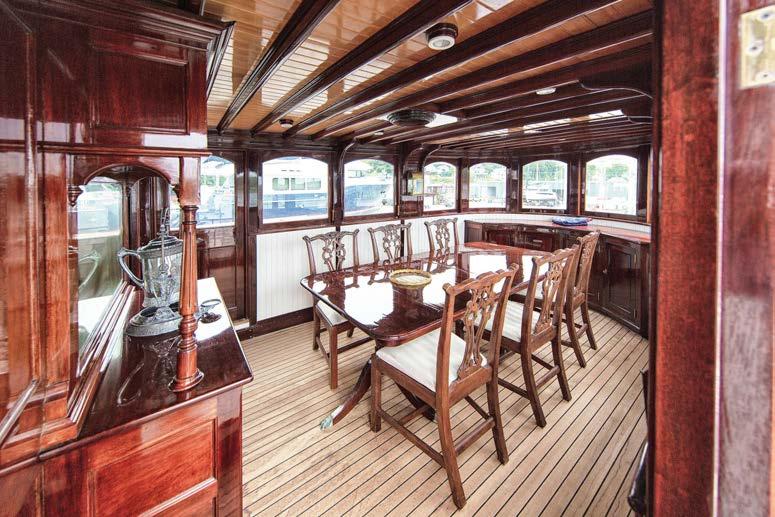
Con Cangarda - che va ad aggiungersi a Gonca, Ysolt, Rosalie, Esra e Liman 2il museo Rahmi M. Koç si arricchisce di un ulteriore gioiello a vapore in condizioni immacolate.
The Rahmi M. Koç Museum has been enriched by the addition of Cangarda which joins Gonca, Ysolt, Rosalie, Esra and Liman 2 as steam-powered jewels in immaculate condition.
e prese il nome dalla combinazione del suo cognome e di quello di sua moglie CANfield e GARDner. Lo yacht ha uno scafo d’acciaio saldato su una struttura del medesimo materiale, coperta rivestita in teak su substrato di compensato e tughe in mogano cubano. Dopo vari cambi di proprietà, Cangarda fu progressivamente trascurata finché alla fine affond nel 1 . Un iniziale salvataggio fu intrapreso da Elizabeth Meyer (celebre per avere contribuito a riportare in vita la Class , dopodiché lo scafo fu scoperto nel 2002 dal suo futuro salvatore, il defunto Bob McNeil, che lo fece restaurare completamente. Cangarda ha ora una nuova casa a Istanbul: un museo già molto conosciuto per essere custode di numerosi yacht classici e barche da lavoro, il più antico dei quali è Rosalie, un rimorchiatore a vapore costruito nei Paesi Bassi nel 1873.
The Rahmi M. Koç Museum in Istanbul, founded in 1994 by the Turkish tycoon of the same name, has recently expanded its maritime collection with the acquisition of two historic vessels: the 1965 British-built sailing yacht Rondetto, famous for having been rigged by Erik Pascoli and having crossed the Atlantic five times, and an American-built 42-metre steam yacht called Cangarda, launched in 1901. The latter was initially built by Pusey & Jones of Wilmington, Delaware, as a gentleman’s yacht for the Michigan ‘lumber king’ Charles Canfield and was named after the combination of his and his wife’s surnames CANfield and GARDner. The yacht has a steel hull welded to a structure of the same material, a teak deck on a plywood substructure and Cuban mahogany deckhouses. After several ownership
Grazie alla passione di donne e di uomini come Elizabeth Meyer, Bob McNeil e Rahmi M. Koç, per le barche come Cangarda il futuro può essere roseo.
The future for boats like Cangarda is bright, thanks to the passion of men and women like Elizabeth Meyer, Bob McNeil and Rahmi M. Koç.
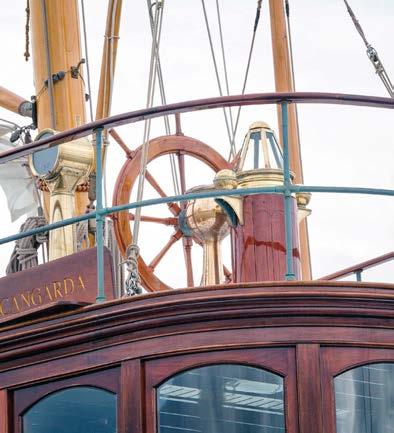
changes, Cangarda was neglected until she sank in 1999. Elizabeth Meyer (of J Class resuscitation fame) carried out an initial rescue. In 2002, her future saviour discovered the hull, the late Bob McNeil, who had her wholly restored. Cangarda now has a new home in Istanbul: a museum already renowned for its collection of classic yachts and workboats, the oldest of which is Rosalie, a steam tug built in the Netherlands in 1873.
Info: www.rmk-museum.org.tr
Pusey & Jones (Wilmington, Delaware) 1901
Progettista: H.C. Wintringham
Lunghezza f.t.: 42 m
Lunghezza in coperta: 38,4 m
Lunghezza al galleggiamento: 32 m 5,33 m
Pescaggio: 2,36 m
Dislocamento: 120 t
Costruzione: Acciaio
Propulsione: a vapore a tripla espansione Sullivan
Ultimo restauro: 2005-2009
Launch: 1901
Designer: H.C. Wintringham 138 ft
Hull length: 126 ft 105 ft 17 ft 6 in
Draft: 7 ft 9 in
Displacement: 120 t
Made on steel
Propulsion: triple-expansion steam
Sullivan
Last restored: 2005-2009
Costruita negli Stati Uniti 124 anni fa, Cangarda è stata protagonista di varie vicissitudini, ma per fortuna continua a essere tra noi.
The Cangarda was built in the United States 124 years ago. Fortunately, it has seen many vicissitudes, but it is still with us.
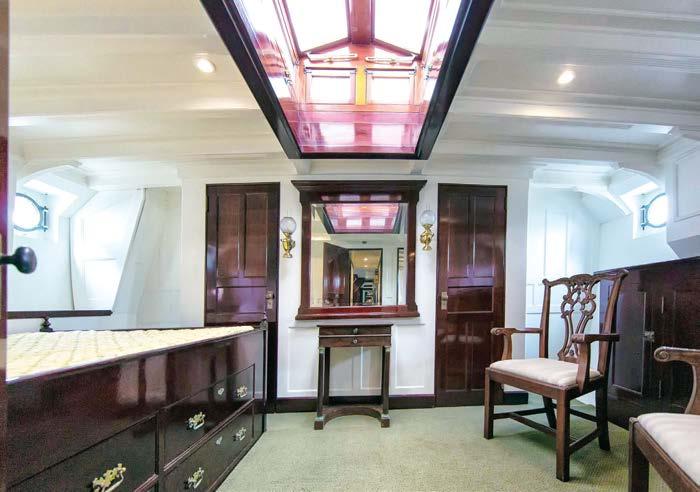
L’AZIENDA NEOZELANDESE HA UNA GAMMA COMPLETA DI ANTIVEGETATIVE SENZA BIOCIDI PER PROTEGGERE LE PARTI IMMERSE. PER IL BENE DELLE BARCHE E DELL’AMBIENTE IN CUI SI TROVANO THE NEW ZEALAND-BASED COMPANY HAS A COMPLETE RANGE OF BIOCIDE-FREE FOUL-RELEASE COATINGS TO PROTECT UNDERWATER ASSETS. FOR THE GOOD OF BOATS AND OF THE ENVIRONMENT THAT HOSTS THEM
by Niccolò Volp i
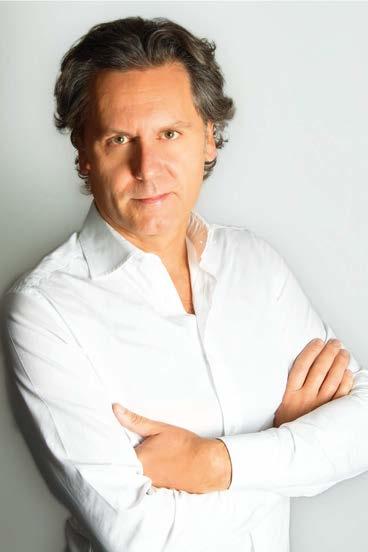
Ifondatori di Propspeed erano degli appassionati di pesca d’altura. Avevano l’abitudine di uscire sui loro fisherman nella Bay of Islands, in Nuova Zelanda dove, oltre a Russell Coutts e a migliaia di velisti, c’era anche tanto fouling. Il mare è biologicamente attivo e quando una carena tocca l’acqua è presa di mira da incrostazioni biologiche, vegetali o animali. E in alcune zone più di altre. Prima arrivano le alghe, poi la cosiddetta “barbetta” e, infine i denti di cane. Purtroppo il fouling non è appassionato solo di scafi, ma anche di tutte le parti metalliche immerse. E quello della Bay of Islands era così forte da inficiare perfino le prestazioni dell’imbarcazione. Che fare? Serviva una soluzione innovativa che consentisse agli appassionati pescatori di evitare di far carena ogni volta che uscivano per una battuta di pesca. Propspeed nasce da questa esigenza.
È un’antivegetativa per parti metalliche, famosa per la sua pigmentazione dorata.
Questa particolare colorazione dipende dal primer che viene utilizzato ed è stata anche un’involontaria operazione di marketing. All’inizio del 2000, infatti, ad Auckland c’era la Coppa America, con Luna Rossa che sfidava proprio i Kiwi, detentori della coppa. Il Golfo di Hauraki si è riempito di appassionati che seguivano le regate e in molti si sono chiesti perché ci fossero così tanti yacht con le eliche dorate. Vennero così a conoscenza di questa antivegetativa, la provarono, si resero conto dell’efficacia e decisero di distribuirla in America. Le prestazioni del Propspeed parlavano da sole e, con l’investimento aggiuntivo nel team di assistenza tecnica, è cresciuta la rete di applicatori qualificati e di imbarcazioni di tutte le dimensioni che utilizzano il Propspeed. “Negli anni ci siamo accorti anche di altri vantaggi –racconta Davide Burrini, EMEA Sales Director di Propspeed – tutti in ottica di rispetto ambientale. La vernice, infatti, oltre che antivegetativa, contribuisce a ridurre la corrosione delle parti metalliche.
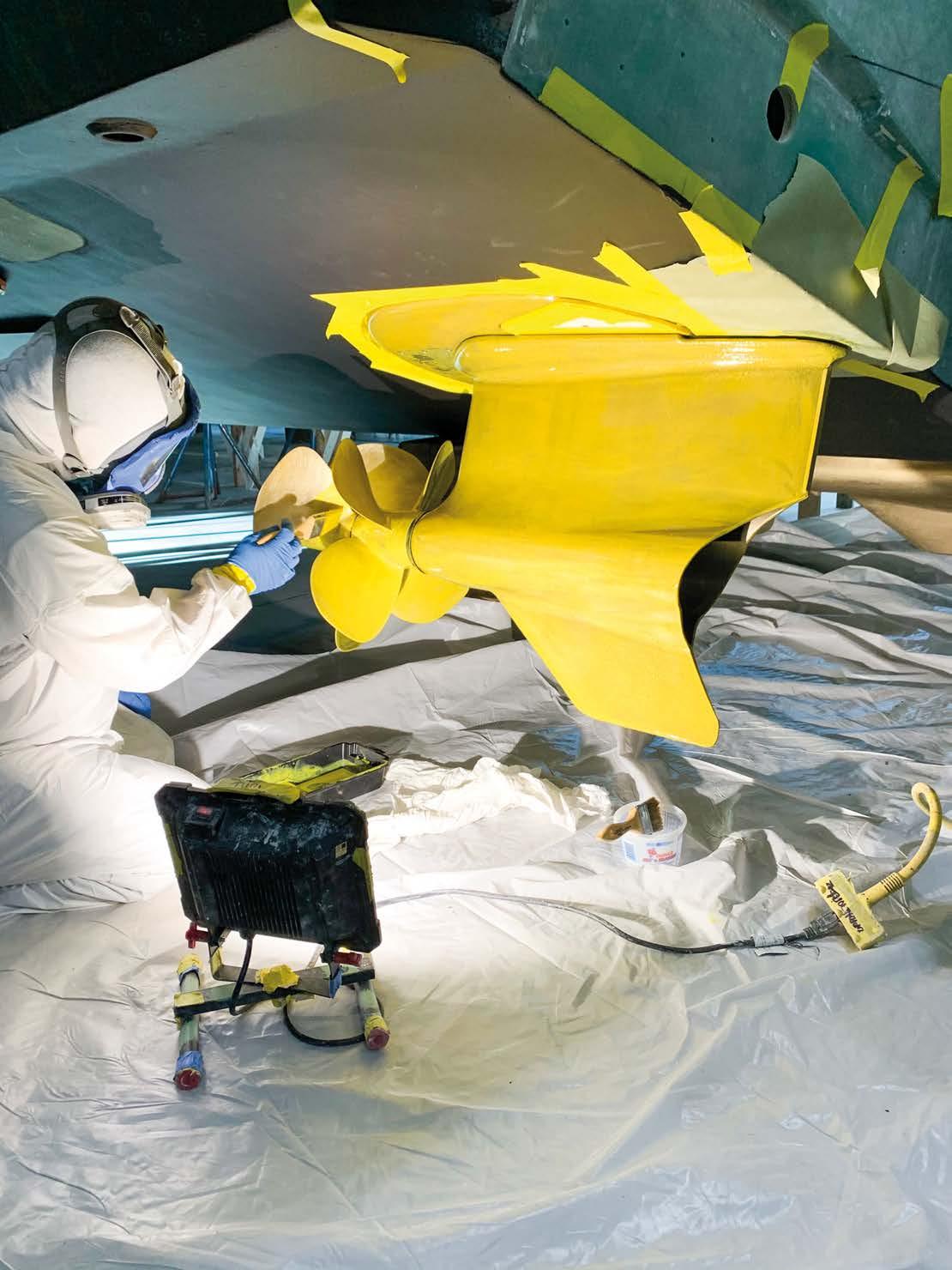

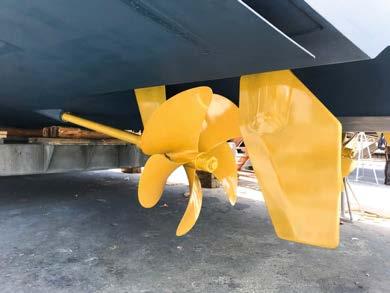
Sia Propspeed che le tradizionali antivegetative impediscono alla crescita marina di colonizzare le
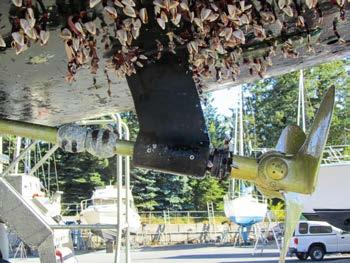
While both antifouling and foul-release coatings prevent marine growth from
Propspeed viene applicato su tutti i metalli immersi. Nell’immagine a lato un esempio con e senza Propspeed.
Propspeed is applied to all underwater metals. In the image alongside, an example with and without Propspeed.
La corrosione galvanica, quella che si forma per la presenza di metalli differenti, è solitamente combattuta con gli anodi sacrificali. Si tratta di un pezzo di zinco che attira la corrosione e appunto si sacrifica. Il problema è che lo zinco non è esattamente salutare e non è bello che sia rilasciato in mare”. Propspeed prolunga la durata dell’anodo perché è un eccellente isolante che riduce il rischio
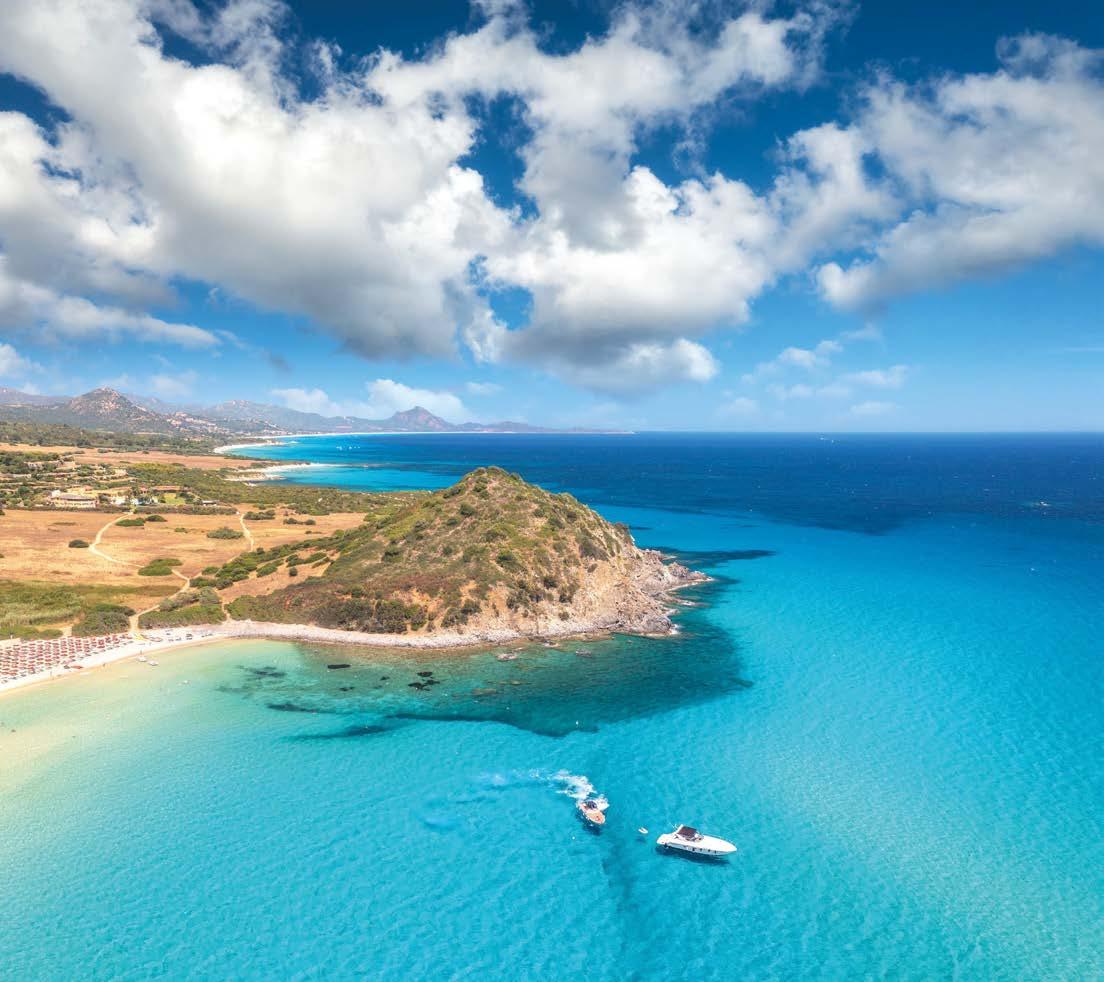

Davide Burrini – a differenza di altre aziende che producono vernici di ogni tipo, noi siamo concentrati su un prodotto che si rivolge allo yachting e alla marina commerciale. Tutte le risorse di ricerca e sviluppo, e sono tante, si concentrano nell’avere un prodotto che rispetta tutte le normative, sia americane, sia europee”. Le normative per le vernici antivegetative sono in continua evoluzione, pertanto, l’innovazione del prodotto è indispensabile e poter concentrare la ricerca solo per questo aspetto è indubbiamente un vantaggio. L’azienda effettua numerosi test e ha verificato che un’applicazione con la vernice
Propspeed è in grado di durare da 12 a 24 mesi. È un top coat idrofobico che crea una barriera per gli organismi marini che non riescono a intaccare le parti metalliche. Anche quando si crea un sottile strato di crescita del fouling, questo non riesce ad aderire al metallo. Basta pertanto passare una spugna per avere nuovamente un’elica perfettamente pulita.
La differenza è tanta. A volte un ciclo di antivegetativa “tradizionale” dura meno di una stagione. Se un’applicazione, invece, dura fino a due anni, vuol dire che non sarà necessario fare carena frequentemente. Il vantaggio ambientale non è solo quello di avere un prodotto a base siliconica privo di veleni, ma è anche quello di garantire un risparmio di carburante all’imbarcazione trattata. Un’elica incrostata dal fouling è certamente meno efficiente di una pulita. Propspeed lo ha fatto quantificare a una società indipendente. In Olanda con un peschereccio di 38 metri ha misurato il consumo di carburante in un determinato percorso mappato con il Gps. Poi ha rifatto lo stesso percorso con l’applicazione dell’antivegetativa Propspeed sulle eliche e ha riscontrato una riduzione del 7,5% del consumo di carburante. Ma Propspeed non è un prodotto fai da te. Ha un alto contenuto tecnico, servono degli applicatori specializzati e l’azienda, infatti, li forma e li certifica. “Abbiamo verificato che quando non è efficace, spesso si tratta di un errore nell’applicazione, per questo forniamo un certificato all’armatore che indica chi è l’applicatore, quale sia la sua esperienza, quale sia il lotto di prodotto utilizzato, a quale temperatura dell’aria e con quale grado di umidità la vernice è stata applicata. Insomma, un vero e proprio certificato di garanzia”, conclude Burrini.

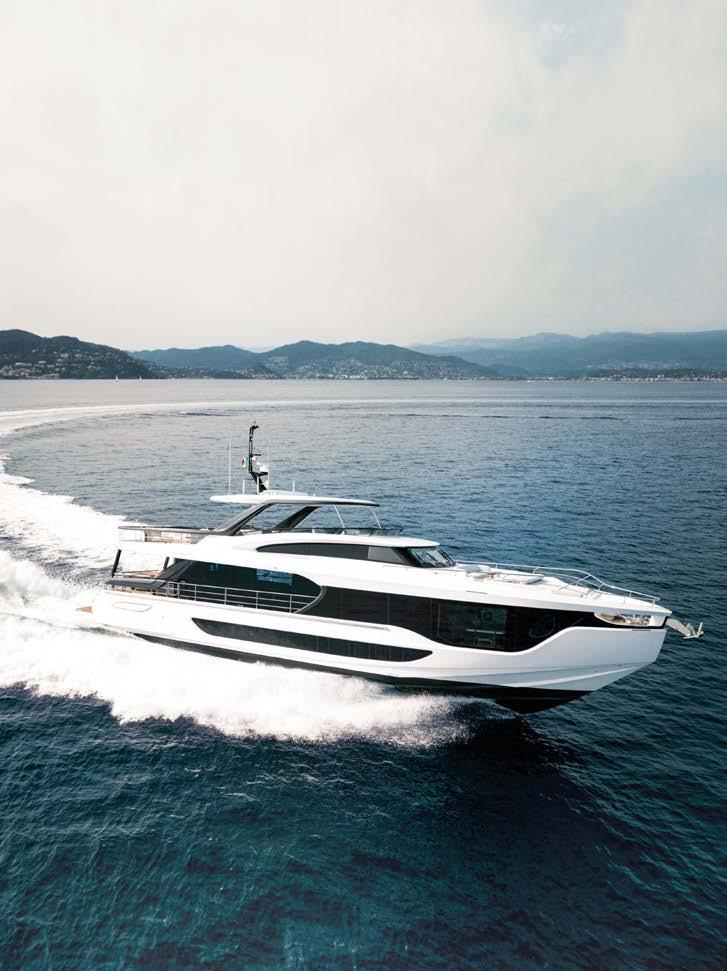
Propspeed ha partner in oltre 60 Paesi nel mondo. Questi collaboratori sono i distributori del prodotto che, a loro volta, formano una rete di venditori e applicatori nella zona in cui operano. L’azienda nata nel 1999 e o re una gamma di rivestimenti antivegetativi per tutte le parti immerse. I prodotti Propspeed includono Propspeed per eliche, timoni, linee d’asse e metalli sommersi, Foulfree per trasduttori e Lightspeed per luci subac uee. Recentemente alla gamma di prodotti ha aggiunto Stripspeed, uno sverniciatore a base solvente per tutti i metalli subac uei.
Propspeed has partners in over 60 countries worldwide. These partners are distributors of the product who, in turn, make up a network of resellers and applicators in the region where they operate. The company was founded in 1999 and offers a range of foul-release coatings for all underwater assets. Propspeed products include Propspeed for running gear and any underwater metals, Foulfree for transducers and Lightspeed for underwater lighting. The product range was recently enriched with Stripspeed, a solvent-based paint stripper for all underwater metals.
Two lovers of deep-sea fishing founded Propspeed. They used to go out on their fisherman boats in the Bay of Islands, New Zealand, where there was quite a bit of fouling in addition to Russell Coutts and thousands of sailors. The sea is biologically active, and when a hull touches the water, it is an easy target for biofouling, plants, or animals. And in some areas more than others. First comes the seaweed and, soon after, the barnacles. Unfortunately, fouling is not only fond of hulls but also of all underwater metallic parts. Fouling in the Bay of Islands was so strong that it affected the boat’s performance. So what to do? The situation called for an innovative solution that allowed these passionate fishermen to avoid careening every time they set out on a fishing trip. This is where Propspeed comes in. It is a foul-release coating for metallic parts, famous for its golden pigmentation. This distinctive colour is due to the primer it employs, but it also soon became an involuntary marketing move. In the early 2000s, the America’s Cup was held in Auckland, with Luna Rossa challenging the Kiwis, who were defending the cup. The Hauraki Gulf became crowded with fans eager to see the regattas, and many were wondering why so many yachts had golden propellers. This led to the rise of fame for this foul-release system – soon; more people tried it, noticed how effective it was, and decided to distribute it in America. The performance of Propspeed spoke for itself, and with the additional investment in their in-filed technical service team, the network
of trained applicators and boats of all sizes using Propspeed grew. “Over the years, we also noticed the additional upsides – Davide Burrini, EMEA Sales Director at Propspeed, tells us – f rom an environmental perspective. Besides being a foul-release coating, the paint reduces corrosion in metallic parts. Galvanic corrosion arises from different metals and is usually contrasted with sacrificial anodes. As the name suggests, these pieces of zinc attract corrosion and sacrifice themselves. The issue is that zinc is not exactly healthy, and leaching into the sea is not a good idea”. Propspeed extends anode life because it is an excellent insulator that reduces the risk of corrosion. This is done by electrically isolating the metal and limiting the exchanges of gas-producing ions between saltwater and the substrate. Its efficiency as a foul-release coating and the anticorrosive nature accelerated the adoption of Propspeed on the world of smaller boast successfully. “Our market of reference is exclusively the marine industries – says Davide Burrini – as opposed to other companies who produce paints of every kind, we are specifically focused on a product that targets this segment. All our resources in research and development – and they are many – are therefore concentrated on obtaining a product that complies with all regulatory requirements, both American and European”. Regulations for antifouling paints are continuously evolving, so product innovation is indispensable, and being able to focus research only on this is no doubt an advantage. The company performs countless tests and has found that an

application with Propspeed can last 12 to 24 months. It is the hydrophobic top coat that forms a barrier for marine organisms so they cannot attack the metallic parts. And even when a thin layer of fouling growth is formed, it cannot adhere to the metal. Therefore, you can wipe it with a sponge to ensure a perfectly clean propeller. There is a vast difference. Sometimes, a ‘traditional’ antifouling cycle lasts less than a season. If one application lasts up to two years, you won’t need to care so frequently. The environmental advantage is that silicone-based and biocide-free products on treated boats can save fuel. A fouling-encrusted propeller is unquestionably less efficient than a clean one. Propspeed had an independent company quantify this difference. They measured the fuel consumption of a 38-meter fishing boat in Holland as it covered a specific set GPS course. Then, they had the ship cover the same course a second time after applying the Propspeed foulrelease coating on the propeller and found a reduction in fuel consumption of 7.5%. But Propspeed is not a DIY product. It is highly technical and must be applied by specialised applicators trained and certified by the company. “We ascertained that when the coating is not effective, it is most often the case that it was an error in application, this is why we provide the boat owner with a certificate that states the name of the applicator, his level of experience, what product batch was used, and at which air temperature and degree of humidity the coating was applied. In short, a certificate that is an authentic guarantee”, says Burrini.
In Olanda un peschereccio di 38 metri ha misurato il consumo di carburante in un determinato percorso mappato con il Gps. Poi ha rifatto lo stesso percorso con l’applicazione eseguita su tutte le parti metalliche e ha riscontrato una riduzione del 7,5 del consumo di carburante.
They measured the fuel consumption of a 38-meter fishing boat in Holland as it covered a specific set GPS course. Then, they had the ship cover the same course a second time after applying the foul-release coating on all metallic parts and found a reduction in fuel consumption of 7.5%


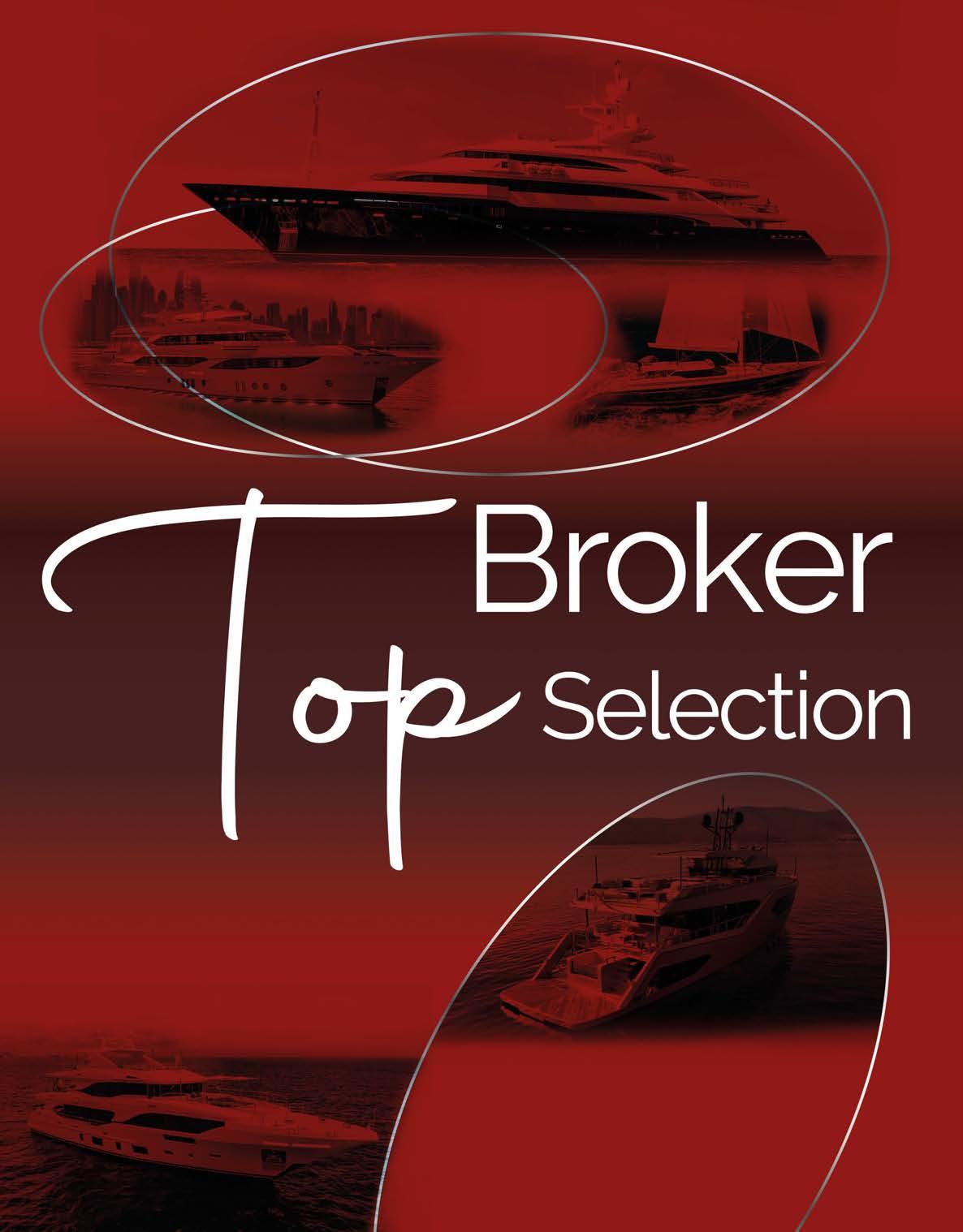
BARCHE PROPONE OGNI MESE IL MEGLIO DELLE PROPOSTE DEL MERCATO INTERNAZIONALE DI IMBARCAZIONI E SUPERYACHT
BARCHE BRINGS YOU THE BEST OF THE INTERNATIONAL BOAT AND SUPERYACHT MARKET EVERY MONTH
BENETTI
Year 2016 (2024)
LOA: 63.50m
Beam: 10.80m
Draft: 4.30m
Engines: 2 MTU 1850 HP
Speed: 15/16 knots (approx)
Range: 4750 nm @ 12 knots
Accomodation: 14 guests in 7 cabins
Crew: 15
Price: US$ 42,000,000
u Camper & Nicholsons International Fernando Nicholson fnicholson@camperandnicholsons.com +1 305 776 3096

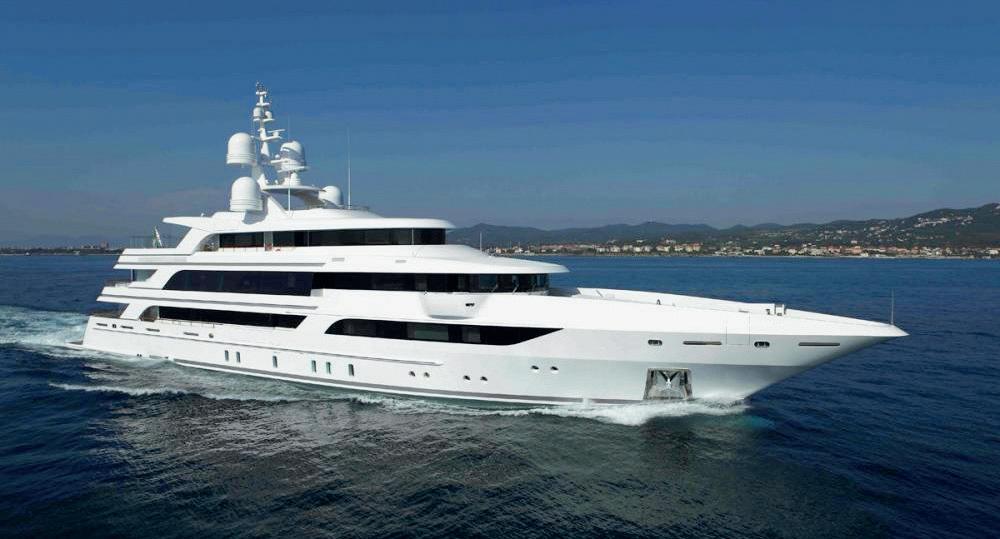
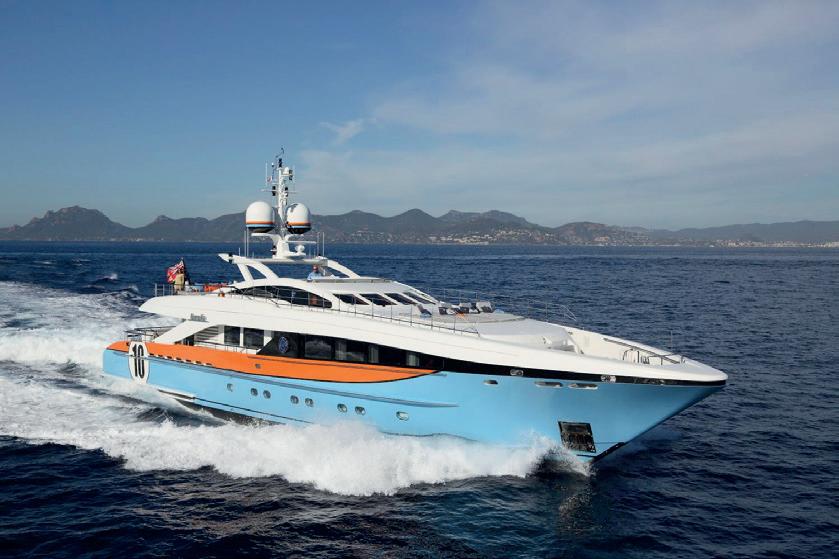
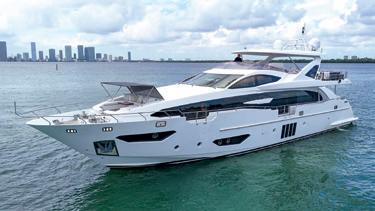
AZIMUT 95’
Year 2017, LOA 95 ft, Beam 22.5 ft, Cruising Speed 23 kn, Horse Power 4,372 hp Engine Model 2: 16V 2000, 16V 2000 ftp. Price: $5,900,000. u Florida Yachts International 305-239-4978 www.fyiyachts.com

SUNSEEKER 86 FT
Year 2021, Cruising Speed 23 kn, LOA 86 ft, Beam 21.25 ft Horse Power 4,000 hp Engine Model 2: 12V 2000 M96L, 12V 2000 M96L ftp. Price: $5,990,000. u Florida Yachts International 305-239-4978 www.fyiyachts.com
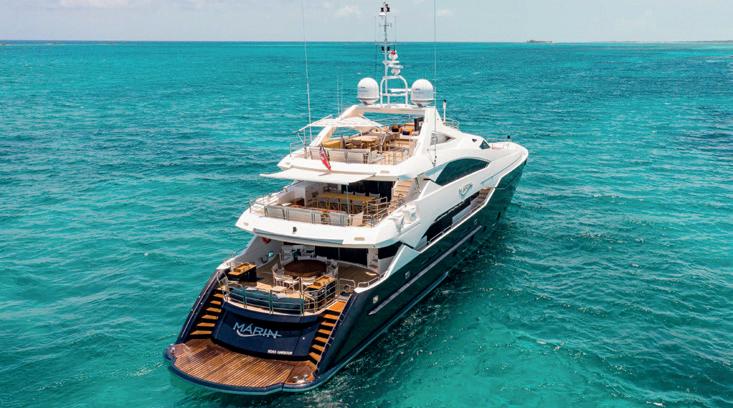
HEESEN 122’
Year 2011, Maximum Speed: 30 kn, Cruising Speed: 17 kn, Beam: 24’ 7’’
Hull Material: Aluminum Max Draft: 7’ 3’’, Cabins: 4 Heads: 5. €7,850,000
u Denison Yachting Cell 401.633.4320 sales@denisonyachting.com www.denisonyachtsales.com

LEOPARD 112
Build 2008/2022, Length 34.14m, Draft 1.22m, Beam 7.32m, Guests 10, Cabins 4, Crew 4, Asking Price $2,490,000. u Florida Yachts International 305-239-4978 www.fyiyachts.com
SUNSEEKER 131’
Year 2014, Length 39.93m, Beam 8.1m, Engines 2x Mtu 12v 4000 M93
Speeds, 19 / 24 Knots Accommodation 5 Cabins, 10 Guests, 7 Crew
Asking $10,499,000 USD u FGI YACHT GROUP +1 (954) 530-5208 info@fgiyachtgroup.com


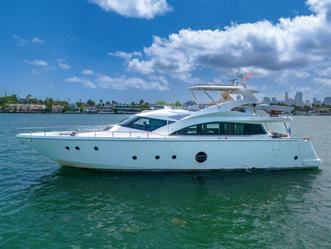
AICON 75’
Year 2008, Cruising Speed 23 kn, LOA 75 ft, Beam 19.5 ft Horse Power 3,100 hp
Engine Model 2: C-32, C-32 ftp. Price: $1,050,000 u Florida Yachts International 305-239-4978 www.fyiyachts.com

HARGRAVE 101 FT
MAJESTY 155
Year 2018, LOA: 47,6 m Beam: 9,6 m, Draft: 2,2 m
Guests: 8 cabins, Speed: cruising14 Kn, max. 17 Kn Price: 14,900,000 US$ u Blackorange Superyacht benjamin@blackorangeyachts.com
Mobile (FR) : +33 614 975 050

Year 2016, Cruising Speed 20 kn, LOA 101 ft, Beam 21 ft
Horse Power 3,600 hp
Engine Model 2: C32A, C32A ftp Price: $4,749,000 u Florida Yachts International 305-239-4978 www.fyiyachts.com
Builder Ada Yacht Works, LOA 39m, Year 2009, Year Refit 2024, Gross Tonn. 183, Draft 4.05m, Beam 8m, Location BODRUM, Turkey, Guests 8, Cabins 4 Crew 6, Asking Price €4,500,000 u Northrop & Johnson www.northropandjohnson.com

MAORI 125’
Year 2023, Cruising Speed: 13 kn, Maximum Speed: 18 kn Beam: 34’ 9’’, Max Draft: 7’ 10’’ Cabins: 5, Fuel Tank: 1 x 9775 gallon. €16,500,000 u Blackorange Superyacht benjamin@blackorangeyachts.com Mobile (FR) : +33 614 975 050
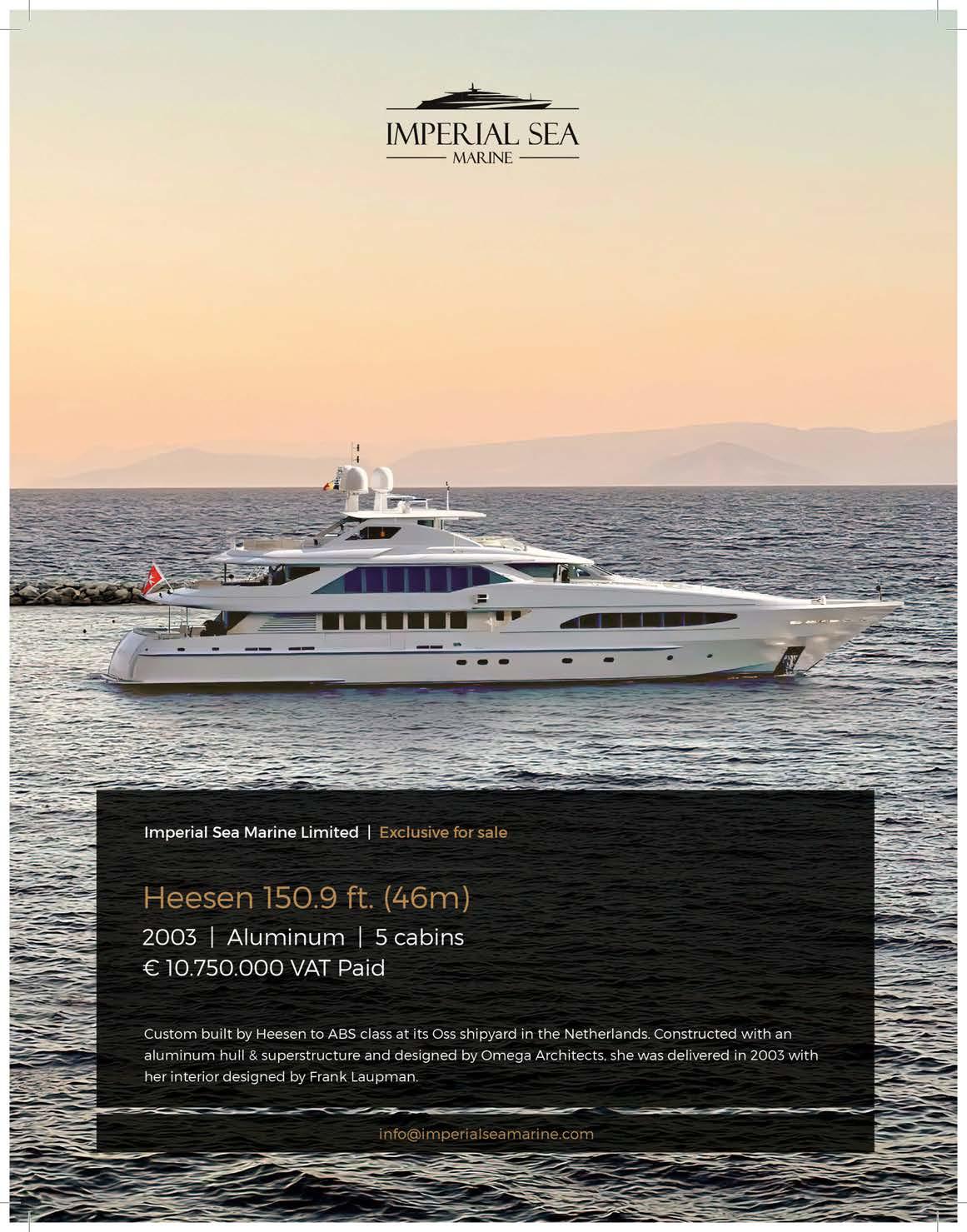
Year 2023, LOA: 26.78 m
Beam max: 6.95 m
Draft: 1.93 m
Displacement: 93 t
Building material: GRP + Carbon Fiber
Fuel capacity: 9500 l
Water capacity: 2000 l
€ 7,200,000
u Niso Gadot

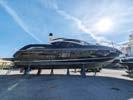
SUNSEEKER 64 PREDATOR
€ 800.000 IVA pagata (Anno 2009, prima immatricolazione 2013, tagliandi eseguiti).
u CMM Yacht Service +39 0721 960511 info@cmmyachtservice.com www.cmmyachtservice.com

MOONEN 121’
Year 2015, Length 121’, Beam 24’, Draft 7’, 5 Staterooms, Engines MTU 2174 hp.
$8,900,000 u Denison Yachting Cell 401.633.4320 sales@denisonyachting.com www.denisonyachtsales.com

INTERMARE 30 CRUISER
Anno 2003; Yanmar 2x190 hp, ore moto 712 ca; visibile Medio Adriatico; richiesta
€ 56.000,00 Iva Assolta. u Yacht Service Rapallo Srl +393358263146 commerciale@ yachtservicerapallo.it

CIGARETTE 42’
Year 2022, LOA 42 ft, Beam 11.92 ft, Horse Power 1,800 hp. Price: $1,399,00 u Florida Yachts International 305-239-4978 www.fyiyachts.com


IN LOVE - SU MARINE
Year 2014, Length 35.6m, Draft 3.6m, Beam 7.3m, Guests 9, Cabins 4 Crew 6, Max Speed 11 .2 Knots, Asking Price €5,900,000. u Northrop & Johnson www.northropandjohnson.com
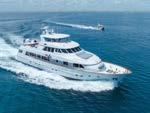
Year 1996/2021, Length 37.19m, Draft 1.83m, Beam 7.62m, Guests 8, Cabins 4, Crew 5 Asking Price $5,400,000 u Northrop & Johnson www.northropandjohnson.com
ROBBIE BOBBY
Length 33.5m, Builder Lynx Yachts, Build 2013/2018, Guests 12, Cabins 5, Crew 7, Draft 2.3m, Beam 8m, Range 3,200 NM. Max Speed 12.5 Knots, Cruising Speed 11 Knots. Asking Price
€6,495,000 u Northrop & Johnson www.northropandjohnson.com

PRINCESS 72’
Year 2012, Length 21.95m, Guests 8, Cabins 4, Draft 1.68m, Beam 5.49m, Max Speed 34 Knots, Cruising Speed 28 Knots, Asking Price
$1,895,000 u Northrop & Johnson www.northropandjohnson.com




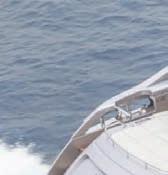





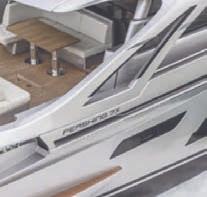










Centro assistenza e ricambi
Allestimenti personalizzati
Riparazione gommoni (vetroresina, PVC, hipalon)
Riparazioni e diagnostica di tutte le marche
45 42 info@seabestsrl.it - www.seabestsrl.it

“NAVETTA” 20


MAGNUM MARINE 40 1990, 12,24 m., 2x380 Caterpillar, Toscana, €260.000



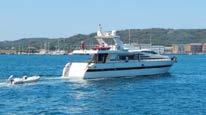
Rossato Shipyard - Year 1992, refitting 2022 – 22,00 x 5,00 m - 2 x CAT 233 HP 3208T V DRIVE - 3 cabins and 3 bathrooms + Crew x 2 with shower bath, with large spaces and autonomy – Full optional - Private Poland ag - € 450,000. u East Coast Yacht Brokers +39 0187 284102 info@ecyb.it www.ecyb.net
Year 1989, refitting 2021 – m 26,70 - (O cial 23.90) x 5,80 m – 2 x 1000 HP MAN D2842 - 4 cabins and 4 bathrooms + 2 Crew cabins - Great habitability and performing - Jacuzzi on the main deck at the bow –Italian ag - € 315,000. u East Coast Yacht Brokers +39 0187 284102 info@ecyb.it www.ecyb.net


GIANETTI NAVETTA S 24
Year 2004- mt 25.60x6.40 – 2 CAT 1000 HP - 5 cabins plus crew - Hull material: GRP - Deck material: teak- Full optional – Good value for money - Price negotiable € 1.300.000. u East Coast Yacht Brokers +39 0187 284102 info@ecyb.it www.ecyb.net
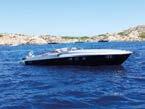
MAGNUM MARINE 44 2000, 13,41 m., 2x660 Caterpillar, Campania, €465.000.
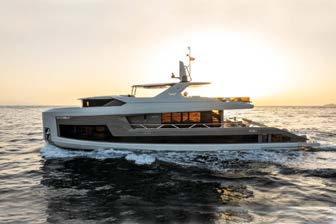

CAPOTESTA – LUXURY TUG
Year 1962, total refitting from 2015 to 2021 – 25 m. - Deutz RBV8M545, 8 cylinders, 1000 hp - 4 cabins with bathrooms + 2 cabins to be set up - large, bright and panoramic spaces - great autonomy - Northern Tyrrhenian Sea€900.000. u East Coast Yacht Brokers +39 0187 284102 info@ecyb.it www.ecyb.net
AZIMUT 62
Anno 2009 lunghezza f.t. 19,70m - Larghezza 5,05m 2 Caterpillar C18 1.015 Hp 3 Cabine + Equipaggio –Prezzo € 595.000. u Forwardyachts S.r.l. Porto MirabelloLa Spezia. t. 0187934692 - 392 4685455 info@forwardyachts.com www.forwardyachts.com

SAYONARA – CHEOY LEE
PEDRICK 38 SLOOP
Year 1991 - mt 11,63x3,60 –Universal 1x45 HP DIESEL - 2 cabins and 1 bathrooms 6 beds - Exterior and deck in teak - Excellent sailing performance - Full optional - € 43,000.
u East Coast Yacht Brokers +39 0187 284102 info@ecyb.it www.ecyb.net


OTAM 45 2003, 14,90 m., 2x715 Caterpillar, Liguria, €380.000. u Santa Marina Yachts +39 335 334 192, info@smy.it
MAZU 92
Year 2025, LOA: 28.45m
Beam: 22’ 8’’, Hull Material: Steel, Max Draft: 5’ 11’’, Maximum Speed: 17 kn €8,500,000 u Denison Yachting
Cell 401.633.4320 sales@denisonyachting.com www.denisonyachtsales.com

SAHIB - MOTOMAR 44 SEDAN
Year 1980 - mt 13,38x4,63 - 2X 400 hp Cummins - 2 cabins and 2 bathrooms 6 beds - Par uet oorsLarge interiors and exteriors - Cockpit in teak - Full optional - € 54,000. u East Coast Yacht Brokers +39 0187 284102 info@ecyb.it www.ecyb.net
SANLORENZO SD126
Anno 2022, LOA 38,40mlarghezza 8m, 2 Caterpillar C32 - 1622 Hp, 5 cabine + 7 persone equipaggio. Prezzo € 15.000.000.
u Forwardyachts S.r.l. Porto MirabelloLa Spezia. t. 0187934692 - 392 4685455 info@forwardyachts.com www.forwardyachts.com
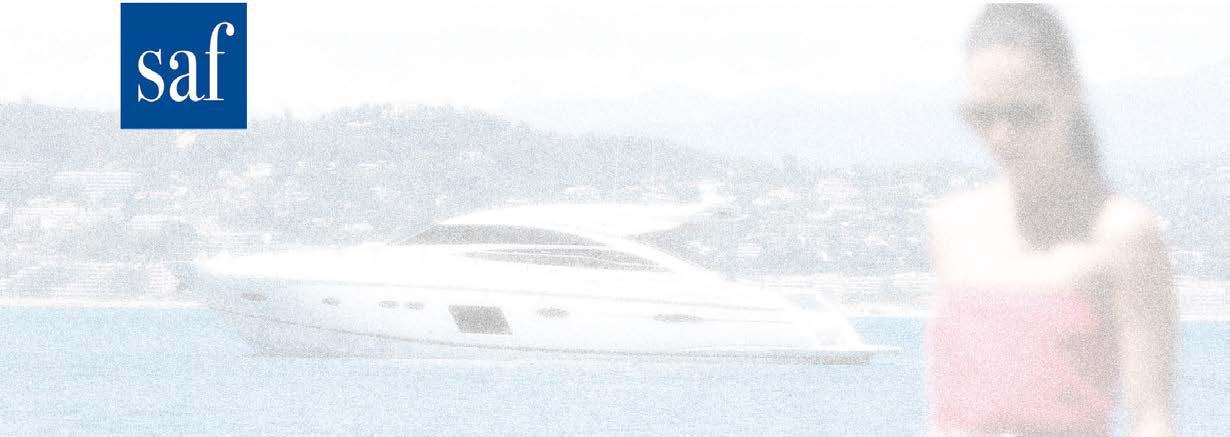

PERSHING 6X YEAR: 2023
LOA: 18,94 m, LAYOUT: 3 cabins



PERSHING 7X YEAR: 2021

LOA: 21,11 m, LAYOUT: 3 cabins

PERSHING 8X
YEAR: 2023
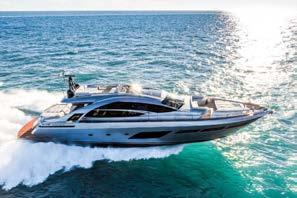
LOA: 25,55 m, LAYOUT: 4 cabins

ENGINES: 2 x MAN V12 1550 hp
MAX SPEED: 48 kn

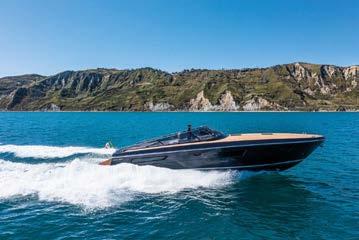
ITAMA 45RS YEAR: 2024
LOA: 13,82 m, LAYOUT: 2 cabins
ENGINES: 2 x CUMMINS 550 hp
MAX SPEED: 34 kn

ASKING: 799.000 € (Vat residual leasing).

PERSHING 64
YEAR: 2008
ENGINES: 2 X MAN 1800 HP V12
MAX SPEED: 50 kn
ENGINES: 2 x MTU 16V 2000 M96 L MAX SPEED: 48 kn

ASKING: € 2.950.000 (Vat residual leasing)
FERRETTI YACHTS 720 YEAR: 2022,
LOA: 22,30 m, LAYOUT: 4 cabins

LOA: 20,04 m
ENGINES: 2 x MAN V12 - 1550
MAX SPEED: 47 kn
ASKING: 950.000€ (Vat paid).
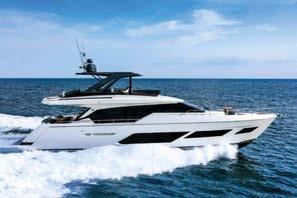
ENGINES: 2 x MAN V12 – 1400 hp

MAX SPEED: 28 kn
ASKING: 3.450.000 € (Vat paid).


PERSHING 62 YEAR: 2020,
LOA: 18,48 m, LAYOUT: 3 cabins

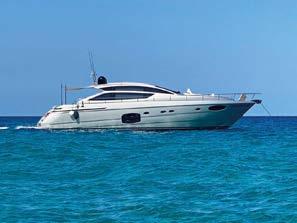
ENGINES: 2 x MAN 1800 hp
MAX SPEED: 46 kn
ASKING: 1.990.000€ (Vat paid).




ASKING: €5.390.000 (Vat residual leasing).
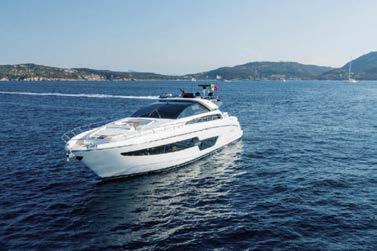
RIVA 88 DOMINO SUPER YEAR: 2016
LOA: 26,90 m, LAYOUT: 4 cabins
ENGINES: 2 X MTU 16V 2000 M96L
MAX SPEED: 40 kn


ASKING: € 4.900.000 (Vat paid)
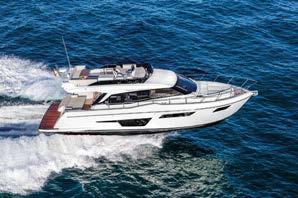

FERRETTI YACHTS 500
YEAR: 2022, LOA: 15,33 m, LAYOUT: 3 cabins + 1 crew
ENGINES: 2 x Cummins 550 hp
MAX SPEED: 30 kn
ASKING: 980.000€ (Vat residual leasing).
San Giorgio in Bosco (PD) 0499450555 info@italianyachtstore.com - www.italianyachtstore.com

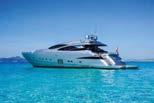
PERSHING 90
Anno 2009 – Ottime condizioni generali – Unico proprietario. Prezzo € 2.085.000 IVA pagata Central Agency.
u CMM Yacht Service +39 0721 960511 info@cmmyachtservice.com www.cmmyachtservice.com

WALLY 106
WALLY B Wally in carbonio su disegno di Luca Brenta ed interni di Lazzarini Pickering. Costruito da Pendennis in Carbonio e Kevlar, ristrutturato negli ultimi anni.
€ 3.250.000 Iva compresa.
u Grabau International +393337489281, michele@ grabauinternational.com
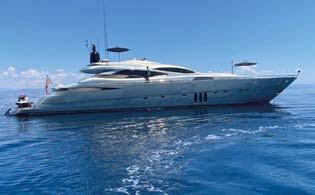
CUSTOM LINE NAVETTA 27
Anno 2000, refitting 2024, lunghezza 27,45m - larghezza 7m, 2 Man V12 - 1.200 Hp, 4 cabine + 2 cabine equipaggio - Prezzo €1.990.000.
u Forwardyachts S.r.l. Porto Mirabello - La Spezia. t. 0187934692 - 392 4685455 info@forwardyachts.com www.forwardyachts.com

UNIESSE 48’ T-TOP Year 2003. Engines MAN 2 x 630 HP . Hours 2500 ca. Speed 32 kn. Bow thruster. 3 version cabin. Boat in good conditions. Price € 250.000. u Giorgio Dalla Pietà –Archipelago Cell +39 333 7886745 info@archipelagodp.it, www.archipelagodp.it
PERSHING 115
Anno 2010, Lunghezza 35.37m, Larghezza 7.2m, Bagni 4, Cabine 4. € 4.990.000 IVA pagata. u CMM Yacht Service +39 0721 960511 info@cmmyachtservice.com www.cmmyachtservice.com

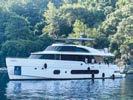
AZIMUT MAGELLANO 25 M
Anno 2022, varo 2023, unico armatore uso privato, pronta alla boa. 2x 1,550 hp MAN, Humphree Interceptor trimtab system, 4 cabine 5 bagni oltre equipaggio.
€ 3.990.000 oltre IVA.
u Grabau International +393337489281, michele@ grabauinternational.com

BALTIC 67 PC
Anno 2019. L’ultimo performance cruiser di Baltic Yachts in perfette condizioni. 4 cabine, tender garage, albero in carbonio, vele Millennium Sails. € 3.200.000 oltre IVA.
u Grabau International +393337489281, michele@ grabauinternational.com
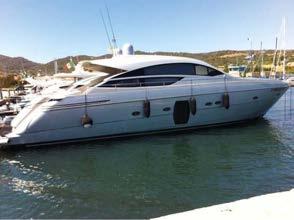
AMER F100
Anno 2018/2022, lunghezza 29,60m - larghezza 7m, 4 Volvo Penta 1200 - 900 Hp, 5 cabine + 3 cabine equipaggio - Prezzo € 5.700.000.
u Forwardyachts S.r.l. Porto Mirabello - La Spezia. t. 0187934692 - 392 4685455 info@forwardyachts.com www.forwardyachts.com
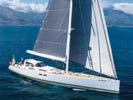
BALTIC 78 TURCONERI
Meraviglioso performance cruiser dalla matita di Judel/Vrolijk, costruzione in composito avanzato, interni Baltic Yachts e pozzetto con arco ‘targa’. € 2.090.000 IVA ASSOLTA. u Grabau International +393337489281, michele@ grabauinternational.com
PERSHING 64
Anno 2010 - Riverniciata
color silver (anno 2019) –cuscinerie nuove.
€ 1.000.000 IVA pagata. u CMM Yacht Service +39 0721 960511 info@cmmyachtservice.com www.cmmyachtservice.com




“The best Navetta 37 on the market, meticulously maintained by a full-time crew. NEW HULL AND SUPERSTRUCTURE PAINT FOR 2025.”
BUILDER CUSTOM LINE • MODEL NAVETTA 37 • YEAR 2022 • LENGTH 37m (121ft) GUEST 11 • CABINS 5 • CREW BERTHS 7 • ASKING PRICE € 16.750.000
OVERVIEW
LOA
37,04 mt / 121,6 ft
Beam 8 mt / 26,3 ft
Draft 2,27 mt / 7,5 ft
GRT 289
Max/ Cruising speed 15,5 kn / 12 kn
Range @10kn 3.000 nm
Builder Custom Line
Model Navetta 37
Boat Name SOKNY
Material Fiberglass - VTR
Architect Studio Zuccon
2 x MAN 1.400hp Flag Maltese
LY3 South of France
For further information please contact: Karin Paggi mob. +39 347 9109201email: k.paggi@karmayachting.com
Mario Cicognani mob. +39 339 2237238email: m.cicognani@karmayachting.com
Year: 2023 Loa: 49.90m, Maximum Beam: 9.00m, Maximum Draft: 2.60m
Gross Tonnage: 499gt, Fuel Capacity: 60,000l Fresh Water Capacity: 12,000l, Main Engines: 2 x MAN V12 1.400 - 1.029kw @ 2.300rpm EachMax Speed: 15knots, Classification: R.i.n.a, Range: @12knots 4.500nautical Miles, Generators: 2 x Kohler 118kw 50hz. € 38,000,000 u Niso Gadot +97250-7644438 niso@azimutyachts.co.il

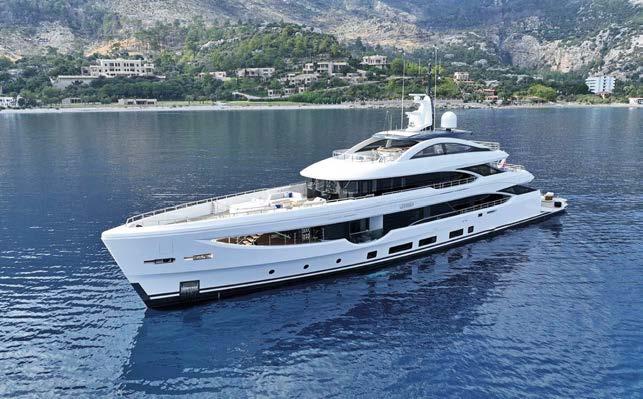
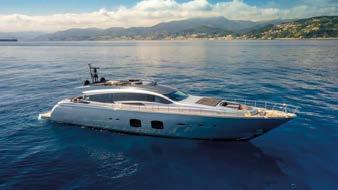
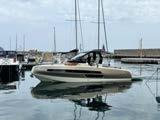
INVICTUS 370
2024, Lazio. Prossimamente in Liguria. Unico con T-TOP chiuso. Come nuovo. 2x350 HP Volvo Penta V8 benzina, solo 20 ore. Fatturabile, possibilit di e ettuare un leasing. € 499.000. u Valbroker tel. 0039 3475006999 info@valbroker.com, www.valbroker.com

FIM REGINA 340 2022, Sardegna. 2xVolvo V8 350 benzina con solo 245 ore. Velocissima, sportiva ed elegante. 100% MADE IN ITALY. Natante non targato. Da noi venduta nuova all’attuale e unico proprietario. Iva pagata. € 235.000. u Valbroker tel. 0039 3475006999 info@valbroker.com, www.valbroker.com
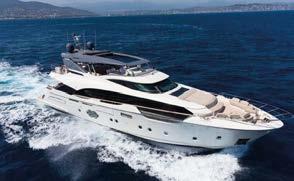
PERSHING 108
Year 2015, LOA: 33 m, Beam: 6,7 m, Capacity: 8 Guests in 4 staterooms, Max speed: 42 Kn, GRP Planning hull. €5,900,000. u Blackorange Superyacht greg@blackorange-yachts. com, 971 50 579 6099
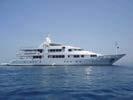

BENETTI CUSTOM 54 M
Year / Refit 1984 / 2022, LOA 54 m, Main Engines 2 x 1770 hp Cat 3512B (Overhauled 2023)
Beam 9,00 m, Draft 3.40 m Gross Tonnage 603 GT Asking Price € 5,900,000. u YMB YACHTING www.yacht-marinebrokerage.com +90543953867 eliad@yacht-marinebrokerage.com
MONTE CARLO YACHT 96
Beam: 22’ 9’’, Max Draft: 6’ 11’’, Maximum Speed: 25 kn
Asking Price: €5,950,000 u Denison Yachting Cell 401.633.4320 sales@denisonyachting.com www.denisonyachtsales.com
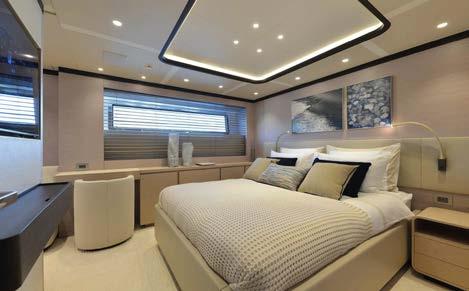
TECNOMAR 42M
Year 2009 (2024), LOA 42.40m, Beam 7.32m, Draft 2.90m, 5 Cabins, 10 Guests, 6 Crew. €6,350,000 VAT Paid u Camper & Nicholsons International ekaralis@ camperandnicholsons.com +306970300053

AZIMUT 72’
Year 2016, Cruising Speed: 26 kn, Maximum Speed: 32 kn, Beam: 18’ 4’’
Hull Material: Fiberglass Max Draft: 5’ 11’’ Fuel Tank: 1 x 1373|gallon Fresh Water: 1 x 290|gallon Cabins: 4, Heads: 4. $1,679,599 u Denison Yachting Cell 401.633.4320 sales@denisonyachting.com www.denisonyachtsales.com
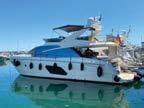
ABSOLUTE 60 FLY 2017,Liguria. 2xVolvo Penta IPS D11 950. Tre cabine doppie con servizi e cabina marinaio. FULL OPTIONAL: Stabilizzatore Seakeeper 9, aria condizionata, joystick di manovra, elica di prua. Unico proprietario. Ottime condizioni.Iva Europea pagata. € 1.250.000 u Valbroker tel. 0039 3475006999 info@valbroker.com, www.valbroker.com
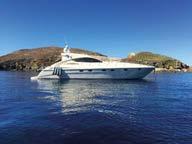
2x715 HP. Hours 770 ca. Speed 34 kn. Bow thruster. Semi-gloss cherry interiors, Dussi par uet oor, Alcantara walls and ceiling. 3 Cabin + 2 bathroom. price Euro 328.000. u Giorgio Dalla Pietà –Archipelago Cell +39 333 7886745 info@archipelagodp.it, www.archipelagodp.it
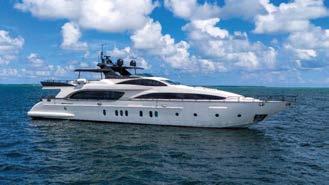
AZIMUT 116’
Year 2004, LOA 116 ft, Beam 25.08 ft, Horse Power 4,000 hp, Engine Model 2: 16V2000, 16V2000 ftp. $2,499,000 u Florida Yachts International 305-239-4978 www.fyiyachts.com

JEANNEAU PRESTIGE 46 FLY
Anno 2005, Motori 2 x 500 hp Cummins Diesel Linea Asse.
€ 275.000. 3 cabine + 2 bagni + cabina marinaio.

LINSSEN GRAND STURDY 380
SEDAN. Anno 2004/05 - Navetta scafo in acciaio. Motori 2 x 75 hp Volvo Penta Diesel Linea Asse. € 163.000.

PLASTIK SPACE 310
Anno 2004 - NATANTE
Motori 2 x 230 hp VM Diesel Linea Asse. € 58.000.

RANIERI VOYAGER 23 S
Anno 2013 - NATANTE
Motore 1 x 250 hp Honda FB benzina + ausiliario.
€ 39.000


ABATI YACHTS NEWPORT 46
Anno 2011 - LOBSTER. Motori 2 x 575 hp Caterpillar Diesel Linea Asse - € 290.000. 3 cabine + 2 bagni + cabina marinaio.

SEALINE SC 35
2010/11 - SOFT TOP
Motori 2 x 260 hp Volvo Penta Diesel EFB - € 145.000.

TECNOYACHT PUMA 2
Anno 1995 - NATANTE
Motori 2 x 230 hp Volvo Penta Diesel EFB. € 59.000.
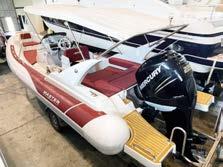
MASTER 699
Anno 2014 - NATANTE
Motore 1 x 225 hp Mercury FB benzina con carrello stradale
€ 45.000

ENTERPRISE MARINE 46 FLY
Anno 2005, Motori 2 x 575 hp Volvo Penta Diesel Linea Asse. € 215.000. 3 cabine + 2 bagni + cabina marinaio.

RIO YACHTS ESPERA 34
Anno 2013 - NATANTE 2 x 220 hp Volvo Penta EFB Benzina - € 114.000.

NUOVA JOLLY PRINCE 28 SPORT CABIN
NUOVO Stock 2023 - NATANTE 2 x 200 SELVA Fuoribordo Benzina. Trattativa riservata.
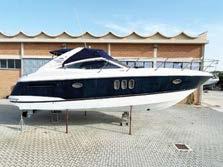
ABSOLUTE 39
Anno 2007 - OPEN
Motori 2 x 310 hp Volvo Penta Diesel EFB. € 140.000. 2 cabine + 2 bagni.
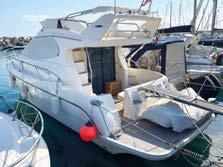
INTERMARE 33 FLY
Anno 2006 - NATANTE 2 x 315 hp Yanmar Diesel Linea Asse. € 115.000.
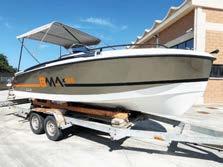



AZIMUT ATLANTIS 43 Anno 2017, Adriatico. Unico proprietario. Cabina ospiti tripla. Full optional: generatore, aria condizionata, plancetta tender-lift, eliche di rispetto in nibral. 2xVolvo Penta D6 400 con solo 400 ore. € 475.000 u Valbroker tel. 0039 3475006999 info@valbroker.com, www.valbroker.com

CHRIS CRAFT CORSAIR 28 2013, visibile nel nostro showroom a Como. Venduto da noi all’attuale proprietario. Scafo storico ed elegante. Motore più potente, top di gamma, nuovo sostituito in garanzia da Volvo, 1x435 HP Volvo Penta V8 -430 CE solo 80 ore di moto. € 118.000 u Valbroker tel. 0039 3475006999 info@valbroker.com, www.valbroker.com

CUSTOM LINE NAVETTA 28 anno 2017, lunghezza 28,21m - larghezza 7m, 2 Man V8 - 1.200 Hp, 5 cabine + 3 cabine equipaggio. Prezzo: € 4.500.000. u Forwardyachts S.r.l. Porto Mirabello - La Spezia. t. 0187934692 - 392 4685455 info@forwardyachts.com

Volvo Penta D13 IPS 1350 con 810 ore di moto. Full Optional: antenna satellitare TV, generatore ONAN, stabilizzatore Seakeeper, aria condizionata, pilota automatico. € 2.550.000iva esclusa sul residuo leasing. u Valbroker tel. 0039 3475006999 info@valbroker.com, www.valbroker.com
FERRETTI YACHTS 780 € 1.650.000 IVA pagata (Anno 2007, ottime condizioni


AZIMUT GRANDE 30M Year 2017, LOA 29.1M, Beam 7m, Draft 2.10M, Engines 2 X MTU 16V 2000 M86, Gross Tonnage 149, 5 Cabins, 10 Guests, 5 Crew, Cruising Speed 12 Knots, Max Speed 26 Knots. ASKING $6,350,000 USD u FGI YACHT GROUP +1 (954) 530-5208 info@fgiyachtgroup.com

CN YACHT 2000 Year 2006, Vallicelli 80, disegno dello Studio Vallicelli, semi-raised saloon, garage tender e albero in carbonio. Due generatori, 4 cabine 4 bagni. Prezzo €1.550.000 Iva assolta. u Grabau International +393337489281, michele@ grabauinternational.com
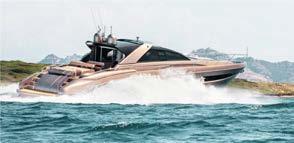
CUSTOM LINE 92’ Year 2015, LOA 92 ft, Beam 23 ft, Horse Power 2,400 hp Engine Model 2: V8-1200, V8-1200 ftp. $5,200,000 u Florida Yachts International 305-239-4978 www.fyiyachts.com

SANLORENZO 88 anno 2005, refitting 2024, lunghezza 26,75m - larghezza 6,75m, 2 Mtu V16 - 2.000 Hp, 4 cabine + 2 cabine equipaggio.
Prezzo: € 2.500.000 u Forwardyachts S.r.l. Porto Mirabello - La Spezia. t. 0187934692 - 392 4685455 info@forwardyachts.com www.forwardyachts.com
RIVA 68 EGO SUPER Prezzo € 1.200.000 IVA pagata (Anno 2009, super
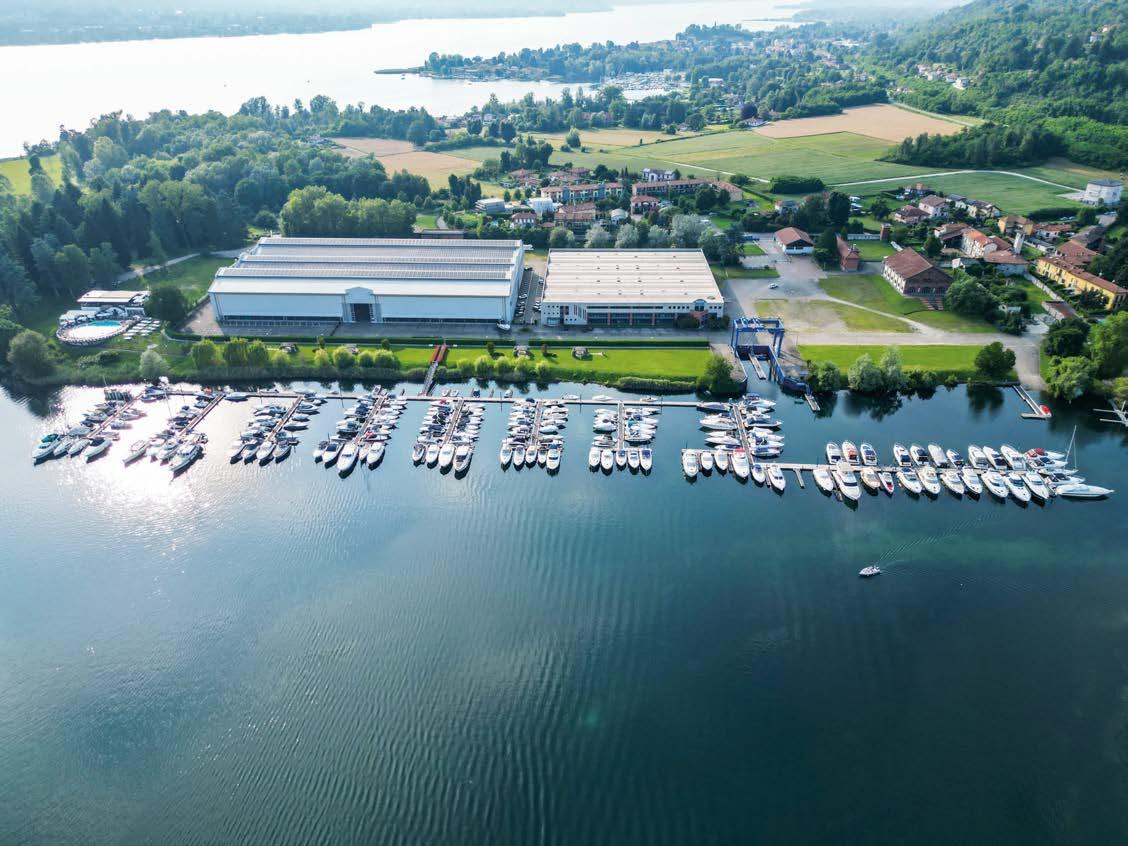




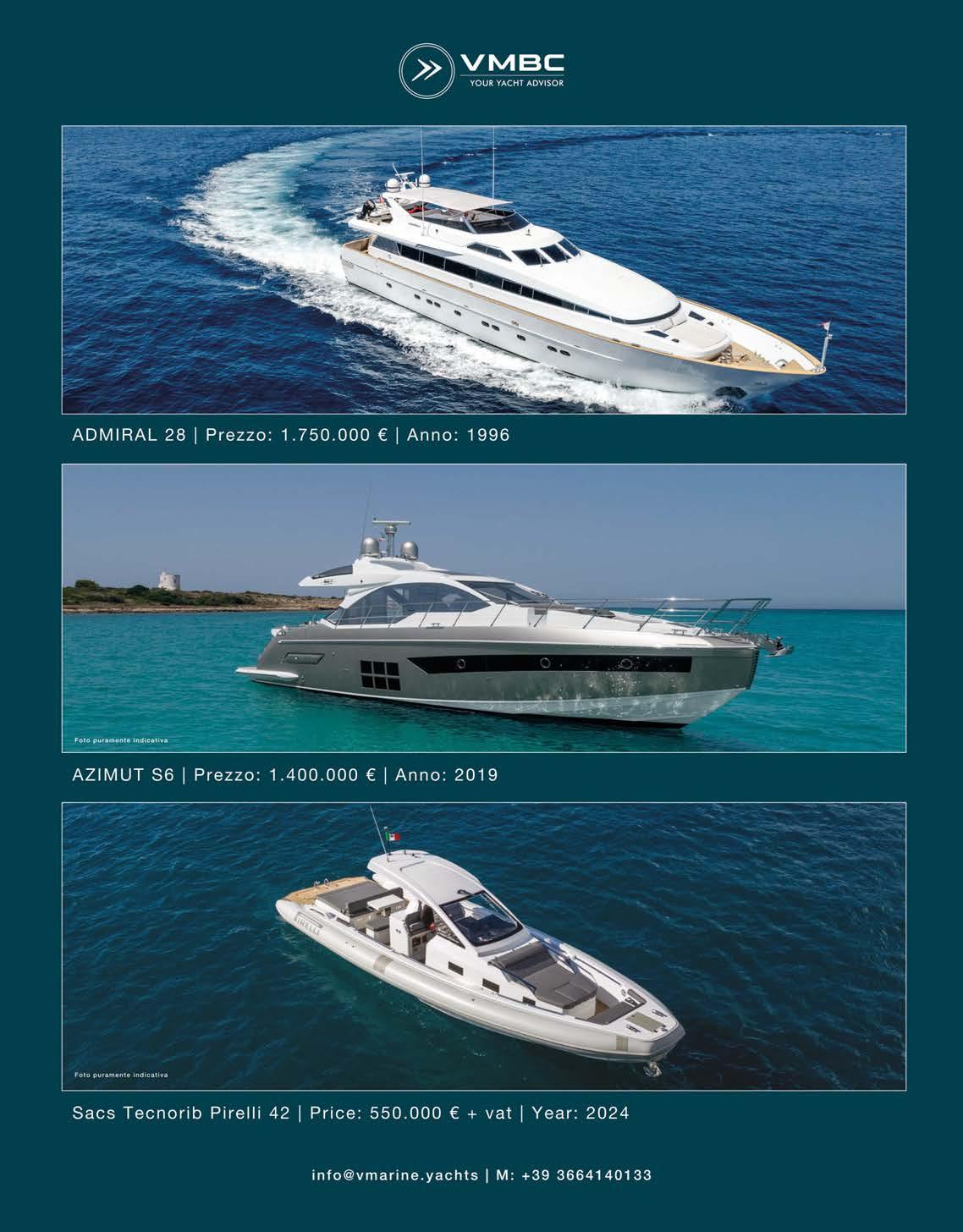
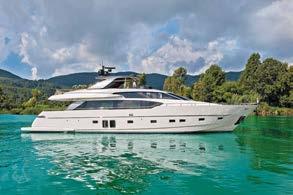

DALLA PIETÀ DP 72 HT
Year 2008. Engines CAT C32 2 x 1675 HP. Hours 960 ca. Speed 33 kn. Refitting 2022/2023. All electronic Raymarine Axiom system year 2023. € 1.090.000 u Giorgio Dalla Pietà –Archipelago Cell +39 333 7886745 info@archipelagodp.it, www.archipelagodp.it

TECNOMAR VELVET 90 Year 2006, Length 26.80m, Engines: 2 x 2000 hp MTU, 16V 2000 M91, Cruising Speed: 30 Knots Max Speed: 43 Knots. Price *950.000€ (VAT PAID) u Neptunea info@neptunea.gr +30 6955493371
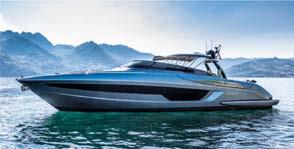
SANLORENZO SL86
Anno 2017, lunghezza f.t.26,75m, larghezza 6,35m, 2 Motori MTU 12V2000M96. Prezzo € 3.900.000. u Forwardyachts S.r.l. Porto Mirabello La Spezia. t. 0187934692 - 392 4685455 info@forwardyachts.com www.forwardyachts.com
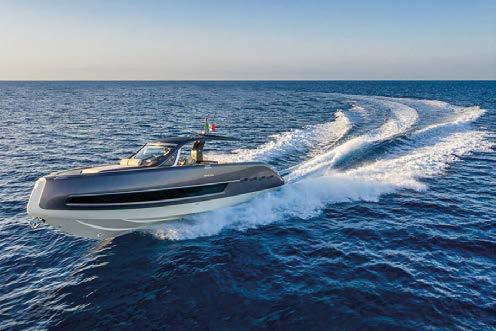
AZIMUT S8
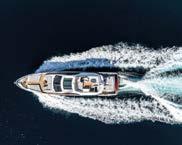
Year: 2024, Total Length: 24.63 m, Beem: 5.55 m
Draft: 1.75 m, Cabins: 4, Engine: 3x Volvo D13 IPS1350 1000 Mhp. Price: € 3,900,000. u Niso Gadot niso@azimutyachts.co.il +97250-7644438
RIVA 56 RIVALE
Anno 2017 – Colore: Shark Grey. Essenza interni: Mogano lucido – Layout 3 cabine - Asking price € 1.490.000 IVA pagata. u CMM Yacht Service +39 0721 960511 info@cmmyachtservice.com www.cmmyachtservice.com
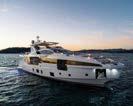
AZIMUT GRANDE 32 METRI Year: 2019, Total Length: 32.00 m, Beem: 7.30 m, Draft: 1.89 m, ENGINES - 2 x MTU 2200 HP 16V 2000 M86. Price: € 9,300,000. u Niso Gadot niso@azimutyachts.co.il +97250-7644438
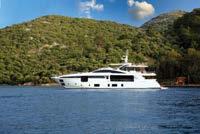
Year: 2021, Total Length: 35.00 m, Beem: 7.50 m
Draft: 1.90 m, 2x2400 HP (1790kw) MTU 16V 2000 M93, Price: € 11,900,000 u Niso Gadot niso@azimutyachts.co.il +97250-7644438
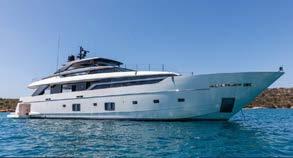

AZIMUT 35 METRI
Year: 2022, LOA: 35m Beam: 7.50 m Cabins: 5 Engines: 2x2400 HP MTU 16V 2000 M93. € 11,400,000 u Niso Gadot niso@azimutyachts.co.il +97250-7644438
SANLORENZO SL120 Year 2021, Lenght Overall 36,93m, Main Engines 2 MTU 16V2000M96L. €11.900.000 (VAT PAID u FUTURA YACHT BROKERAGE s.r.l. M. +39 335 645 4736 commerciale@futurayacht. com
VAM Tax&Corporate Firm is member of the international network VAM - Valuable Assets Management and regularly covers the following areas of assistance.
Over the years, the Firm has gained significant expertise in providing legal and tax assistance for the yachting and aviation industries. Namely, its specialization is represented by assistance in VAT, customs and other taxes and by corporate optimization, provided towards yacht and jet owners, charter companies, dealers, shipyards and aircraft production sites, financial entities and all the other players operating in the field of yachting and aviation. The professionals of the Firm are regularly involved in advising the Clients and in assisting and representing them in any discussion or litigation with tax authorities and customs authorities and before the tax courts. The Firm also provides assistance to Private Clients on a wide range of legal and tax matters relating to national and international wealth, M&A of private business, inheritance and donation tax planning with a particular focus on HNW and UHNW individuals.
VAM Tax&Corporate Firm is glad to meet its Clients in Rome - Milan - Monaco (Italian desk) - Viareggio
For any information, please send us an e-mail to info@vam-lawtax.com or contact our Partner Berardo Lanci at berardo.lanci@vam-lawtax.com | Mobile (IT): +39 3473441141 | Mobile (MC): +377 6 43919404




MONTE CARLO YACHT 76
Year 2019, Length overall:
23.05 m, Beam: 5.65 m
Cabins:4+1 crew
Engines: 2 x MAN V8 1200.
€ 2,400,000 EX VAT u Aqua Marina Yachts info@aquamarina.co.il +972-50-7644436 www.aquamarina.co.il

Year 2000/2024, Length overall: 35.1 m, Beam: 7.52 m, Cabins:5+4 crew, Engines: 2 x MTU 12V 1500HP.
€ 3,950,000 EX VAT u Aqua Marina Yachts info@aquamarina.co.il +972-50-7644436 www.aquamarina.co.il
NORDHAVN 96’
LOA 29.72m $8,995,000, Cruising Speed: 10 kn Maximum Speed: 12 kn Beam: 24’ 0’’, Cabins: 5 Heads: 6, Maximum Speed: 12 kn. Asking Price: $8,995,000 u Northrop & Johnson www.northropandjohnson.com

AZIMUT 64 FLY
Year 2014, Length overall: 20.2 m, Beam: 5.1 m Cabins: 3+1 crew, Engines: 2 x CAT C18 1150 HP.
€ 1,295,000 EX VAT u Aqua Marina Yachts info@aquamarina.co.il +972-50-7644436 www.aquamarina.co.il
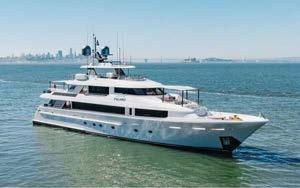
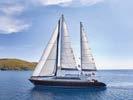

MENGI YAY MOTORSAILOR
FIGARO - WESTPORT
Year: 2018, Length: 39.6m, Engines: 2 x 2600 MTU 16V 2000 M96L, 10 guests in 5 staterooms. Asking USD 24,900,000 u Ocean Independence Yachts tconboy@ocyachts.com +1 561 441 6131


HORIZON 85’
Maximum Speed: 26 kn Beam: 20’ 6’’, Max Draft: 5’ 6’’, Fuel Tank: 1 x 2300|gallon Cabins: 4, Heads: 4.
$5,450,000 u Denison Yachting Cell 401.633.4320 sales@denisonyachting.com www.denisonyachtsales.com
COUACH 37M Year / Refit: 2011/2024, Beam: 7.3m, Engines: 2 x MTU 12V 4000 M90. Asking Price € 5,750,000 excl. VAT u Yachting Partners International hello@ypiyachts.com +377 99 99 97 97 ypiyachts.com





BUGARI 86’
Year 2021, LOA 86 ft, Beam 20 ft, Horse Power 3,800 hp. Price: $5,489,000 u Florida Yachts International 305-239-4978 www.fyiyachts.com

CRANCHI MEDITERRANEE
50’ OPEN
Year 2004. Engines: D 2x715 HP. Speed 34 kn The boat is in good condition. Open price € 218.000.
u Giorgio Dalla Pietà –Archipelago Cell +39 333 7886745 info@archipelagodp.it, www.archipelagodp.it
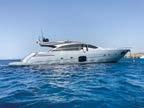
Perfect conditions –Private use only – Several improvements 2021. € 3.790.000 IVA pagata Central Agency. u CMM Yacht Service +39 0721 960511 info@cmmyachtservice.com www.cmmyachtservice.com

BENETTI 93’
Year 2013, LOA 93 ft, Beam 23 ft, Horse Power 1,996 hp, Engine Model 2: 8V2000, 8V2000 ftp. Price: $4,837,975. u Florida Yachts International 305-239-4978 www.fyiyachts.com

MAGNUM MARINE 50 1994, 15,30 m., 2x1080 Stewart Stevenson, Sardegna, €380.000.
u Santa Marina Yachts +39 335 334 192 info@smy.it

WALLY TENDER
Year 2007 - Good condition - Engine room refit. Price: € 315.000 + IVA.
u CMM Yacht Service +39 0721 960511 info@cmmyachtservice.com www.cmmyachtservice.com

PRINCESS 420 FLY
Year 1997. Engines VOLVO PENTA 2x370 HP. Bow thruster. 2 version cabin + 2 bathroom. The right engine landed in 2010 and the left engine landed in March 2012 to bring them to zero hours price Euro 155.000. u Giorgio Dalla Pietà Cell +39 333 7886745 info@archipelagodp.it, www.archipelagodp.it

MAXI DOLPHIN 62 DERIVA Ora disponibile per visite in Italia, performance cruiser in carbonio accessoriata per crociera o regata. € 1.750.000 oltre IVA. u Grabau International +393337489281, michele@ grabauinternational.com

FAIRLINE SQUADRON 62
Year: 1993 - LOA m 18,97Beam: m 5,21 - Max draft: m 1,45 - Sostituzione motori in corso - Price: € 495.000. u Inmar snc 329.0907407 - 348.1250078 info.inmar@gmail.com www.inmar.it

MAGNUM MARINE 53 1992, 16,13 m., 2x1080 General Motors, Sardegna, €295.000. u Santa Marina Yachts +39 335 334 192 info@smy.it
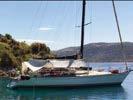

CIGARETTE HUNTRESS 42’ Year 2013. Engines Mercury F350 Verado L 5x 350 HP.
Hours 500. Speed 70 kn. Bow thruster. 1 master cabin at the bow, 4 beds, € 470.000
u Giorgio Dalla Pietà –Archipelago Cell +39 333 7886745 info@archipelagodp.it, www.archipelagodp.it

SUNSEEKER 90 Year 2007, Completely renovated in 2022/2023
Asking price € 2.300.000 + EU VAT if due
Location: Napoli area u My Yachts World +39 334 687 7621| nicola@myyachtsworld.com www.myyachtsworld.com


OTAM 58 2008, 18,70 m., 2x1675 Caterpillar, Campania, €990.000.
u Santa Marina Yachts +39 335 334 192 info@smy.it

